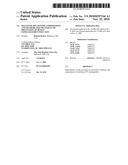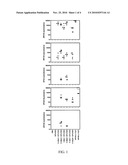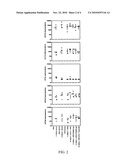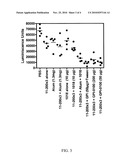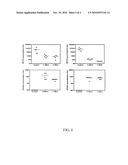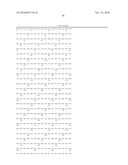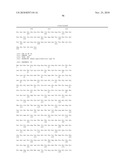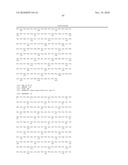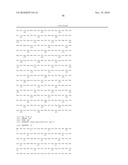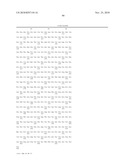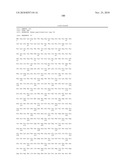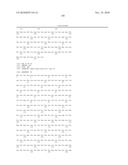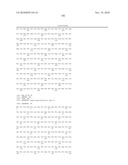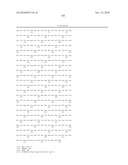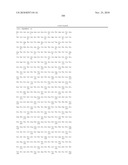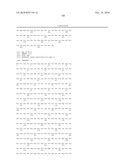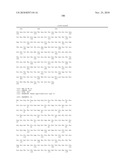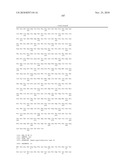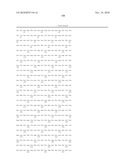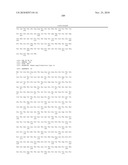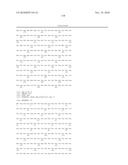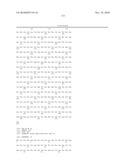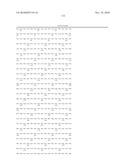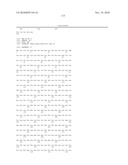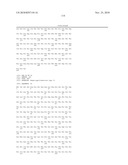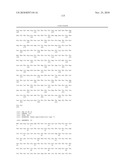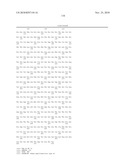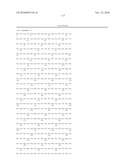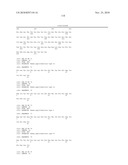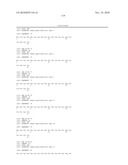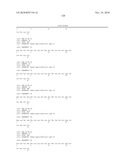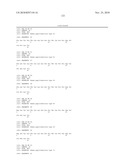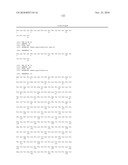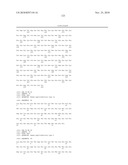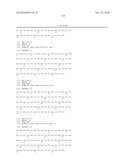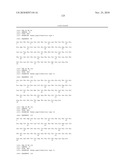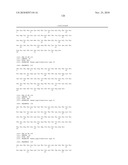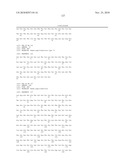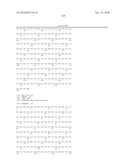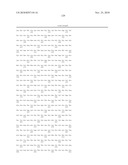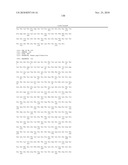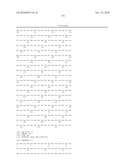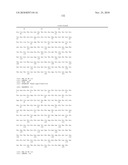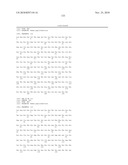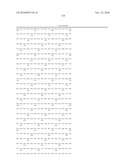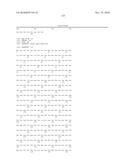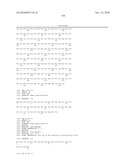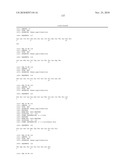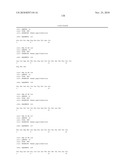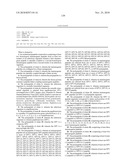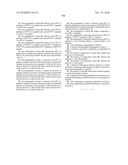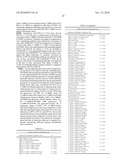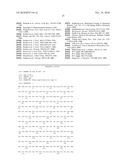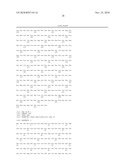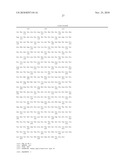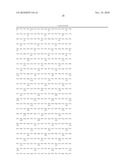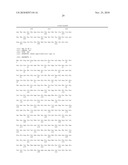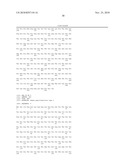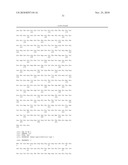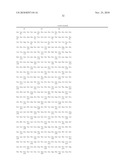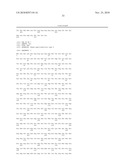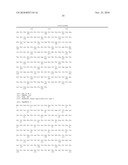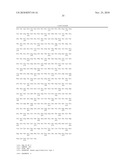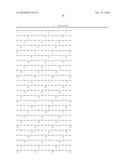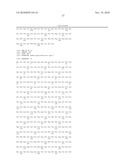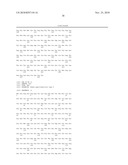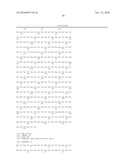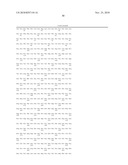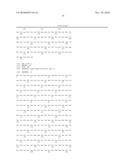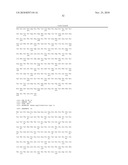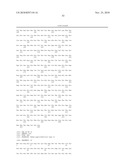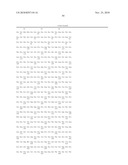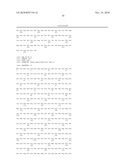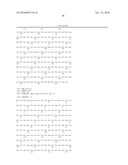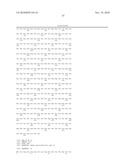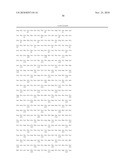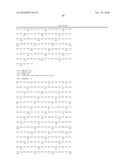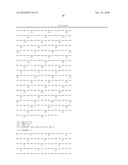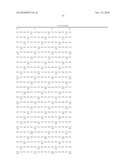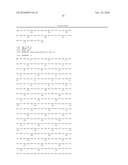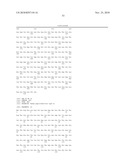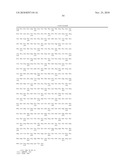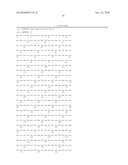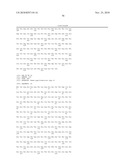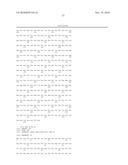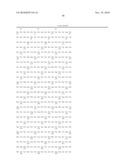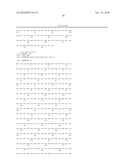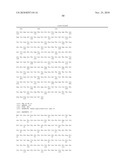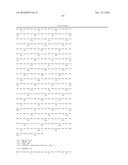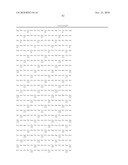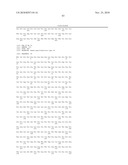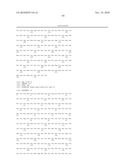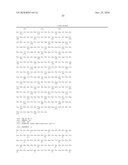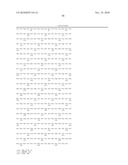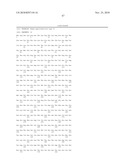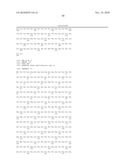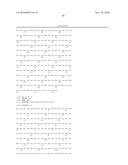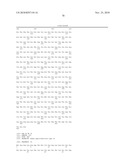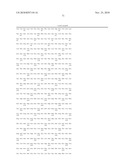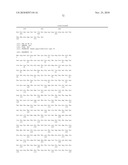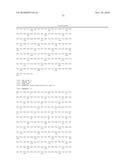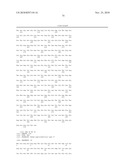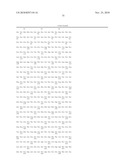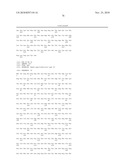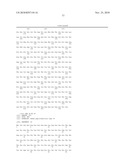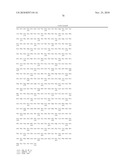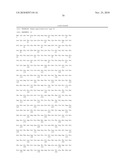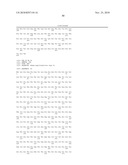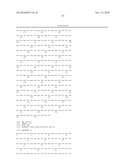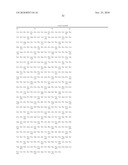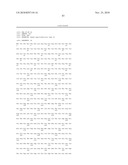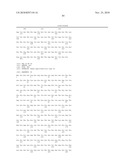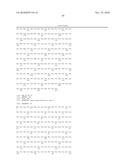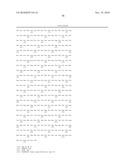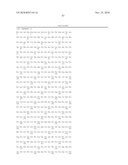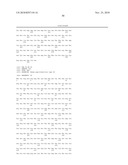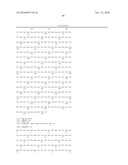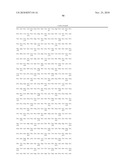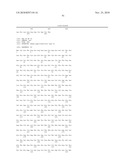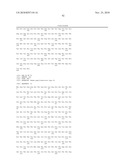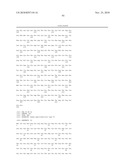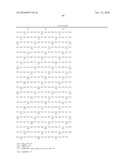Patent application title: MULTITYPE HPV PEPTIDE COMPOSITIONS AND METHODS FOR TREATMENT OR PREVENTION OF HUMAN PAPILLOMAVIRUS INFECTION
Inventors:
Richard Roden (Baltimore, MD, US)
Assignees:
The John Hopkins University
IPC8 Class: AA61K3942FI
USPC Class:
4241591
Class name: Drug, bio-affecting and body treating compositions immunoglobulin, antiserum, antibody, or antibody fragment, except conjugate or complex of the same with nonimmunoglobulin material binds virus or component thereof
Publication date: 2010-11-25
Patent application number: 20100297144
Claims:
1. An isolated polypeptide composition comprising at least two homologous
immunogenic peptides from at least two isolates of an infectious organism
wherein a first immunogenic peptide is operably coupled to a second
homologous immunogenic peptide from a second isolate of an infectious
organism.
2. The polypeptide of claim 1, wherein the immunogenic peptides are configured in a linear arrangement.
3. The polypeptide of claim 1, wherein the immunogenic peptides are operably coupled through a linker moiety.
4. The polypeptide of claim 1, wherein the polypeptide is a fusion protein.
5. The polypeptide of claim 4, wherein the fusion protein contains a peptide linker coupling immunogenic peptides.
6. The polypeptide of claim 1, wherein the infectious organism is a sexually transmitted organism.
7. The polypeptide of claim 6, wherein the sexually transmitted organism is selected from papillomavirus (PV), cytomegalovirus (CMV), herpes virus, Hepatitis B, Human Immunodeficiency Virus (HIV/AIDS), Kaposi's sarcoma-associated herpesvirus (KSHV/HHV8), Haemophilus ducreyi, Granuloma inguinale, Calymmatobacterium granulomatis, Neisseria gonorrhoeae, Chlamydia trachomatis, Ureaplasma urealyticum, Mycoplasma hominis, Staphylococcus aureus, or Treponema pallidum.
8. The polypeptide of claim 1, wherein the infectious organism is a papillomavirus.
9. The polypeptide of claim 8, wherein the papillomavirus is a member of a papillomavirus genus selected from α, β, γ, δ, ε, ζ, η, θ, , κ, λ, μ, ν, ξ, o, or π papillomavirus.
10. The polypeptide of claim 8, wherein the infectious organism is a human papillomavirus (HPV).
11. The polypeptide of claim 10, wherein the HPV is a cutaneous HPV.
12. The polypeptide of claim 10, wherein the HPV is a mucosal high risk HPV.
13. The polypeptide of claim 1, wherein an immunogenic peptides are an immunogenic HPV peptide selected from one or more of HPV1, HPV2, HPV3, HPV4, HPV5, HPV6, HPV7, HPV8, HPV9, HPV10, HPV11, HPV12, HPV13, HPV14, HPV15, HPV16, HPV17, HPV18, HPV19, HPV20, HPV21, HPV22, HPV23, HPV24, HPV25, HPV26, HPV27, HPV28, HPV29, HPV30, HPV31, HPV32, HPV33, HPV34, HPV35, HPV36, HPV37, HPV38, HPV39, HPV40, HPV41, HPV42, HPV43, HPV44, HPV45, HPV46, HPV47, HPV48, HPV49, HPV50, HPV51, HPV52, HPV53, HPV54, HPV55, HPV56, HPV57, HPV58, HPV59, HPV60, HPV61, HPV62, HPV63, HPV64, HPV65, HPV66, HPV67, HPV68, HPV69, HPV70, HPV71, HPV72, HPV73, HPV74, HPV75, HPV76, HPV77, HPV78, HPV79, HPV80, HPV81, HPV82, HPV83, HPV84, HPV85, HPV86, HPV87, HPV88, HPV89, HPV90, HPV91, HPV92, HPV93, HPV94, HPV95, HPV96, HPV97, HPV98, HPV99, or HPV100 polypeptide.
14. The polypeptide of claim 1, wherein an immunogenic peptides are selected from one or more of HPV1, HPV2, HPV5, HPV6, HPV8, HPV11, HPV16, HPV18, HPV31, HPV33, HPV35, HPV39, HPV45, HPV51, HPV52, HPV56, HPV58, HPV59, HPV68, HPV73, or HPV82 polypeptide.
15. The polypeptide of claim 1, wherein an immunogenic peptides are selected from one or more of HPV6, HPV16, HPV18, HPV31, HPV39, HPV51, HPV56, and/or HPV73 polypeptide.
16. The polypeptide of claim 1, wherein an immunogenic peptides are selected from HPV1, HPV5, HPV6, HPV16, and/or HPV18 polypeptide.
17. The polypeptide of claim 1, wherein immunogenic peptides are selected from one or more of HPV6, HPV16, or HPV18 peptide.
18. The polypeptide of claim 13, wherein immunogenic HPV peptides are HPV L2 polypeptide segments.
19. The polypeptide of claim 13, wherein the HPV L2 peptide segments correspond to amino acid position 13-45, 17-36, 1-88, 11-88, or 11-200 of SEQ ID NO:1.
20. The polypeptide of claim 18, wherein at least one HPV L2 peptide is a HPV16 L2 peptide.
21. The polypeptide of claim 18, wherein at least one HPV L2 peptide is a HPV18 L2 peptide.
22. The polypeptide of claim 18, wherein at least one HPV L2 peptide is a HPV6 L2 peptide.
23. The polypeptide of claim 18, wherein at least one HPV L2 peptide is a HPV45 L2 peptide.
24. The polypeptide of claim 18, comprising at least 3, 4, 5, 6, 7, 8, 9, 10, 11, 12, 13, 14, 15, 16, 17, 18, 19, 20, 21, 22 or more immunogenic peptides.
25. The polypeptide of claim 18, comprising at least three immunogenic peptides.
26. The polypeptide of claim 18, comprising at least five immunogenic peptides.
27. The polypeptide of claim 18, comprising at least twenty immunogenic peptides.
28. The polypeptide of claim 25, wherein at least one HPV L2 peptide is a HPV16 L2 peptide.
29. The polypeptide of claim 25, wherein at least one HPV L2 peptide is a HPV18 L2 peptide.
30. The polypeptide of claim 25, wherein at least one HPV L2 peptide is a HPV6 L2 peptide.
31. The polypeptide of claim 25, wherein at least one HPV L2 peptide is a HPV45 L2 peptide.
32. The polypeptide of claim 25, wherein a first HPV L2 peptide is a HPV16 L2 peptide and a second HPV L2 peptide is a HPV18 L2 peptide.
33. The polypeptide of claim 25, wherein a first HPV L2 peptide is a HPV16 L2 peptide and a second HPV L2 peptide is a HPV6 L2 peptide.
34. The polypeptide of claim 25, wherein a first HPV L2 peptide is a HPV18 L2 peptide and a second HPV L2 peptide is a HPV6 L2 peptide.
35. The polypeptide of claim 25, wherein a first HPV L2 peptide is a HPV16 L2 peptide, a second HPV L2 peptide is a HPV18 L2 peptide and a third HPV L2 peptide is a HPV6 L2 peptide.
36. The polypeptide of claim 18, wherein the HPV L2 peptide has an amino acid sequence selected from SEQ ID NOs:71-92, and/or SEQ ID NOs:94-106 and/or SEQ ID NOs:110-112.
37. The polypeptide of claim 1, wherein in the HPV L2 peptide comprises an amino acid sequence that is at least 60% identical to the amino acid sequence of SEQ ID NO:93 or SEQ ID NO:107 or SEQ ID NO:108 or SEQ ID NO:109 or SEQ ID NO:113 or SEQ ID NO:114.
38. The polypeptide of claim 1, wherein in the HPV L2 peptide comprises an amino acid sequence that is at least 70% identical to the amino acid sequence of SEQ ID NO:93 or SEQ ID NO:107 or SEQ ID NO:108 or SEQ ID NO:109 or SEQ ID NO:113 or SEQ ID NO:114.
39. The polypeptide of claim 1, wherein in the HPV L2 peptide comprises an amino acid sequence that is at least 80% identical to the amino acid sequence of SEQ ID NO:93 or SEQ ID NO:107 or SEQ ID NO:108 or SEQ ID NO:109 or SEQ ID NO:113 or SEQ ID NO:114.
40. The polypeptide of claim 1, wherein in the HPV L2 peptide comprises an amino acid sequence of SEQ ID NO:93 or SEQ ID NO:107 or SEQ ID NO:108 or SEQ ID NO:109 or SEQ ID NO:113 or SEQ ID NO:114.
41. The polypeptide of claim 18, further comprising a non-HPV L2 peptide.
42. The polypeptide of claim 41, wherein the non-HPV L2 peptide is a HPV L1 peptide or HPV L1 protein.
43. The polypeptide of claim 41, wherein the non-HPV L2 peptide is a Th activating epitope, a carrier protein, or an adjuvant.
44. A kit comprising a polypeptide of claim 1.
45. A nucleic acid encoding a polypeptide of claim 1.
46. A particle composition comprising a polypeptide of claim 1.
47. The particle composition of claim 46, wherein the particle is a viral particle.
48. The particle of composition claim 46, wherein the particle is a virus-like particle.
49. The particle of composition claim 46, wherein the particle is a viral capsid.
50. A method of inducing an immune response to a papillomavirus comprising administering an effective amount of an isolated polypeptide of claim 8.
51. The method of claim 50, wherein the immune response is a humoral immune response.
52. A method of preventing papillomavirus infection comprising administering an effective amount of a polypeptide of claim 8.
53. A kit comprising a multi-type composition of claim 1.
54. A kit comprising an antibody that binds a composition of claim 1.
Description:
[0001]This application claims priority to U.S. Provisional Patent
Applications Ser. Nos. 61/001,630 and 61/001,629 filed Nov. 2, 2007,
which is incorporated herein by reference in its entirety.
BACKGROUND OF THE INVENTION
[0003]I. Field of the Invention
[0004]Embodiments of this invention are directed generally to biology and medicine. In certain embodiments the invention is directed to compositions and method of using multitype HPV polypeptides.
[0005]II. BACKGROUND
[0006]Genital-tropic human papillomavirus (HPV) infections are considered the most common sexually transmitted infection in the United States (CDC Report to Congress, Prevention of Genital Human Papillomavirus Infection, January 2004). The major manifestations of anogenital HPV include genital warts (condyloma acuminatum) and intraepithelial neoplasia of the vulva, cervix, anus, or penis. A small fraction of persistent high-risk HPV infections, if left untreated, progresses to cancer. (e.g., cervical cancer, on occasion head and neck cancer, and some types of non-melanoma skin cancer). The presence of HPV DNA has been reported in 99.7% of cervical carcinomas worldwide, suggesting that HPV infection is a necessary cause of this cancer and that this disease can be prevented by prophylactic HPV vaccination (Walboomers et al., 1999).
[0007]In addition to genital warts, HPV infection can result in common warts, plantar warts, or planar warts. Warts may exist in different forms depending on the HPV type responsible and the epithelium involved. Common warts (verruca vulgaris) usually occur on the hands, as flesh-colored to brown, exophytic, and hyperkeratotic papules. Plantar warts (verruca plantaris) occur on the soles of the feet and can be quite painful. They can be differentiated from calluses by removing the surface layer to reveal thrombosed capillaries. Flat or planar warts (verruca plana) are most common among children and can occur on the face, neck, chest and flexor surfaces of the forearms and legs.
[0008]Approximately 35 of the more than 100 subtypes of HPV are specific for the anogenital epithelium and have varying potentials for malignant transformation (Munoz et al., 2003). Of the 15 oncogenic genital HPV types, HPV16 is the most common, followed by HPV 18 and HPV45 (contributing ˜50%, ˜20% and ˜10% of cervical cancer cases, respectively). Despite the successes of public health efforts to reduce the incidence and mortality of cervical cancer with the implementation of cervical cytology screening programs, women who do not undergo regular screening account for most of the patients with invasive cancers (Hoffman and Cavanagh, 1995) and cervical cancer remains the second most common cause of cancer death in women worldwide and the most prevalent cancer in women of sub-Saharan Africa, Central America, south-central Asia and Melanesia (a subregion of Oceania extending from the western side of the West Pacific to the Arafura Sea, north and northeast of Australia; the term was first used to denote an ethnic and geographical grouping of islands distinct from Polynesia and Micronesia) (Parkin, 2001). Approximately 471,000 cases of invasive cervical carcinoma are diagnosed annually (Parkin, 2001).
[0009]The HPV genome is surrounded by a 60-nm, non-enveloped icosahedral capsid (Baker et al., 1991) which contains the two genetically-unrelated major capsid protein L1 and the minor capsid protein L2. Recombinant L1 self-assembles into virus-like particles (VLPs) which are morphologically and immunologically similar to native virions (Kirnbauer et al., 1992). L1 VLP-based vaccines are highly protective against infection corresponding to the papillomavirus type used to derive the immunogen (homologous vaccine), but are ineffective against all but the most closely related HPV types (Roden et al., 2000). Licensed HPV vaccines have circumvented this obstacle by designing multivalent vaccine preparations; CERVARIX® contains L1 VLP derived from HPV16 and HPV18, while GARDASIL® also contains HPV6 and HPV11 L1 VLPs for prevention of benign genital warts. Unfortunately, the expense and the need for refrigeration of these L1 VLP vaccines currently renders them impractical for use in low resource and remote areas where they are most needed. Furthermore, because these vaccines are ineffective against a significant fraction of oncogenic HPV types, costly cytologic screening programs remain necessary. To realize the full potential of HPV prevention globally, the vaccine should be safe and effective, stable at ambient temperature to facilitate delivery in remote locations, inexpensive to manufacture, and administered without needles, preferably available in a single dose formulation. The disease burden resulting from the plethora of HPV types suggest that a broadly protective vaccine is necessary. Thus, there is a need for additional cross-neutralizing HPV vaccines.
SUMMARY OF THE INVENTION
[0010]Embodiments of the present invention are directed to multitype peptide compositions. Other embodiments of the invention are directed to the use of these multitype peptide compositions as immunogens or vaccines. A multitype peptide composition of the invention includes two or more peptides (immunogenic peptides, i.e., peptides that induce an immune response in a subject) representing isotypes or types of a pathogenic organism(s) or distinct immunogenic peptides of an organism. The organisms can be types or variants of a target organism, a genus of organisms, or a family of organisms. In other aspects the peptides can be from distinct pathogenic organisms (e.g., HPV and HSV). In some aspects the distinct pathogenic organisms are related by methods of transmission (e.g., sexually transmitted diseases (STDs)), or organ or organ system infected (e.g., reproductive system, skin or the like). In one aspect, the multitype peptide composition can be comprised of a number of peptides derived from various variants or types of an organism, conferring a broad cross-neutralizing immune response. Cross-neutralization of HPV types would be an example of such a cross-neutralizing multitype peptide composition. In other aspects, a multitype peptide composition can include peptides derived from various pathogens, such as sexually transmitted viruses, bacteria, or fungi, including but not limited to papillomavirus (PV), HPV, cytomegalovirus (CMV), herpes virus, Hepatitis B, Human Immunodeficiency Virus (HIV/AIDS), Kaposi's sarcoma-associated herpesvirus (KSHV/HHV8), chancroid (Haemophilus ducreyi), donovanosis (Granuloma inguinale or Calymmatobacterium granulomatis), Gonorrhea (Neisseria gonorrhoeae), Lymphogranuloma venereum (LGV) (Chlamydia trachomatis), Non-gonococcal urethritis (NGU) (Ureaplasma urealyticum or Mycoplasma hominis), Staphylococcus aureus, Syphilis (Treponema pallidum) and the like.
[0011]HPV is one example of an organism that may be targeted by using a multitype peptide composition described herein. HPV infection causes 5% of human cancers worldwide. Cytologic (Pap) screening identifies the precursor lesions of cervical cancer that can be ablated. Prevention of HPV infection will eliminate HPV associated cancers and their precursors, as has been described for the licensed vaccines GARDASIL® (Merck) and CERVARIX® (GSK). However, the licensed vaccines are derived from L1 capsid protein and only target a subset of the oncogenic HPV types (therefore Pap screening programs are still needed). The inventors describe compositions and methods to broadly prevent benign and oncogenic HPV infections and their sequelae based upon administration of a multitype HPV L2 peptide composition. The multitype HPV L2 peptide composition will comprise a plurality of polypeptide segments derived from two or more HPV types. The segments or peptides can be from corresponding regions of homologous polypeptides (i.e., a polypeptide from another type or variant organism that is the functional equivalent of a first polypeptide) or may be from a different segment of a homologous polypeptide or can be from a different polypeptide from a different type. The polypeptide segments (or peptides) are configured as a multitype peptide composition by conjugation or production as a fusion protein, liposome, nanoparticle, polymer, or peptide dendrimer (branched polypeptide).
[0012]In certain embodiments an isolated polypeptide composition comprises at least 2, 3, 4, 5, 6, 7, 8, 9, 10, 11, 12, 13, 14, 15, 16, 17, 18, 19, 20, 21, 22, 23, 24, 25, 26, 27, 28, 29, 30, 40, 50, 60, 70, 80, 90, 100, 200, or more immunogenic peptides of corresponding or homologous polypeptides from at least 2, 3, 4, 5, 6, 7, 8, 9, 10, 11, 12, 13, 14, 15, 16, 17, 18, 19, 20, 21, 22, 23, 24, 25, 26, 27, 28, 29, 30, 40, 50, 60, 70, 80, 90, 100, 200, or more distinct isolates or types or infectious organisms, wherein a first immunogenic peptide comprising an amino acid sequence of a first peptide of a first polypeptide is operably coupled to a second corresponding or homologous immunogenic peptide from a second polypeptide. "Operatively coupled" refers to the attachment of a peptide directly or indirectly with a second peptide. For example, it is possible for a functional group to be directly attached to a first peptide or a surface by a portion of the functional group that is also attached to a second polypeptide (e.g., a peptide bond). Alternatively, it is possible that the functional group is attached to the peptide or surface via an intermediate component that couples the functional group with the peptide or surface. Such intermediate components are often referred to as linkers. Linkers are bi-functional molecules that can have one moiety that chemically attaches to a first peptide and a second moiety that chemically attaches to a functional group. Any number of intermediate components are encompassed by the present invention, and are known to those skilled in the art.
[0013]In one embodiment, the inventors described a multitype PV peptide composition for prevention of infection by various PV types. In certain aspects, a multitype PV peptide composition is a non-naturally occurring polypeptide comprising two or more PV protein segments or immunogenic peptides from different PV types configured as a linear (concatamer) or branched polypeptide structure, a multitype PV L2 polypeptide. The PV L2 peptide can comprise all or part of the amino acid sequence of a L2 protein of a virus in the family papovavirus; polyomavirus; papillomavirus; and/or a papillomavirus within the a genus, or the genera β, γ, δ, ε, ζ, η, θ, , κ, λ, μ, ν, ξ, o, π (See de Villiers et al., Classification of papillomaviruses. Virology. 2004 Jun. 20; 324(1):17-27); and/or human papillomaviruses: HPV1, HPV2, HPV3, HPV4, HPV5, HPV6, HPV7, HPV8, HPV9, HPV10, HPV11, HPV12, HPV13, HPV14, HPV15, HPV16, HPV17, HPV18, HPV19, HPV20, HPV21, HPV22, HPV23, HPV24, HPV25, HPV26, HPV27, HPV28, HPV29, HPV30, HPV31, HPV32, HPV33, HPV34, HPV35, HPV36, HPV37, HPV38, HPV39, HPV40, HPV41, HPV42, HPV43, HPV44, HPV45, HPV46, HPV47, HPV48, HPV49, HPV50, HPV51, HPV52, HPV53, HPV54, HPV55, HPV56, HPV57, HPV58, HPV59, HPV60, HPV61, HPV62, HPV63, HPV64, HPV65, HPV66, HPV67, HPV68, HPV69, HPV70, HPV71, HPV72, HPV73, HPV74, HPV75, HPV76, HPV77, HPV78, HPV79, HPV80, HPV81, HPV82, HPV83, HPV84, HPV85, HPV86, HPV87, HPV88, HPV89, HPV90, HPV91, HPV92, HPV93, HPV94, HPV95, HPV96, HPV97, HPV98, HPV99, HPV100, HPV101, HPV102, HPV103, HPV104, HPV105, HPV106, HPV107, HPV108, HPV109, HPV110, HPV111; and/or animal papillomaviruses: bovine papillomavirus type 1 (BPV1), bovine papillomavirus type 2 (BPV2), bovine papillomavirus type 4 (BPV4), cottontail rabbit papillomavirus (CRPV), deer papillomavirus (DPV), European elk papillomavirus (EEPV), canine oral papillomavirus (COPV), Rhesus monkey papillomavirus (RhPV) and rabbit oral papillomavirus (ROPV).
[0014]An PV antigen or epitope or peptide or polypeptide segment of the invention can comprise 5, 6, 7, 8, 9, 10, 11, 12, 13, 14, 15, 16, 17, 18, 19, 20, 25, 30, 35, 40, 45, 50, 55, 60, 65, 70, 75, 80, 85, 90, 95, 100, 125, 150, 200, 250, 300, 350, 400, 450, 500 contiguous amino acids, including all values and ranges there between, of a papillomavirus L2 polypeptide (e.g., SEQ ID NOs: 1-70).
[0015]In a further aspect a polypeptide segment can comprise at most, at least, or about amino acid position 1, 2, 3, 4, 5, 6, 7, 8, 9, 10, 11, 12, 13, 14, 15, 16, 17, 18, 19, 20, 21, 22, 23, 24, 25, 26, 27, 28, 29, 30, 31, 32, 33, 34, 35, 36, 37, 38, 39, 40, 41, 42, 43, 44, 45, 46, 47, 48, 49, 50, 51, 52, 53, 54, 55, 56, 57, 58, 59, 60, 61, 62, 63, 64, 65, 66, 67, 68, 69, 70, 71, 72, 73, 74, 75, 76, 77, 78, 79, 80, 81, 82, 83, 84, 85, 86, 87, 88, 89, 90, 91, 92, 93, 93, 94, 95, 96, 97, 98, 99, 100, 101, 102, 103, 104, 105, 106, 107, 108, 109, 110, 111, 112, 113, 114, 115, 116, 117, 118, 119, 120, 121, 122, 123, 124, 125, 126, 127, 128, 129, 130, 131, 132, 133, 134, 135, 136, 137, 138, 139, 140, 141, 142, 143, 144, 145, 146, 147, 148, 149, 150, 151, 152, 153, 154, 155, 156, 157, 158, 159, 160, 161, 162, 163, 164, 165, 166, 167, 168, 169, 170, 171, 172, 173, 174, 175, 176, 177, 178, 189, 180, 181, 182, 183, 184, 185, 186, 187, 188, 189, 190, 191, 192, 193, 193, 194, 195, 196, 197, 198, 199, 200, 201, 202, 203, 204, 205, 206, 207, 208, 209, 210, 211, 212, 213, 214, 215, 216, 217, 218, 219, 220, 221, 222, 223, 224, 225, 226, 227, 228, 229, 230, 231, 232, 233, 234, 235, 236, 237, 238, 239, 240, 241, 242, 243, 244, 245, 246, 247, 248, 249, 250, 251, 252, 253, 254, 255, 256, 257, 258, 259, 260, 261, 262, 263, 264, 265, 266, 267, 268, 269, 270, 271, 272, 273, 274, 275, 276, 277, 278, 289, 280, 281, 282, 283, 284, 285, 286, 287, 288, 289, 290, 291, 292, 293, 293, 294, 295, 296, 297, 298, 299, 300, 301, 302, 303, 304, 305, 306, 307, 308, 309, 310, 311, 312, 313, 314, 315, 316, 317, 318, 319, 320, 321, 322, 323, 324, 325, 326, 327, 328, 329, 330, 331, 332, 333, 334, 335, 336, 337, 338, 339, 340, 341, 342, 343, 344, 345, 346, 347, 348, 349, 350, 351, 352, 353, 354, 355, 356, 357, 358, 359, 360, 361, 362, 363, 364, 365, 366, 367, 368, 369, 370, 371, 372, 373, 374, 375, 376, 377, 378, 389, 380, 381, 382, 383, 384, 385, 386, 387, 388, 389, 390, 391, 392, 393, 393, 394, 395, 396, 397, 398, 399, 400, 401, 402, 403, 404, 405, 406, 407, 408, 409, 410, 411, 412, 413, 414, 415, 416, 417, 418, 419, 420, 421, 422, 423, 424, 425, 426, 427, 428, 429, 430, 431, 432, 433, 434, 435, 436, 437, 438, 439, 440, 441, 442, 443, 444, 445, 446, 447, 448, 449, 450, 451, 452, 453, 454, 455, 456, 457, 458, 459, 460, 461, 462, 463, 464, 465, 466, 467, 468, 469, 470, 471, 472, 473, 474, 475, 476, 477, 478, 489, 480, 481, 482, 483, 484, 485, 486, 487, 488, 489, 490 or more to amino acid position 10, 11, 12, 13, 14, 15, 16, 17, 18, 19, 20, 21, 22, 23, 24, 25, 26, 27, 28, 29, 30, 31, 32, 33, 34, 35, 36, 37, 38, 39, 40, 41, 42, 43, 44, 45, 46, 47, 48, 49, 50, 51, 52, 53, 54, 55, 56, 57, 58, 59, 60, 61, 62, 63, 64, 65, 66, 67, 68, 69, 70, 71, 72, 73, 74, 75, 76, 77, 78, 89, 80, 81, 82, 83, 84, 85, 86, 87, 88, 89, 90, 91, 92, 93, 93, 94, 95, 96, 97, 98, 99, 100, 101, 102, 103, 104, 105, 106, 107, 108, 109, 110, 111, 112, 113, 114, 115, 116, 117, 118, 119, 120, 121, 122, 123, 124, 125, 126, 127, 128, 129, 130, 131, 132, 133, 134, 135, 136, 137, 138, 139, 140, 141, 142, 143, 144, 145, 146, 147, 148, 149, 150, 151, 152, 153, 154, 155, 156, 157, 158, 159, 160, 161, 162, 163, 164, 165, 166, 167, 168, 169, 170, 171, 172, 173, 174, 175, 176, 177, 178, 189, 180, 181, 182, 183, 184, 185, 186, 187, 188, 189, 190, 191, 192, 193, 193, 194, 195, 196, 197, 198, 199, 200, 201, 202, 203, 204, 205, 206, 207, 208, 209, 210, 211, 212, 213, 214, 215, 216, 217, 218, 219, 220, 221, 222, 223, 224, 225, 226, 227, 228, 229, 230, 231, 232, 233, 234, 235, 236, 237, 238, 239, 240, 241, 242, 243, 244, 245, 246, 247, 248, 249, 250, 251, 252, 253, 254, 255, 256, 257, 258, 259, 260, 261, 262, 263, 264, 265, 266, 267, 268, 269, 270, 271, 272, 273, 274, 275, 276, 277, 278, 289, 280, 281, 282, 283, 284, 285, 286, 287, 288, 289, 290, 291, 292, 293, 293, 294, 295, 296, 297, 298, 299, 300, 301, 302, 303, 304, 305, 306, 307, 308, 309, 310, 311, 312, 313, 314, 315, 316, 317, 318, 319, 320, 321, 322, 323, 324, 325, 326, 327, 328, 329, 330, 331, 332, 333, 334, 335, 336, 337, 338, 339, 340, 341, 342, 343, 344, 345, 346, 347, 348, 349, 350, 351, 352, 353, 354, 355, 356, 357, 358, 359, 360, 361, 362, 363, 364, 365, 366, 367, 368, 369, 370, 371, 372, 373, 374, 375, 376, 377, 378, 389, 380, 381, 382, 383, 384, 385, 386, 387, 388, 389, 390, 391, 392, 393, 393, 394, 395, 396, 397, 398, 399, 400, 401, 402, 403, 404, 405, 406, 407, 408, 409, 410, 411, 412, 413, 414, 415, 416, 417, 418, 419, 420, 421, 422, 423, 424, 425, 426, 427, 428, 429, 430, 431, 432, 433, 434, 435, 436, 437, 438, 439, 440, 441, 442, 443, 444, 445, 446, 447, 448, 449, 450, 451, 452, 453, 454, 455, 456, 457, 458, 459, 460, 461, 462, 463, 464, 465, 466, 467, 468, 469, 470, 471, 472, 473, 474, 475, 476, 477, 478, 489, 480, 481, 482, 483, 484, 485, 486, 487, 488, 489, 490, 491, 492, 493, 494, 495, 496, 497, 498, 499, 500 or more of an L2 polypeptide (e.g., SEQ ID NOs:1-70).
[0016]In still a further aspect an L2 peptide includes a polypeptide segment that includes at most, at least, or about amino acids 17-36, 13-45, 11-88, or 11-200 of an L2 polypeptide disclosed in SEQ ID NO:1 herein or the corresponding region of SEQ ID NO:2-70, or a consensus sequence thereof. Each of the positions can be approximate amino acid positions and may vary ±1, 2, 3, 4, 5, 6, 7, 8, 9, 10 or more amino acid positions. The amino acid positions identified are based on the numbering of the HPV16 L2 protein (SEQ ID NO:1). Amino acid positions from L2 proteins of other HPV types may vary, but one of skill in the art would be capable of aligning any L2 amino acid sequence with HPV16 and identifying the peptide sequence that corresponds with the amino acid positions of HPV16 L2.
[0017]In certain embodiments, the L2 peptide is a segment of a HPV16 L2 protein (SEQ ID NO:1), an HPV18 L2 protein (SEQ ID NO:2), an HPV45 L2 protein (SEQ ID NO:3), an HPV6 L2 protein (SEQ ID NO:9), an HPV1 L2 protein (SEQ ID NO:4), an HPV2 L2 protein (SEQ ID NO:5), an HPV63 L2 protein (SEQ ID NO:62), an HPV5 L2 protein (SEQ ID NO:8), an HPV8 L2 protein (SEQ ID NO:11), an HPV11 L2 protein (SEQ ID NO:14), an HPV31 L2 protein (SEQ ID NO:32), an HPV33 L2 protein (SEQ ID NO:34), an HPV35 L2 protein (SEQ ID NO:36), an HPV39 L2 protein (SEQ ID NO:40), an HPV51 L2 protein (SEQ ID NO:50), an HPV52 L2 protein (SEQ ID NO:51), an HPV56 L2 protein (SEQ ID NO:55), an HPV58 L2 protein (SEQ ID NO:57), an HPV59 L2 protein (SEQ ID NO:58), an HPV68 L2 protein (SEQ ID NO:66), an HPV73 L2 protein (SEQ ID NO:69), and/or an HPV82 L2 protein (SEQ ID NO:70).
[0018]In certain aspects a multitype polypeptide has a general formula of:
[epitope X(a)-L-epitope X+1(b)-L-epitope X+n(c)](d),
[0019]wherein a and/or b and/or c and/or d are independently 1, 2, 3, 4, 5, 6, 7, 8, 9, 10, 11, 12, 13, 14, 15, 16, 17, 18, 19, 20, 21, 22, 23, 24, 25; and n is independently 1 to 98; and peptide X, peptide X+1, peptide X+n, are distinct immunogenic epitopes selected from one or more sexually transmitted organism; and (L) can represent a linker, a chemical coupling, a peptide bond. The peptides of the formula can be derived from the same protein or a different protein from the same organism or pathogen, or these peptides can be derived from a homologous or a heterologous protein from a different pathogenic organism. In one embodiment peptide X is an HPV polypeptide; and peptide X+1 is a different HPV peptide or a peptide from another pathogenic organism, and peptide X+n is one or more other distinct peptide from any HPV type or other pathogenic organism. The "-L-" represents a linker, a chemical linker, a peptide linker, a chemical coupling, or a peptide bond in the case of a polypeptide fusion, or other ways of coupling or connecting peptides to peptides or peptides to substrates that are know in the art.
[0020]Embodiments of the invention include at most, at least, or about 2, 3, 4, 5, 6, 7, 8, 9, 10, 11, 12, 13, 14, 15, 16, 17, 18, 19, 20, 21, 22, 23, 24, 25, 50, 100, 150, 200, 250, 500 or more of two or more peptide sequences of SEQ ID NO:71-92, 94-106, and/or 110-112. In other aspects the peptides of the invention include corresponding sequences of SEQ ID NO:1-70 and other HPV L2 polypeptides. In certain aspects, L2 polypeptide segment is at least or more than 50%, 55%, 60%, 65%, 70%, 75%, 80%, 85%, 90%, 91%, 92%, 93%, 94%, 95%, 96%, 97%, 98%, 99%, or 100% identical to SEQ ID NO:71-92, 94-106, 110-112, and/or corresponding sequences of SEQ ID NO:1-70, and/or segments of SEQ ID NO:1-70, and/or other PV L2 polypeptides or segments thereof.
[0021]One or more of the polypeptides can be useful as a vaccine composition for the prophylaxis, treatment, or prevention of papillomavirus infection. In certain aspects the composition can be combined with a pharmaceutical carrier. The vaccine composition is administered to an individual prior to papillomavirus exposure to minimize or prevent papillomavirus infection, or is administered after a patient has been infected to reduce the severity of infection and retard/halt progression of the disease, or to prevent transmission of a papillomavirus from the infected host to another individual who does not have a papillomavirus infection.
[0022]As used herein, the term "antigen" or "immunogenic peptide" is a molecule capable of being bound by an antibody or T-cell receptor. An antigen is additionally capable of inducing a humoral immune response and/or cellular immune response leading to the production of B- and/or T-lymphocytes. The structural aspect of an antigen that gives rise to a biological response is referred to herein as an "antigenic determinant." B-lymphocytes respond to foreign antigenic determinants via antibody production, whereas T-lymphocytes are the mediator of cellular immunity. Thus, antigenic determinants or epitopes are those parts of an antigen that are recognized by antibodies, or in the context of an MHC, by T-cell receptors. Typically, an antigen will be a peptide derived from a protein expressed by a pathogenic organism (e.g., HPV). An antigenic determinant need not be a contiguous sequence or segment of protein and may include various sequences that are not immediately adjacent to one another. In certain aspects an antigenic determinant is an PV polypeptide segment, PV peptide.
[0023]With regard to a particular amino acid sequence, an "epitope" is a set of amino acid residues which is involved in recognition by a particular immunoglobulin, or in the context of T-cells, those residues necessary for recognition by T-cell receptor proteins and/or Major Histocompatibility Complex (MHC) receptors. The amino acid residues of an epitope need not be contiguous. In an immune system setting, in vivo or in vitro, an epitope is the collective features of a molecule, such as primary, secondary and tertiary peptide structure, and charge, that together form a site recognized by an immunoglobulin, T-cell receptor, or HLA molecule. Throughout this disclosure, "epitope" and "peptide" are often used interchangeably.
[0024]As used herein, "B-cell epitope" or "target epitope" refers to a feature of a peptide or protein that is recognized by a B-cell receptor in the immunogenic response to the peptide comprising that antigen (e.g., an HPV L2 segment or sub region thereof).
[0025]As used herein, "HPV" and "human papillomavirus" refer to the members of the genus Papillomavirus (PV) that are capable of infecting humans. There are two major groups of HPVs (genital and cutaneous groups), each of which contains multiple virus "types" or "strains" (e.g., HPV 16, HPV 18, HPV 31, HPV 32, etc.). Of particular interest in the present invention are the HPV types that are associated with genital infection and malignancy.
[0026]The term "vaccine" refers to a formulation which contains 1, 2, 3, 4, 5, 6, 7, 8, 9, 10 or more multitype HPV peptide compositions of the present invention. The multitype HPV peptide compositions typically will be in a form that is capable of being administered to a subject and induces a protective or therapeutic immune response sufficient to induce immunity to prevent and/or ameliorate an infection and/or to reduce at least one symptom of an infection and/or to enhance the efficacy of another anti-HPV therapy and/or to attenuate HPV infection and/or attenuate transmissibility of HPV. Typically, the vaccine comprises a conventional saline or buffered aqueous solution medium in which the composition of the present invention is suspended or dissolved. In other aspects the vaccine can be a solid (e.g., powdered or lyophilized formulation). The composition of the present invention can be used conveniently to prevent, ameliorate, or otherwise treat an infection. Upon introduction into a host, the composition is able to provoke an immune response including, but not limited to, the production of antibodies and/or cytokines and/or the activation of cytotoxic T cells, antigen presenting cells, helper T cells, dendritic cells and/or other cellular responses.
[0027]As used herein, "prophylactic" and "preventive" vaccines or compositions are compositions designed and administered to prevent infection, disease, and/or any related sequelae caused by or associated with a pathogenic organism, particularly HPV.
[0028]As used herein, "therapeutic" vaccines or compositions are compositions designed and administered to patients already infected with a pathogenic organism such as at least one HPV strain. Therapeutic vaccines (e.g., therapeutic HPV vaccines) are used to prevent and/or treat the development of benign or malignant tumors in these infected individuals.
[0029]The terms "inhibiting," "reducing," or "prevention," or any variation of these terms, when used in the claims and/or the specification includes any measurable decrease or complete inhibition to achieve a desired result.
[0030]The use of the word "a" or "an" when used in conjunction with the term "comprising" in the claims and/or the specification may mean "one," but it is also consistent with the meaning of "one or more," "at least one," and "one or more than one."
[0031]Throughout this application, the term "about" is used to indicate that a value includes the standard deviation of error for the device or method being employed to determine the value.
[0032]The use of the term "or" in the claims is used to mean "and/or" unless explicitly indicated to refer to alternatives only or the alternatives are mutually exclusive, although the disclosure supports a definition that refers to only alternatives and "and/or." It is also contemplated that anything listed using the term "or" may also be specifically excluded.
[0033]As used in this specification and claim(s), the words "comprising" (and any form of comprising, such as "comprise" and "comprises"), "having" (and any form of having, such as "have" and "has"), "including" (and any form of including, such as "includes" and "include") or "containing" (and any form of containing, such as "contains" and "contain") are inclusive or open-ended and do not exclude additional, unrecited elements or method steps.
[0034]It is contemplated that one or more members of a list provided herein may be specifically excluded from or included in a claimed invention.
[0035]Other embodiments of the invention are discussed throughout this application. Any embodiment discussed with respect to one aspect of the invention applies to other aspects of the invention as well and vice versa. The embodiments in the Example section are understood to be embodiments of the invention that are applicable to all aspects of the invention. Other objects, features and advantages of the present invention will become apparent from the following detailed description. It should be understood, however, that the detailed description and the specific examples, while indicating specific embodiments of the invention, are given by way of illustration only, since various changes and modifications within the spirit and scope of the invention will become apparent to those skilled in the art from this detailed description.
DESCRIPTION OF THE DRAWINGS
[0036]The following drawings form part of the present specification and are included to further demonstrate certain aspects of the present invention. The invention may be better understood by reference to one or more of these drawings in combination with the detailed description of specific embodiments presented herein.
[0037]FIG. 1. Vaccination of mice with multi-type L2 vaccines induces more broadly cross-neutralizing antibodies than monomeric L2 vaccines or L1 VLP. BALB/c mice were vaccinated s.c. on days 0, 15, 30 with PBS or 25 μg of different L2 monomeric and multi-type constructs in GPI-0100 (50 μg) adjuvant or either HPV16 L1 VLP or HPV45 L1 VLP without an adjuvant. In vitro neutralization assays were performed using HPV pseudovirus for the genotypes indicated on two fold dilutions of the antisera collected from the mice two weeks after the final immunization. End point titers achieving 50% neutralization are plotted.
[0038]FIG. 2. Multi-type L2 protein alone is immunogenic and that no particular adjuvant is required for a broadly neutralizing antibody response. BALB/c mice were vaccinated on day 0, 15 and 30 s.c. with Alum alone (1.3 mg), or ISS1018 alone (10 μg/mouse), or PBS, or 25 μg 11-200x3 (SEQ ID NO:113) alone, or formulated with alum (1.3 mg), or with ISS1018 (10 μg/mouse), or with GPI-0100 (at either 50 μg/mouse or 200 μg/mouse), or with GPI-0100 (50 μg/mouse)+Tween 40 (1 mg/mouse), or with alum and ISS1018 (10 μg/mouse). In vitro neutralization titers were performed with two dilutions of the antisera of mice collected two weeks after final immunization using HPV pseudovirus for the genotypes indicated. End point titers for 50% neutralization are plotted.
[0039]FIG. 3. In vivo HPV16 pseudovirus challenge of mice four months after vaccination with L2 11-200x3 (SEQ ID NO:113) in different adjuvant combinations. Mice were vaccinated three times at two week intervals with PBS or 25 μg of L2 11-200x3 (SEQ ID NO:113) in different adjuvants or adjuvant alone. Individual groups were as listed below from left to right: PBS alone, Alum alone (1.3 mg), ISS1018 alone (10 μg/mouse), 11-200x3 (SEQ ID NO:113) alone, 11-200x3 (SEQ ID NO:113)+ISS1018 (10 μg/mouse), 11-200x3 (SEQ ID NO:113)+Alum (1.3 mg), 11-200x3 (SEQ ID NO:113)+GPI-0100 (50 μg/mouse), 11-200x3 (SEQ ID NO:113)+GPI-0100 (200 μg/mouse), 11-200x3 (SEQ ID NO:113)+GPI-0100 (50 μg/mouse)+Tween 40 (1 mg/mouse), 11-200x3 (SEQ ID NO:113)+Alum+1018 (10 μg/mouse). Approximately 4 months after the immunization patch on the belly of each anesthetized BALB/c mouse was shaved with an electric razor without traumatizing the epithelium. Mice were then challenged with 3×109 HPV16 pseudovirions (100 ng) in 10 μl of 0.6% carboxymethylcellulose carrying a luciferase reporter construct. Three days later, the mice were anesthetized and injected with luciferin and images were acquired for 10 min with a Xenogen IVIS 200. Equally sized areas encompassing the site of inoculation were analyzed using Living Image 2.20 software and the relative luminescence units plotted relative to mice vaccinated with HPV16 μl prior to challenge.
[0040]FIG. 4. Vaccination of mice with L2 11-200x3 (SEQ ID NO:113) or 11-88x5 (SEQ ID NO:108) induces lower but more broadly cross-neutralizing antibodies as compared with GARDASIL®. Mice were vaccinated three times on day 0, 15, and 30 with GARDASIL® at one fifth of a human dose or with 25 μg of L2 11-200x3 (SEQ ID NO:113) or 11-88x5 (SEQ ID NO:108) in GPI-0100 (50 μg) adjuvant. In vitro neutralization assays were performed with a two fold dilution series of the antisera of mice collected two weeks after final immunization using pseudovirus of the HPV genotypes indicated. End point titers for 50% neutralization are plotted.
DETAILED DESCRIPTION OF THE INVENTION
[0041]The high cost and type-restricted protection by first generation HPV L1 virus-like particle vaccines necessitates the development of additional broadly protective second generation compositions and vaccines. Minor capsid protein L2 protects animals from papillomavirus challenge by the induction of neutralizing antibodies. While L2 induces antibodies that cross-neutralize diverse papillomavirus types, the inventors observe that L2-specific antibodies typically neutralize related types more effectively than less evolutionarily related types. To enhance cross-protection L2 fusion proteins were designed consisting of known cross-neutralizing epitopes of divergent HPV types. Vaccination with HPV16 L2 polypeptides comprising residues 17-36, 1-88 or 11-200, was compared with three multitype L2 fusion proteins; 11-200x3 (SEQ ID NO:113) types (HPV6, 16, 18), 1 1-88x5 (SEQ ID NO:108) types (HPV 1, 5, 6, 16, 18), 17-36x22 types (5 cutaneous, 2 mucosal low risk and 15 oncogenic types). Mice were vaccinated three times subcutaneously with 25 μg of antigen in GPI-0100 adjuvant. Among all the monotype polypeptides, 11-200 generated the highest HPV16 neutralization titer. However, 11-200x3 induced the highest neutralization titer against HPV45 and HPV58 as well as with HPV16, HPV18, HPV6 as compared to other multitype and monotype fusion proteins. Immunized mice were challenged with HPV16 pseudovirus expressing luciferase. Vaccination with 11-200x3 (SEQ ID NO:113) protected mice against HPV16 challenge as well as HPV16 L1 VLP. Induction of HPV neutralizing antibodies upon vaccination with 25 μg of 11-200x3 (SEQ ID NO:113) protein alone or with alum or 50 μg or 200 μg of GPI-0100, or 50 μg GPI-0100 with Tween-40 was compared. The presence of an adjuvant significantly boosted the humoral response to 11-200x3, but there was no significant difference among adjuvants. The inventors conclude that vaccination with a single fusion protein comprising HPV6 L2 11-200 (SEQ ID NO:96), HPV16 L2 11-200 (SEQ ID NO:100), and HPV18 L2 11-200 (SEQ ID NO:101) produced in E. coli and formulated with an adjuvant is protective and induces broadly cross-neutralizing antibodies.
[0042]It is also contemplated that such multitype HPV compositions can be used in conjunction with or as a model for other pathogenic organisms, particularly those associate with diseases communicated in the same manner as HPV, e.g., sexually transmitted diseases. Thus, the teachings of this application in regard to HPV can be extended to other pathogenic organism either alone or in conjunction with multitype HPV L2 peptides.
[0043]I. Therapeutic and Prophylactic Compositions
[0044]Embodiments of the invention include HPV peptide compositions comprising a two or more HPV polypeptide segments from two or more HPV types. In certain aspects, the HPV types include all or some of the HPV types that are pathogenic to a particular organism or animal or human subject being administered the composition. In certain embodiments, the HPV polypeptide comprises at least two L2 epitopes or peptides. In still a further aspect, the HPV polypeptide comprises a L2 epitope from at least two HPV types. HPV polypeptide segments are described in detail herein.
[0045]The methods of the present invention include treatment for a disease or condition caused by or related to papillomavirus infection (e.g., HPV infection). An immunogenic multitype HPV peptide compositions and/or antibodies that bind the same, can be given to induce or provide a therapeutic response in a person infected with, or suspected of having been exposed to, or at risk of being infected with or exposed to HPV. Methods may be employed with respect to individuals who have tested positive for exposure to HPV or other sexually transmitted diseases, or who are deemed to be at risk for infection based on possible exposure or future exposure. In particular, the invention encompasses methods of treatment for HPV infection.
[0046]In some embodiments, the treatment is administered in the presence of adjuvants or carriers or other antigens, either HPV antigens or antigens from other pathogens that have an exposure risk that is related or coincident with HPV exposure risk. Furthermore, in some examples, treatment comprises administration of other agents commonly used against viral infection, such as one or more anti-virals.
[0047]In certain aspects of the invention, peptides of the invention are configured so that multiple peptides are presented to components of the immune system in close proximity to each other. Each peptide may stimulate multiple components of the immune system (two or more effector cells) or a single component of the immune system (an effector cell with a propensity to recognize multiple types or variants of a peptide). The peptides can be configured as a linear concatamer, as a branched concatamer (dendrimer), as projections from a support or base (e.g., nanoparticle, liposome, polymer, etc.). The number of recognition sites or peptides presented an entity and their spacing will determine the degree of oligomerization of the peptides. For example, a tetravalent entity such as streptavidin will result in a tetramer. Much higher valences are however possible. Preferably the number of peptides will be in the range of 2, 3, 4, 5, 6, 7, 8, 9, 10 to 10, 20, 25, 50 or more including all ranges there between.
[0048]In certain embodiments a multitype peptide composition is a natural polymer or a derivative thereof such as a protein, a branched polypeptide (dendrimer), a multimeric protein, or a nucleic acid encoding the same. A plurality of peptides can be attached to a polysaccharide, such as dextran, starch, cellulose, hyaluronic acid, chitin, or alginic acid or a derivative of these polysaccharides; a synthetic polymer such as polypropyleneglycol, polyethyleneglycol (PEG); a phospholipid membrane, such as a vesicle or a liposome, and an inorganic particle such as polystyrene or acrylic beads or magnetic beads.
[0049]In certain aspects a multitype polypeptide is a dendrimer. These dendrimers may, for example, be made according to the protocol as disclosed in "Chemoselective and orthogonal ligation techniques" in chapter 11 of Weng and Peter, White Eds., "Fmoc solid phase peptide synthesis, A Practical Approach" Oxford University Press (2000), and U.S. Patent publication 20080207485, which is incorporated herein by reference. Several other methods for synthesizing branched polypeptides will be well known to the practitioner skilled in the art. A branched polypeptide has peptides incorporated at predetermined sites in two or more of its branches. Each branch of the peptide may have a desired length. Preferably each branch is less than 24 amino acids long. Branching of the peptide may be effected by branching the peptide during synthesis on Lys residues by known methods. In this manner the peptide is branched on a first Lysine residue into two branches and further branched on further lysine residues to form a tetravalent entity thereafter. Other valencies, such as octamers, may be effected by including more or less branching steps. Odd valencies are also achievable by only partially branching the synthetic peptide.
[0050]In certain embodiments one or more termni of the polypeptide is attached to a support or base, e.g., in one aspect forming polypeptide loops extending from a support. Peptides of the invention can be comprised in various delivery vehicles or forms, such as virus-like particles (VLPs) or liposomes, or on the surface of biodegradable particle, or on the surface of beads or microparticles or nanoparticles.
[0051]A. Infectious Agents
[0052]An "infection" or "infectious disease", as used herein, refers to a disorder arising from the invasion of a host, superficially, locally, or systemically, by an infectious organism. Infectious organisms include bacteria, viruses, parasites, fungi, and protozoa.
[0053]Bacteria include gram-negative and gram-positive bacteria. Examples of gram-positive bacteria include, but are not limited to Pasteurella species, Staphylococcus species including Staphylococcus aureus; Streptococcus species including Streptococcus pyogenes group A, Streptococcus viridans group, Streptococcus agalactiae group B, Streptococcus bovis, Streptococcus anaerobic species, Streptococcus pneumoniae, and Streptococcus faecalis; Bacillus species including Bacillus anthracis; Corynebacterium species including Corynebacterium diphtheriae, aerobic Corynebacterium species, and anaerobic Corynebacterium species; Diphtheroids species; Listeria species including Listeria monocytogenes; Erysipelothrix species including Erysipelothrix rhusiopathiae; Clostridium species including Clostridium perfringens, Clostridium tetani, and Clostridium difficile.
[0054]Gram-negative bacteria include, but are not limited to Neisseria species including Neisseria gonorrhoeae and Neisseria meningitidis; Branhamella species including Branhamella catarrhalis; Escherichia species including Escherichia coli; Enterobacter species; Proteus species including Proteus mirabilis; Pseudomonas species including Pseudomonas aeruginosa, Pseudomonas mallei, and Pseudomonas pseudomallei; Klebsiella species including Klebsiella pneumoniae; Salmonella species; Shigella species; Serratia species; Acinetobacter species; Haemophilus species including Haemophilus influenzae and Haemophilus ducreyi; Brucella species; Yersinia species including Yersinia pestis and Yersinia enterocolitica; Francisella species including Francisella tularensis; Pasturella species including Pasteurella multocida; Vibrio cholerae; Flavobacterium species; meningosepticum; Campylobacter species including Campylobacter jejuni; Bacteroides species (oral, pharyngeal) including Bacteroides fragilis; Fusobacterium species including Fusobacterium nucleatum; Calymmatobacterium granulomatis; Streptobacillus species including Streptobacillus moniliformis; Legionella species including Legionella pneumophila.
[0055]Other types of bacteria include acid-fast bacilli, spirochetes, and actinomycetes. Examples of acid-fast bacilli include Mycobacterium species including Mycobacterium tuberculosis and Mycobacterium leprae. Examples of spirochetes include Treponema species including Treponema pallidum, Treponema pertenue, Borrelia species including Borrelia burgdorferi (Lyme disease), and Borrelia recurrentis, and Leptospira species. Examples of actinomycetes include: Actinomyces species including Actinomyces israelii, and Nocardia species including Nocardia asteroides.
[0056]Examples of viruses include, but are not limited to: Retroviruses, human immunodeficiency viruses including HIV-1, HDTV-III, LAVE, HTLV-III/LAV, HIV-III, HIV-LP, Cytomegaloviruses (CMV), Picornaviruses, polio viruses, hepatitis A virus, enteroviruses, human Coxsackie viruses, rhinoviruses, echoviruses, Calciviruses, Togaviruses, equine encephalitis viruses, rubella viruses, Flaviruses, dengue viruses, encephalitis viruses, yellow fever viruses, Coronaviruses, Rhabdoviruses, vesicular stomatitis viruses, rabies viruses, Filoviruses, ebola virus, Paramyxoviruses, parainfluenza viruses, mumps virus, measles virus, respiratory syncytial virus (RSV), Orthomyxoviruses, influenza viruses, Bungaviruses, Hantaan viruses, phleboviruses and Nairo viruses, Arena viruses, hemorrhagic fever viruses, reoviruses, orbiviruses, rotaviruses, Bimaviruses, Hepadnaviruses, Hepatitis B virus, parvoviruses, Papovaviridae, papilloma viruses, polyoma viruses, Adenoviruses, Herpesviruses including herpes simplex virus 1 and 2, varicella zoster virus, Poxviruses, variola viruses, vaccinia viruses, Irido viruses, African swine fever virus, delta hepatitis virus, non-A, non-B hepatitis virus, Hepatitis C, Norwalk viruses, astroviruses, and unclassified viruses.
[0057]Examples of fungi include, but are not limited to: Cryptococcus species including Crytococcus neoformans; Histoplasma species including Histoplasma capsulatum; Coccidioides species including Coccidiodes immitis; Paracoccidioides species including Paracoccidioides brasiliensis; Blastomyces species including Blastomyces dermatitidis; Chlamydia species including Chlamydia trachomatis; Candida species including Candida albicans; Sporothrix species including Sporothrix schenckii; Aspergillus species, and fungi of mucormycosis.
[0058]Other infectious organisms include parasites. Parasites include Plasmodium species, such as Plasmodium species including Plasmodium falciparum, Plasmodium malariae, Plasmodium ovale, and Plasmodium vivax and Toxoplasma gondii. Blood-borne and/or tissues parasites include Plasmodium species, Babesia species including Babesia microti and Babesia divergens, Leishmania species including Leishmania tropica, Leishmania braziliensis, Leishmania donovani; Trypanosoma species including Trypanosoma gambiense, Trypanosoma rhodesiense (African sleeping sickness), and Trypanosoma cruzi (Chagas' disease).
[0059]Other medically relevant microorganisms have been described extensively in the literature, e.g., See Thomas, Medical Microbiology, Bailliere Tindall, Great Britain 1983 and Murray, Medical Microbiology (ISBN 0323033032), 2005, the entire contents of which is hereby incorporated by reference.
[0060]B. HPV Vaccines
[0061]The present invention includes compositions for preventing or ameliorating HPV infections. As such, the invention contemplates vaccines for use in both active and passive immunization embodiments. Immunogenic compositions, proposed to be suitable for use as a vaccine, may be prepared from multitype HPV polypeptide(s) comprising segments of HPV L2 protein. In other embodiments, multitype HPV L2 polypeptides can be used in combination with other HPV proteins or segments thereof, such as E1, E2, E3, E4, E5, E6, E7, E8, and/or L1 protein. See for example U.S. Pat. Nos. 7,425,438, 7,416,846, 7,416,732, 7,407,807, 7,374,767, 7,201,908, 7,189,513, and 7,288,258, each of which is incorporated herein by reference in its entirety.
[0062]Typically, vaccines are administered in a manner compatible with a vaccine formulation, and in such amount as will be therapeutically effective and/or immunogenic. The quantity to be administered depends on the subject to be treated, including the capacity of the individual's immune system to synthesize antibodies and the degree of protection desired. Precise amounts of active ingredient required to be administered depend on the judgment of the practitioner. Typically, 0.1, 1, 5, 10, 20, 30, 40, 50, 60, 70, 80, 90, to 100 ng, μg, or mg may be administered per vaccination or administration. Suitable regimes for initial administration and booster shots are also variable, but are typified by an initial administration followed by subsequent inoculations or other administrations.
[0063]1. HPV Polypeptides and Polypeptide Segments
[0064]In certain aspects of the invention various segments of HPV polypeptides are used as a HPV peptide component of a multitype HPV polypeptide vaccine. In certain aspects, the HPV polypeptide is an L2 polypeptide. In a further aspect the L2 polypeptide is a HPV1, HPV2, HPV3, HPV4, HPV5, HPV6, HPV7, HPV8, HPV9, HPV10, HPV11, HPV12, HPV13, HPV14, HPV15, HPV16, HPV17, HPV18, HPV19, HPV20, HPV21, HPV22, HPV23, HPV24, HPV25, HPV26, HPV27, HPV28, HPV29, HPV30, HPV31, HPV32, HPV33, HPV34, HPV35, HPV36, HPV37, HPV38, HPV39, HPV40, HPV41, HPV42, HPV43, HPV44, HPV45, HPV46, HPV47, HPV48, HPV49, HPV50, HPV51, HPV52, HPV53, HPV54, HPV55, HPV56, HPV57, HPV58, HPV59, HPV60, HPV61, HPV62, HPV63, HPV64, HPV65, HPV66, HPV67, HPV68, HPV69, HPV70, HPV71, HPV72, HPV73, HPV74, HPV75, HPV76, HPV77, HPV78, HPV79, HPV80, HPV81, HPV82, HPV83, HPV84, HPV85, HPV86, HPV87, HPV88, HPV89, HPV90, HPV91, HPV92, HPV93, HPV94, HPV95, HPV96, HPV97, HPV98, HPV99, HPV100 or more (See SEQ ID NO:1-70); and animal papillomaviruses: bovine papillomavirus type 1 (BPV1), bovine papillomavirus type 2 (BPV2), bovine papillomavirus type 4 (BPV4), cottontail rabbit papillomavirus (CRPV), deer papillomavirus (DPV), European elk papillomavirus (EEPV), canine oral papillomavirus (COPV), Rhesus monkey papillomavirus (RhPV) or rabbit oral papillomavirus (ROPV) L2 peptide epitope. The Human Papillomaviruses Compendium On Line compiles and publishes relevant molecular data concerning the human papillomaviruses (HPV) and related animal papillomaviruses. The compendium is accessed on the interne at (hpv-web.lanl.gov/stdgen/viras/hpv/compendium/htdocs/HTML_FILES/HPVcompin- tro4.html), which is incorporated by reference as of the priority date and filing date of this application.
[0065]Examples of L2 polypeptides can be found in publicly available protein databases such as GenBank (gb), SwissPro (sp), EMBL, and the like. Representative database entries, listed by HPV type with accession number in parenthesis, include, but are not limited to: HPV2 (gb/AAY86489, gb/ABN49461, gb/ABN49469, gb/ABO14925, gb/NP--077121); HPV3 (sp/P36744); HPV7 (gb/NP--041858.1); HPV10 (gb/NP--041745); HPV16 (gb/AA085414, gb/AA015703, gb/AA015711, gb/AAQ10726, gb/AAV91650); HPV18 (gb/AAF14009, gb/ABP99710, gb/ABP99718, gb/ABP99726, gb/ABP99742, gb/ABP99766, gb/ABP99774, gb/ABP99782, gb/ABP99790, gb/ABP99798, gb/ABP99806, gb/NP--040316); HPV26 (gb/NP--041786.1); HPV27 (dbj/BAE16268, sp/P36755); HPV28 (sp/P50799); HPV29 (sp/P50800); HPV30 (sp/P36756); HPV33 (sp/P06418); HPV39 (gb/AAA47055); HPV40 (sp/P36760); HPV43 (sp/Q705H5); HPV45 (gb/AAY86493); HPV45 (gb/ABP99814, gb/ABP99854, gb/ABP99862, gb/ABP99870, gb/ABP99878, gb/ABP99894, gb/ABP99902, sp/P36761); HPV51 (sp/P26539); HPV52 (sp/P36763); HPV53 (gb/ABU54103, gb/ABU54117, gb/ABU54131, gb/ABU54152, gb/ABU54159, gb/ABU54173, gb/NP--041847); HPV56 (gb/AB076808, gb/AB076815, gb/AB076822, gb/AB076829, sp/P36765); HPV57 (dbj/BAF80485, sp/P22164); HPV58 (sp/P26538); HPV59 (emb/CAA54855); HPV61 (ref/NP--043449); HPV62 (sp/Q676U7); HPV66 (gb/AB076836, gb/AB076843, gb/AB076857, gb/AB076864, gb/AB076885, gb/AB076892, gb/AB076899, sp/Q80960); HPV68a (gb/AAZ39497); HPV69 (sp/Q9JH45); HPV70 (gb/AAC54856); HPV71 (gb/AAQ95182, gb/AAQ95189, gb/AAQ95203, ref/NP--597937); HPV72 (emb/CAA63878); HPV77 (emb/CAA75467); HPV81 (emb/CAF05697); HPV82 (gb/AAK28455, sp/Q91R53); HPV83 (gb/AAD38973); HPV84 (gb/AAK09276); HPV85 (gb/AAD24187); HPV86 (gb/AAL06740); HPV87 (emb/CAC17717); HPV89 (gb/AAM92156); HPV90 (ref/NP--671508); HPV91 (gb/AAM89135); HPV94 (dbj/BAD89178, emb/CAF05714); HPV97 (gb/AAZ39505, gb/AB027082); HPV102 (gb/AAZ39525); or HPV106 (gb/AAZ39518). Each amino acid sequence represented by the accession number is incorporated herein by reference as of the filing date of this application. In certain aspects at least 2, 3, 4, 5, 6, 7, 8, 9, 10, or more L2 peptides from at least 2, 3, 4, 5, 6, 7, 8, 9, 10, 11, 12, 13, 14, 15, 16, 17, 18, 19, 20, 21, 22 or more HPV types are coupled together to form a multitype HPV polypeptide (See SEQ ID NO:94, 108, 109, and 113). Coupling of the segments can be by expression or synthesis of a fusion protein, or by chemical conjugation of the peptides to each other or chemical conjugation of the peptides to a common substrate or polymer.
[0066]A peptide of the invention can include 10, 15, 20, 25, 30, 35, 40, 45, 50, 55, 60, 65, 70, 75, 80, 85, 90, 95, 100, 110, 120, 130, 140, 150, 160, 170, 180, 190, 200, 210, 220, 230, 240, 250, 260, 270, 280, 290, 300, 310, 320 330, 340, 350, 360, 370, 380, 390, 400, 410, 420, 43, 440, 450, 460, 470, 480, or 490 consecutive amino acids, including all values and ranges there between, starting from amino acid 1, 5, 10, 15, 20, 25, 30, 35, 40, 45, 50, 55, 60, 65, 70, 75, 80, 85, 90, 95, 100, 110, 120, 130, 140, 150, 160, 170, 180, 190, 200, 210, 220, 230, 240, 250, 260, 270, 280, 290, 300, 310, 320 330, 340, 350, 360, 370, 380, 390, 400, 410, 420, 43, 440, 450, 460, 470, 480, or 490, including all values there between, of a HPV L2 polypeptide. In certain embodiments an HPV L2 polypeptide includes, but is not limited to SEQ ID NO:1 to SEQ ID NO:70.
[0067]In certain aspects the multitype HPV polypeptide comprises 2, 3, 4, 5, 6, 7, 8, 9, 10, 11, 12, 13, 14, 15, 16, 17, 18, 19, 20, 21, 22, 23, 24, 25, 26, 27, 28, 29, 30, 60, 70, 80, 90, 100, 200, or more of 2, 3, 4, 5, 6, 7, 8, 9, 10, 11, 12, 13, 14, 15, 16, 17, 18, 19, 20, 21, 22, 23, 24, 25 or more of the peptides selected from HPV L2 17-36--DIYPSCKISNTCPPDIQNKI (SEQ ID NO:72), HPV L2 17-36--DLYRTCKQAGTCPPDIIPRV (SEQ ID NO:73), HPV L2 17-36-DIYPACKVANNCPPDIQNKI (SEQ ID NO:74), HPV L2 17-36-HIYQTCKQAGTCPPDVINKV (SEQ ID NO:75), HPV L2 17-36-HIYQTCKQAGTCPPDVINKV (SEQ ID NO:76), HPV L2 17-36-QLYQTCKLTGTCPPDVIPKV (SEQ ID NO:77), HPV L2 17-36-QLYQTCKATGTCPPDVIPKV (SEQ ID NO:78), HPV L2 17-36-QLYKTCKQAGTCPPDIIPKV (SEQ ID NO:71), HPV L2 17-36-DLYKTCKQSGTCPPDVVPKV (SEQ ID NO:79), HPV L2 17-36-QLYQTCKAAGTCPSDVIPKI (SEQ ID NO:80), HPV L2 17-36-QLYQTCKATGTCPPDVIPKV (SEQ ID NO:81), HPV L2 17-36-QLYRTCKAAGTCPPDVIPKV (SEQ ID NO:82), HPV L2 17-36-DLYRTCKQSGTCPPDVVDKV (SEQ ID NO:83), HPV L2 17-36-DLYRTCKQSGTCPPDVINKV (SEQ ID NO:84), HPV L2 17-36-QLYSTCKAAGTCPPDVVNKV (SEQ ID NO:85), HPV L2 17-36-QLYQTCKASGTCPPDVIPKV (SEQ ID NO:86), HPV L2 17-36-QLYKTCKLSGTCPEDVVNKI (SEQ ID NO:87), HPV L2 17-36-QLYQTCKASGTCPPDVIPKV (SEQ ID NO:88), HPV L2 17-36-DLYKTCKQAGTCPSDVINKV (SEQ ID NO:89), HPV L2 17-36-DLYKTCKQSGTCPSDVINKV (SEQ ID NO:90), HPV L2 17-36-QLYKTCKQAGTCPPDVIPKV (SEQ ID NO:91), and/or QLYSTCKAAGTCPPDVIPKV (SEQ ID NO:92).
[0068]In a still a further aspect the multitype HPV polypeptide comprises an amino sequence of HPV L2 17-36x22--DIYPSCKISNTCPPDIQNKIDLYRTCKQAGTCPPDIIPRVDIYPACKVANNCPPDIQNKIHIY QTCKQAGTCPPDVINKVHIYQTCKQAGTCPPDVINKVQLYQTCKLTGTCPPDVIPKVQL YQTCKATGTCPPDVIPKVQLYKTCKQAGTCPPDIIPKVDLYKTCKQSGTCPPDVVPKVQ LYQTCKAAGTCP SDVIPKIQLYQTCKATGTCPPDVIPKVQLYRTCKAAGTCPPDVIPKVD LYRTCKQSGTCPPDVVDKVDLYRTCKQSGTCPPDVINKVQLYSTCKAAGTCPPDVVNK VQLYQTCKASGTCPPDVIPKVQLYKTCKLSGTCPEDVVNKIQLYQTCKASGTCPPDVIPK VDLYKTCKQAGTCPSDVINKVDLYKTCKQSGTCPSDVINKVQLYKTCKQAGTCPPDVIP KVQLYSTCKAAGTCPPDVIPKV (SEQ ID NO:93)
[0069]In yet another aspect the multitype HPV polypeptide comprises 2, 3, 4, 5, 6, 7, 8, 9, 10, 11, 12, 13, 14, 15, 16, 17, 18, 19, 20, 21, 22, 23, 24, 25, 26, 27, 28, 29, 30, 60, 70, 80, 90, 100, 200, or more of 1, 2, 3, 4, 5, 6, 7 8, 9, 10, 11, 12, 13, 14, 15, 16, 17, 18, 19, 20, 21, 22, 23, 24, 25 or more of the peptides selected from HPV L2 11-88-KRASATQLYKTCKQAGTCPPDIIPKVEGKTIADQILQYGSMGVFFGGLGIGTGSGTGGRT GYIPLGTRPPTATDTLAP (SEQ ID NO:94), HPV L2 11-88--KRASVTDLYKTCKQSGTCPPDVVPKVEGTTLADKILQWSSLGIFLGGLGIGTGSGTGGRT GYIPLGGRSNTVVDVGPT (SEQ ID NO:95), HPV L2 11-88--KRAAPKDIYPSCKISNTCPPDIQNKIEHTTIADKILQYGSLGVFLGGLGIGTARGSGGRIGY TPLGEGGGVRVATRPT (SEQ ID NO:96), HPV L2 11-88--KRDSVTHIYQTCKQAGTCPPDVINKVEQTTVADNILKYGSAGVFFGGLGISTGRGTGGA TGYVPLGEGPGVRVGGTPT (SEQ ID NO:97), HPV L2 11-88--KRASATQLYQTCKLTGTCPPDVIPKVEHNTIADQILKWGSLGVFFGGLGIGTGSGTGGRT GYVPLGTSAKPSITSGPM (SEQ ID NO:98) HPV L2 11-88 SATQLYQTCKLTGTCPPDVIPKVEHNTIADQILKWGSLGVFFGGLGIGTGSGTGGRTGYV PLQTSAKPSITSGPMAKRA (SEQ ID NO:99), HPV L2 11-88 SATQLYKTCKQAGTCPPDIIPKVEGKTIADQILQYGSMGVFFGGLGIGTGSGTGGRTGYIP LGTRPPTATDTLAPRA (SEQ ID NO:100), HPV L2 11-88 SVTDLYKTCKQSGTCPPDVVPKVEGTTLADKILQWS SLGIFLGGLGIGTGSGTGGRTGYI PLGGRSNTVVDVGPTRKRA (SEQ ID NO:101), HPV L2 11-88 SATQLYQTCKAAGTCPSDVIPKIEHTTIADQILRYGSMGVFFGGLGIGSGSGTGGRTGYV PLSTRPSTVSEASIPRA (SEQ ID NO:102), HPV L2 11-88 SATDLYRTCKQ SGTCPPDVVDKVEGTTLADKILQWTSLGIFLGGLGIGTGTGTGGRTGYI PLGGRPNTVVDVSPARRA (SEQ ID NO:103), HPV L2 11-88 SVTQLYSTCKAAGTCPPDVVNKVEGTTLADKILQWSGLGIFLGGLGIGTGSGSGGRTGYI PLGGGGRPGVVDIAPARA (SEQ ID NO:104), HPV L2 11-88 SATQLYKTCKLS GTCPEDVVNKIEQKTWADKILQWGSLFTYFGGLGIGTGTGSGGRAGY VPLGSRPSTIVDVTPARKKRA (SEQ ID NO:105), and/or HPV L2 11-88 SATQLYKTCKQAGTCPPDVIPKVEGS TIADNILKYGSIGVFFGGLGIGSGSGSGGRTGYVP LSTGTPSKPVEIP (SEQ ID NO:106).
[0070]In certain embodiments a multitype HPV polypeptide comprises an amino acid of HPV L2 11-88x5 KRASATQLYKTCKQAGTCPPDIIPKVEGKTIADQILQYGSMGVFFGGLGIGTGSGTGGRT GYIPLGTRPPTATDTLAPKRASVTDLYKTCKQSGTCPPDVVPKVEGTTLADKILQWSSLG FLGGLGIGTGSGTGGRTGYIPLGGRSNTVVDV GPTKRAAPKDIYPSCKISNTCPPDIQNKI EHTTIADKILQYGSLGVFLGGLGIGTARGSGGRIGYTPLGEGGGVRVATRPTKRDSVTHI YQTCKQAGTCPPDVINKVEQTTVADNILKYGSAGVFFGGLGISTGRGTGGATGYVPLGE GPGVRVGGTPTKRASATQLYQTCKLTGTCPPDVIPKVEHNTIADQILKWGSLGVFFGGL GIGTGSGTGGRTGVPLGTSAKPSITSGPM (SEQ ID NO:107).
[0071]In still a further embodiment a multitype HPV polypeptide comprises an amino acid of HPV L2 11-88x8 SATQLYQTCKLTGTCPPDVIPKVEHNTIADQILKWGSLGVFFGGLGIGTGSGTGGRTGYV PLQTSAKPSITSGPMAKRASATQLYKTCKQAGTCPPDIIPKVEGKTIADQILQYGSMGVF FGGLGIGTGSGTGGRTGYIPLGTRPPTATDTLAPRASVTDLYKTCKQSGTCPPDVVPKVE GTTLADKILQWSSLGIFLGGLGIGTGSGTGGRTGYIPLGGRSNTVVDVGPTRKRASATQL YQTCKAAGTCPSDVIPKIEHTTIADQILRYGSMGVFFGGLGIGSGSGTGGRTGYVPLSTRP STVSEASIPRASATDLYRTCKQSGTCPPDVVDKVEGTTLADKILQWTSLGIFLGGLGIGT GTGTGGRTGYIPLGGRPNTVVDVSPARRASVTQLYSTCKAAGTCPPDVVNKVEGTTLA DKILQWSGLGIFLGGLGIGTGSGSGGRTGYIPLGGGGRPGVVDIAPARASATQLYKTCKL SGTCPEDVVNKIEQKTWADKILQWGSLFTYFGGLGIGTGTGSGGRAGYVPLGSRPSTIV DVTPARKKRASATQLYKTCKQAGTCPPDVIPKVEGSTIADNILKYGSIGVFFGGLGIGSG SGSGGRTGYVPLSTGTPSKPVEIP (SEQ ID NO:108).
[0072]In still a further embodiment a multitype HPV polypeptide comprises homologous regions from L2s of HPV6b, HPV16, HPV18, HPV31, HPV39, HPV51, HPV56 and HPV73. The amino acid of HPV L2 11-88x8 is MASATQLYQTCKLTGTCPPDVIPKVEHNTIADQILKWGSLGVFFGGLGIGTGSGTGGRT GYVPLQTSAKPSITSGPMAKRASATQLYKTCKQAGTCPPDIIPKVEGKTIADQILQYGSM GVFFGGLGIGTGSGTGGRTGYIPLGTRPPTATDTLAPRASVTDLYKTCKQSGTCPPDVVP KVEGTTLADKILQWSSLGIFLGGLGIGTGSGTGGRTGYIPLGGRSNTVVDVGPTRKRASA TQLYQTCKAAGTCPSDVIPKIEHTTIADQILRYGSMGVFFGGLGIGSGSGTGGRTGYVPL STRPSTVSEASIPRASATDLYRTCKQSGTCPPDVVDKVEGTTLADKILQWTSLGIFLGGL GIGTGTGTGGRTGYIPLGGRPNTVVDVSPARRASVTQLYSTCKAAGTCPPDVVNKVEGT TLADKILQWSGLGIFLGGLGIGTGSGSGGRTGYIPLGGGGRPGVVDIAPARASATQLYKT CKLSGTCPEDVVNKIEQKTWADKILQWGSLFTYFGGLGIGTGTGSGGRAGYVPLGSRPS TIVDVTPARKKRASATQLYKTCKQAGTCPPDVIPKVEGSTIADNILKYGSIGVFFGGLGIG SGSGSGGRTGYVPLSTGTPSKPVEIP (SEQ ID NO:109).
[0073]In yet still a further embodiment a multitype HPV polypeptide comprises 2, 3, 4, 5, 6, 7, 8, 9, 10, 11, 12, 13, 14, 15, 16, 17, 18, 19, 20, 21, 22, 23, 24, 25, 26, 27, 28, 29, 30, 60, 70, 80, 90, 100, 200, or more of 1, 2, 3, 4, 5, 6, 7 8, 9, 10 or more of the peptides selected from HPV L2-200 KRASATQLYQTCKASGTCPPDIIAKVEQNTLADKILKWGSLGVFFGGLGIGTGSGTGGRT GYVPVQTAPRPAIPFGPTARPPIIVDTVGPSDSSIVSLVEDSTIINSAASDFVPPIREGFEIST SETTTPAILDVSVTTHNTTSTSIFKNPAFAEPSIVQSQPSVEASGHVLTSTYTSTISSHSVED IPLDT (SEQ ID NO:110), HPV L2 11-200-KRASATQLYKTCKQAGTCPPDIIPKVEGKTIADQILQYGSMGVFFGGLGIGTGSGTGGRT GYIPLGTRPPTATDTLAPVRPPLTVDPVGPSDSIVSLVEETSFIDAGAPTPVPSIPPDVSGF SITTSTDTTPAILDINNTVFTTVTTHNNPTFTDPSVLQPPTPAETGGHFTSSSTISTHNYEE IPMDT (SEQ ID NO:111), and/or HPV L2 11-200-KRASVTDLYKTCKQSSLGIFLGGLGIGTGSGTGGRT GYIPLGGRSNTVVDVGPTRPPVVIEPVGPTDPSIVTLIEDSSVVTSGAPRPTFTGTSGFIDIT SAGTTTPAVLDITPSSTSVSISTTNFTNPAFSDPSIIEVPQTGEVAGNVFVGTPTSGTHGYE EIPLQT (SEQ ID NO:112). In certain embodiments a multitype HPV polypeptide comprises the amino acid sequence HPV L2 11-200x3 KRASATQLYQTCKASGTCPPDIIAKVEQNTLADKILKWGSLGVFFGGLGIGTGSGTGGRT GYVPVQTAPRPAIPFGPTARPPIIVDTVGPSDSSIV SLVEDSTIINSAASDFVPPIREGFEIST SETTTPAILDVSVTTHNTTSTSIFKNPAFAEPSIVQSQPSVEASGHVLTSTYTSTISSHSVED IPLDTKMSATQLYKTCKQAGTCPPDIIPKVEGIADQILQYGSMGVFFGGLGIGTGSGTGG RTGYIPLGTRPPTATDTLAPVRPPLTVDPVGPSDPSIVSLVEETSFIDAGAPTPVPSIPPDVS GFSITTSTDTTPAILDINNTVTTVTTHNNPTFTDP SVLQPPTPAETGGHFTLSS STISTHNYE EIPMDTKRASVTDLYKTCKQSGTCPPDVVPKVEGTLADKILQWSSLGIFLGGLGIGTGSG TGGRTGYIPLGGRSNTVVDVGPTRPPVVIEPVGPTDPSIVTLIEDSSVVTSGAPRPTFTGTS GFDITSAGTTTPAVLDITPSSTSVSISTTNFTNPASDPSIIEVPQTGEVAGNVFVGTPTSGT HGYEEIPLQT (SEQ ID NO:113).
[0074]In certain embodiments a multitype polypeptide, "FurinDKILKx15" comprises L2 protein sequences from HPV6b, HPV11, HPV16, HPV18, HPV31, HPV33, HPV35, HPV39, HPV45, HPV51, HPV52, HPV56, HPV58, HPV59 and HPV73. The amino acid sequence of FurinDKILKx 15 is MASATQLYQTCKLTGTCPPDVIPKVEHNTIADQILKASATQLYQTCKATGTCPPDVIPKV EHTTIADQILKASATQLYKTCKQAGTCPPDIIPKVEGKTIADQILQASVTDLYKTCKQSGT CPPDVVPKVEGTTLADKILQASATQLYQTCKAAGTCPSDVIPKIEHTTIADQILRASATQL YQTCKATGTCPPDVIPKVEGSTIADQILKASATQLYRTCKAAGTCPPDVIPKVEGNTVAD QILKASATDLYRTCKQSGTCPPDVVDKVEGTTLADKILQASATDLYRTCKQSGTCPPDVI NKVEGTTLADKILQASVTQLYSTCKAAGTCPPDVVNKVEGTTLADKILQASATQLYQTC KASGTCPPDVIPKVEGTTIADQLLKASATQLYKTCKLSGTCPEDVVNKIEQKTWADKILQ ASATQLYQTCKASGTCPPDVIPKVEGTTIADQILRASATDLYKTCKQAGTCPSDVINKVE GTTLADKILQASATQLYKTCKQAGTCPPDVIPKVEGSTIADNILK (SEQ ID NO:114).
[0075]Peptides of the invention are typically synthesized using methods of peptide synthesis known to those skilled in the art and/or are coupled using peptide chemistry known to those of skill in the art. In other aspects, peptides and polypeptides of the invention can be expressed and purified using recombinant techniques known to those skilled in the art.
[0076]2. Linker
[0077]Encompassed by the invention are oligomers or fusion proteins that contain a number of peptides. Such oligomers may be in the form of covalently-linked or non-covalently-linked multimers, including dimers, trimers, or higher oligomers. In one aspect of the invention, the oligomers maintain the ability to stimulate an immune response. One embodiment of the invention is directed to oligomers comprising multiple peptides joined via covalent or non-covalent linkers between peptides. Such linkers may be peptide linkers (spacers), or peptides that have the property of promoting oligomerization. Leucine zippers and certain polypeptides derived from antibodies are among the peptides that can promote oligomerization of the peptides attached thereto. Among the suitable peptide linkers are those described in U.S. Pat. Nos. 4,751,180 and 4,935,233, which are hereby incorporated by reference. In certain embodiments peptides of the invention are linked by peptide bonds with no discernable linker between the peptides.
[0078]3. Delivery Vehicles
[0079]Known formulations for vaccines have employed a variety of delivery vehicles for presenting such antigens to the mammalian immune system, so as to invoke a protective or therapeutic immune response against a pathogen. Such "delivery vehicles" have included as a vaccine agent heat or chemically-inactivated whole virus, protein particles of the whole virus, virus vectors, such as adenovirus and vaccinia, among others, and DNA-based vectors or plasmids.
[0080]Virus Like Particles Virus like particles (VLPs) have been investigated as vaccine agents. In general, encapsidated viruses include a protein coat or "capsid" that is assembled to contain the viral nucleic acid. Many viruses have capsids that can be "self-assembled" from the individually expressed capsid proteins to form VLPs, both within the cell the capsid is expressed in ("in vivo assembly") and outside of the cell after isolation and purification ("in vitro assembly").
[0081]Virus like particles mimic the overall structure of a virus particle without the requirement of containing infectious material. VLPs can lack a viral DNA or RNA genome, but retain the three-dimensional structure of an authentic virus. VLPs have the ability to stimulate B-cell mediated responses, CD4 proliferative responses and cytotoxic T lymphocytes responses. See, Schirmbeck et al. (1996) Intervirology 39, 111-119; Paliard et al. (2000) AIDS Res. Hum. Retroviruses 16, 273-282; Murata et al. (2000) PNAS USA 100, 6753-6758. also see U.S. Patent publication 20070041999, which is incorporated by reference in its entirety.
[0082]VLPs have been produced for more than 30 different viruses that infect humans and other animals, including Norwalk, Hepatitis B and C, Papillomavirus, Parvovirus, and Influenza A.
[0083]Virus like particles can also be manipulated to act as carrier molecules for the delivery of epitopes from other pathogenic agents. See, Noad et al. (2003) Trends in Microbiology 11(9), 438-444; Sadeyen et al. (2003) Virology 309:32-40; PCT publication WO 2005/005614; U.S. Patent Publications 2004/0033585 and 2005/0048082; U.S. Pat. Nos. 6,448,070; 6,110,466; 6,171,591; Brinkman et al. (2004) Lett. Drug Des. & Disc. 1:137-147. A capsid protein can be modified to contain an antigenic peptide, generating a recombinant viral capsid protein-antigenic peptide fusion. This fusion capsid protein-antigenic peptide product can then be expressed in a host cell, assembled in vivo or in vitro to form recombinant viral or virus-like particles, and administered to a host in order to illicit an immune response.
[0084]Nanoparticles--In one aspect, peptide can be coupled to non-protein materials such as, for example, nanoparticles and other substrates. Nanoparticles are typically about 1 nm to 200 nm in diameter may be used to provide for delivery of immunogenic peptides to a subject. A one or more peptide can be attached to a nanoparticle by a covalent or noncovalent chemical interactions. Noncovalent chemical interactions can include affinity (e.g., avidin/biotin, antigen/antibody, receptor/ligand), ionic interaction, and/or hydrophobic interaction. Methods for attaching peptides to solid supports such as nanoparticles are described, for example, in U.S. Patent Publication 2004/0258698. Nanoparticles having a diameter of from about 50 nm to about 200 nm may be delivered systemically. As used herein, the term "nanoparticle" means a polymer sphere or spheroid that can be formulated to have a regular arrayed surface of defined, tethered molecules in the nanometer size range (about 1 nm to 500 nm). Preferably, self-assembling monomers are utilized to form the nanoparticles. Moreover, the term nanoparticle encompasses the use of both polymerized and unpolymerized liposomes, bicelles and micelles, as well as viral capsid structures. Although nanoparticles are preferred for the compositions and methods of the present invention, other frameworks, scaffolds and other "presenters" such as dendrimers may be used as would be well known to persons skilled in the art as being appropriate to present ligands according to the present invention. Polyvalent nanoparticles U.S. Publication 20030223938.
[0085]Peptides of the invention can be administered in a liposomal composition. The liposome of the present invention can be multilamellar vesicle (MLV). The liposome comprises liposome-forming lipids having a hydrophilic tail portion and a polar or chemically reactive portion which in turn comprises an acid, alcohol, aldehyde, amine or ester. The liposomes may be further characterized by hydrocarbon chains or steroid tail group and a polar head group. The liposome-forming lipids comprise a phospholipid. Examples of suitable phospholipids include, but are not limited to phosphatidic acid, phosphatidyl choline, phosphatidyl ethanolamine, phosphatidyl glycerol, phosphatidylinositol and sphingomyelin.
[0086]Substances that can be encapsulated in or coupled to the liposomes of the present invention include proteins and peptides. In some embodiments, the substance comprises more than one compound. Peptides of the invention can comprise or be conjugated to a lipophilic moiety that localizes the peptides to the surface of the lipid. Multitype peptides can be localized to the liposome surface. See U.S. Patent publication 20060035853.
[0087]C. Adjuvants and Other Immunostimulatory or Enhancing Components
[0088]The immunogenicity of polypeptide or peptide or multitype HPV peptide compositions can be enhanced by the use of additional non-specific stimulators of the immune response, known as adjuvants. Suitable adjuvants include all acceptable immunostimulatory compounds, such as cytokines, toxins, or synthetic compositions.
[0089]A number of adjuvants can be used to enhance an antibody response against a multitype HPV polypeptide or any other composition described herein. Adjuvants can be used to (1) trap the antigen in the body to cause a slow release; (2) attract cells involved in the immune response to the site of administration; (3) induce proliferation or activation of immune system cells; or (4) improve the spread of the antigen throughout the subject's body.
[0090]Adjuvant formulations include, but are not limited to, oil-in-water emulsions, water-in-oil emulsions, mineral salts, polynucleotides, and natural substances. Specific adjuvants that may be used include IL-1, IL-2, IL-4, IL-7, IL-12, γ-interferon, GMCSP, BCG, aluminum salts, such as aluminum hydroxide or other aluminum compound, MDP compounds, such as thur-MDP and nor-MDP, CGP (MTP-PE), lipid A, and monophosphoryl lipid A (MPL). RIBI, which contains three components extracted from bacteria, MPL, trehalose dimycolate (TDM), and cell wall skeleton (CWS) in a 2% squalene/Tween 80 emulsion, CpG1018, and/or GPI-0100, including various combinations thereof. In certain aspects, an adjuvant is a CpG1018 or GPI-0100 combined with one or more of TWEEN® or alum or combinations thereof MHC antigens may even be used. Others adjuvants or methods are exemplified in U.S. Pat. Nos. 6,814,971, 5,084,269, 6,656,462, each of which is incorporated herein by reference.
[0091]Various methods of achieving adjuvant affect for the vaccine includes use of agents such as aluminum hydroxide or phosphate (alum), commonly used as about 0.05 to about 0.1% solution in phosphate buffered saline, admixture with synthetic polymers of sugars (CARBOPOL®) used as an about 0.25% solution, aggregation of a protein in the vaccine by heat treatment with temperatures ranging between about 70° to about 101° C. for a 30-second to 2-minute period, respectively. Aggregation by reactivating with pepsin-treated (Fab) antibodies to albumin; mixture with bacterial cells (e.g., C. parvum), endotoxins or lipopolysaccharide components of Gram-negative bacteria; emulsion in physiologically acceptable oil vehicles (e.g., mannide mono-oleate (Aracel A)); or emulsion with a 20% solution of a perfluorocarbon (FLUOSOL-DA®) used as a block substitute may also be employed to produce an adjuvant effect. A typical adjuvant is complete Freund's adjuvant (containing killed Mycobacterium tuberculosis), incomplete Freund's adjuvants, and aluminum hydroxide.
[0092]In addition to adjuvants, it may be desirable to co-administer biologic response modifiers (BRM) to enhance immune responses. BRMs have been shown to upregulate T cell immunity or downregulate suppresser cell activity. Such BRMs include, but are not limited to, Cimetidine (CIM; 1200 mg/d) (Smith/Kline, Pa.); or low-dose Cyclophosphamide (CYP; 300 mg/m2) (Johnson/Mead, N.J.) and cytokines such as γ-interferon, IL-2, or IL-12 or genes encoding proteins involved in immune helper functions, such as B-7.
[0093]T helper epitopes--Two types of major T lymphocytes have been described, CD8+ cytotoxic lymphocytes (CTLs) and CD4 helper cells (Th cells). CD8+T cells are effector cells that, via the T cell receptor (TCR), recognize foreign antigens presented by class I MHC molecules on, for instance, virally or bacterially infected cells. Upon recognition of foreign antigens, CD8+ cells undergo an activation, maturation and proliferation process. This differentiation process results in CTL clones which have the capacity of destroying the target cells displaying foreign antigens. T helper cells on the other hand are involved in both humoral and cell-mediated forms of effector immune responses. With respect to the humoral, or antibody immune response, antibodies are produced by B lymphocytes through interactions with Th cells. Specifically, extracellular antigens, such as circulating microbes, are taken up by specialized antigen presenting cells (APCs), processed, and presented in association with class II major histocompatibility complex (MHC) molecules to CD4+Th cells. These Th cells in turn activate B lymphocytes, resulting in antibody production. The cell-mediated, or cellular immune response, in contrast, functions to neutralize microbes which inhabit intracellular locations, such as after successful infection of a target cell. Foreign antigens, such as for example, microbial antigens, are synthesized within infected cells and presented on the surfaces of such cells in association with Class I MHC molecules. Presentation of such epitopes leads to the above described stimulation of CD8+CTLs, a process which in turn is also stimulated by CD4+Th cells. Th cells are composed of at least two distinct subpopulations, termed Th1 and Th2 cells. The Th1 and Th2 subtypes represent polarized populations of Th cells which differentiate from common precursors after exposure to antigen.
[0094]In some aspects, a multitype HPV polypeptide may also comprise a preferential inducer of either a Th1 or a Th2 type of response. High levels of Th1-type cytokines tend to favor the induction of cell mediated immune responses to a given antigen, while high levels of Th2-type cytokines tend to favor the induction of humoral immune responses to the antigen.
[0095]The distinction between Th1 and Th2-type immune response is not absolute. In reality an individual will support an immune response which is described as being predominantly Th1 or predominantly Th2. However, it is often convenient to consider the families of cytokines in terms of that described in murine CD4+T cell clones by Mosmann and Coffman (Mosmann and Coffman, 1989). Traditionally, Th1-type responses are associated with the production of the INF-γ and IL-2 cytokines by T-lymphocytes. Other cytokines often directly associated with the induction of Th1-type immune responses are not produced by T-cells, such as IL-12. In contrast, Th2-type responses are associated with the secretion of IL-4, IL-5, IL-6, IL-10.
[0096]In certain aspects, Th epitopes include, but are not limited to T-cell epitopes derived from bacterial proteins and toxins, such as Tetanus and Diphtheria toxins. For example, the P2 and P30 epitopes from Tetanus toxin, Hepatitis B core antigen, tuberculosis, Mycobacterium tuberculosis RA12 (a sub-sequence (amino acids 192 to 323) of MTB32A (Skeiky et al. 1999)), p25 protein of morbillivirus/canine distemper virus: KLIPNASLIENCTKAEL (SEQ ID NO:117) PV (poliovirus) sequence 103-115: KLFAVWKITYKDT (SEQ ID NO:118) M5: NKLIAYPAVEALS (SEQ ID NO:119), TT (tetanus toxin) 830-844: QYIKANSKFIGITEL (SEQ ID NO:120), PADRE: aKXVMWTLKAAa (a=D-Ala, X=L-cyclohexyl-Ala) (SEQ ID NO:121), E7 p20-29 TDLYCYEQLN (SEQ ID NO:122), E7 p45-54: AEPDRAHYNI (SEQ ID NO:123), E7 p60-79: KCDSTLRLCVQSTHVIRTL (SEQ ID NO:124), E7 p85-94: GTLGIVGPIC (SEQ ID NO:125), ras p5-17: KLVVVGARGVGKS (SEQ ID NO:126), neu p42-56: HLDMLRHLYQGGQVV (SEQ ID NO:127), neu p783-797, SRLLGICLTSTVQLV (SEQ ID NO:128), and MAGE-3121-134: LLKYRAREPVTKAE (SEQ ID NO:129)).
[0097]Toll-Like Receptor agonist--It is now widely recognized that the generation of protective immunity depends not only on exposure to antigen, but also the context in which the antigen is encountered. Numerous examples exist in which introduction of a novel antigen into a host in an inflammatory context generates immunological tolerance rather than long-term immunity whereas exposure to antigen in the presence of an inflammatory agent (adjuvant) induces immunity. (Mondino et al., 1996; Pulendran et al., 1998; Jenkins et al., 1994; and Keamey et al., Immunity 1:327, 1994). Since it can mean the difference between tolerance and immunity, much effort has gone into discovering the "adjuvants" present within infectious agents that stimulate the molecular pathways involved in creating the appropriate immunogenic context of antigen presentation. It is now known that a good deal of the adjuvant activity is due to interactions of microbial and viral products with different members of the Toll Like Receptors (TLRs) expressed on immune cells (Beutler et al., 2004; Kaisho, 2002; Akira et al., 2003; and Takeda and Akira, 2004). The TLRs are named for their homology to a molecule in the Drosophila, called Toll, which functions in the development thereof and is involved in anti-microbial immunity (Lernaitre et al., 1996; and Hashimoto et al., 1988).
[0098]Early work showed the mammalian homologues to Toll and Toll pathway molecules were critical to the ability of cells of the innate immune system to respond to microbial challenges and microbial byproducts (Medzhitov et al., 1997; Medzhitov et al., 1998; Medzhitov et al., 2000; Medzhitov et al., 2000; and Janeway et al., 2002). Since the identification of LPS as a TLR4 agonist (Poltorok et al., 1998) numerous other TLR agonists have been described such as tri-acyl multitype HPV polypeptides (TLR1), peptidoglycan, lipoteichoic acid and Pam3Cys (TLR2), dsRNA (TLM), flagellin (TLRS), diacyl multitype HPV polypeptides such as Malp-2 (TLR6), imidazoquinolines and single stranded RNA (TLR7,8), bacterial DNA, unmethylated CpG DNA sequences, and even human genomic DNA antibody complexes (TLR9). Takeuchi et al., 2001; Edwards et al., 2002; Hayashi et al., 2003; Nagase et al., 2003).
[0099]In certain aspects, TLR2 ligands include, but are not limited to lipoteichoic acid, mannuronic acids, peptidoglycans, atypical LPS, MALP-2 and MALP-404 (lipoproteins), OspA, Porin, LcrV, lipomannan, GPI anchor, lysophosphatidylserine, lipophosphoglycan (LPG), glycophosphatidylinositol (GPI), zymosan, hemagglutinin, and analogs or derivatives thereof. In a further aspect, TLR2 agonist include bacterial lipopeptide from M. tuberculosis, B. burgdorferi, T. pallidum; peptidoglycans from species including Staphylococcus aureus; Neisseria porins, bacterial fimbriae, Yersina virulence factors, CMV virions, measles haemagglutinin, and zymosan from yeast.
[0100]In certain aspects, the TLR agonist is a lipid moiety. Lipid moieties include, but are not limited to fatty acids such as palmitoyl, myristoyl, stearoyl and decanoyl groups or, more generally, any C2 to C30 saturated, monounsaturated, or polyunsaturated fatty acyl group. In certain aspects the lipid moiety is a Pam2Cys [S-[2,3-bis(palmitoyloxy)propyl]cysteine] or Pam3Cys [N-palmitoyl-S-[2,3-bis(palmitoyloxy)propyl]cysteine] moiety. Pam3Cys or Pam3Cys-OH (Wiesmuller et al., 1983), is a synthetic version of the N-terminal moiety of Braun's lipoprotein that spans the inner and outer membranes of Gram negative bacteria (U.S. Pat. No. 5,700,910 for example, which is incorporated herein by reference in its entirety). Additional TLR agonist are described in U.S. Patent Publication 20080145375, which is incorporated herein by reference in its entirety.
[0101]D. Lipid Components and Moieties
[0102]In certain embodiments, the present invention concerns compositions comprising one or more lipids non-covalently associated with a multitype HPV peptide. A lipid is a substance that is insoluble in water and extractable with an organic solvent. Compounds other than those specifically described herein are understood by one of skill in the art as lipids, and are encompassed by the compositions and methods of the present invention.
[0103]A lipid may be a naturally occurring lipid or a synthetic lipid. However, a lipid is usually a biological substance. Biological lipids are well known in the art, and include for example, neutral fats, phospholipids, phosphoglycerides, steroids, terpenes, lysolipids, glycosphingolipids, glucolipids, sulphatides, lipids with ether and ester-linked fatty acids and polymerizable lipids, and combinations thereof.
[0104]A multitype HPV peptide associated with a lipid may be dispersed in a solution containing a lipid, dissolved with a lipid, emulsified with a lipid, mixed with a lipid, combined with a lipid, contained as a suspension in a lipid or otherwise associated with a lipid. A lipid-associated composition of the present invention is not limited to any particular structure. For example, they may also simply be interspersed in a solution, possibly forming aggregates which are not uniform in either size or shape. In another example, they may be present in a bilayer structure, as micelles, or with a "collapsed" structure. In another non-limiting example, a lipofectamine (Gibco BRL) or Superfect (Qiagen) complex is also contemplated.
[0105]In certain embodiments, a composition may comprise about 1%, about 2%, about 3%, about 4% about 5%, about 6%, about 7%, about 8%, about 9%, about 10%, about 11%, about 12%, about 13%, about 14%, about 15%, about 16%, about 17%, about 18%, about 19%, about 20%, about 21%, about 22%, about 23%, about 24%, about 25%, about 26%, about 27%, about 28%, about 29%, about 30%, about 31%, about 32%, about 33%, about 34%, about 35%, about 36%, about 37%, about 38%, about 39%, about 40%, about 41%, about 42%, about 43%, about 44%, about 45%, about 46%, about 47%, about 48%, about 49%, about 50%, about 51%, about 52%, about 53%, about 54%, about 55%, about 56%, about 57%, about 58%, about 59%, about 60%, about 61%, about 62%, about 63%, about 64%, about 65%, about 66%, about 67%, about 68%, about 69%, about 70%, about 71%, about 72%, about 73%, about 74%, about 75%, about 76%, about 77%, about 78%, about 79%, about 80%, about 81%, about 82%, about 83%, about 84%, about 85%, about 86%, about 87%, about 88%, about 89%, about 90%, about 91%, about 92%, about 93%, about 94%, about 95%, about 96%, about 97%, about 98%, about 99% weight percent lipid, or any range or value there between, of a particular lipid, lipid type, or non-lipid component such as an adjuvant, sugar, nucleic acid or other material disclosed herein or as would be known to one of skill in the art. Thus, it is contemplated that compositions of the present invention may comprise any of the lipids, lipid types or other components in any combination or percentage range.
[0106]Ii. Production of Polypeptides and Fragments Thereof
[0107]A. Polypeptide Synthesis and/or Conjugation
[0108]In certain aspects the polypeptides can be synthesized using conventional methods as modified for the particular amino acid sequences. Such techniques include, but are not limited to methods well known to those skilled in the art of peptide synthesis, e.g., solution phase synthesis (see Finn and Hoffman, 1976), or solid phase synthesis (see Barany and Merrifield, 1979), or stepwise solid phase synthesis as reported by Merrifield (1963), the contents of each of which are incorporated herein by reference. Other references to peptide synthesis techniques include peptides synthesized by the Fmoc-polyamide mode of solid-phase peptide synthesis as disclosed by Lu et al. (1981), peptides synthesized using an Fmoc/tBu procedure (Atherton and Sheppard, 1989). Fmoc amino acids can be obtained from various vendors, e.g., Chem-Impex International (Wood Dale, Ill., USA), Merck Biosciences (Nottingham, UK), and Bachem UK Ltd. (St. Helens, UK).
[0109]After or during synthesis a peptide can be conjugated to a spacer, an amino acid, a polymer or a lipid. In certain aspects, the terminal side chain group of a lysine or a lysine analog (e.g., epsilon amino group of the internal lysine) is protected by one of a number of protecting groups. Blocking groups or protecting groups or masking groups are used to protect the amino group of the amino acid having an activated carboxyl group that is involved in the coupling reaction, or to protect the carboxyl group of the amino acid having an acylated amino group that is involved in the coupling reaction. For coupling to occur, a blocking group must be removed without disrupting a peptide bond, or any protecting group attached to another part of the peptide. Peptides can be lipidated by methods well known in the art. Standard condensation, addition, substitution or oxidation (e.g., disulfide bridge formation or amide bond formation between a terminal amino group on the internal lysine or lysine analog with the carboxy terminal group of an incoming amino acid or peptide or lipoamino acid) reactions result in the addition of lipid to the peptide.
[0110]B. Expression Systems
[0111]Expression, isolation and purification of the polypeptides and fragments of the invention may be accomplished by any suitable technique.
[0112]The present invention also provides recombinant cloning and expression vectors containing DNA, as well as host cell containing the recombinant vectors. Expression vectors comprising DNA may be used to prepare the polypeptides or fragments of the invention encoded by the DNA. A method for producing polypeptides comprises culturing host cells transformed with a recombinant expression vector encoding the polypeptide, under conditions that promote expression of the polypeptide, then recovering the expressed polypeptides from the culture. The skilled artisan will recognize that the procedure for purifying the expressed polypeptides will vary according to such factors as the type of host cells employed, and whether the polypeptide is membrane-bound or a soluble form that is secreted from the host cell. Polypeptides of the invention can include various leader sequences that direct trafficking or assist in purification.
[0113]Any suitable expression system may be employed. The vectors include a DNA encoding a polypeptide or fragment of the invention, operably linked to suitable transcriptional or translational regulatory nucleotide sequences, such as those derived from a mammalian, microbial, viral, or insect gene. Examples of regulatory sequences include transcriptional promoters, operators, or enhancers, an mRNA ribosomal binding site, and appropriate sequences which control transcription and translation initiation and termination. Nucleotide sequences are operably linked when the regulatory sequence functionally relates to the DNA sequence. Thus, a promoter nucleotide sequence is operably linked to a DNA sequence if the promoter nucleotide sequence controls the transcription of the DNA sequence. An origin of replication that confers the ability to replicate in the desired host cells, and a selection gene by which transformants are identified, are generally incorporated into the expression vector.
[0114]In addition, a sequence encoding an appropriate signal peptide (native or heterologous) can be incorporated into expression vectors. A DNA sequence for a signal peptide (secretory leader) may be fused in frame to the nucleic acid sequence of the invention so that the DNA is initially transcribed, and the mRNA translated, into a fusion protein comprising the signal peptide. A signal peptide that is functional in the intended host cells promotes extracellular secretion of the polypeptide. The signal peptide is cleaved from the polypeptide upon secretion of polypeptide from the cell.
[0115]The skilled artisan will also recognize that the position(s) at which the signal peptide is cleaved may differ from that predicted by computer program, and may vary according to such factors as the type of host cells employed in expressing a recombinant polypeptide. A protein preparation may include a mixture of protein molecules having different N-terminal amino acids, resulting from cleavage of the signal peptide at more than one site.
[0116]Suitable host cells for expression of polypeptides include prokaryotes, yeast or higher eukaryotic cells. Mammalian or insect cells are generally preferred for use as host cells. Appropriate cloning and expression vectors for use with bacterial, fungal, yeast, and mammalian cellular hosts are described, for example, in Pouwels et al. (1985). Cell-free translation systems could also be employed to produce polypeptides using RNAs derived from DNA constructs disclosed herein.
[0117]1. Prokaryotic Systems
[0118]Prokaryotes include gram-negative or gram-positive organisms. Suitable prokaryotic host cells for transformation include, for example, E. coli, Bacillus subtilis, Salmonella typhimurium, and various other species within the genera Pseudomonas, Streptomyces, and Staphylococcus. In a prokaryotic host cell, such as E. coli, a polypeptide may include an N-terminal methionine residue to facilitate expression of the recombinant polypeptide in the prokaryotic host cell. The N-terminal Met may be cleaved from the expressed recombinant polypeptide.
[0119]Expression vectors for use in prokaryotic host cells generally comprise one or more phenotypic selectable marker genes. A phenotypic selectable marker gene is, for example, a gene encoding a protein that confers antibiotic resistance or that supplies an autotrophic requirement. Examples of useful expression vectors for prokaryotic host cells include those derived from commercially available plasmids such as the cloning vector pBR322 (ATCC 37017). pBR322 contains genes for ampicillin and tetracycline resistance and thus provides simple means for identifying transformed cells. An appropriate promoter and a DNA sequence are inserted into the pBR322 vector. Other commercially available vectors include, for example, pKK223-3 (Pharmacia Fine Chemicals, Uppsala, Sweden) and pGEM1 (Promega Biotec, Madison, Wis., USA).
[0120]Promoter sequences commonly used for recombinant prokaryotic host cell expression vectors include β-lactamase (penicillinase), lactose promoter system (Chang et al., 1978; and Goeddel et al., 1979), tryptophan (trp) promoter system (Goeddel et al., 1980; and EP-A-36776) and tac promoter (Maniatis, 1982). A particularly useful prokaryotic host cell expression system employs a phage λPL promoter and a c1857ts thermolabile repressor sequence. Plasmid vectors available from the American Type Culture Collection which incorporate derivatives of the λPL promoter include plasmid pHUB2 (resident in E. coli strain JMB9, ATCC 37092) and pPLc28 (resident in E. coli RR1, ATCC 53082).
[0121]2. Yeast Systems
[0122]Alternatively, the polypeptides may be expressed in yeast host cells, preferably from the Saccharomyces genus (e.g., S. cerevisiae). Other genera of yeast, such as Pichia or Kluyveromyces, may also be employed. Yeast vectors will often contain an origin of replication sequence from a 2μ yeast plasmid, an autonomously replicating sequence (ARS), a promoter region, sequences for polyadenylation, sequences for transcription termination, and a selectable marker gene. Suitable promoter sequences for yeast vectors include, among others, promoters for metallothionein, 3-phosphoglycerate kinase (Hitzeman et al., 1980) or other glycolytic enzymes (Hess et al., 1968; and Holland et al., 1978), such as enolase, glyceraldehyde-3-phosphate dehydrogenase, hexokinase, pyruvate decarboxylase, phosphofructokinase, glucose-6-phosphate isomerase, 3-phosphoglycerate mutase, pyruvate kinase, triosephosphate isomerase, phospho-glucose isomerase, and glucokinase. Other suitable vectors and promoters for use in yeast expression are further described in Eurpopean patent application 73,657. Another alternative is the glucose-repressible ADH2 promoter described by Russell et al. (1982) and Beier et al. (1982). Shuttle vectors replicable in both yeast and E. coli may be constructed by inserting DNA sequences from pBR322 for selection and replication in E. coli (Ampr gene and origin of replication) into the above-described yeast vectors.
[0123]The yeast α-factor leader sequence may be employed to direct secretion of the polypeptide. The α-factor leader sequence is often inserted between the promoter sequence and the structural gene sequence. See, e.g., Kurjan et al., 1982 and Bitter et al., 1984. Other leader sequences suitable for facilitating secretion of recombinant polypeptides from yeast hosts are known to those of skill in the art. A leader sequence may be modified near its 3' end to contain one or more restriction sites. This will facilitate fusion of the leader sequence to the structural gene.
[0124]Yeast transformation protocols are known to those of skill in the art. One such protocol is described by Hinnen et al., 1978. The Hinnen et al. protocol selects for Trp.sup.+ transformants in a selective medium, wherein the selective medium consists of 0.67% yeast nitrogen base, 0.5% casamino acids, 2% glucose, 10 mg/ml adenine and 20 mg/ml uracil.
[0125]Yeast host cells transformed by vectors containing an ADH2 promoter sequence may be grown for inducing expression in a "rich" medium. An example of a rich medium is one consisting of 1% yeast extract, 2% peptone, and 1% glucose supplemented with 80 mg/ml adenine and 80 mg/ml uracil. Derepression of the ADH2 promoter occurs when glucose is exhausted from the medium.
[0126]3. Mammalian or Insect Systems
[0127]Mammalian or insect host cell culture systems also may be employed to express recombinant polypeptides. Baculovirus systems for production of heterologous proteins in insect cells are reviewed by Luckow and Summers, Bio/Technology 6:47 (1988). Established cell lines of mammalian origin also may be employed. Examples of suitable mammalian host cell lines include the COS-7 line of monkey kidney cells (ATCC CRL 1651) (Gluzman et al., 1981), L cells, C127 cells, 3T3 cells (ATCC CCL 163), Chinese hamster ovary (CHO) cells, HeLa cells, and BHK (ATCC CRL 10) cell lines, and the CV1/EBNA cell line derived from the African green monkey kidney cell line CV1 (ATCC CCL 70) as described by McMahan et al. (1991).
[0128]Established methods for introducing DNA into mammalian cells have been described (Kaufman, 1990). Additional protocols using commercially available reagents, such as Lipofectamine lipid reagent (Gibco/BRL) or Lipofectamine-Plus lipid reagent, can be used to transfect cells (Feigner et al., 1987). In addition, electroporation can be used to transfect mammalian cells using conventional procedures, such as those in Sambrook et al. (1989). Selection of stable transformants can be performed using methods known in the art, such as, for example, resistance to cytotoxic drugs. Kaufman et al., 1990, describes several selection schemes, such as dihydrofolate reductase (DHFR) resistance. A suitable host strain for DHFR selection can be CHO strain DX-B11, which is deficient in DHFR (Urlaub and Chasin, 1980). A plasmid expressing the DHFR cDNA can be introduced into strain DX-B11, and only cells that contain the plasmid can grow in the appropriate selective media. Other examples of selectable markers that can be incorporated into an expression vector include cDNAs conferring resistance to antibiotics, such as G418 and hygromycin B. Cells harboring the vector can be selected on the basis of resistance to these compounds.
[0129]Transcriptional and translational control sequences for mammalian host cell expression vectors can be excised from viral genomes. Commonly used promoter sequences and enhancer sequences are derived from polyoma virus, adenovirus 2, simian virus 40 (SV40), and human cytomegalovirus. DNA sequences derived from the SV40 viral genome, for example, SV40 origin, early and late promoter, enhancer, splice, and polyadenylation sites can be used to provide other genetic elements for expression of a structural gene sequence in a mammalian host cell. Viral early and late promoters are particularly useful because both are easily obtained from a viral genome as a fragment, which can also contain a viral origin of replication (Fiers et al., 1978; Kaufman, 1990).
[0130]Additional control sequences shown to improve expression of heterologous genes from mammalian expression vectors include such elements as the expression augmenting sequence element (EASE) derived from CHO cells (Morris et al., Animal Cell Technology, 1997, pp. 529-534 and PCT Application WO 97/25420) and the tripartite leader (TPL) and VA gene RNAs from Adenovirus 2 (Gingeras et al., J. Biol. Chem. 257:13475-13491, 1982). The internal ribosome entry site (IRES) sequences of viral origin allows bi-cistronic mRNAs to be translated efficiently (Oh and Sarnow, 1993; Ramesh et al., 1996). Expression of a heterologous cDNA as part of a bi-cistronic mRNA followed by the gene for a selectable marker (e.g. DHFR) has been shown to improve transfectability of the host and expression of the heterologous cDNA (Kaufman, 1990). Exemplary expression vectors that employ bi-cistronic mRNAs are pTR-DC/GFP described by Mosser et al. (1997), and p2A5I described by Morris et al. (1997).
[0131]A useful high expression vector, pCAVNOT, has been described by Mosley et al. (1989). Other expression vectors for use in mammalian host cells can be constructed as disclosed by Okayama and Berg (1983). A useful system for stable high level expression of mammalian cDNAs in C127 murine mammary epithelial cells can be constructed substantially as described by Cosman et al. (1986). A useful high expression vector, PMLSV N1/N4, described by Cosman et al. (1984), has been deposited as ATCC 39890. Additional useful mammalian expression vectors are described in EP-A-0367566, and in WO 91/18982, incorporated by reference herein. In yet another alternative, the vectors can be derived from retroviruses.
[0132]Additional useful expression vectors, pFLAG® and pDC311, can also be used. FLAG® technology is centered on the fusion of a low molecular weight (1 kD), hydrophilic, FLAG® marker peptide to the N-terminus of a recombinant protein expressed by pFLAG® expression vectors. pDC311 is another specialized vector used for expressing proteins in CHO cells. pDC311 is characterized by a bi-cistronic sequence containing the gene of interest and a dihydrofolate reductase (DHFR) gene with an internal ribosome binding site for DHFR translation, an expression augmenting sequence element (EASE), the human CMV promoter, a tripartite leader sequence, and a polyadenylation site.
[0133]Regarding signal peptides that may be employed, the native signal peptide may be replaced by a heterologous signal peptide or leader sequence, if desired. The choice of signal peptide or leader may depend on factors such as the type of host cells in which the recombinant polypeptide is to be produced. To illustrate, examples of heterologous signal peptides that are functional in mammalian host cells include the signal sequence for interleukin-7 (IL-7) described in U.S. Pat. No. 4,965,195; the signal sequence for interleukin-2 receptor described in Cosman et al., Nature 312:768 (1984); the interleukin-4 receptor signal peptide described in EP 367,566; the type I interleukin-1 receptor signal peptide described in U.S. Pat. No. 4,968,607; and the type II interleukin-1 receptor signal peptide described in EP 460,846.
[0134]C. Isolation and Purification
[0135]The invention also includes methods of isolating and purifying the polypeptides and fragments thereof.
[0136]In one embodiment, the purification of recombinant polypeptides or fragments can be accomplished using fusions of polypeptides or fragments of the invention to another polypeptide to aid in the purification of polypeptides or fragments of the invention. Such fusion partners can include the poly-His or other antigenic identification peptides described above as well as Fc moieties.
[0137]With respect to any type of host cell, as is known to the skilled artisan, procedures for purifying a recombinant polypeptide or fragment will vary according to such factors as the type of host cells employed and whether or not the recombinant polypeptide or fragment is secreted into the culture medium.
[0138]In general, the recombinant polypeptide or fragment can be isolated from the host cells if not secreted, or from the medium or supernatant if soluble and secreted, followed by one or more concentration, salting-out, ion exchange, hydrophobic interaction, affinity purification or size exclusion chromatography steps. As to specific ways to accomplish these steps, the culture medium first can be concentrated using a commercially available protein concentration filter, for example, an Amicon or Millipore Pellicon ultrafiltration unit. Following the concentration step, the concentrate can be applied to a purification matrix such as a gel filtration medium. Alternatively, an anion exchange resin can be employed, for example, a matrix or substrate having pendant diethylaminoethyl (DEAE) groups. The matrices can be acrylamide, agarose, dextran, cellulose or other types commonly employed in protein purification. Alternatively, a cation exchange step can be employed. Suitable cation exchangers include various insoluble matrices comprising sulfopropyl or carboxymethyl groups. In addition, a chromatofocusing step can be employed. Alternatively, a hydrophobic interaction chromatography step can be employed. Suitable matrices can be phenyl or octyl moieties bound to resins. In addition, affinity chromatography with a matrix which selectively binds the recombinant protein can be employed. Examples of such resins employed are lectin columns, dye columns, and metal-chelating columns. Finally, one or more reversed-phase high performance liquid chromatography (RP-HPLC) steps employing hydrophobic RP-HPLC media, (e.g., silica gel or polymer resin having pendant methyl, octyl, octyldecyl or other aliphatic groups) can be employed to further purify the polypeptides. Some or all of the foregoing purification steps, in various combinations, are well known and can be employed to provide an isolated and purified recombinant protein.
[0139]It is also possible to utilize an affinity column comprising a polypeptide-binding protein, such as a monoclonal antibody generated against polypeptides of the invention, to affinity-purify expressed polypeptides. These polypeptides can be removed from an affinity column using conventional techniques, e.g., in a high salt elution buffer and then dialyzed into a lower salt buffer for use or by changing pH or other components depending on the affinity matrix utilized, or be competitively removed using the naturally occurring substrate of the affinity moiety, such as a polypeptide derived from the invention.
[0140]In this aspect of the invention, polypeptide-binding proteins, such as the anti-polypeptide antibodies of the invention or other proteins that may interact with the polypeptide of the invention, can be bound to a solid phase support such as a column chromatography matrix or a similar substrate suitable for identifying, separating, or purifying cells that express polypeptides of the invention on their surface. Adherence of polypeptide-binding proteins of the invention to a solid phase contacting surface can be accomplished by any means. Methods of releasing positively selected cells from the solid phase are known in the art and encompass, for example, the use of enzymes. Such enzymes are preferably non-toxic and non-injurious to the cells and are preferably directed to cleaving the cell-surface binding region.
[0141]The desired degree of purity depends on the intended use of the protein. A relatively high degree of purity is desired when the polypeptide is to be administered in vivo, for example. In such a case, the polypeptides are purified such that no protein bands corresponding to other proteins are detectable upon analysis by SDS-polyacrylamide gel electrophoresis (SDS-PAGE). It will be recognized by one skilled in the pertinent field that multiple bands corresponding to the polypeptide may be visualized by SDS-PAGE, due to differential glycosylation, differential post-translational processing, and the like. Most preferably, the polypeptide of the invention is purified to substantial homogeneity, as indicated by a single protein band upon analysis by SDS-PAGE. The protein band may be visualized by silver staining, Coomassie blue staining, or (if the protein is radiolabeled) by autoradiography.
III. Formulation and Administration
[0142]The manner of administration of the compositions described herein may vary. Any of the conventional methods for administration of a vaccine are applicable. These are believed to include oral application on a solid physiologically acceptable base or in a physiologically acceptable dispersion, parenterally by injection, inhalation of a powder, via transcutaneous patch, via vaginal instillation and the like. The dosage of the vaccine will depend on the route of administration and will vary according to the size and health of the subject.
[0143]The preparation of vaccines that contain polypeptide or peptide sequence(s) as active ingredients is generally well understood in the art, as exemplified by U.S. Pat. Nos. 4,608,251; 4,601,903; 4,599,231; 4,599,230; 4,596,792; and 4,578,770, all of which are incorporated herein by reference. Typically, such vaccines are prepared as injectables either as liquid solutions or suspensions: solid forms suitable for solution in or suspension in liquid prior to injection may also be prepared. The preparation may also be emulsified. The active immunogenic ingredient is often mixed with excipients that are pharmaceutically acceptable and compatible with the active ingredient. Suitable excipients are, for example, water, saline, dextrose, glycerol, ethanol, or the like and combinations thereof. In addition, if desired, the vaccine may contain amounts of auxiliary substances such as wetting or emulsifying agents, pH buffering agents, or adjuvants that enhance the effectiveness of the vaccines. In specific embodiments, vaccines are formulated with a combination of substances, as described in U.S. Pat. Nos. 6,793,923 and 6,733,754, which are incorporated herein by reference.
[0144]Vaccines may be administered by inhalation. In certain embodiments a vaccine can be administered as an aerosol. As used herein the term "aerosol" or "aerosolized composition" refers to a suspension of solid or liquid particles in a gas. The terms may be used generally to refer to a composition that has been vaporized, nebulized, or otherwise converted from a solid or liquid form to an inhalable form including suspended solid or liquid drug particles. Such aerosols can be used to deliver a vaccine via the respiratory system. As used herein, "respiratory system" refers to the system of organs in the body responsible for the intake of oxygen and the expiration of carbon dioxide. The system generally includes all the air passages from the nose to the pulmonary alveoli. In mammals it is generally considered to include the lungs, bronchi, bronchioles, trachea, nasal passages, and diaphragm. For purposes of the present disclosure, delivery of a vaccine to the respiratory system indicates that a drug is delivered to one or more of the air passages of the respiratory system, in particular to the lungs.
[0145]Additional formulations which are suitable for other modes of administration include suppositories (for anal or vaginal application) and, in some cases, oral formulations. For suppositories, traditional binders and carriers may include, for example, polyalkalene glycols or triglycerides: such suppositories may be formed from mixtures containing the active ingredient in the range of about 0.5% to about 10%, preferably about 1% to about 2%. Oral formulations include such normally employed excipients as, for example, pharmaceutical grades of mannitol, lactose, starch, magnesium stearate, sodium saccharine, cellulose, magnesium carbonate and the like. These compositions take the form of solutions, suspensions, tablets, pills, capsules, sustained release formulations or powders and contain about 10% to about 95% of active ingredient, preferably about 25% to about 70%.
[0146]The polypeptide, peptide, and lipopeptide compositions may be formulated into a vaccine as neutral or salt forms. Pharmaceutically-acceptable salts include the acid addition salts (formed with the free amino groups of the peptide) and those that are formed with inorganic acids such as, for example, hydrochloric or phosphoric acids, or such organic acids as acetic, oxalic, tartaric, mandelic, and the like. Salts formed with the free carboxyl groups may also be derived from inorganic bases such as, for example, sodium, potassium, ammonium, calcium, or ferric hydroxides, and such organic bases as isopropylamine, trimethylamine, 2-ethylamino ethanol, histidine, procaine, and the like.
[0147]In many instances, it will be desirable to have multiple administrations of the vaccine, usually at most, at least, or not exceeding 1, 2, 3, 4, 5, 6, 7, 8, 9, 10, 11, 12, 13, 14, 15, or more vaccinations including all ranges there between. The vaccinations will normally be at 1, 2, 3, 4, 5, 6, to 5, 6, 7, 8, 9, 10, 11, to 12 week/month/year intervals, including all values and ranges there between, more usually from three to five week intervals. Typically, periodic boosters at intervals of 1-15 years, usually ten years, will be desirable to maintain protective levels of the antibodies. The course of the immunization may be followed by assays for antibodies against the antigens, as described supra, U.S. Pat. Nos. 3,791,932; 4,174,384 and 3,949,064, which are illustrative of these types of assays.
[0148]A. Combination Therapy
[0149]The compositions and related methods of the present invention, particularly administration of an HPV epitope, including a polypeptide or peptide of an HPV L2 protein to a patient/subject, may also be used in combination with the administration of traditional HPV screening and/or other vaccines, including, but not limited to, antibodies or antibody fragments, Pap smears, PCR, Southern blotting, administering CERVARIX®, GARDASIL®, vaccines for HPV or other infectious agents, ablative therapy of HPV lesions, or the like.
[0150]In one aspect, it is contemplated that a HPV peptide composition and/or therapy is used in conjunction with HPV screening and/or other treatment. Alternatively, the therapy may precede or follow the other treatment by intervals ranging from minutes to weeks. In embodiments where the other agents are administered separately, one would generally ensure that a significant period of time did not expire between the time of each delivery, such that the agent and antigenic composition would still be able to exert an advantageously combined effect on the subject. In such instances, it is contemplated that one may administer both modalities within about 12-24 h of each other and, more preferably, within about 6-12 h of each other. In some situations, it may be desirable to extend the time period for administration significantly, however, where several days (2, 3, 4, 5, 6 or 7) to several months (1, 2, 3, 4, 5, 6, 7, 8, 9, 10, 11, 12), or years (2, 3, 4, 5, 6, 7, 8, 9, 10, 11, 12) lapse between the respective administrations.
[0151]Various combinations may be employed, for example a multitype HPV peptide therapy is "A" and another vaccine or antibody or treatment given as a therapy, is "B":
[0152]A/B/A B/A/B B/B/A A/A/B A/B/B B/A/A A/B/B/B B/A/B/B
[0153]B/B/B/A B/B/A/B A/A/B/B A/B/A/B A/B/B/A B/B/A/A
[0154]B/A/B/A B/A/A/B A/A/A/B B/A/A/A A/B/A/A A/A/B/A
[0155]Administration of the immunogenic compositions of the present invention to a patient/subject will follow general protocols for the administration of such compounds, taking into account the toxicity, if any, of the multitype HPV polypeptide composition, or composition of any other antigen or antigen combination described herein. It is expected that the treatment cycles would be repeated as necessary. It also is contemplated that various standard therapies, such as hydration, may be applied in combination with the described therapy.
[0156]B. Preventive and/or Therapeutic Methods
[0157]In some embodiments, pharmaceutical compositions are administered to a subject. Different aspects of the present invention involve administering an effective amount of a composition to a subject. In some embodiments of the present invention, multitype HPV peptide compositions are administered to the patient to protect against or treat infection by at least one or more HPV pathogens. Such compositions will generally be dissolved or dispersed in a pharmaceutically acceptable carrier or aqueous medium.
[0158]As used herein, the term "pharmaceutically acceptable" or "pharmacologically acceptable" refer to those compounds, materials, compositions, and/or dosage forms which are, within the scope of sound medical judgment, suitable for contact with the tissues of human beings and animals without excessive toxicity, irritation, allergic response, or other problem complications commensurate with a reasonable benefit/risk ratio. The term "pharmaceutically acceptable carrier," means a pharmaceutically acceptable material, composition or vehicle, such as a liquid or solid filler, diluent, excipient, solvent or encapsulating material, involved in carrying or transporting a chemical agent. Pharmaceutically acceptable carrier includes any and all solvents, dispersion media, coatings, antibacterial and antifungal agents, isotonic and absorption delaying agents, and the like. The use of such media and agents for pharmaceutical active substances is well known in the art. Except insofar as any conventional media or agent is incompatible with the active ingredients, its use in immunogenic and therapeutic compositions is contemplated.
[0159]The active compounds of the present invention can be formulated for parenteral administration, e.g., formulated for injection via the intravenous, intramuscular, sub-cutaneous, or even intraperitoneal routes. In addition to the compounds formulated for aerosol or parenteral administration, such as those for intravenous or intramuscular injection, other pharmaceutically acceptable forms include, e.g., tablets or other solids for oral administration; time release capsules.
[0160]Solutions of the active compounds as free base or pharmacologically acceptable salts can be prepared in water suitably mixed with a surfactant, such as hydroxypropylcellulose. Dispersions can also be prepared in glycerol, liquid polyethylene glycols, and mixtures thereof and in oils. Under ordinary conditions of storage and use, these preparations contain a preservative to prevent the growth of microorganisms.
[0161]The pharmaceutical forms suitable for injectable use include sterile aqueous solutions or dispersions; formulations including sesame oil, peanut oil, or aqueous propylene glycol; and sterile powders for the extemporaneous preparation of sterile injectable solutions or dispersions. In all cases the form must be sterile and must be fluid to the extent that it may be easily injected. It also should be stable under the conditions of manufacture and storage and must be preserved against the contaminating action of microorganisms, such as bacteria and fungi.
[0162]The multitype HPV polypeptide compositions may be formulated into a neutral or salt form. Pharmaceutically acceptable salts, include the acid addition salts (formed with the free amino groups of the protein) and which are formed with inorganic acids such as, for example, hydrochloric or phosphoric acids, or such organic acids as acetic, oxalic, tartaric, mandelic, and the like. Salts formed with the free carboxyl groups can also be derived from inorganic bases such as, for example, sodium, potassium, ammonium, calcium, or ferric hydroxides, and such organic bases as isopropylamine, trimethylamine, histidine, procaine and the like.
[0163]The carrier also can be a solvent or dispersion medium containing, for example, water, ethanol, polyol (for example, glycerol, propylene glycol, and liquid polyethylene glycol, and the like), suitable mixtures thereof, and vegetable oils. The proper fluidity can be maintained, for example, by the use of a coating, such as lecithin, by the maintenance of the required particle size in the case of dispersion, and by the use of surfactants. The prevention of the action of microorganisms can be brought about by various antibacterial and antifungal agents, for example, parabens, chlorobutanol, phenol, sorbic acid, thimerosal, and the like. In many cases, it will be preferable to include isotonic agents, for example, sugars or sodium chloride. Prolonged absorption of the injectable compositions can be brought about by the use in the compositions of agents delaying absorption, for example, aluminum monostearate and gelatin.
[0164]Sterile injectable solutions are prepared by incorporating the active compounds in the required amount in the appropriate solvent with various ingredients enumerated above, as required, followed by filtered sterilization. Generally, dispersions are prepared by incorporating the various sterilized active ingredients into a sterile vehicle which contains the basic dispersion medium and the required other ingredients from those enumerated above. In the case of sterile powders for the preparation of sterile injectable solutions, the preferred methods of preparation are vacuum-drying and freeze-drying techniques, which yield a powder of the active ingredient, plus any additional desired ingredient from a previously sterile-filtered solution thereof.
[0165]Administration of the compositions according to the present invention will typically be via any common route. This includes, but is not limited to oral, nasal, or buccal administration. Alternatively, administration may be by orthotopic, intradermal, subcutaneous, intramuscular, intraperitoneal, anal suppository, intra-vaginal, respiratory, or intravenous administration. In certain embodiments, a vaccine composition may be inhaled (e.g., U.S. Pat. No. 6,651,655, which is specifically incorporated by reference). Such compositions would normally be administered as pharmaceutically acceptable compositions that include physiologically acceptable carriers, buffers or other excipients.
[0166]For parenteral administration in an aqueous solution, for example, the solution should be suitably buffered, if necessary, and the liquid diluent first rendered isotonic with sufficient saline or glucose. These particular aqueous solutions are especially suitable for intravenous, intramuscular, subcutaneous, and intraperitoneal administration. In this connection, sterile aqueous media which can be employed will be known to those of skill in the art in light of the present disclosure. For example, one dosage could be dissolved in isotonic NaCl solution and either added to hypodermoclysis fluid or injected at the proposed site of infusion, (see for example, Remington's Pharmaceutical Sciences, 1990). Some variation in dosage will necessarily occur depending on the condition of the subject. The person responsible for administration will, in any event, determine the appropriate dose for the individual subject.
[0167]An effective amount of therapeutic or prophylactic composition is determined based on the intended goal. The term "unit dose" or "dosage" refers to physically discrete units suitable for use in a subject, each unit containing a predetermined quantity of the composition calculated to produce the desired responses discussed above in association with its administration, i.e., the appropriate route and regimen. The quantity to be administered, both according to number of treatments and unit dose, depends on the protection desired.
[0168]Precise amounts of the composition also depend on the judgment of the practitioner and are peculiar to each individual. Factors affecting dose include physical and clinical state of the subject, route of administration, intended goal of treatment (alleviation of symptoms versus cure), and potency, stability, and toxicity of the particular composition.
[0169]Upon formulation, solutions will be administered in a manner compatible with the dosage formulation and in such amount as is therapeutically or prophylactically effective. The formulations are easily administered in a variety of dosage forms, such as the type of injectable solutions described above.
[0170]1. In Vitro, Ex Vivo, or In Vivo Administration
[0171]As used herein, the term in vitro administration refers to manipulations performed on cells removed from or outside of an animal, including, but not limited to cells in culture. The term ex vivo administration refers to cells which have been manipulated in vitro, and are subsequently administered to a living animal. The term in vivo administration includes all manipulations performed within an animal.
[0172]In certain aspects of the present invention, the compositions may be administered either in vitro, ex vivo, or in vivo. In certain in vitro embodiments, autologous B-lymphocyte cell lines or dendritic cells are incubated with a multitype HPV composition. The activated cells can then be used for in vitro analysis, or alternatively for ex vivo administration.
[0173]2. Antibodies And Passive Immunization
[0174]Another aspect of the invention is a method of preparing an immunoglobulin for use in prevention or treatment of HPV infection comprising the steps of immunizing a recipient with a vaccine of the invention and isolating immunoglobulin or antibodies from the recipient, and/or recombinantly producing such immunoglobulins or fragments thereof. An immunoglobulin prepared by this method is a further aspect of the invention. A pharmaceutical composition comprising the immunoglobulin of the invention and a pharmaceutically acceptable carrier is a further aspect of the invention which could be used in the manufacture of a medicament for the treatment or prevention of HPV infection. A method for treatment or prevention of HPV infection comprising a step of administering to a patient an effective amount of the pharmaceutical preparation of the invention is a further aspect of the invention.
[0175]Inocula for polyclonal antibody production are typically prepared by dispersing the antigenic composition in a physiologically tolerable diluent such as saline or other adjuvants suitable for human use to form an aqueous composition. An immunostimulatory amount of inoculum is administered to a mammal, e.g., a human, and the inoculated subject is then maintained for a time sufficient for the antigenic composition to induce protective antibodies. The antibodies can be isolated to the extent desired by well known techniques such as affinity chromatography (Harlow and Lane, Antibodies: A Laboratory Manual 1988).
[0176]Antibodies can include antiserum preparations from a variety of commonly used animals, e.g., goats, primates, donkeys, swine, horses, guinea pigs, rats, or man. The animals are bled and serum recovered.
[0177]An immunoglobulin produced in accordance with the present invention can include whole antibodies, antibody fragments or subfragments. Antibodies can be whole immunoglobulins of any class, e.g., IgG, IgM, IgA, IgD or IgE, chimeric antibodies or hybrid antibodies with dual specificity to two or more antigens of the invention. They may also be fragments, e.g., F(ab')2, Fab', Fab, Fv and the like including hybrid fragments. An immunoglobulin can also include natural, synthetic, or genetically engineered proteins that act like an antibody by binding to specific antigens to form a complex.
[0178]An HPV composition or vaccine of the present invention can be administered to a recipient who then acts as a source of immunoglobulin, produced in response to challenge from the HPV composition. A subject thus treated would donate plasma from which hyperimmune globulin would be obtained via conventional plasma fractionation methodology. The hyperimmune globulin would be administered to another subject in order to impart resistance against or treat HPV infection. Hyperimmune globulins of the invention are particularly useful for treatment or prevention of HPV infection in infants, immune compromised individuals or where treatment is required and there is no time for the individual to produce antibodies in response to vaccination.
[0179]An additional aspect of the invention is a pharmaceutical composition comprising one or more monoclonal antibodies (or fragments thereof; preferably human or humanized) reactive against constituents of the immunogenic composition of the invention, which could be used to treat or prevent infection by multiple HPV types.
[0180]Methods of making monoclonal antibodies are well known in the art and can include the fusion of splenocytes with myeloma cells (Kohler and Milstein, 1975; Harlow and Lane, 1988). Alternatively, monoclonal Fv fragments can be obtained by screening a suitable phage display library (Vaughan et al., 1998). Monoclonal antibodies may be human, humanized, or partly humanized by known methods.
[0181]IV. Kits
[0182]Another aspect of the invention is a kit for vaccination or treatment according to the present invention. In one embodiment, the kit comprises a vial and optionally a package insert with administration instructions, the vial comprises a multitype HPV polypeptide composition or vaccine for administration according to the methods of the present invention.
[0183]Any of the compositions described herein may be comprised in a kit. In a non-limiting example, reagents for preparing a multitype HPV polypeptide, formulating a multitype HPV polypeptide, and/or administering a multitype HPV polypeptide can be included in a kit. The kit may further include reagents for assessing the activity of the lipopetide both in vitro and in vivo. The kits will thus comprise, in suitable container means, a multitype HPV polypeptide composition. In certain aspects, the kit can include reagents and/or devices for administration, e.g., inhaler or nebulizer. It may also include one or more buffers, compounds, or devices for preparing the composition for administration.
[0184]The components of the kits may be packaged either in aqueous media or in lyophilized form. The container means of the kits will generally include at least one vial, test tube, flask, bottle, syringe or other container means, into which a component may be placed, and preferably, suitably aliquoted. Where there is more than one component in the kit, the kit also will generally contain a second, third or other additional container into which the additional components may be separately placed. However, various combinations of components may be comprised in a vial. The kits of the present invention also will typically include a means for containing the containers in close confinement for commercial sale. Such containers may include injection or blow molded plastic containers into which the desired vials are retained.
[0185]When the components of the kit are provided in one and/or more liquid solutions, the liquid solution is an aqueous solution, with a sterile aqueous solution being particularly preferred. However, the components of the kit may be provided as dried powder(s). When reagents and/or components are provided as a dry powder, the powder can be reconstituted by the addition of a suitable solvent. It is envisioned that the solvent may also be provided in another container means.
[0186]In other aspects, a kit or device can include polyclonal or monoclonal antibodies directed to polypeptides of the invention. Such a kit or device can be used to detect or identify or purify virus in a variety of samples and or patients.
[0187]A kit will also include instructions for employing the kit components as well the use of any other reagent not included in the kit. Instructions may include variations that can be implemented.
[0188]It is contemplated that such reagents are embodiments of kits of the invention. Such kits, however, are not limited to the particular items identified above and may include any reagent used for the preparation and/or administration of a multitype HPV polypeptide vaccine.
V. Examples
[0189]The following examples are given for the purpose of illustrating various embodiments of the invention and are not meant to limit the present invention in any fashion. One skilled in the art will appreciate readily that the present invention is well adapted to carry out the objects and obtain the ends and advantages mentioned, as well as those objects, ends and advantages inherent herein. The present examples, along with the methods described herein are presently representative of preferred embodiments, are exemplary, and are not intended as limitations on the scope of the invention. Changes therein and other uses which are encompassed within the spirit of the invention as defined by the scope of the claims will occur to those skilled in the art.
[0190]A. Results
[0191]L2 vaccines comprising residues 11-200 and 1-88 used in earlier studies were selected based upon convenient restriction sites rather than immunogenicity considerations (Campo and Jarrett, 1994; Roden et al., 1994). Therefore they may not contain all of the relevant neutralizing epitopes, or have optimal immunogenicity and stability. Nevertheless, these studies indicate that the presence of neutralizing L2-specific antibodies is sufficient for protective immunity (Embers et al., 2002; Gambhira et al., 2007). Indeed vaccination with L2 11-200 induces cross-neutralizing antibodies and protection in the BPV4, CRPV and ROPV challenge models (Gambhira et al., 2007; Campo and Jarrett, 1994). Vaccination with the L2 1-88 peptide was also protective, but there was some suggestion that the cross-neutralization and cross-protection might not be as effective in comparison to animals vaccinated with L2 11-200 (Gambhira et al., 2007). Consistent with this notion, vaccination with L2 peptides from 94-112 and 107-122 were both protective against homologous challenge (Embers et al., 2002). Therefore to assess the benefits of including these regions within an L2 vaccine, we generated N-terminal L2 polypeptides terminating at 88, 107 or 200 for vaccine studies (Table 1).
TABLE-US-00001 TABLE 1 Antibody responses of rabbits vaccinated with momeric or multimeric L2 polypeptides of different sizes. 16L2 HPV16 HPV16 HPV18 HPV31 HPV45 HPV58 HPV6 HPV5 Antigen Rb ELISA ELISA IVN IVN IVN IVN IVN IVN IVN A. HPV16 L2 1-88 a 409600 204800 409600 200 3200 3200 12800 1600 800 HPV16 L2 13-88# a 51200 6400 3200 None None None 200 -- 200 HPV16 L2 1-107 a 204800 102400 409600 6400 12800 6400 102400 400 25600 b 409600 102400 102400 800 3200 400 6400 -- 12800 HPV16 L2 13-107 a 409600 102400 204800 1600 3200 200 6400 -- 6400 HPV16 L2 11-200 a 102400 102400 409600 200 400 400 800 800 800 HPV16 L2 13-200 a 819200 102400 102400 800 1600 3200 6400 -- 12800 HPV16 L2 89-200# a None None None None None None None None None b 204800 12800 3200 None None None None -- None B. 17-36x22 a 409600 102400 204800 12800 800 12800 25600 800 3200 b 409600 102400 12800 6400 None 3200 3200 -- 400 11-88x5 a 819200 819200 819200 204800 51200 102400 409600 102400 >102400 b 1638400 819200 819200 102400 102400 102400 409600 -- >102400 11-200x3 a 409600 102400 204800 25600 1600 12800 25600 6400 1600 b 409600 102400 51200 6400 1600 3200 12800 -- 800 Rabbits were vaccinated four times with 300 μg of the HPV16 L2 polypeptides (A) or polymeric L2 constructs (B) using CFA/IFA as an adjuvant. Hyper-immune sera were collected at one month after the final immunization and tested for L2-specific antibody by enzyme-linked imunosorbant assay (ELISA) with microtiter plates coated with full length HPV16 L2 (16L2 ELISA) or HPV16 L2/L2 pseudovirions (HPV16 ELISA). The sera were also tested for in vitro neutralization (IVN) titers for the HPV pseudovirion types indicated. Neutralization titers were not detected in the pre-immune sera. #protein exhibited significant degradation in E. coli. "Rb" individual rabbit. "None" corresponds to less than 50% neutralization at the lowest dilution tested of 1:50. "--" not tested.
[0192]L2 is necessary for infection (Roden et al., 2001), and may have multiple distinct functions (Richards et al., 2006; Bossis et al., 2005; Kamper et al., 2006). During infection, L2 must be cleaved by furin to remove residues 1-13 (Richards et al., 2006) and this renders a conserved neutralizing epitope (between residues 17-36) more accessible to monoclonal antibody RG-1 (Day et al., 2008). Further, antisera to L2 1-88 or 11-200 polypeptides cross-neutralizes cutaneous as well as mucosal papillomavirus types (Pastrana et al., 2005). Therefore, we generated N-terminal L2 polypeptides initiating at residues 1, 11, 13 or 89 for vaccine studies (Table 1).
[0193]Responses in rabbits vaccinated with monomeric and multitype L2 polypeptides:
[0194]To map cross-neutralizing epitopes, seven HPV16 L2 polypeptides (Table 1) were expressed in E. coli with 6-His tags and affinity purified for vaccination studies. While all the polypeptides were readily purified, HPV16 L2 13-88 and 89-200, were unstable during storage. Rabbits were immunized five times with 300 μg of each polypeptide, initially in CFA, and in IFA for the booster immunizations. The success of each immunization was first verified by testing the hyper-immune sera in an HPV16 L2 full length ELISA and an HPV16 L1/L2 pseudovirion ELISA. High titers of serum antibodies were raised to each HPV16 L2 polypeptide, although the titers against HPV16 pseudovirions were lower for the antisera to the two unstable antigens, L2 13-88 and 89-200. HPV16 neutralization titers and HPV6, HPV18, HPV31, HPV45 and HPV58 cross-neutralizing titers were then determined for each rabbit antiserum induced by the L2 polypeptides. Consistent with earlier studies (Gambhira et al., 2007), the HPV16 L2 11-200 and 1-88 peptides induced robust titers of HPV16 neutralizing antibodies. Similarly robust HPV16 neutralizing antibody titers were observed for the antisera to HPV16 L2 13-200, 1-107, 13-107. Vaccination with HPV16 L2 89-200 produced considerably weaker neutralizing responses, although it did induce antibodies with high L2 ELISA titers in one of two rabbits. The L2-specific antisera induced by the various HPV16 L2 peptides neutralized not only HPV16 but also the diverse range of heterologous papillomavirus types, including the oncogenic types HPV18, HPV31, HPV45 and HPV58, which were tested (Table 2). However, neutralizing antibody titers against HPV16 were significantly higher than against other types, although there was no clear relationship between titers and evolutionary distance from HPV16.
TABLE-US-00002 TABLE 2 A summary of the multitype L2 constructs L2 residues x number of HPV Molecular Types of HPV (in order from N to C types* Weight terminus) 1-88 x 1 16 kDa 16 11-200 x 1 26 kDa 16 11-200 x 3 63 kDa 6, 16, 18 11-88 x 5 43 kDa 1, 5, 6, 16, 18 17-36 x 22 49 kDa 1, 2, 63, 5, 8 (Cutaneous) 6, 11 (Mucosal Low Risk) 16, 18, 31, 33, 35, 39, 45, 51, 52, 56, 58, 59, 68, 73, 82 (Mucosal High risk) 11-88 x 8 69 kDa 6, 16, 18, 31, 39, 51, 56, 73 *residue designations are based on HPV16 amino acid numbering, actual residue numbering for homologous peptides may vary, but can be determined by sequence alignment with HPV16 peptides
[0195]Because none of the alternative HPV16 L2 peptides substantially increased neutralizing titers to heterologous viruses, we examined concatenated fusion proteins, consisting of several homologous L2 peptides derived from different medically-significant HPV genotypes. Based upon the results of this and prior studies, L2 polypeptides corresponding to HPV16 L2 17-36, 11-88 and 11-200 were chosen for fusion constructs. Since larger size recombinant proteins are often less efficiently produced in bacteria, we tested multitype constructs comprising 3 copies of 11-200 (termed 11-200x3), 5 copies of 11-88 (termed 11-88x5) and 22 copies of 17-36 (termed 17-36x22) and, as shown in Table 2, each being derived from medically-relevant and diverse HPV genotypes (de Villiers et al., 2004). The proteins were expressed in E. coli, affinity purified under denaturing conditions, and used to immunize rabbits as described for the HPV16 L2 polypeptides. Vaccination of rabbits with each of the multitype L2 fusion proteins (11-200x3, 11-88x5 and 17-36x22) in CFA/IFA adjuvant induced more robust cross-neutralization titers (Table 1B) as compared to monotype L2 peptides (Table 1A) without compromising HPV16 neutralization titers. In particular, the 11-88x5 induced remarkably high titers of neutralizing antibodies to all the test HPV types, including three (HPV31, 45, and 58) that were not used to derive this fusion protein.
[0196]Responses in rabbits vaccinated with GARDASIL®: Vaccination with L1 VLPs can induce antibodies that cross-neutralize very closely related papillomavirus types, e.g., HPV18 and HPV45 (Smith et al., 2007; Lin et al., 1992; Richards et al., 2006). Therefore we sought to compare the levels of cross-neutralizing antibodies generated by vaccination with GARDASIL® (which is formulated in alum) using two different concentrations versus multitype L2 proteins formulated in CFA/IFA (Table 3). Vaccination with GARDASIL® produced high titers of neutralizing antibody to the oncogenic HPV types included in the vaccine, HPV16 and HPV18. While higher HPV16 and HPV18 titers were generated with the L2 fusion protein, this occurred with a higher dose of antigen and using a more potent adjuvant. Sera from rabbits vaccinated with GARDASIL® consistently contained significant levels of HPV45 neutralizing antibody, occasionally HPV31 neutralizing antibody, but no detectable HPV58 neutralizing antibody titers. Thus neutralizing antibody titers to HPV types not included in the vaccine are much lower or sporadic or undetectable after GARDASIL® vaccination.
TABLE-US-00003 TABLE 3 Antibody responses of rabbits vaccinated with GARDASIL ®. HPV16 HPV18 HPV31 HPV45 HPV58 Antigen (μg) Rb IVN IVN IVN IVN IVN GARDASIL ® a 51200 51200 50 100 None (30 μg) b 25600 51200 None 100 None c 25600 25600 None 800 None d 51200 102400 50 800 None GARDASIL ® a 12800 25600 None None None (12 μg) b 51200 25600 200 1600 None c 51200 25600 None 800 None d 102400 51200 50 400 None 11-88x5 a 819200 204800 51200 102400 409600 (300 μg) - Rabbits were vaccinated three times with 300 μg of the polymeric L2 constructs 11-88x5 using CFA/IFA adjuvant or with either 30 μg or 12 μg of GARDASIL ®. Hyper-immune sera were collected at one month after the final immunization and tested for in vitro neutralization (IVT) titers for the HPV pseudovirion types indicated. Neutralization titers were not detected in the pre-immune sera. "Rb" individual rabbit. "None" corresponds to less than 50% neutralization at the lowest dilution tested of 1:50. "--" not tested.
[0197]Responses of mice vaccinated with monomeric and multitype L2 polypeptides: Mice can be challenged with HPV pseudovirions and infection quantified by delivery of a reporter such as luciferase (Gambhira et al., 2007; Roberts et al., 2007). Mice were vaccinated three times at two week intervals with HPV16 L2 polypeptides comprising residues 17-36, 1-88 or 11-200, or one of the three concatenated multi-type L2 fusion proteins, 11-200x3, 11-88x5, or 17-36x22, using the saponin-based GPI-0100 adjuvant (Marciani et al., 2000). Two weeks later their serum was harvested and the in vitro neutralization titers were determined for HPV16, HPV18, HPV45, HPV58 (four common oncogenic HPV types) and HPV6 (the most common type found in benign genital warts). As observed in rabbits, vaccination with HPV16 L2 1-88 or HPV16 L2 11-200 induced significant titers of neutralizing antibodies against the homologous virus type, HPV16. However, vaccination with a synthetic peptide comprising residues HPV16 L2 17-36 did not induce neutralizing antibodies, or L2-specific antibodies (not shown), probably because it lacks an T helper epitope for this mouse strain (Alphs et al., 2008). The positive control, vaccination with HPV16 L1 VLPs in the absence of adjuvant, induced even higher titers than the HPV16 L2 constructs. In contrast, vaccination with HPV45 L1 VLPs failed to induce HPV16 neutralizing antibodies, consistent with the type-restricted response to L1 VLP vaccines (FIG. 1). The L2 11-88x5 constructs generated enhanced HPV16 neutralizing antibody titers as the HPV16 L2 1-88 peptide, but this was not seen for the 11-200x3 versus HPV16 L2 11-200. The 17-36x22 even was less effective (FIG. 1), possibly a result of weak T help (Alphs et al., 2008). Surprisingly, the cross-neutralizing antibody responses observed in mice vaccinated with HPV16 L2 polypeptide were less robust than those generated in rabbits receiving the same vaccines. However, when comparing the multitype L2 versus the HPV16 L2 11-200 and 1-88 constructs, immunization with 11-200x3 and 11*88x5 was far more effective in inducing neutralizing antibodies against HPV6, HPV18, HPV45, and HPV58 (FIG. 1). Notably the 11-200x3 and 11-88x5 polypeptides do not contain sequences from either HPV45 or HPV58 and yet significant cross-neutralization was observed.
[0198]Adjuvanted L2 multitype polypeptides: Several adjuvants that are potentially more effective than, or complementary to alum have shown promise in clinical vaccine trials, e.g., the immunostimulatory sequence (ISS) 1018, an oligonucleotide that activates toll-like receptor 9 (Halperin et al., 2005; Halperin et al., 2003), and the saponin-based adjuvant GPI-0100 (Marciani et al., 2003; Slovin et al., 2005). To address whether a particular adjuvant was more effective at inducing HPV neutralizing antibodies when formulated with a multi-type L2 vaccine, we compared immune responses to 25 μg 11-200x3 formulated in a variety of adjuvants, and combinations thereof, head-to-head. Sera were obtained from mice two weeks after their third immunization and the titers for in vitro neutralization of HPV16, HPV18, HPV45 and HPV58 (FIG. 2) were measured. The in vitro neutralization titers were remarkably similar across each adjuvant group and none was notably superior to formulation of 11-200x3 in alum at this time point.
[0199]In addition to peak titers, adjuvants can increase the longevity of antibody responses. To assess the possibility that the differences between adjuvants would be more clear as the humoral responses wane, the mice were challenged with HPV16 pseudovirions at 4 months after vaccination. Cutaneous infection was detected as a bioluminescent signal 3 days after the administration of HPV16 pseudovirions carrying a luciferase reporter and injection of the challenged mice with its substrate, luciferin. One-way analysis of variance (ANOVA with Bonferroni comparisons) indicates that protection from HPV16 infection with 11-200x3 alone and PBS control immunizations were significantly different (P<0.05; FIG. 4). Vaccination with 11-200x3 in any of the adjuvants tested and PBS control immunizations were more significantly different (P<0.001; FIG. 4). In particular, the formulation of 11-200x3 with alum +ISS1018 was more effective than 11-200x3 alone (P<0.01). GPI-0100 formulations tested with 11-200x3 was more effective than 11-200x3 alone (P<0.001) or 11-200x3 in combination with alum (P<0.01). No statistically significant difference in protection was observed when using just alum or just ISS1018 with 11-200x3 as compared to the protein alone.
[0200]Vaccination with HPV16 L1 VLP alone, but not HPV45 L1 VLP, also gave a similar level of protection as vaccination with 11-200x3 with alum+ISS1018 or GPI-0100 (P<0.001; not shown). Therefore we sought to compare the in vitro neutralizing antibody titers induced by vaccination of mice with GARDASIL® with those induced by vaccination of mice with either 11-200x3 or 11-88x5 in the adjuvant GPI-0100. The in vitro neutralization titers generated against HPV16 and HPV18, for which L1 VLPs are included in GARDASIL®, were significantly higher in the sera of mice vaccinated with GARDASIL® as compared to those vaccinated with either multi-type L2 construct. However, no HPV45 or HPV58 neutralizing antibody was detected in the sera of mice vaccinated with GARDASIL® (FIG. 4). In contrast, robust titers of neutralizing antibodies were detected in the sera of mice vaccinated with either 11-200x3 or 11-88-5 even though neither construct contains L2 sequences derived from HPV45 or HPV58. [0201]Several adjuvants have been tested in clinical trials and shown to be effective and safe, including alum, GPI-0100, alum and immunostimulatory sequence 1018 (a CpG oligonucleotide that activates toll-like receptor 9). To address whether polymeric L2 vaccines required a particular adjuvant, and the extent to which adjuvants boosted the neutralizing antibody response generated by polymeric L2 vaccines several adjuvants were compared head-to-head. Thus mice vaccinated with 2514 of L2 11-200x3 in different adjuvants or adjuvant alone. Individual groups were: (1) Alum alone (1.3 mg/mouse Aluminum hydroxide, Sigma A-8222), (2) CpG 1018 alone (10 μg/mouse), (3) PBS, (4) 11-200x3 alone, (5) 11-200x3+Alum (50% slurry), (6) 11-200x3+CpG1018 (10 μg/mouse, Dynavax, Berkley, Calif.), (7) 11-200x3+GPI-0100 (50 μg/mouse, Hawaii Biotech, Maui, Hi.), (8) 11-200x3+GPI-0100 (200 μg/mouse), (9) 11-200x3+GPI-0100 (50 μg/mouse)+Tween 40 (1 mg/mouse, Sigma P-1504), (10) 11-200x3+Alum+CpG1018 (10 μg/mouse). Sera were obtained two weeks after the final immunization and tested for in vitro neutralization of HPV6, HPV16, and HPV18. The in vitro neutralization titers were remarkably similar across each adjuvant group when compared to protein alone, suggesting that the polymeric L2 protein alone is immunogenic and that no particular adjuvant is required for a broadly neutralizing antibody response immediately after vaccination.
TABLE-US-00004 [0201]TABLE 4 ANOVA analysis of adjuvant groups. Bonferroni's Multiple Comparison Test P PBS vs Alum (1.3 mg) P < 0.05 PBS vs 1018 alone (10 μg/mouse) P > 0.05 PBS vs 11-200x3 alone P < 0.05 PBS vs 11-200x3 + CpG1018 (10 μg) P < 0.001 PBS vs 11-200x3 + Alum (1.3 mg) P < 0.001 PBS vs 11-200x3 + Alum + 1018 P < 0.001 PBS vs 11-200x3 + GPI (50 μg) + P < 0.001 Tween PBS vs 11-200x3 + GPI-0100 (200 μg) P < 0.001 PBS vs 11-200x3 + GPI-0100 (50 μg) P < 0.001 Alum (1.3 mg) vs 1018 alone (10 μg/mouse) P > 0.05 Alum (1.3 mg) vs 11-200x3 alone P > 0.05 Alum (1.3 mg) vs 11-200x3 + P > 0.05 CpG1018 (10 μg) Alum (1.3 mg) vs 11-200x3 + P > 0.05 Alum (1.3 mg) Alum (1.3 mg) vs 11-200x3 + P < 0.001 Alum + 1018 Alum (1.3 mg) vs 11-200x3 + P < 0.001 GPI (50 μg) + Tween Alum (1.3 mg) vs 11-200x3 + P < 0.001 GPI-0100 (200 μg) Alum (1.3 mg) vs 11-200x3 + P < 0.001 GPI-0100 (50 μg) 1018 alone (10 μg/mouse) vs P > 0.05 11-200x3 alone 1018 alone (10 μg/mouse) vs P > 0.05 11-200x3 + CpG1018 (10 μg) 1018 alone (10 μg/mouse) vs P > 0.05 11-200x3 + Alum (1.3 mg) 1018 alone (10 μg/mouse) vs P < 0.001 11-200x3 + Alum + 1018 1018 alone (10 μg/mouse) vs P < 0.001 11-200x3 + GPI (50 μg) + Tween 1018 alone (10 μg/mouse) vs P < 0.001 11-200x3 + GPI-0100 (200 μg) 1018 alone (10 μg/mouse) vs P < 0.001 11-200x3 + GPI-0100 (50 μg) 11-200x3 alone vs 11-200x3 + P > 0.05 CpG1018 (10 μg) 11-200x3 alone vs 11-200x3 + P > 0.05 Alum (1.3 mg) 11-200x3 alone vs 11-200x3 + P < 0.01 Alum + 1018 11-200x3 alone vs 11-200x3 + P < 0.001 GPI (50 μg) + Tween 11-200x3 alone vs 11-200x3 + P < 0.001 GPI-0100 (200 μg) 11-200x3 alone vs 11-200x3 + P < 0.001 GPI-0100 (50 μg) 11-200x3 + CpG1018 (10 μg) vs P > 0.05 11-200x3 + Alum (1.3 mg) 11-200x3 + CpG1018(10 μg) vs P > 0.05 11-200x3 + Alum + 1018 11-200x3 + CpG1018 (10 μg) vs P < 0.01 11-200x3 + GPI (50 μg) + Tween 11-200x3 + CpG1018 (10 μg) vs P < 0.05 11-200x3 + GPI-0100 (200 μg) 11-200x3 + CpG1018 (10 μg) vs P < 0.01 11-200x3 + GPI-0100 (50 μg) 11-200x3 + Alum (1.3 mg) vs P > 0.05 11-200x3 + Alum + 1018 11-200x3 + Alum (1.3 mg) vs P < 0.001 11-200x3 + GPI (50 μg) + Tween 11-200x3 + Alum (1.3 mg) vs P < 0.05 11-200x3 + GPI-0100 (200 μg) 11-200x3 + Alum (1.3 mg) vs P < 0.01 11-200x3 + GPI-0100 (50 μg) 11-200x3 + Alum + 1018 vs P > 0.05 11-200x3 + GPI (50 μg) + Tween 11-200x3 + Alum + 1018 vs P > 0.05 11-200x3 + GPI-0100 (200 μg) 11-200x3 + Alum + 1018 vs P > 0.05 11-200x3 + GPI-0100 (50 μg) 11-200x3 + GPI (50 μg) + Tween vs P > 0.05 11-200x3 + GPI-0100 (200 μg) 11-200x3 + GPI (50 μg) + Tween vs P > 0.05 11-200x3 + GPI-0100 (50 μg) 11-200x3 + GPI-0100 (200 μg) vs P > 0.05 11-200x3 + GPI-0100 (50 μg)
[0202]B. Methods
[0203]Antigen preparation: HPV16 L2 polypeptide expression constructs were generated by PCR as described previously (Pastrana et al., 2005). The multi-type L2 constructs were codon optimized for E. coli expression by lowest free energy calculation and synthesized by Blue Heron Inc. with 5' BamHI and 3' XhoI sites to facilitate cloning. The L2 genes were subcloned into the pET28a vector (Novagen), and the resultant hexahistidine (6His)-tagged recombinant polypeptides expressed in E. coli BL21 (Rosetta cells, Novagen) (Pastrana et al., 2005). The recombinant L2 polypeptides were affinity purified by binding to a nickel-nitrilotriacetic acid (Ni-NTA) column (Qiagen) in 8M urea (using the QiaExpressionist standard purification protocol for denaturing conditions) and then dialyzed in cassettes (Pierce) against Dulbecco's phosphate buffered saline (PBS). Purity was monitored by SDS-PAGE and protein concentration determined by bicinchoninic acid test (Pierce) using a bovine serum albumin standard.
[0204]Enzyme-linked immunosorbent assays (ELISAs): Immobilon plates (Nunc) were coated overnight at 4° C. with 100 ng/well of 6His-HPV16 L2 prepared in E. coli or HPV16 L1/L2 pseudovirions produced in 293TT cells and diluted in PBS. Wells were then blocked with 1% bovine serum albumin (BSA)-PBS for 1 h at room temperature, and incubated with 2-fold dilutions of antisera for 1 h at room temperature. Following a wash step with PBS-0.01% (v/v) Tween 20, peroxidase-labeled goat anti-rabbit IgG (KPL Inc, Gaithersburg, Md.) diluted 1:5,000 in 1% BSA-PBS was added for 1 h. The plates were then washed again and developed with 2,2'-azino-bis(3-ethylbenzthiazoline-6-sulphonic acid solution (Roche) for 10 min (Viscidi et al., 2005). The absorbance was measured at 405 nm (A405) in an ELISA plate reader (Bio-rad, Benchmark Plus).
[0205]Neutralization assays: The papillomavirus pseudovirion in vitro neutralization assays were performed as described earlier (Pastrana et al., 2004) and the secreted alkaline phosphatase activity in the clarified supernatant was determined using p-Nitrophenyl phosphate (Sigma, St. Louis, Mo.) dissolved in diethanolamine and absorbance measured at 405 nm. Constructs and detailed protocols for the preparation of the pseudovirions can be found on the internet at home.ccr.cancer.gov/lco/. Titers were defined as the reciprocal of the highest dilution that caused a 50% reduction in A405, and a titer <50 was not considered significant.
[0206]Animal Studies: Studies were performed in accordance with institutional policies and with the approval of the Johns Hopkins Animal Care and Use Committee and Institutional Animal Ethics Committee (IAEC, Inida). Balb/c mice (NCl Frederick) were vaccinated in groups of 5 animals three times at two week intervals s.c. with 25 μg of antigen (or HPV16 L2 17-36 peptide prepared by chemical synthesis (Sigma)) in the adjuvants indicated. Blood samples were obtained by tail vein bleeds two weeks after the final immunization. Rabbits were vaccinated at days 1, 28, 42, 60 and 76 with 300 μg L2 polypeptide in complete Freund's adjuvant initially and incomplete Freund's adjuvant thereafter. Vaccination with 12 or 30 μg of GARDASIL® was done at days 1, 21, 35 and 56. Rabbits were bled one week after the final booster.
[0207]Cutaneous HPV challenge: A patch of skin on the ventral torso of anesthetized BALB/c mice was shaved with an electric razor, while taking care not to traumatize the epithelium. Challenge was performed by application of 3×109 pseudovirion particles (100 ng) containing pYLUC in 10 μl 0.6% carboxymethylcellulose (CMC, Sigma) to the patches of shaved skin. Three days later, mice were again anesthetized, injected with luciferin (100 μl at 7 mg/ml) and their image acquired for 10 min with an IVIS 200 bioluminescent imaging system (Xenogen, Cranbury, N.J.). Equal areas encompassing the site of virus inoculation were analyzed using Living Image 2.20 software (Xenogen), and background bioluminescence was determined by challenge with non-infectious HPV pseudovirions lacking L2.
[0208]Statistical methods: Comparison between groups for titers and levels of infection in the mouse model were made by one way ANOVA with Boneferroni comparisons (GraphPad Prism, version 4).
REFERENCES
[0209]The following references, to the extent that they provide exemplary procedural or other details supplementary to those set forth herein, are specifically incorporated herein by reference. [0210]U.S. Pat. No. 3,791,932 [0211]U.S. Pat. No. 4,174,384 [0212]U.S. Pat. No. 3,949,064 [0213]U.S. Pat. No. 4,608,251 [0214]U.S. Pat. No. 4,601,903 [0215]U.S. Pat. No. 4,599,231 [0216]U.S. Pat. No. 4,599,230 [0217]U.S. Pat. No. 4,596,792 [0218]U.S. Pat. No. 4,578,770 [0219]U.S. Pat. No. 4,751,180 [0220]U.S. Pat. No. 4,935,233 [0221]U.S. Pat. No. 4,965,195 [0222]U.S. Pat. No. 4,968,607 [0223]U.S. Pat. No. 5,700,910 [0224]U.S. Pat. No. 6,448,070 [0225]U.S. Pat. No. 6,110,466 [0226]U.S. Pat. No. 6,171,591 [0227]U.S. Pat. No. 6,651,655 [0228]U.S. Pat. No. 6,814,971 [0229]U.S. Pat. No. 5,084,269 [0230]U.S. Pat. No. 6,656,462 [0231]U.S. Pat. No. 7,425,438 [0232]U.S. Pat. No. 7,416,846 [0233]U.S. Pat. No. 7,416,732 [0234]U.S. Pat. No. 7,407,807 [0235]U.S. Pat. No. 7,374,767 [0236]U.S. Pat. No. 7,201,908 [0237]U.S. Pat. No. 7,189,513 [0238]U.S. Pat. No. 7,288,258 [0239]U.S. Patent Publn. 2003/0223938 [0240]U.S. Patent Publn. 2004/0033585 [0241]U.S. Patent Publn. 2004/0258698 [0242]U.S. Patent Publn. 2005/0048082 [0243]U.S. Patent Publn. 2006/0035853 [0244]U.S. Patent Publn. 2007/0041999 [0245]U.S. Patent Publn. 2008/0145375 [0246]Alphs et al., Proc. Natl. Acad. Sci. USA, 105(15):5850-5, 2008. [0247]Bachmann and Zinkernagel, Annu. Rev. Immunol., 15:235-70, 1997. [0248]Baker et al., Biophys. J., 60:1445-1456, 1991. [0249]Barr and Tamms, Clin. Infect. Dis., 45(5):609-7, 2007. [0250]Beier et al., Nature. 300:724, 1982/Berg, [0251]Berg. Mol. Cell. Biol., 3:280, 1983. [0252]Bitter et al., Proc. Natl. Acad. Sci. USA, 81:5330, 1984. [0253]Bossis et al., J. Virol., 79(11):6723-31, 2005. [0254]Brinkman et al., Lett. Drug Des. & Disc. 1:137-147, 2004. [0255]Brown, Group FIIS. Quadrivalent HPV (Type 6, 11, 16, 18) L1 VLP Vaccine: Second (FINAL) Analysis of Cross-Protection Against CIN/AIS Caused by Oncogenic HPV Types in Addition to 16/18. In: 24th International Papilloamvirus Conference; November 3-9, Beijing, China; 2007. [0256]Buck et al., J. Virol., 78:751-757, 2004. [0257]Buck et al., J. Virol. 79:2839-2846, 2005. [0258]Buck et al., Methods Mol. Med., 119,445-462, 2005. [0259]Campo and Jarrett, Ciba Found. Symp., 187:61-73, 1994. [0260]Campo et al., Virology, 234(2):261-6, 1997. [0261]Campo, Curr. Top. Microbiol. Immunol., 186:255-66, 1994. [0262]Chackerian et al., J. Immunol. 169(11):6120-6, 2002. [0263]Chandrachud et al., Virology, 211(1):204-8, 1995. [0264]Chang et al., Nature, 275:615, 1978 [0265]Christensen et al., Virology, 181(2):572-9, 1991. [0266]Christensen et al., Virology, 224(2):477-86, 1996. [0267]Cosman et al., Mol. Immunol., 23:935, 1986. [0268]Cosman et al., Nature, 312:768, 1984. [0269]Day et al., J. Virol., 82(9):4638-46, 2008. [0270]de Villiers et al., Virology, 324(1):17-27, 2004. [0271]Dintzis et al., Proc. Natl. Acad. Sci. USA, 73(10):3671-5, 1976. [0272]Dintzis et al., Proc. Natl. Acad. Sci. USA, 79(3):884-8, 1982. [0273]Eisenbarth et al., Nature, 453(7198):1122-6, 2008. [0274]Embers et al., J. Virol., 76(19):9798-805, 2002. [0275]Embers et al., Vaccine, 22:670-680, 2004. [0276]EP 367,566; [0277]EP 460,846 [0278]EP-A-0367566 [0279]EP-A-36776 [0280]EP 73,657 [0281]Felgner et al., Proc. Natl. Acad. Sci. USA, 84:7413-7417, 1987. [0282]Fiers et al., Nature, 273:113, 1978 [0283]Flewy et al., Archives of Virology, 151:1511-1523, 2006. [0284]Gambhira et al., Cancer Res., 66(23):11120-4, 2006. [0285]Gambhira et al., J. Virol., 81:11585-11592, 2007. [0286]Gambhira et al., J. Virol., 81(21):13927-13931, 2007. [0287]Gaukroger et al., J. Gen. Virol., 77(Pt 7):1577-83, 1996. [0288]Ghosh et al., Immunology, 104:58-66, 2001. [0289]Gingeras et al., J. Biol. Chem., 257:13475-13491, 1982. [0290]Gluzman et al., Cell, 23:175, 1981. [0291]Goeddel et al., Nature, 281:544, 1979. [0292]Goeddel et al., Nucl. Acids Res., 8:4057, 1980. [0293]Gupta and Cooper, Drugs R D, 9(3):137-45, 2008. [0294]Halperin et al., Vaccine 2005:in press. [0295]Halperin et al., Vaccine, 21(19-20):2461-2467, 2003. [0296]Harlow and Lane, Antibodies: A Laboratory Manual 1988. [0297]Harper et al., Lancet, 364(9447):1757-65, 2004. [0298]Harper et al., Lancet, 367(9518):1247-55, 2006. [0299]Harro et al., J. Natl. Cancer Inst., 93(4):284-92, 2001. [0300]Hess et al., J. Adv. Enzyme Reg., 7:149, 1968; [0301]Hinnen et al., Proc. Natl. Acad. Sci. USA, 75:1929, 1978 [0302]Hitzeman et al., J. Biol. Chem., 255:2073, 1980 [0303]Hoffman and Cavanagh, Cancer Control, 2:503-509, 1995. [0304]Holland et al., Biochem., 17:4900, 1978 [0305]Jackson et al., Proc. Natl. Acad. Sci. USA, 101, 15440-15445, 2004. [0306]Kamper et al., J. Virol., 80(2):759-68, 2006. [0307]Kaufman et al., Meth. Enzymology, 185:487-511, 1990. [0308]Kaufman, Large Scale Mammalian Cell Culture, 15-69, 1990. [0309]Kawana et al., J. Virol., 75:2331-2336, 2001. [0310]Kawana et al., J. Virol., 73(7):6188-90, 1999. [0311]Kawana et al., Vaccine, 19(11-12):1496-502, 2001. [0312]Kawana et al., Vaccine, 21(27-30):4256-60, 2003. [0313]Kawana et al., Virology, 245(2):353-9, 1998. [0314]Kirnbauer et al., Proc. Natl. Acad. Sci. USA, 89(24):12180-4, 1992. [0315]Koutsky et al., N. Engl. J. Med., 347(21):1645-51, 2002. [0316]Kurjan et al., Cell, 30:933, 1982 [0317]Laniosz et al., J. Virol., 81(14):7435-48, 2007. [0318]Lin et al., Virology, 187(2):612-9, 1992. [0319]Maniatis, Molecular Cloning: A Laboratory Manual, Cold Spring Harbor Laboratory, 412, 1982 [0320]Marciani et al., Vaccine, 18(27):3141-51, 2000. [0321]Marciani et al., Vaccine, 21(25-26):3961-71, 2003. [0322]McMahan et al., EMBO J., 10:2821, 1991 [0323]Morris et al., Animal Cell Technology, 1 529-534, 1997. [0324]Mosley et al., Cell, 59:335-348, 1989 [0325]Mosser et al., Biotechniques, 22:150-161, 1997 [0326]Muhlradt et al., J. Exp. Med., 185:1951-1958, 1997. [0327]Munoz et al., Int. J. Cancer, 111(2):278-85, 2004. [0328]Munoz et al., N. Engl. J. Med., 348(6):518-27, 2003. [0329]Murata et al., Proc. Natl. Acad. Sci. USA, 100:6753-6758, 2000. [0330]Murray, Medical Microbiology (ISBN 0323033032), 2005 [0331]Nardelli-Haefliger et al., J. Virol., 73(11):9609-13, 1999. [0332]Noad et al., Trends in Microbiology, 11(9):438-444, 2003. [0333]Oh and Sarnow, Curr. Opin. Genetics and Develop., 3:295-300, 1993. [0334]Paavonen et al., Lancet, 369(9580):2161-70, 2007. [0335]Paliard et al., AIDS Res. Hum. Retroviruses, 16:273-282, 2000. [0336]Palmer et al., Vaccine, 24(26):5516-25, 2006. [0337]Parkin and Bray, Vaccine, 24:Suppl 3:S11-25, 2006. [0338]Parkin, Int. J. Cancer, 118(12):3030-44, 2006. [0339]Parkin, Lancet. Oncol., 2:533-543, 2001. [0340]Pastrana et al., Virology, 279,361-369, 2001. [0341]Pastrana et al., Virology, 321(2):205-16, 2004. [0342]Pastrana et al., Virology, 337(2):365-72, 2005. [0343]Ramesh et al., Nucleic Acids Res., 24:2697-2700, 1996. [0344]Remington's Pharmaceutical Sciences, 1990 [0345]Richards et al., Proc. Natl. Acad. Sci. USA, 103(5):1522-7, 2006. [0346]Roberts et al., Nature Med., 13(7):857-861, 2007. [0347]Roden and Wu, Nat. Rev. Cancer, 6(10):753-63, 2006. [0348]Roden et al., J. Virol., 68(11):7570-4, 1994. [0349]Roden et al., J. Virol., 70(5):3298-301, 1996. [0350]Roden et al., J. Virol., 70(9):5875-83, 1996. [0351]Roden et al., J. Virol; 75(21):10493-7, 2001. [0352]Roden et al., Virology, 270:254-257, 2000. [0353]Rose et al., J. Gen. Virol., 75(Pt 9):2445-9, 1994. [0354]Rose et al., J. Virol., 67(4):1936-44, 1993. [0355]Russell et al., J. Biol. Chem. 258:2674, 1982. [0356]Sadeyen et al., Virology, 309:32-40, 2003. [0357]Sambrook et al., Molecular Cloning: A Laboratory Manual, 2 ed. Vol. 1-3, Cold Spring Harbor Laboratory Press, 1989) [0358]Schirmbeck et al., Intervirology, 39:111-119, 1996. [0359]Slovin et al., Vaccine, 23(24):3114-22, 2005. [0360]Smith et al., Human vaccines, 3(4):109-116, 2007. [0361]Thomas, Medical Microbiology, Bailliere Tindall, Great Britain, 1983. [0362]Urlaub and Chasin, Proc. Natl. Acad. Sci. USA, 77:4216-4220, 1980. [0363]Villa et al., Br.
J. Cancer, 95(11):1459-66, 2006. [0364]Viscidi et al., Cancer Epidemiol. Biomarkers Prev., 14(1):283-8, 2005. [0365]Walboomers et al., J. Pathol., 189:12-19, 1999. [0366]PCT Appln. WO 2005/005614 [0367]PCT Appln. WO 91/18982 [0368]PCT Appln. WO 97/25420) [0369]Zeng et al., J. Immunol., 169:4905-4912, 2002.
Sequence CWU
1
SEQUENCE LISTING
<160> NUMBER OF SEQ ID NOS: 129
<210> SEQ ID NO 1
<211> LENGTH: 473
<212> TYPE: PRT
<213> ORGANISM: Human papillomavirus type 16
<400> SEQUENCE: 1
Met Arg His Lys Arg Ser Ala Lys Arg Thr Lys Arg Ala Ser Ala Thr
1 5 10 15
Gln Leu Tyr Lys Thr Cys Lys Gln Ala Gly Thr Cys Pro Pro Asp Ile
20 25 30
Ile Pro Lys Val Glu Gly Lys Thr Ile Ala Asp Gln Ile Leu Gln Tyr
35 40 45
Gly Ser Met Gly Val Phe Phe Gly Gly Leu Gly Ile Gly Thr Gly Ser
50 55 60
Gly Thr Gly Gly Arg Thr Gly Tyr Ile Pro Leu Gly Thr Arg Pro Pro
65 70 75 80
Thr Ala Thr Asp Thr Leu Ala Pro Val Arg Pro Pro Leu Thr Val Asp
85 90 95
Pro Val Gly Pro Ser Asp Pro Ser Ile Val Ser Leu Val Glu Glu Thr
100 105 110
Ser Phe Ile Asp Ala Gly Ala Pro Thr Pro Val Pro Ser Ile Pro Pro
115 120 125
Asp Val Ser Gly Phe Ser Ile Thr Thr Ser Thr Asp Thr Thr Pro Ala
130 135 140
Ile Leu Asp Ile Asn Asn Thr Val Thr Thr Val Thr Thr His Asn Asn
145 150 155 160
Pro Thr Phe Thr Asp Pro Ser Val Leu Gln Pro Pro Thr Pro Ala Glu
165 170 175
Thr Gly Gly His Phe Thr Leu Ser Ser Ser Thr Ile Ser Thr His Asn
180 185 190
Tyr Glu Glu Ile Pro Met Asp Thr Phe Ile Val Ser Thr Asn Pro Asn
195 200 205
Thr Val Thr Ser Ser Thr Pro Ile Pro Gly Ser Arg Pro Val Ala Arg
210 215 220
Leu Gly Leu Tyr Ser Arg Thr Thr Gln Gln Val Lys Val Val Asp Pro
225 230 235 240
Ala Phe Val Thr Ala Pro Thr Lys Leu Ile Thr Tyr Asp Asn Pro Ala
245 250 255
Tyr Glu Gly Ile Asp Val Asp Asn Thr Phe Tyr Phe Pro Ser Asn Asp
260 265 270
Asn Ser Ile Asn Ile Ala Pro Asp Pro Asp Phe Leu Asp Ile Val Ala
275 280 285
Leu His Arg Pro Ala Leu Thr Ser Arg Arg Thr Gly Ile Arg Tyr Ser
290 295 300
Arg Ile Gly Asn Lys Gln Thr Leu Arg Thr Arg Ser Gly Lys Ser Ile
305 310 315 320
Gly Ala Lys Val His Tyr Tyr Tyr Asp Leu Ser Thr Ile Asn Pro Ala
325 330 335
Glu Glu Ile Glu Leu Gln Thr Ile Thr Pro Ser Thr Tyr Thr Thr Thr
340 345 350
Ser His Ala Ala Ser Pro Thr Ser Ile Asn Asn Gly Leu Tyr Asp Ile
355 360 365
Tyr Ala Asp Asp Phe Ile Thr Asp Thr Val Thr Thr Pro Val Pro Ala
370 375 380
Ile Pro Ser Thr Ser Leu Ser Gly Tyr Ile Pro Ala Asn Thr Thr Ile
385 390 395 400
Pro Phe Gly Gly Ala Tyr Asn Ile Pro Leu Val Ser Gly Pro Asp Ile
405 410 415
Pro Ile Asn Thr Thr Asp Gln Thr Pro Ser Leu Ile Pro Ile Val Pro
420 425 430
Gly Ser Pro Gln Tyr Thr Ile Ile Ala Asp Gly Gly Asp Phe Tyr Leu
435 440 445
His Pro Ser Tyr Tyr Met Leu Arg Lys Arg Arg Lys Arg Leu Pro Tyr
450 455 460
Phe Phe Ser Asp Val Ser Leu Ala Ala
465 470
<210> SEQ ID NO 2
<211> LENGTH: 462
<212> TYPE: PRT
<213> ORGANISM: Human papillomavirus type 18
<400> SEQUENCE: 2
Met Val Ser His Arg Ala Ala Arg Arg Lys Arg Ala Ser Val Thr Asp
1 5 10 15
Leu Tyr Lys Thr Cys Lys Gln Ser Gly Thr Cys Pro Ser Asp Val Val
20 25 30
Asn Lys Val Glu Gly Thr Thr Leu Ala Asp Lys Ile Leu Gln Trp Ser
35 40 45
Ser Leu Gly Ile Phe Leu Gly Gly Leu Gly Ile Gly Thr Gly Ser Gly
50 55 60
Thr Gly Gly Arg Thr Gly Tyr Ile Pro Leu Gly Gly Arg Ser Asn Thr
65 70 75 80
Val Val Asp Val Gly Pro Thr Arg Pro Pro Val Val Ile Glu Pro Val
85 90 95
Gly Pro Thr Asp Pro Ser Ile Val Thr Leu Ile Glu Asp Ser Ser Val
100 105 110
Val Thr Ser Gly Ala Pro Arg Pro Thr Phe Thr Gly Thr Ser Gly Phe
115 120 125
Asp Ile Thr Ser Ala Gly Thr Thr Thr Pro Ala Val Leu Asp Ile Thr
130 135 140
Pro Ser Ser Thr Ser Val Ser Ile Ser Thr Thr Asn Phe Thr Asn Pro
145 150 155 160
Ala Phe Ser Asp Pro Ser Ile Ile Glu Val Pro Gln Thr Gly Glu Val
165 170 175
Ser Gly Asn Val Phe Val Gly Thr Pro Thr Ser Gly Thr His Gly Tyr
180 185 190
Glu Glu Ile Pro Leu Gln Thr Phe Ala Ser Ser Gly Thr Gly Glu Glu
195 200 205
Pro Ile Ser Ser Thr Pro Leu Pro Thr Val Arg Arg Val Thr Gly Pro
210 215 220
Arg Leu Tyr Ser Arg Ala Tyr Gln Gln Val Ser Val Ala Asn Pro Glu
225 230 235 240
Phe Leu Thr Arg Pro Ser Ser Leu Ile Thr Tyr Asp Asn Pro Ala Phe
245 250 255
Glu Pro Met Asp Thr Thr Leu Thr Phe Glu Pro Arg Ser Asn Val Pro
260 265 270
Asp Ser Asp Phe Met Asp Ile Ile Arg Leu His Arg Pro Ala Ser Thr
275 280 285
Ser Arg Arg Gly Thr Val Arg Phe Ser Arg Leu Gly Gln Arg Ala Thr
290 295 300
Met Phe Thr Arg Ser Gly Thr Gln Ile Gly Ala Arg Val His Phe Tyr
305 310 315 320
His Asp Ile Ser Pro Ile Ala Pro Ser Pro Glu Tyr Ile Glu Leu Gln
325 330 335
Pro Leu Val Ser Ala Thr Glu Asp Asn Gly Leu Phe Asp Ile Tyr Ala
340 345 350
Asp Asp Ile Asp Pro Ala Leu Pro Val Pro Ser Arg Pro Thr Thr Ser
355 360 365
Ser Ala Val Ser Thr Tyr Ser Pro Thr Ile Ser Ser Ala Ser Ser Tyr
370 375 380
Ser Asn Val Thr Val Pro Leu Thr Ser Ser Trp Asp Val Pro Val Tyr
385 390 395 400
Thr Gly Pro Asp Ile Thr Leu Pro Ser Thr Thr Ser Val Trp Pro Ile
405 410 415
Val Ser Pro Thr Asp Pro Ala Ser Thr Gln Tyr Ile Gly Ile His Gly
420 425 430
Thr His Tyr Tyr Leu Trp Pro Leu Tyr Tyr Phe Ile Pro Lys Lys Arg
435 440 445
Lys Arg Val Pro Tyr Phe Phe Ala Asp Gly Phe Val Ala Ala
450 455 460
<210> SEQ ID NO 3
<211> LENGTH: 463
<212> TYPE: PRT
<213> ORGANISM: Human papillomavirus type 45
<400> SEQUENCE: 3
Met Val Ser His Arg Ala Ala Arg Arg Lys Arg Ala Ser Ala Thr Asp
1 5 10 15
Leu Tyr Lys Thr Cys Lys Gln Ser Gly Thr Cys Pro Pro Asp Val Ile
20 25 30
Asn Lys Val Glu Gly Thr Thr Leu Ala Asp Arg Ile Leu Gln Trp Ser
35 40 45
Ser Leu Gly Ile Phe Leu Gly Gly Leu Gly Ile Gly Thr Gly Ser Gly
50 55 60
Ser Gly Gly Arg Thr Gly Tyr Val Pro Leu Gly Gly Arg Ser Asn Thr
65 70 75 80
Val Val Asp Val Gly Pro Thr Arg Pro Pro Val Val Ile Asp Pro Val
85 90 95
Gly Pro Thr Asp Pro Ser Ile Val Thr Leu Val Glu Glu Ser Ser Val
100 105 110
Val Ser Ser Gly Ala Pro Val Pro Thr Phe Thr Gly Thr Ser Gly Phe
115 120 125
Glu Ile Thr Ser Ser Gly Thr Thr Thr Pro Ala Val Leu Asp Ile Thr
130 135 140
Pro Thr Val Asp Ser Val Ser Ile Ser Ser Thr Ser Phe Thr Asn Pro
145 150 155 160
Ala Phe Ser Asp Pro Ser Ile Ile Glu Val Pro Gln Thr Gly Glu Val
165 170 175
Ser Gly Asn Ile Phe Val Gly Thr Pro Thr Ser Gly Ser His Gly Tyr
180 185 190
Glu Glu Ile Pro Leu Gln Thr Phe Ala Ser Ser Gly Ser Gly Thr Glu
195 200 205
Pro Ile Ser Ser Thr Pro Leu Pro Thr Val Arg Arg Val Ala Gly Pro
210 215 220
Arg Leu Tyr Ser Arg Ala Asn Gln Gln Val Arg Val Ser Thr Ser Gln
225 230 235 240
Phe Leu Thr Arg Pro Ser Ser Leu Val Thr Phe Asp Asn Pro Ala Tyr
245 250 255
Glu Pro Leu Asp Thr Thr Leu Ser Phe Glu Pro Thr Ser Asn Val Pro
260 265 270
Asp Ser Asp Phe Met Asp Ile Ile Arg Leu His Arg Pro Ala Leu Ser
275 280 285
Ser Arg Arg Gly Thr Val Arg Phe Ser Arg Leu Gly Gln Arg Ala Thr
290 295 300
Met Phe Thr Arg Ser Gly Lys Gln Ile Gly Gly Arg Val His Phe Tyr
305 310 315 320
His Asp Ile Ser Pro Ile Ala Ala Thr Glu Glu Ile Glu Leu Gln Pro
325 330 335
Leu Leu Ser Ala Thr Asp Asp Ser Asp Leu Phe Asp Val Tyr Ala Asp
340 345 350
Phe Pro Pro Pro Ala Ser Thr Thr Pro Ser Thr Ile Asn Lys Ser Phe
355 360 365
Thr Tyr Pro Lys Tyr Ser Leu Thr Met Pro Ser Thr Ala Ala Ser Ser
370 375 380
Tyr Ser Asn Val Thr Val Pro Leu Thr Ser Ala Trp Asp Val Pro Ile
385 390 395 400
Tyr Thr Gly Pro Asp Ile Ile Leu Pro Ser His Thr Pro Met Trp Pro
405 410 415
Ser Thr Ser Pro Thr Asn Ala Ala Thr Ser Thr Tyr Ile Gly Ile His
420 425 430
Gly Thr Gln Tyr Tyr Leu Trp Pro Trp Tyr Tyr Tyr Phe Pro Lys Lys
435 440 445
Arg Lys Arg Ile Pro Tyr Phe Phe Ala Asp Gly Phe Val Ala Ala
450 455 460
<210> SEQ ID NO 4
<211> LENGTH: 507
<212> TYPE: PRT
<213> ORGANISM: Human papillomavirus type 1a
<400> SEQUENCE: 4
Met Tyr Arg Leu Arg Arg Lys Arg Ala Ala Pro Lys Asp Ile Tyr Pro
1 5 10 15
Ser Cys Lys Ile Ser Asn Thr Cys Pro Pro Asp Ile Gln Asn Lys Ile
20 25 30
Glu His Thr Thr Ile Ala Asp Lys Ile Leu Gln Tyr Gly Ser Leu Gly
35 40 45
Val Phe Leu Gly Gly Leu Gly Ile Gly Thr Ala Arg Gly Ser Gly Gly
50 55 60
Arg Ile Gly Tyr Thr Pro Leu Gly Glu Gly Gly Gly Val Arg Val Ala
65 70 75 80
Thr Arg Pro Thr Pro Val Arg Pro Thr Ile Pro Val Glu Thr Val Gly
85 90 95
Pro Ser Glu Ile Phe Pro Ile Asp Val Val Asp Pro Thr Gly Pro Ala
100 105 110
Val Ile Pro Leu Gln Asp Leu Gly Arg Asp Phe Pro Ile Pro Thr Val
115 120 125
Gln Val Ile Ala Glu Ile His Pro Ile Ser Asp Ile Pro Asn Ile Val
130 135 140
Ala Ser Ser Thr Asn Glu Gly Glu Ser Ala Ile Leu Asp Val Leu Arg
145 150 155 160
Gly Asn Ala Thr Ile Arg Thr Val Ser Arg Thr Gln Tyr Asn Asn Pro
165 170 175
Ser Phe Thr Val Ala Ser Thr Ser Asn Ile Ser Ala Gly Glu Ala Ser
180 185 190
Thr Ser Asp Ile Val Phe Val Ser Asn Gly Ser Gly Asp Arg Val Val
195 200 205
Gly Glu Asp Ile Pro Leu Val Glu Leu Asn Leu Gly Leu Glu Thr Asp
210 215 220
Thr Ser Ser Val Val Gln Glu Thr Ala Phe Ser Ser Ser Thr Pro Ile
225 230 235 240
Ala Glu Arg Pro Ser Phe Arg Pro Ser Arg Phe Tyr Asn Arg Arg Leu
245 250 255
Tyr Glu Gln Val Gln Val Gln Asp Pro Arg Phe Val Glu Gln Pro Gln
260 265 270
Ser Met Val Thr Phe Asp Asn Pro Ala Phe Glu Pro Glu Leu Asp Glu
275 280 285
Val Ser Ile Ile Phe Gln Arg Asp Leu Asp Ala Leu Ala Gln Thr Pro
290 295 300
Val Pro Glu Phe Arg Asp Val Val Tyr Leu Ser Lys Pro Thr Phe Ser
305 310 315 320
Arg Glu Pro Gly Gly Arg Leu Arg Val Ser Arg Leu Gly Lys Ser Ser
325 330 335
Thr Ile Arg Thr Arg Leu Gly Thr Ala Ile Gly Ala Arg Thr His Phe
340 345 350
Phe Tyr Asp Leu Ser Ser Ile Ala Pro Glu Asp Ser Ile Glu Leu Leu
355 360 365
Pro Leu Gly Glu His Ser Gln Thr Thr Val Ile Ser Ser Asn Leu Gly
370 375 380
Asp Thr Ala Phe Ile Gln Gly Glu Thr Ala Glu Asp Asp Leu Glu Val
385 390 395 400
Ile Ser Leu Glu Thr Pro Gln Leu Tyr Ser Glu Glu Glu Leu Leu Asp
405 410 415
Thr Asn Glu Ser Val Gly Glu Asn Leu Gln Leu Thr Ile Thr Asn Ser
420 425 430
Glu Gly Glu Val Ser Ile Leu Asp Leu Thr Gln Ser Arg Val Arg Pro
435 440 445
Pro Phe Gly Thr Glu Asp Thr Ser Leu His Val Tyr Tyr Pro Asn Ser
450 455 460
Ser Lys Gly Thr Pro Ile Ile Asn Pro Glu Glu Ser Phe Thr Pro Leu
465 470 475 480
Val Ile Ile Ala Leu Asn Asn Ser Thr Gly Asp Phe Glu Leu His Pro
485 490 495
Ser Leu Arg Lys Arg Arg Lys Arg Ala Tyr Val
500 505
<210> SEQ ID NO 5
<211> LENGTH: 468
<212> TYPE: PRT
<213> ORGANISM: Human papillomavirus type 2
<400> SEQUENCE: 5
Met Ser Ile Arg Ala Lys Arg Arg Lys Arg Ala Ser Pro Thr Asp Leu
1 5 10 15
Tyr Arg Thr Cys Lys Gln Ala Gly Thr Cys Pro Pro Asp Ile Ile Pro
20 25 30
Arg Val Glu Gln Asn Thr Leu Ala Asp Lys Leu Leu Lys Trp Gly Ser
35 40 45
Leu Gly Val Phe Phe Gly Gly Leu Gly Ile Gly Thr Gly Ser Gly Thr
50 55 60
Gly Gly Arg Thr Gly Tyr Ile Pro Val Gly Ser Arg Pro Thr Thr Val
65 70 75 80
Val Asp Ile Gly Pro Thr Pro Arg Pro Pro Val Ile Ile Glu Pro Val
85 90 95
Gly Ala Ser Glu Pro Ser Ile Val Thr Leu Val Glu Asp Ser Ser Ile
100 105 110
Ile Asn Ala Gly Ala Ser His Pro Thr Phe Thr Gly Thr Gly Gly Phe
115 120 125
Glu Val Thr Thr Ser Thr Val Thr Asp Pro Ala Val Leu Asp Ile Thr
130 135 140
Pro Ser Gly Thr Ser Val Gln Val Ser Ser Ser Ser Phe Leu Asn Pro
145 150 155 160
Leu Tyr Thr Glu Pro Ala Ile Val Glu Ala Pro Gln Thr Gly Glu Val
165 170 175
Ser Gly His Val Leu Val Ser Thr Ala Thr Ser Gly Ser His Gly Tyr
180 185 190
Glu Glu Ile Pro Met Gln Thr Phe Ala Thr Ser Gly Gly Ser Gly Thr
195 200 205
Glu Pro Ile Ser Ser Thr Pro Leu Pro Gly Val Arg Arg Val Ala Gly
210 215 220
Pro Arg Leu Tyr Ser Arg Ala Asn Gln Gln Val Gln Val Arg Asp Pro
225 230 235 240
Ala Phe Leu Ala Arg Pro Ala Asp Leu Val Thr Phe Asp Asn Pro Val
245 250 255
Tyr Asp Pro Glu Glu Thr Ile Ile Phe Gln His Pro Asp Leu His Glu
260 265 270
Pro Pro Asp Pro Asp Phe Leu Asp Ile Val Ala Leu His Arg Pro Ala
275 280 285
Leu Thr Ser Arg Arg Gly Thr Val Arg Phe Ser Arg Leu Gly Arg Arg
290 295 300
Ala Thr Leu Arg Thr Arg Ser Gly Lys Gln Ile Gly Ala Arg Val His
305 310 315 320
Phe Tyr His Asp Ile Ser Pro Ile Gly Thr Glu Glu Leu Glu Met Glu
325 330 335
Pro Leu Leu Pro Pro Ala Ser Thr Asp Asn Thr Asp Met Leu Tyr Asp
340 345 350
Val Tyr Ala Asp Ser Asp Val Leu Gln Pro Leu Leu Asp Glu Leu Pro
355 360 365
Ala Ala Pro Arg Gly Ser Leu Ser Leu Ala Asp Thr Ala Val Ser Ala
370 375 380
Thr Ser Ala Ser Thr Leu Arg Gly Ser Thr Thr Val Pro Leu Ser Ser
385 390 395 400
Gly Ile Asp Val Pro Val Tyr Thr Gly Pro Asp Ile Glu Pro Pro Asn
405 410 415
Val Pro Gly Met Gly Pro Leu Ile Pro Val Ala Pro Ser Leu Pro Ser
420 425 430
Ser Val Tyr Ile Phe Gly Gly Asp Tyr Tyr Leu Met Pro Ser Tyr Val
435 440 445
Leu Trp Pro Lys Arg Arg Lys Arg Val His Tyr Phe Phe Ala Asp Gly
450 455 460
Phe Val Ala Ala
465
<210> SEQ ID NO 6
<211> LENGTH: 473
<212> TYPE: PRT
<213> ORGANISM: Human papillomavirus type 3
<400> SEQUENCE: 6
Met Val Ala His Arg Ala Arg Arg Arg Lys Arg Ala Ser Ala Thr Gln
1 5 10 15
Leu Tyr Arg Thr Cys Lys Ala Ala Gly Thr Cys Pro Pro Asp Val Ile
20 25 30
Pro Lys Val Glu Gly Thr Thr Leu Ala Asp Arg Ile Leu Gln Trp Gly
35 40 45
Ser Leu Gly Val Tyr Leu Gly Gly Leu Gly Ile Gly Thr Gly Ser Gly
50 55 60
Thr Gly Gly Arg Thr Gly Tyr Ala Pro Ile Ser Thr Arg Pro Gly Thr
65 70 75 80
Val Val Asp Val Ser Val Pro Ala Lys Pro Pro Val Val Ile Glu Pro
85 90 95
Val Gly Pro Ser Asp Pro Ser Ile Val Asn Leu Leu Glu Asp Ser Ser
100 105 110
Ile Ile Asn Ser Gly Ser Thr Ile Pro Thr Phe Thr Gly Thr Asp Gly
115 120 125
Phe Glu Val Ile Ser Ser Ala Thr Thr Thr Pro Ala Val Leu Asp Ile
130 135 140
Thr Pro Ala Ser Asp Asn Val Val Val Ser Ser Thr Asn Phe Ser Asn
145 150 155 160
Pro Ala Phe Thr Glu Pro Ser Leu Leu Glu Val Pro Gln Asn Gly Glu
165 170 175
Val Ser Gly His Ile Leu Ile Ser Thr Pro Thr Ser Gly Thr His Gly
180 185 190
Tyr Glu Glu Ile Pro Met Glu Thr Phe Ala Ser Pro Gly Thr Gly Thr
195 200 205
Glu Pro Ile Ser Ser Thr Pro Val Pro Gly Val Ser Arg Ile Ala Gly
210 215 220
Pro Arg Leu Tyr Ser Lys Ala Val Thr Gln Val Lys Val Thr Asp Pro
225 230 235 240
Ala Phe Leu Thr Arg Pro Arg Ser Leu Met Thr Phe Asp Asn Pro Val
245 250 255
Phe Glu Pro Glu Asp Glu Thr Ile Ile Phe Glu Arg Pro Tyr Ser Pro
260 265 270
Ser Gln Val Pro Asp Ser Asp Phe Leu Asp Ile Leu Arg Leu His Arg
275 280 285
Pro Ala Leu Thr Ser Arg Arg Gly Thr Val Arg Tyr Ser Arg Val Gly
290 295 300
Gln Lys Leu Ser Met Arg Thr Arg Ser Gly Lys Gly Leu Gly Ala Arg
305 310 315 320
Val His Tyr Tyr Gln Asp Leu Ser Pro Ile Gly Pro Thr Glu Asp Ile
325 330 335
Glu Met Glu Pro Leu Ile Ala Pro Ala Ser Ala Ser Ala Tyr Asp Ser
340 345 350
Leu Tyr Asp Val Tyr Ala Asp Val Asp Asp Ala Asp Ile Gly Phe Thr
355 360 365
Ser Gly Gly Arg Ser Asp Thr Leu Ser Arg Gly Arg Ala Thr Val Ser
370 375 380
Pro Leu Ser Ser Thr Leu Ser Thr Lys Tyr Gly Asn Val Thr Ile Pro
385 390 395 400
Phe Val Ser Pro Val Asp Val Pro Leu Gln Pro Gly Pro Asp Ile Leu
405 410 415
Leu Pro Ala Ser Ala Gln Trp Pro Phe Val Pro Leu Ser Pro Val Asp
420 425 430
Thr Thr His Tyr Val Tyr Ile Asp Gly Gly Asp Phe Tyr Leu Trp Pro
435 440 445
Val Thr Phe Phe Leu Pro Arg Arg Arg Arg Arg Lys Arg Val Ser Tyr
450 455 460
Phe Leu Ala Asp Gly Thr Val Ala Leu
465 470
<210> SEQ ID NO 7
<211> LENGTH: 521
<212> TYPE: PRT
<213> ORGANISM: Human papillomavirus type 4
<400> SEQUENCE: 7
Met Gln Ser Leu Ser Arg Arg Lys Arg Asp Ser Val Pro Asn Leu Tyr
1 5 10 15
Ala Lys Cys Gln Leu Ser Gly Asn Cys Leu Pro Asp Val Lys Asn Lys
20 25 30
Val Glu Ala Asp Thr Leu Ala Asp Arg Leu Leu Arg Trp Leu Gly Ser
35 40 45
Val Ile Tyr Leu Gly Gly Leu Gly Ile Gly Thr Gly Arg Gly Ser Gly
50 55 60
Gly Ser Thr Gly Tyr Asn Pro Ile Gly Ala Pro Ser Arg Val Thr Pro
65 70 75 80
Ser Gly Thr Leu Val Arg Pro Thr Val Pro Val Glu Ser Leu Gly Pro
85 90 95
Ser Glu Ile Ile Pro Ile Asp Ala Ile Asp Pro Thr Thr Ser Ser Val
100 105 110
Val Pro Leu Glu Asp Leu Thr Ile Pro Asp Val Thr Val Asp Ser Gly
115 120 125
Asp Thr Arg Gly Ile Gly Glu Thr Thr Leu Gln Pro Ala Gln Val Asp
130 135 140
Ile Ser Thr Ser His Asp Pro Ile Ser Asp Val Thr Gly Ala Ser Ser
145 150 155 160
His Pro Thr Ile Ile Ser Gly Glu Asp Asn Ala Ile Ala Val Leu Asp
165 170 175
Val Ser Pro Ile Glu Pro Pro Thr Lys Arg Ile Ala Leu Ala Thr Arg
180 185 190
Gly Ala Ser Ala Thr Pro His Val Ser Val Ile Ser Gly Thr Thr Glu
195 200 205
Phe Gly Gln Ser Ser Asp Leu Asn Val Phe Val Asn Ala Thr Phe Ser
210 215 220
Gly Asp Ser Ile Gly Tyr Thr Glu Glu Ile Pro Leu Glu Pro Leu Asn
225 230 235 240
Pro Phe Gln Glu Phe Glu Ile Glu Ser Pro Pro Lys Thr Ser Thr Pro
245 250 255
Arg Asp Val Leu Asn Arg Ala Ile Gly Arg Ala Arg Asp Leu Tyr Asn
260 265 270
Arg Arg Val Gln Gln Ile Pro Thr Arg Asn Pro Ala Leu Leu Thr Gln
275 280 285
Pro Ser Arg Ala Ile Val Phe Gly Phe Glu Asn Pro Ala Phe Asp Ala
290 295 300
Asp Ile Thr Gln Thr Phe Glu Arg Asp Leu Glu Gln Val Ala Ala Ala
305 310 315 320
Pro Asp Ala Asp Phe Ala Asp Ile Val Thr Ile Gly Arg Pro Arg Phe
325 330 335
Ser Glu Thr Asp Ala Gly Gln Ile Arg Val Ser Arg Leu Gly Arg Arg
340 345 350
Gly Thr Ile Lys Thr Arg Ser Gly Val Gln Ile Gly Gln Ala Val His
355 360 365
Phe Tyr Tyr Asp Leu Ser Thr Ile Asp Thr Ala Asp Ala Ile Glu Leu
370 375 380
Ser Thr Leu Gly Gln His Ser Gly Glu Gln Ser Ile Val Asp Ala Met
385 390 395 400
Ile Glu Ser Ser Leu Ile Asp Pro Phe Glu Met Pro Asp Pro Thr Phe
405 410 415
Thr Glu Glu Gln Gln Leu Leu Asp Pro Leu Thr Glu Asp Phe Ser Gln
420 425 430
Ser His Leu Val Leu Thr Ser Ser Arg Arg Gly Thr Ser Phe Thr Ile
435 440 445
Pro Thr Ile Pro Pro Gly Leu Gly Leu Arg Ile Tyr Val Asp Asp Val
450 455 460
Gly Ser Asp Leu Phe Val Ser Tyr Pro Glu Ser Arg Val Ile Pro Ala
465 470 475 480
Gly Gly Leu Pro Thr Glu Pro Phe Val Pro Leu Glu Pro Ala Leu Leu
485 490 495
Ser Asp Ile Phe Ser Thr Asp Phe Val Tyr Arg Pro Ser Leu Tyr Arg
500 505 510
Lys Lys Arg Lys Arg Leu Glu Met Phe
515 520
<210> SEQ ID NO 8
<211> LENGTH: 518
<212> TYPE: PRT
<213> ORGANISM: Human papillomavirus type 5
<400> SEQUENCE: 8
Met Ala Arg Ala Lys Arg Val Lys Arg Asp Ser Val Thr His Ile Tyr
1 5 10 15
Gln Thr Cys Lys Gln Ala Gly Thr Cys Pro Pro Asp Val Ile Asn Lys
20 25 30
Val Glu Gln Thr Thr Val Ala Asp Asn Ile Leu Lys Tyr Gly Ser Ala
35 40 45
Gly Val Phe Phe Gly Gly Leu Gly Ile Ser Thr Gly Arg Gly Thr Gly
50 55 60
Gly Ala Thr Gly Tyr Val Pro Leu Gly Glu Gly Pro Gly Val Arg Val
65 70 75 80
Gly Gly Thr Pro Thr Val Val Arg Pro Ser Leu Val Pro Glu Thr Ile
85 90 95
Gly Pro Val Asp Ile Leu Pro Ile Asp Thr Val Asn Pro Val Glu Pro
100 105 110
Thr Ala Ser Ser Val Val Pro Leu Thr Glu Ser Thr Gly Ala Asp Leu
115 120 125
Leu Pro Gly Glu Val Glu Thr Ile Ala Glu Ile His Pro Val Pro Glu
130 135 140
Gly Pro Ser Val Asp Thr Pro Val Val Thr Thr Ser Thr Gly Ser Ser
145 150 155 160
Ala Val Leu Glu Val Ala Pro Glu Pro Ile Pro Pro Thr Arg Val Arg
165 170 175
Val Ser Arg Thr Gln Tyr His Asn Pro Ser Phe Gln Ile Ile Thr Glu
180 185 190
Ser Thr Pro Ala Gln Gly Glu Ser Ser Leu Ala Asp His Val Leu Val
195 200 205
Thr Ser Gly Ser Gly Gly Gln Arg Ile Gly Gly Asp Ile Thr Asp Ile
210 215 220
Ile Glu Leu Glu Glu Ile Pro Ser Arg Tyr Thr Phe Glu Ile Glu Glu
225 230 235 240
Pro Thr Pro Pro Arg Arg Ser Ser Thr Pro Leu Pro Arg Asn Gln Ser
245 250 255
Val Gly Arg Arg Arg Gly Phe Ser Leu Thr Asn Arg Arg Leu Val Gln
260 265 270
Gln Val Gln Val Asp Asn Pro Leu Phe Leu Thr Gln Pro Ser Lys Leu
275 280 285
Val Arg Phe Ala Phe Asp Asn Pro Val Phe Glu Glu Glu Val Thr Asn
290 295 300
Ile Phe Glu Asn Asp Leu Asp Val Phe Glu Glu Pro Pro Asp Arg Asp
305 310 315 320
Phe Leu Asp Val Arg Glu Leu Gly Arg Pro Gln Tyr Ser Thr Thr Pro
325 330 335
Ala Gly Tyr Val Arg Val Ser Arg Leu Gly Thr Arg Ala Thr Ile Arg
340 345 350
Thr Arg Ser Gly Ala Gln Ile Gly Ser Gln Val His Phe Tyr Arg Asp
355 360 365
Leu Ser Ser Ile Asn Thr Glu Asp Pro Ile Glu Leu Gln Leu Leu Gly
370 375 380
Gln His Ser Gly Asp Ala Thr Ile Val Gln Gly Pro Val Glu Ser Thr
385 390 395 400
Phe Ile Asp Met Asp Ile Ser Glu Asn Pro Leu Ser Glu Ser Ile Glu
405 410 415
Ala Tyr Ser His Asp Leu Leu Leu Asp Glu Thr Val Glu Asp Phe Ser
420 425 430
Gly Ser Gln Leu Val Ile Gly Asn Arg Arg Ser Thr Asn Ser Tyr Thr
435 440 445
Val Pro Arg Phe Glu Thr Thr Arg Asn Gly Ser Tyr Tyr Thr Gln Asp
450 455 460
Thr Lys Gly Tyr Tyr Val Ala Tyr Pro Glu Ser Arg Asn Asn Ala Glu
465 470 475 480
Ile Ile Tyr Pro Thr Pro Asp Ile Pro Val Val Ile Ile His Pro His
485 490 495
Asp Ser Thr Gly Asp Phe Tyr Leu His Pro Ser Leu Arg Arg Arg Lys
500 505 510
Arg Lys Arg Lys Tyr Leu
515
<210> SEQ ID NO 9
<211> LENGTH: 459
<212> TYPE: PRT
<213> ORGANISM: Human papillomavirus type 6
<400> SEQUENCE: 9
Met Ala His Ser Arg Ala Arg Arg Arg Lys Arg Ala Ser Ala Thr Gln
1 5 10 15
Leu Tyr Gln Thr Cys Lys Leu Thr Gly Thr Cys Pro Pro Asp Val Ile
20 25 30
Pro Lys Val Glu His Asn Thr Ile Ala Asp Gln Ile Leu Lys Trp Gly
35 40 45
Ser Leu Gly Val Phe Phe Gly Gly Leu Gly Ile Gly Thr Gly Ser Gly
50 55 60
Thr Gly Gly Arg Thr Gly Tyr Val Pro Leu Gly Thr Ser Ala Lys Pro
65 70 75 80
Ser Ile Thr Ser Gly Pro Met Ala Arg Pro Pro Val Val Val Glu Pro
85 90 95
Val Ala Pro Ser Asp Pro Ser Ile Val Ser Leu Ile Glu Glu Ser Ala
100 105 110
Ile Ile Asn Ala Gly Ala Pro Glu Ile Val Pro Pro Ala His Gly Gly
115 120 125
Phe Thr Ile Thr Ser Ser Glu Thr Thr Thr Pro Ala Ile Leu Asp Val
130 135 140
Ser Val Thr Ser His Thr Thr Thr Ser Ile Phe Arg Asn Pro Val Phe
145 150 155 160
Thr Glu Pro Ser Val Thr Gln Pro Gln Pro Pro Val Glu Ala Asn Gly
165 170 175
His Ile Leu Ile Ser Ala Pro Thr Ile Thr Ser His Pro Ile Glu Glu
180 185 190
Ile Pro Leu Asp Thr Phe Val Ile Ser Ser Ser Asp Ser Gly Pro Thr
195 200 205
Ser Ser Thr Pro Val Pro Gly Thr Ala Pro Arg Pro Arg Val Gly Leu
210 215 220
Tyr Ser Arg Ala Leu His Gln Val Gln Val Thr Asp Pro Ala Phe Leu
225 230 235 240
Ser Thr Pro Gln Arg Leu Ile Thr Tyr Asp Asn Pro Val Tyr Glu Gly
245 250 255
Glu Asp Val Ser Val Gln Phe Ser His Asp Ser Ile His Asn Ala Pro
260 265 270
Asp Glu Ala Phe Met Asp Ile Ile Arg Leu His Arg Pro Ala Ile Ala
275 280 285
Ser Arg Arg Gly Leu Val Arg Tyr Ser Arg Ile Gly Gln Arg Gly Ser
290 295 300
Met His Thr Arg Ser Gly Lys His Ile Gly Ala Arg Ile His Tyr Phe
305 310 315 320
Tyr Asp Ile Ser Pro Ile Ala Gln Ala Ala Glu Glu Ile Glu Met His
325 330 335
Pro Leu Val Ala Ala Gln Glu Asp Thr Phe Asp Ile Tyr Ala Glu Ser
340 345 350
Phe Glu Pro Asp Ile Asn Pro Thr Gln His Pro Val Thr Asn Ile Ser
355 360 365
Asp Thr Tyr Leu Thr Ser Thr Pro Asn Thr Val Thr Gln Pro Trp Gly
370 375 380
Asn Thr Thr Val Pro Leu Ser Ile Pro Asn Asp Leu Phe Leu Gln Ser
385 390 395 400
Gly Pro Asp Ile Thr Phe Pro Thr Ala Pro Met Gly Thr Pro Phe Ser
405 410 415
Pro Val Thr Pro Ala Leu Pro Thr Gly Pro Val Phe Ile Thr Gly Ser
420 425 430
Gly Phe Tyr Leu His Pro Ala Trp Tyr Phe Ala Arg Lys Arg Arg Lys
435 440 445
Arg Ile Pro Leu Phe Phe Ser Asp Val Ala Ala
450 455
<210> SEQ ID NO 10
<211> LENGTH: 456
<212> TYPE: PRT
<213> ORGANISM: Human papillomavirus type 7
<400> SEQUENCE: 10
Met Val Ser Ser Arg Pro Arg Arg Arg Lys Arg Ala Ser Ala Thr Gln
1 5 10 15
Leu Tyr Gln Thr Cys Lys Ala Ala Gly Thr Cys Pro Pro Asp Val Val
20 25 30
Asn Lys Val Glu Gln Thr Thr Val Ala Asp Gln Ile Leu Lys Trp Gly
35 40 45
Ser Met Gly Val Phe Phe Gly Gly Leu Gly Ile Gly Ser Gly Ser Gly
50 55 60
Ser Gly Gly Arg Ala Gly Tyr Val Pro Leu Ser Thr Gly Ser Arg Ala
65 70 75 80
Ile Pro Pro Lys Ser Leu Ala Pro Asp Val Ile Ala Arg Pro Pro Val
85 90 95
Val Val Asp Thr Val Ala Pro Thr Asp Pro Ser Ile Val Ser Leu Ile
100 105 110
Glu Glu Ser Ser Ile Ile Gln Ser Gly Ala Pro Ser Pro Val Ile Pro
115 120 125
Thr Glu Gly Gly Phe Ser Ile Thr Ser Ser Gly Thr Asp Val Pro Ala
130 135 140
Ile Leu Asp Ile Ser Ser Thr Asn Thr Val His Val Thr Ser Thr Thr
145 150 155 160
His His Asn Pro Ile Phe Thr Asp Pro Ser Val Val Gln Pro Ile Pro
165 170 175
Pro Val Glu Ala Ser Gly Arg Ile Ile Val Ser His Ser Ser Ile Thr
180 185 190
Thr Gly Ala Ala Glu Glu Ile Pro Met Asp Thr Phe Val Val His Ser
195 200 205
Asp Pro Leu Ser Ser Thr Pro Val Pro Gly Val Ser Ala Arg Pro Lys
210 215 220
Val Gly Leu Tyr Ser Lys Ala Leu Gln Gln Val Glu Ile Val Asp Pro
225 230 235 240
Thr Phe Met Ser Thr Pro Gln Arg Leu Ile Thr Tyr Asp Asn Pro Val
245 250 255
Phe Asp Asn Ile Glu Asp Thr Leu His Phe Glu Gln Pro Ser Ile His
260 265 270
Asn Ala Pro Asp Pro Ala Phe Met Asp Ile Ile Thr Leu His Arg Pro
275 280 285
Ala Leu Thr Ser Arg Arg Gly Val Val Arg Phe Ser Arg Val Gly Gln
290 295 300
Arg Gly Thr Met Tyr Thr Arg Arg Gly Thr Arg Ile Gly Gly Arg Val
305 310 315 320
His Phe Phe Lys Asp Ile Ser Pro Ile Ala Ser Ser Glu Glu Ile Glu
325 330 335
Leu His Pro Leu Val Ala Ser Pro Asn Asn Ser Asp Leu Phe Asp Val
340 345 350
Tyr Ala Asp Ile Asp Asp Ile Asp Glu Asn Ile Leu Tyr Ser Thr Ile
355 360 365
Asp Asn Asn Thr Pro Thr Ser Thr Tyr Ser Leu Tyr Pro Gly Asn Ser
370 375 380
Thr Arg Ile Ala Asn Thr Ser Ile Pro Leu Ala Thr Ile Pro Asp Thr
385 390 395 400
Phe Leu Thr Ser Gly Pro Asp Ile Val Phe Pro Ser Val Pro Ala Gly
405 410 415
Thr Pro Tyr Leu Pro Val Ser Pro Ser Ile Pro Ala Ile Ser Val Leu
420 425 430
Ile Arg Gly Thr Asp Tyr Tyr Leu Asn Pro Ala Tyr Tyr Phe Arg Lys
435 440 445
Arg Arg Lys Arg Ile Leu Ala Tyr
450 455
<210> SEQ ID NO 11
<211> LENGTH: 518
<212> TYPE: PRT
<213> ORGANISM: Human papillomavirus type 8
<400> SEQUENCE: 11
Met Ala Arg Ala Arg Arg Val Lys Arg Asp Ser Val Thr His Ile Tyr
1 5 10 15
Gln Thr Cys Lys Gln Ala Gly Thr Cys Pro Pro Asp Val Ile Asn Lys
20 25 30
Val Glu Gln Thr Thr Val Ala Asp Asn Ile Leu Lys Tyr Gly Ser Ala
35 40 45
Gly Val Phe Phe Gly Gly Leu Gly Ile Gly Thr Gly Arg Gly Thr Gly
50 55 60
Gly Val Thr Gly Tyr Thr Pro Leu Ser Glu Gly Pro Gly Ile Arg Val
65 70 75 80
Gly Asn Thr Pro Thr Val Val Arg Pro Ser Leu Val Pro Glu Ala Val
85 90 95
Gly Pro Met Asp Ile Leu Pro Ile Asp Thr Ile Asp Pro Val Glu Pro
100 105 110
Ser Val Ser Ser Val Val Pro Leu Thr Glu Ser Ser Gly Ala Asp Leu
115 120 125
Leu Pro Gly Glu Val Glu Thr Ile Ala Glu Ile His Pro Val Pro Glu
130 135 140
Gly Pro Thr Ile Asp Ser Pro Val Val Thr Thr Ser Lys Gly Ser Ser
145 150 155 160
Ala Ile Leu Glu Val Ala Pro Glu Pro Thr Pro Pro Thr Arg Val Arg
165 170 175
Val Ser Arg Thr Gln Tyr His Asn Pro Ser Phe Gln Ile Ile Thr Asp
180 185 190
Ser Thr Pro Thr Gln Gly Glu Ser Ser Leu Ala Asp His Ile Leu Val
195 200 205
Thr Ser Gly Ser Gly Gly Gln Thr Ile Gly Ser Asp Ile Thr Asp Val
210 215 220
Ile Glu Leu Gln Glu Phe Pro Ser Arg Tyr Ser Phe Glu Ile Asp Glu
225 230 235 240
Pro Thr Pro Pro Arg Gln Ser Ser Thr Pro Ile Glu Arg Pro Gln Val
245 250 255
Val Gly Arg Arg Arg Gly Ile Ser Leu Thr Asn Arg Arg Leu Ile Gln
260 265 270
Gln Val Ala Val Glu Asp Pro Leu Phe Leu Ser Lys Pro Ser Lys Leu
275 280 285
Val Arg Phe Ser Phe Asp Asn Pro Val Phe Glu Glu Glu Val Thr Asn
290 295 300
Ile Phe Glu Gln Asp Val Asp Met Val Glu Glu Pro Pro Asp Arg Asp
305 310 315 320
Phe Leu Asp Val Arg Gln Leu Gly Arg Pro Gln Tyr Ser Thr Thr Pro
325 330 335
Ala Gly Tyr Val Arg Val Ser Arg Leu Gly Thr Arg Gly Thr Ile Arg
340 345 350
Thr Arg Ser Gly Ala Gln Ile Gly Ser Gln Val His Phe Tyr Arg Asp
355 360 365
Leu Ser Ser Ile Asn Thr Glu Asp Pro Ile Glu Leu Gln Leu Leu Gly
370 375 380
Gln His Ser Gly Asp Ser Thr Ile Val Gln Gly Pro Val Glu Ser Thr
385 390 395 400
Phe Val Asn Val Asp Ile Ser Glu Asn Pro Leu Ser Glu Ser Ile Gln
405 410 415
Ala Phe Ser Asp Asp Leu Leu Leu Asp Glu Thr Val Glu Asp Phe Ser
420 425 430
Gly Ser Gln Leu Val Ile Gly Asn Arg Arg Ser Thr Thr Ser Tyr Thr
435 440 445
Val Pro Arg Phe Glu Thr Thr Arg Ser Gly Ser Tyr Tyr Val Gln Asp
450 455 460
Thr Lys Gly Tyr Tyr Val Ala Tyr Pro Glu Ser Arg Asn Asn Glu Glu
465 470 475 480
Ile Ile Tyr Pro Thr Pro Asp Leu Pro Val Val Ile Ile His Thr His
485 490 495
Asp Asn Ser Gly Asp Phe Phe Leu His Pro Ser Leu Arg Arg Arg Lys
500 505 510
Arg Lys Arg Lys Tyr Leu
515
<210> SEQ ID NO 12
<211> LENGTH: 533
<212> TYPE: PRT
<213> ORGANISM: Human papillomavirus type 9
<400> SEQUENCE: 12
Met Val Arg Ala Lys Arg Thr Lys Arg Ala Ser Val Thr Asp Ile Tyr
1 5 10 15
Arg Gly Cys Lys Ala Ala Gly Thr Cys Pro Pro Asp Val Ile Asn Lys
20 25 30
Val Glu His Thr Thr Ile Ala Asp Lys Ile Leu Gln Tyr Gly Ser Ala
35 40 45
Gly Val Phe Phe Gly Gly Leu Gly Ile Ser Thr Gly Arg Gly Thr Gly
50 55 60
Gly Ala Thr Gly Tyr Val Pro Leu Gly Glu Gly Pro Gly Val Arg Val
65 70 75 80
Gly Gly Thr Pro Thr Ile Val Arg Pro Gly Val Ile Pro Glu Ile Ile
85 90 95
Gly Pro Thr Asp Leu Ile Pro Leu Asp Thr Val Arg Pro Ile Asp Pro
100 105 110
Thr Ala Pro Ser Ile Val Thr Gly Thr Asp Ser Thr Val Asp Leu Leu
115 120 125
Pro Gly Glu Ile Glu Ser Ile Ala Glu Ile His Pro Val Pro Val Asp
130 135 140
Asn Ala Val Val Asp Thr Pro Val Val Thr Glu Gly Arg Arg Gly Ser
145 150 155 160
Ser Ala Ile Leu Glu Val Ala Asp Pro Ser Pro Pro Met Arg Thr Arg
165 170 175
Val Ala Arg Thr Gln Tyr His Asn Pro Ala Phe Gln Ile Ile Ser Glu
180 185 190
Ser Thr Pro Met Ser Gly Glu Ser Ser Leu Ala Asp His Ile Ile Val
195 200 205
Phe Glu Gly Ser Gly Gly Gln Leu Val Gly Gly Pro Arg Glu Ser Tyr
210 215 220
Thr Ala Ser Ser Glu Asn Ile Glu Leu Gln Glu Phe Pro Ser Arg Tyr
225 230 235 240
Ser Phe Glu Ile Asp Glu Gly Thr Pro Pro Arg Thr Ser Thr Pro Val
245 250 255
Gln Arg Ala Val Gln Ser Leu Ser Ser Leu Arg Arg Ala Leu Tyr Asn
260 265 270
Arg Arg Leu Thr Glu Gln Val Ala Val Thr Asp Pro Leu Phe Leu Ser
275 280 285
Arg Pro Ser Arg Leu Val Gln Phe Gln Phe Asp Asn Pro Ala Phe Glu
290 295 300
Asp Glu Val Thr Gln Ile Phe Glu Arg Asp Leu Ser Thr Val Glu Glu
305 310 315 320
Pro Pro Asp Arg Gln Phe Leu Asp Val Gln Arg Leu Ser Arg Pro Leu
325 330 335
Tyr Thr Glu Thr Pro Gln Gly Tyr Val Arg Val Ser Arg Leu Gly Arg
340 345 350
Arg Ala Thr Ile Arg Thr Arg Ser Gly Ala Gln Val Gly Ala Gln Val
355 360 365
His Phe Tyr Arg Asp Leu Ser Thr Ile Asn Thr Glu Glu Pro Ile Glu
370 375 380
Met Gln Leu Leu Gly Glu His Ser Gly Asp Ser Thr Ile Val Gln Gly
385 390 395 400
Pro Val Glu Ser Ser Ile Val Asp Val Asn Ile Asp Glu Pro Asp Gly
405 410 415
Leu Glu Val Gly Arg Gln Glu Thr Pro Ser Val Glu Asp Val Asp Phe
420 425 430
Asn Ser Glu Asp Leu Leu Leu Asp Glu Gly Val Glu Asp Phe Ser Gly
435 440 445
Ser Gln Leu Val Val Gly Thr Arg Arg Ser Thr Asn Thr Leu Thr Val
450 455 460
Pro Arg Phe Glu Thr Pro Arg Asp Thr Ser Phe Tyr Ile Gln Asp Ile
465 470 475 480
Gln Gly Tyr Thr Val Ser Tyr Pro Glu Ser Arg Gln Thr Thr Asp Ile
485 490 495
Ile Phe Pro His Pro Asp Thr Pro Thr Val Val Ile His Ile Asn Asp
500 505 510
Thr Ser Gly Asp Tyr Tyr Leu His Pro Ser Leu Gln Arg Lys Lys Arg
515 520 525
Lys Arg Lys Tyr Leu
530
<210> SEQ ID NO 13
<211> LENGTH: 470
<212> TYPE: PRT
<213> ORGANISM: Human papillomavirus type 10
<400> SEQUENCE: 13
Met Val Ala Gln Arg Ala Arg Arg Arg Lys Arg Ala Ser Ala Thr Gln
1 5 10 15
Leu Tyr Arg Thr Cys Lys Ala Ser Gly Thr Cys Pro Pro Asp Val Ile
20 25 30
Pro Lys Val Glu Gly Thr Thr Leu Ala Asp Arg Ile Leu Gln Trp Gly
35 40 45
Ser Leu Gly Val Tyr Leu Gly Gly Leu Gly Ile Gly Thr Gly Ser Gly
50 55 60
Thr Gly Gly Arg Thr Gly Tyr Val Pro Ile Ser Thr Arg Pro Gly Thr
65 70 75 80
Val Val Asp Val Ser Val Pro Ala Arg Pro Pro Val Val Ile Glu Pro
85 90 95
Val Gly Pro Ser Asp Pro Ser Ile Val Asn Leu Leu Glu Asp Ser Ser
100 105 110
Ile Ile Asn Ser Gly Ser Thr Ile Pro Thr Phe Ser Gly Thr Ser Gly
115 120 125
Phe Glu Val Thr Ser Ser Ala Thr Thr Thr Pro Ala Val Leu Asp Ile
130 135 140
Thr Pro Ala Ser Glu Asn Val Val Ile Ser Ser Thr Asn Phe Thr Asn
145 150 155 160
Pro Ala Phe Thr Glu Pro Ser Leu Val Glu Val Pro Gln Ser Gly Glu
165 170 175
Val Ser Gly His Ile Leu Ile Ser Thr Pro Thr Ala Gly Thr His Gly
180 185 190
Tyr Glu Glu Ile Pro Met Asp Thr Phe Ala Ser Ser Gly Thr Gly Thr
195 200 205
Glu Pro Ile Ser Ser Thr Pro Val Pro Gly Val Ser Arg Ile Ala Gly
210 215 220
Pro Arg Leu Tyr Ser Arg Ala Asn Thr Gln Val Lys Val Ser Asp Pro
225 230 235 240
Ala Phe Leu Ser Arg Pro Ser Ser Leu Leu Thr Phe Asp Asn Pro Val
245 250 255
Phe Glu Pro Glu Asp Glu Thr Ile Ile Phe Glu Arg Pro Tyr Ser Pro
260 265 270
Ser Arg Val Pro Asp Pro Asp Phe Leu Asp Ile Val Arg Leu His Arg
275 280 285
Pro Ala Leu Thr Ser Arg Arg Gly Thr Val Arg Phe Ser Arg Leu Gly
290 295 300
Gln Lys Phe Ser Met Arg Thr Arg Ser Gly Lys Gly Ile Gly Ala Arg
305 310 315 320
Val His Tyr Tyr Gln Asp Leu Ser Pro Ile Ala Pro Ile Glu Asp Ile
325 330 335
Glu Met Glu Pro Leu Leu Ala Pro Ala Ala Ser Asp Thr Ile Tyr Asp
340 345 350
Ile Phe Ala Asp Val Asp Asp Gly Asp Val Ala Phe Thr Glu Gly Tyr
355 360 365
Arg Ser Thr Thr Gln Ser Arg Gly Tyr Asn Thr Thr Ser Pro Leu Ser
370 375 380
Ser Thr Leu Ser Thr Lys Tyr Gly Asn Val Thr Ile Pro Phe Val Ser
385 390 395 400
Pro Val Asp Val Thr Leu His Thr Gly Pro Asp Ile Val Leu Pro Thr
405 410 415
Ser Ala Gln Trp Pro Tyr Val Pro Leu Ser Pro Ala Asp Thr Thr His
420 425 430
Tyr Val Tyr Ile Asp Gly Gly Asp Phe Tyr Leu Trp Pro Val Thr Phe
435 440 445
His Phe Ser Arg His Arg Arg Arg Lys Arg Val Ser Tyr Phe Phe Ala
450 455 460
Asp Gly Thr Leu Ala Leu
465 470
<210> SEQ ID NO 14
<211> LENGTH: 455
<212> TYPE: PRT
<213> ORGANISM: Human papillomavirus type 11
<400> SEQUENCE: 14
Met Lys Pro Arg Ala Arg Arg Arg Lys Arg Ala Ser Ala Thr Gln Leu
1 5 10 15
Tyr Gln Thr Cys Lys Ala Thr Gly Thr Cys Pro Pro Asp Val Ile Pro
20 25 30
Lys Val Glu His Thr Thr Ile Ala Asp Gln Ile Leu Lys Trp Gly Ser
35 40 45
Leu Gly Val Phe Phe Gly Gly Leu Gly Ile Gly Thr Gly Ala Gly Ser
50 55 60
Gly Gly Arg Ala Gly Tyr Ile Pro Leu Gly Ser Ser Pro Lys Pro Ala
65 70 75 80
Ile Thr Gly Gly Pro Ala Ala Arg Pro Pro Val Leu Val Glu Pro Val
85 90 95
Ala Pro Ser Asp Pro Ser Ile Val Ser Leu Ile Glu Glu Ser Ala Ile
100 105 110
Ile Asn Ala Gly Ala Pro Glu Val Val Pro Pro Thr Gln Gly Gly Phe
115 120 125
Thr Ile Thr Ser Ser Glu Ser Thr Thr Pro Ala Ile Leu Asp Val Ser
130 135 140
Val Thr Asn His Thr Thr Thr Ser Val Phe Gln Asn Pro Leu Phe Thr
145 150 155 160
Glu Pro Ser Val Ile Gln Pro Gln Pro Pro Val Glu Ala Asn Gly His
165 170 175
Ile Leu Ile Ser Ala Pro Thr Ile Thr Ser Gln His Val Glu Asp Ile
180 185 190
Pro Leu Asp Thr Phe Val Val Ser Ser Ser Asp Ser Gly Pro Thr Ser
195 200 205
Ser Thr Pro Leu Pro Arg Ala Phe Pro Arg Pro Arg Val Gly Leu Tyr
210 215 220
Ser Arg Ala Leu Gln Gln Val Gln Val Arg Asp Pro Ala Phe Leu Ser
225 230 235 240
Thr Pro Gln Arg Leu Val Thr Tyr Asp Asn Pro Val Tyr Glu Gly Glu
245 250 255
Asp Val Ser Leu Gln Phe Thr His Glu Ser Ile His Asn Ala Pro Asp
260 265 270
Glu Ala Phe Met Asp Ile Ile Arg Leu His Arg Pro Ala Ile Thr Ser
275 280 285
Arg Arg Gly Leu Val Arg Phe Ser Arg Ile Gly Gln Arg Gly Ser Met
290 295 300
Tyr Thr Arg Ser Gly Gln His Ile Gly Ala Arg Ile His Tyr Phe Gln
305 310 315 320
Asp Ile Ser Pro Val Thr Gln Ala Ala Glu Glu Ile Glu Leu His Pro
325 330 335
Leu Val Ala Ala Glu Asn Asp Thr Phe Asp Ile Tyr Ala Glu Pro Phe
340 345 350
Asp Pro Ile Pro Asp Pro Val Gln His Ser Val Thr Gln Ser Tyr Leu
355 360 365
Thr Ser Thr Pro Asn Thr Leu Ser Gln Ser Trp Gly Asn Thr Thr Val
370 375 380
Pro Leu Ser Ile Pro Ser Asp Trp Phe Val Gln Ser Gly Pro Asp Ile
385 390 395 400
Thr Phe Pro Thr Ala Ser Met Gly Thr Pro Phe Ser Pro Val Thr Pro
405 410 415
Ala Leu Pro Thr Gly Pro Val Phe Ile Thr Gly Ser Asp Phe Tyr Leu
420 425 430
His Pro Thr Trp Tyr Phe Ala Arg Arg Arg Arg Lys Arg Ile Pro Leu
435 440 445
Phe Phe Thr Asp Val Ala Ala
450 455
<210> SEQ ID NO 15
<211> LENGTH: 518
<212> TYPE: PRT
<213> ORGANISM: Human papillomavirus type 12
<400> SEQUENCE: 15
Met Ala Arg Ala Lys Arg Val Lys Arg Asp Ser Val Thr His Ile Tyr
1 5 10 15
Gln Thr Cys Lys Gln Ala Gly Thr Cys Pro Pro Asp Val Leu Asn Lys
20 25 30
Val Glu Gln Thr Thr Val Ala Asp Asn Ile Leu Lys Tyr Gly Ser Gly
35 40 45
Gly Val Phe Phe Gly Gly Leu Gly Ile Gly Thr Gly Arg Gly Thr Gly
50 55 60
Gly Val Thr Gly Tyr Arg Pro Leu Pro Glu Gly Pro Gly Ile Arg Val
65 70 75 80
Gly Gly Thr Pro Thr Val Val Arg Pro Ser Leu Val Pro Glu Ser Val
85 90 95
Gly Pro Ala Asp Ile Leu Pro Ile Asp Thr Ile Asp Pro Val Glu Pro
100 105 110
Thr Ala Ser Ser Val Val Pro Leu Thr Glu Ser Ser Ala Thr Asp Leu
115 120 125
Leu Pro Gly Glu Val Glu Thr Ile Ala Glu Ile Asn Pro Val Ser Glu
130 135 140
Gly Pro Thr Ile Asp Ser Pro Val Val Thr Thr Ser Arg Gly Ser Ser
145 150 155 160
Ala Ile Leu Glu Val Ala Pro Asp Pro Ile Pro Pro Thr Arg Val Arg
165 170 175
Val Ala Arg Thr Gln Tyr His Asn Pro Ala Phe Gln Ile Ile Thr Glu
180 185 190
Ser Thr Pro Ala Gln Gly Glu Thr Ser Leu Ala Asp His Ile Leu Val
195 200 205
Thr Ser Gly Ser Gly Gly Gln Thr Ile Gly Ser Asp Ile Thr Asp Ile
210 215 220
Ile Glu Leu Gln Glu Ile Pro Ser Arg Tyr Ser Phe Glu Ile Glu Glu
225 230 235 240
Pro Thr Pro Pro Arg Gln Ser Ser Thr Pro Leu Gln Arg Thr Gln Thr
245 250 255
Thr Gly Arg Arg Arg Gly Val Ser Leu Thr Asn Arg Arg Leu Val Gln
260 265 270
Gln Val Gln Val Asp Asn Pro Leu Phe Ile Asp Lys Pro Ser Lys Leu
275 280 285
Val Arg Phe Ser Phe Asp Asn Pro Val Phe Glu Glu Asp Ile Thr Asn
290 295 300
Ile Phe Glu Gln Asp Leu Glu Thr Phe Glu Glu Pro Pro Asp Arg Asp
305 310 315 320
Phe Leu Asp Ile Lys Lys Leu Ser Arg Pro Gln Tyr Ser Thr Thr Pro
325 330 335
Ala Gly Tyr Val Arg Val Ser Arg Leu Gly Thr Arg Gly Thr Ile Arg
340 345 350
Thr Arg Ser Gly Ala Gln Ile Gly Ser Gln Val His Phe Tyr Arg Asp
355 360 365
Leu Ser Ser Ile Asp Ser Glu Asp Pro Ile Glu Leu Gln Leu Leu Gly
370 375 380
Gln His Ser Gly Asp Ala Thr Ile Val Gln Gly Thr Val Glu Ser Thr
385 390 395 400
Phe Val Asp Met Asp Ile Ala Glu Asp Pro Leu Ser Glu Ser Ile Glu
405 410 415
Ala His Ser Asp Asp Leu Leu Leu Asp Glu Ala Val Glu Asp Phe Ser
420 425 430
Gly Ser Gln Leu Val Ile Gly Asn Arg Arg Ser Thr Thr Ser Tyr Thr
435 440 445
Val Pro Arg Phe Glu Thr Thr Arg Ser Ser Ser Tyr Tyr Val Gln Asp
450 455 460
Thr Gln Gly Tyr Tyr Val Ala Tyr Pro Glu His Arg Asn Thr Ala Glu
465 470 475 480
Ile Ile Tyr Pro Thr Pro Asp Ile Pro Val Val Val Ile His Thr His
485 490 495
Asp Asn Ser Gly Asp Phe Tyr Leu His Pro Ser Leu Arg Arg Arg Lys
500 505 510
Arg Lys Arg Lys Tyr Leu
515
<210> SEQ ID NO 16
<211> LENGTH: 463
<212> TYPE: PRT
<213> ORGANISM: Human papillomavirus type 13
<400> SEQUENCE: 16
Met Ala His Ser Arg Ala Arg Arg Arg Lys Arg Ala Ser Ala Thr Gln
1 5 10 15
Leu Tyr Gln Thr Cys Lys Ala Ser Gly Thr Cys Pro Pro Asp Val Ile
20 25 30
Pro Lys Val Glu Gln Asn Thr Leu Ala Asp Lys Ile Leu Lys Trp Gly
35 40 45
Ser Leu Gly Val Phe Phe Gly Gly Leu Gly Ile Gly Thr Gly Ser Gly
50 55 60
Thr Gly Gly Arg Thr Gly Tyr Val Pro Val Gly Ser Thr Pro Arg Pro
65 70 75 80
Ala Ile Ser Thr Gly Pro Thr Ala Arg Pro Pro Ile Val Val Asp Thr
85 90 95
Val Gly Pro Thr Asp Pro Ser Ile Val Ser Leu Val Glu Glu Ser Ala
100 105 110
Ile Ile Asn Ser Gly Val Pro Asp Pro Leu Pro Pro Val His Gly Gly
115 120 125
Phe Glu Ile Thr Thr Ser Gln Ser Ala Thr Pro Ala Ile Leu Asp Val
130 135 140
Ser Val Thr Thr Gln Asn Thr Thr Ser Thr Ser Ile Phe Arg Asn Pro
145 150 155 160
Val Phe Ser Glu Pro Ser Ile Thr Gln Ser Gln Pro Ser Ile Glu Ser
165 170 175
Gly Ala His Val Phe Ile Ser Pro Ser Thr Ile Ser Pro His Ser Thr
180 185 190
Glu Asp Ile Pro Leu Asp Thr Phe Ile Val Ser Ser Ser Asp Ser Asn
195 200 205
Pro Ala Ser Ser Thr Pro Val Pro Ala Thr Val Ala Arg Pro Arg Leu
210 215 220
Gly Leu Tyr Ser Arg Ala Leu His Gln Val Gln Val Thr Asp Pro Ala
225 230 235 240
Phe Leu Ser Ser Pro Gln Arg Leu Ile Thr Phe Asp Asn Pro Thr Tyr
245 250 255
Glu Gly Glu Asp Ile Ser Leu Gln Phe Ala His Asn Thr Ile His Glu
260 265 270
Pro Pro Asp Glu Ala Phe Met Asp Ile Ile Arg Leu His Arg Pro Ala
275 280 285
Ile Thr Ser Arg Arg Gly Leu Val Arg Phe Ser Arg Ile Gly Gln Arg
290 295 300
Gly Ser Met Tyr Thr Arg Ser Gly Lys His Ile Gly Gly Arg Val His
305 310 315 320
Phe Phe Lys Asp Ile Ser Pro Ile Ser Ala Ala Ala Glu Glu Ile Glu
325 330 335
Leu His Pro Leu Val Ala Ala Ala Gln Asp His Ser Gly Leu Phe Asp
340 345 350
Ile Tyr Ala Glu Pro Asp Pro Asp Pro Val Ala Val Asn Thr Ser Gly
355 360 365
Ser Leu Ser Ser Ala Ser Thr Pro Phe Ala Gln Ser Ser Leu Ser Ser
370 375 380
Ala Pro Trp Gly Asn Thr Thr Val Pro Leu Ser Leu Pro Gly Asp Ile
385 390 395 400
Phe Ile Gln Pro Gly Pro Asp Ile Thr Phe Pro Thr Ala Pro Thr Val
405 410 415
Thr Pro Tyr Asn Pro Val Thr Pro Ala Leu Pro Thr Gly Pro Val Phe
420 425 430
Ile Thr Ala Ser Gly Phe Tyr Leu Tyr Pro Thr Trp Tyr Phe Thr Arg
435 440 445
Lys Arg Arg Lys Arg Val Ser Leu Phe Phe Thr Asp Val Ala Ala
450 455 460
<210> SEQ ID NO 17
<211> LENGTH: 519
<212> TYPE: PRT
<213> ORGANISM: Human papillomavirus type 14
<400> SEQUENCE: 17
Met Ala Arg Ala Arg Arg Val Lys Arg Asp Ser Ala Thr Asn Ile Tyr
1 5 10 15
Arg Thr Cys Lys Gln Ala Gly Thr Cys Pro Pro Asp Val Ile Asn Lys
20 25 30
Val Glu Ser Thr Thr Ile Ala Asp Lys Ile Leu Gln Tyr Gly Ser Ala
35 40 45
Gly Val Phe Phe Gly Gly Leu Gly Ile Ser Thr Gly Lys Gly Thr Gly
50 55 60
Gly Thr Thr Gly Tyr Val Pro Leu Gly Glu Gly Pro Ala Val Arg Val
65 70 75 80
Gly Gly Ala Pro Thr Ile Ile Arg Pro Ala Leu Val Pro Asp Thr Ile
85 90 95
Gly Pro Ser Asp Ile Ile Pro Val Asp Thr Leu Asp Pro Val Glu Pro
100 105 110
Thr Thr Ser Ser Ile Val Pro Leu Thr Asp Ser Thr Gly Pro Asp Leu
115 120 125
Leu Pro Gly Glu Val Glu Thr Ile Ala Glu Val His Pro Gly Pro Ser
130 135 140
Arg Pro Pro Thr Asp Thr Pro Val Thr Thr Ser Thr Gly Gly Ser Ser
145 150 155 160
Ala Ile Leu Glu Val Ala Pro Glu Pro Thr Pro Pro Ser Arg Val Arg
165 170 175
Val Thr Arg Thr Gln Tyr His Asn Pro Ser Phe Gln Val Ile Thr Glu
180 185 190
Ser Thr Pro Thr Thr Gly Glu Ser Ser Leu Ala Asp Asn Ile Leu Val
195 200 205
Thr Ser Gly Ser Gly Gly Gln Thr Ile Gly Gly Ala Thr Pro Glu Leu
210 215 220
Ile Glu Leu Gln Glu Leu Pro Ser Arg Tyr Ser Phe Glu Ile Glu Glu
225 230 235 240
Pro Thr Pro Pro Arg Arg Thr Ser Thr Pro Leu Gln Arg Ile Gln Thr
245 250 255
Ala Ile Arg Arg Arg Gly Gly Leu Thr Asn Arg Arg Leu Val Gln Gln
260 265 270
Val Ser Val Glu Asn Pro Leu Phe Leu Thr Arg Pro Ser Arg Leu Val
275 280 285
Gln Phe Gln Phe Asp Asn Pro Ala Phe Glu Glu Glu Val Thr Gln Ile
290 295 300
Phe Glu Gln Asp Ile Glu Asp Phe Asn Glu Pro Pro Asp Arg Asp Phe
305 310 315 320
Leu Asp Val Gln Arg Leu Gly Arg Pro Gln Tyr Ser Glu Thr Pro Ala
325 330 335
Gly Tyr Leu Arg Val Ser Arg Leu Gly Gln Arg Arg Thr Ile Arg Thr
340 345 350
Arg Ser Gly Ala Gln Ile Gly Ser Gln Val His Phe Tyr Arg Asp Leu
355 360 365
Ser Ser Ile Asn Thr Glu Asp Pro Ile Glu Leu Gln Leu Leu Gly Gln
370 375 380
His Ser Gly Asp Ala Thr Ile Val Gln Gly Pro Val Glu Ser Thr Phe
385 390 395 400
Val Asp Ile Asn Val Asp Glu Asn Pro Leu Ser Glu Asp Phe Ser Ala
405 410 415
His Ser Asp Asp Leu Leu Leu Asp Glu Ala Asn Glu Asp Phe Ser Gly
420 425 430
Ser Gln Leu Val Val Gly Asn Arg Arg Ser Thr Ser Ser Tyr Thr Val
435 440 445
Pro Arg Phe Glu Thr Thr Arg Ser Gly Ser Tyr Tyr Ala Gln Asp Thr
450 455 460
Lys Gly Tyr Tyr Val Ala Tyr Pro Glu Asp Arg Asp Ile Ser Met Asp
465 470 475 480
Ile Ile Tyr Pro Thr Pro Glu Leu Pro Val Val Ile Ile His Thr Tyr
485 490 495
Asp Thr Ser Gly Asp Phe Tyr Leu His Pro Ser Leu His Lys Arg Leu
500 505 510
Lys Arg Lys Arg Lys Tyr Leu
515
<210> SEQ ID NO 18
<211> LENGTH: 533
<212> TYPE: PRT
<213> ORGANISM: Human papillomavirus type 15
<400> SEQUENCE: 18
Met Ala Arg Ala Arg Arg Val Lys Arg Ala Ser Val Thr Asp Ile Tyr
1 5 10 15
Arg Gly Cys Lys Gln Ala Gly Thr Cys Pro Pro Asp Val Leu Asn Lys
20 25 30
Val Glu Gln Thr Thr Ile Ala Asp Lys Ile Leu Lys Tyr Gly Ser Ala
35 40 45
Ala Val Phe Phe Gly Gly Leu Gly Ile Gly Thr Gly Arg Gly Ser Gly
50 55 60
Gly Ala Thr Gly Tyr Val Pro Leu Gly Glu Gly Pro Gly Val Arg Val
65 70 75 80
Gly Gly Thr Pro Thr Ile Val Arg Pro Gly Val Thr Pro Glu Leu Ile
85 90 95
Gly Pro Ala Asp Val Ile Pro Ile Asp Thr Val Thr Pro Ile Asp Pro
100 105 110
Ala Ala Pro Ser Ile Val Thr Ile Thr Asp Ser Ser Ala Val Asp Leu
115 120 125
Leu Pro Glu Leu Glu Thr Ile Ala Glu Ile His Pro Val Pro Thr Asp
130 135 140
Asn Val Asp Ile Asp Thr Pro Val Val Thr Gly Gly Arg Asp Ser Ser
145 150 155 160
Ala Ile Leu Glu Val Ala Asp Pro Ser Pro Pro Val Arg Thr Arg Val
165 170 175
Ser Arg Thr Gln Tyr His Asn Pro Ser Phe Gln Ile Ile Thr Glu Ser
180 185 190
Thr Pro Leu Ser Gly Glu Ser Ala Leu Ala Asp His Val Ile Val Phe
195 200 205
Glu Gly Ser Gly Gly Gln Asn Ile Gly Gly Ser Arg Ser Ala Ala Leu
210 215 220
Asp Ala Ala Gln Glu Ser Phe Glu Met Gln Thr Trp Pro Ser Arg Tyr
225 230 235 240
Ser Phe Glu Ile Gln Glu Gly Thr Pro Pro Arg Ser Ser Thr Pro Val
245 250 255
Gln Arg Ala Val Gln Ser Leu Ser Ser Leu Arg Arg Ala Leu Tyr Asn
260 265 270
Arg Arg Leu Thr Glu Gln Val Ala Val Thr Asp Pro Leu Phe Leu Gly
275 280 285
Arg Pro Ser Arg Leu Val Gln Phe Gln Phe Asp Asn Pro Thr Phe Glu
290 295 300
Glu Glu Val Thr Gln Thr Phe Glu Arg Asp Val Glu Ala Phe Glu Glu
305 310 315 320
Pro Pro Asp Arg Gln Phe Leu Asp Val Val Arg Leu Gly Arg Pro Thr
325 330 335
Tyr Ser Glu Thr Pro Gln Gly Tyr Val Arg Val Ser Arg Leu Gly Arg
340 345 350
Arg Ala Thr Ile Arg Thr Arg Ser Gly Ala Gln Val Gly Ala Gln Val
355 360 365
His Phe Tyr Arg Asp Leu Ser Thr Ile Asp Ser Glu Ala Leu Glu Met
370 375 380
Gln Leu Leu Gly Glu His Ser Gly Asp Ser Thr Ile Val Gln Ala Pro
385 390 395 400
Met Glu Ser Ser Phe Ile Asp Ile Asn Ile Asp Glu Pro Asp Ser Leu
405 410 415
His Val Gly Leu Gln Asp Ser Thr Glu Ala Asp Asp Ile Asp Tyr Asn
420 425 430
Ser Ala Asp Leu Leu Leu Glu Asp Asn Ile Glu Asp Phe Ser Gly Ser
435 440 445
His Leu Val Phe Gly Asn Thr Arg Arg Ser Thr Thr Thr Tyr Thr Val
450 455 460
Pro Arg Phe Glu Ser Pro Arg Asn Thr Gly Phe Tyr Ile Gln Asp Val
465 470 475 480
His Gly Tyr Asn Val Ala Tyr Pro Glu Ser Arg Asp Thr Thr Glu Ile
485 490 495
Ile Leu Pro Gln Ser Asp Thr Pro Thr Val Val Ile Asn Phe Glu Glu
500 505 510
Ala Gly Gly Asp Tyr Tyr Leu His Pro Ser Leu Lys Thr Arg Lys Arg
515 520 525
Lys Arg Lys Tyr Leu
530
<210> SEQ ID NO 19
<211> LENGTH: 524
<212> TYPE: PRT
<213> ORGANISM: Human papillomavirus type 17
<400> SEQUENCE: 19
Met Ala Arg Ser Arg Arg Ile Lys Arg Ala Ser Val Thr Asp Ile Tyr
1 5 10 15
Arg Gly Cys Lys Gln Ala Gly Thr Cys Pro Pro Asp Val Ile Asn Lys
20 25 30
Val Glu Gln Thr Thr Ile Ala Asp Lys Ile Leu Lys Tyr Gly Ser Ser
35 40 45
Gly Val Phe Phe Gly Gly Leu Gly Ile Ser Thr Gly Arg Gly Thr Gly
50 55 60
Gly Ala Thr Gly Tyr Phe Pro Leu Gly Glu Gly Pro Gly Val Arg Val
65 70 75 80
Gly Gly Ala Pro Thr Ile Val Arg Pro Gly Val Ile Pro Glu Leu Ile
85 90 95
Gly Pro Ala Asp Val Ile Pro Ile Asp Thr Val Thr Pro Ile Asp Pro
100 105 110
Ala Ala Pro Ser Ile Val Thr Ile Thr Asp Ser Ser Ala Val Asp Leu
115 120 125
Leu Pro Thr Glu Leu Glu Thr Ile Ala Glu Ile His Pro Val Pro Thr
130 135 140
Asp Asn Leu Asp Ile Asp Thr Pro Val Val Ser Gly Gly Arg Asp Ser
145 150 155 160
Ser Ala Val Leu Glu Val Ala Asp Pro Ser Pro Pro Val Arg Thr Arg
165 170 175
Val Ser Arg Thr Gln Tyr His Asn Pro Ser Phe Gln Val Ile Thr Glu
180 185 190
Ser Thr Pro Leu Ser Gly Glu Ser Ala Met Ala Asp His Val Leu Val
195 200 205
Phe Glu Gly Phe Gly Gly Gln Asn Ile Gly Gly Ser Arg Asn Ala Ala
210 215 220
Ile Asp Thr Ala Gln Glu Ser Phe Glu Met Gln Ser Trp Pro Ser Arg
225 230 235 240
Tyr Ser Phe Glu Leu Glu Glu Gly Thr Pro Pro Arg Thr Ser Thr Pro
245 250 255
Val Gln Arg Ala Val Glu Ser Leu Ser Ser Leu Arg Arg Ala Leu Tyr
260 265 270
Asn Arg Arg Leu Thr Glu Gln Val Ala Val Thr Asp Pro Leu Phe Leu
275 280 285
Ser Arg Pro Ser Arg Leu Val Gln Phe Gln Phe Asp Asn Pro Ala Phe
290 295 300
Glu Glu Glu Val Thr Gln Leu Phe Glu Arg Asp Ile Glu Ala Val Glu
305 310 315 320
Glu Pro Pro Asp Arg Gln Phe Leu Asp Val Val Arg Leu Gly Arg Pro
325 330 335
Thr Tyr Ser Glu Thr Pro Gln Gly Tyr Leu Arg Val Ser Arg Leu Gly
340 345 350
Arg Arg Ala Ser Ile Arg Thr Arg Ser Gly Ala Gln Val Gly Ala Gln
355 360 365
Val His Phe Tyr Arg Asp Val Ser Thr Ile Asp Ser Asp Ala Leu Glu
370 375 380
Met Gln Leu Leu Gly Glu His Ser Gly Asp Thr Thr Ile Val Gln Gly
385 390 395 400
Pro Val Glu Ser Ser Phe Val Asp Ile Asn Ile Asp Glu Pro Gly Pro
405 410 415
Leu Asn Val Gly Ile Gln Glu Ser Pro Leu Ala Asp Thr Ile Glu Glu
420 425 430
Asp Phe Asn Ser Ala Asp Leu Leu Leu Glu Asp Ala Val Asp Asp Phe
435 440 445
Ser Gly Ser Gln Leu Val Phe Gly Asn Pro Arg Arg Ser Thr Thr Ser
450 455 460
Val Thr Val Pro Arg Phe Glu Thr Pro Arg Asp Thr Gly Phe Tyr Ile
465 470 475 480
His Asp Thr Gln Gly Tyr Thr Val Ala Tyr Pro Glu Ser Arg Asp Thr
485 490 495
Thr Glu Ile Ile Leu Pro His Pro Asp Thr Pro Thr Val Val Ile Lys
500 505 510
Phe Ala Glu Ala Gly Gly Arg Phe Leu Phe Thr Pro
515 520
<210> SEQ ID NO 20
<211> LENGTH: 520
<212> TYPE: PRT
<213> ORGANISM: Human papillomavirus type 19
<400> SEQUENCE: 20
Met Ala Arg Ala Arg Arg Thr Lys Arg Asp Ser Ala Thr Asn Ile Tyr
1 5 10 15
Arg Thr Cys Lys Gln Ala Gly Thr Cys Pro Pro Asp Val Ile Asn Lys
20 25 30
Val Glu Gln Thr Thr Ile Ala Asp Lys Ile Leu Gln Tyr Gly Ser Ala
35 40 45
Gly Val Phe Phe Gly Gly Leu Gly Ile Ser Thr Gly Lys Gly Thr Gly
50 55 60
Gly Ala Thr Gly Tyr Val Pro Leu Gly Glu Gly Pro Val Arg Val Gly
65 70 75 80
Gly Thr Ala Thr Val Ile Arg Pro Ser Leu Val Pro Asp Thr Ile Gly
85 90 95
Pro Ser Asp Ile Ile Pro Val Asp Thr Leu Asn Pro Val Glu Pro Thr
100 105 110
Thr Ser Ser Ile Val Pro Leu Thr Glu Ala Ser Gly Ser Asp Leu Leu
115 120 125
Pro Gly Glu Val Glu Thr Ile Ala Glu Val His Pro Thr Pro Ser Ile
130 135 140
Pro Ser Thr Asp Thr Pro Val Thr Thr Thr Ser Ser Gly Ala Ser Ala
145 150 155 160
Val Leu Glu Val Ala Pro Glu Pro Val Pro Pro Ser Arg Val Arg Val
165 170 175
Thr Arg Thr Gln Tyr His Asn Pro Ser Phe Gln Ile Leu Thr Glu Ser
180 185 190
Thr Pro Thr Gln Gly Glu Ser Ser Leu Ala Asp His Ile Leu Val Thr
195 200 205
Ser Gly Ser Gly Gly Gln Thr Ile Gly Ser Ser Gly Ser Asp Leu Ile
210 215 220
Glu Leu Gln Glu Phe Pro Thr Arg Tyr Ser Phe Glu Ile Glu Glu Pro
225 230 235 240
Thr Pro Pro Arg Gln Ser Ser Thr Pro Ile Gln Arg Leu Arg Thr Ala
245 250 255
Phe Arg Arg Arg Gly Gly Leu Thr Asn Arg Arg Leu Val Gln Gln Val
260 265 270
Ala Val Asp Asp Pro Ile Phe Leu Thr Gln Pro Ser Arg Leu Val Ser
275 280 285
Phe Gln Phe Asp Asn Pro Ala Phe Glu Glu Glu Val Thr Gln Ile Phe
290 295 300
Glu Gln Asp Leu Asp Asn Phe Arg Glu Pro Pro Asn Arg Asp Phe Leu
305 310 315 320
Asp Val Gln Thr Leu Gly Arg Pro Gln Tyr Ser Glu Thr Pro Ser Gly
325 330 335
Tyr Ile Arg Val Ser Arg Leu Gly Gln Arg Arg Thr Ile Arg Thr Arg
340 345 350
Ser Gly Ala Gln Ile Gly Ser Gln Val His Phe Tyr Arg Asp Leu Ser
355 360 365
Thr Ile Asp Ser Glu Asp Pro Ile Glu Leu Gln Leu Leu Gly Gln His
370 375 380
Ser Gly Asp Ala Ser Ile Val Gln Gly Asn Thr Glu Ser Thr Phe Ile
385 390 395 400
Asn Ile Asn Ile Asp Glu Asn Pro Leu Ala Glu Asp Tyr Ser Ile Thr
405 410 415
Ala Asn Ser Glu Asp Leu Leu Leu Asp Glu Ala Gln Glu Asp Phe Ser
420 425 430
Gly Ser Gln Leu Val Val Gly Gly Arg Arg Ser Thr Ser Thr Tyr Thr
435 440 445
Val Pro Gln Phe Glu Thr Thr Arg Ser Gly Ser Tyr Tyr Thr Gln Asp
450 455 460
Thr Lys Gly Tyr Tyr Val Ala Tyr Pro Glu Asp Arg Ser Thr Ser Lys
465 470 475 480
Asp Ile Ile Tyr Pro Met Pro Asp Leu Pro Val Val Ile Ile His Thr
485 490 495
Tyr Asp Thr Ser Gly Asp Phe Tyr Leu His Pro Ser Leu Arg Lys Arg
500 505 510
Phe Lys Arg Lys Arg Lys Tyr Leu
515 520
<210> SEQ ID NO 21
<211> LENGTH: 518
<212> TYPE: PRT
<213> ORGANISM: Human papillomavirus type 20
<400> SEQUENCE: 21
Met Ala Arg Ala Lys Arg Val Lys Arg Asp Ser Ala Thr Asn Ile Tyr
1 5 10 15
Arg Thr Cys Lys Gln Ala Gly Thr Cys Pro Pro Asp Val Ile Asn Lys
20 25 30
Val Glu Ser Thr Thr Ile Ala Asp Lys Ile Leu Gln Tyr Gly Ser Ala
35 40 45
Gly Val Phe Phe Gly Gly Leu Gly Ile Ser Thr Gly Lys Gly Thr Gly
50 55 60
Gly Thr Thr Gly Tyr Val Pro Leu Gly Glu Gly Pro Ser Val Arg Val
65 70 75 80
Gly Gly Thr Pro Thr Val Ile Arg Pro Ala Leu Val Pro Asp Thr Ile
85 90 95
Gly Pro Ser Asp Ile Ile Pro Val Asp Thr Leu Asn Pro Val Glu Pro
100 105 110
Ser Thr Ser Ser Ile Val Pro Leu Thr Glu Ser Thr Gly Pro Asp Leu
115 120 125
Leu Pro Gly Glu Val Glu Thr Ile Ala Glu Ile His Pro Gly Pro Ser
130 135 140
Arg Pro Pro Thr Asp Thr Pro Val Thr Ser Thr Thr Ser Gly Ser Ser
145 150 155 160
Ala Val Leu Glu Val Ala Pro Glu Pro Thr Pro Pro Ala Arg Val Arg
165 170 175
Val Ser Arg Thr Gln Tyr His Asn Pro Ser Phe Gln Ile Ile Thr Glu
180 185 190
Ser Thr Pro Thr Leu Gly Glu Ser Ser Leu Ala Asp His Ile Val Val
195 200 205
Thr Ser Gly Ser Gly Gly Gln Ala Ile Gly Gly Met Thr Pro Glu Leu
210 215 220
Ile Glu Leu Gln Asp Phe Pro Ser Arg Tyr Ser Phe Glu Ile Glu Glu
225 230 235 240
Pro Thr Pro Pro Arg Arg Thr Ser Thr Pro Met Gln Arg Leu Gln Asn
245 250 255
Val Phe Arg Arg Arg Gly Gly Leu Thr Asn Arg Arg Leu Val Gln Gln
260 265 270
Val Pro Val Asp Asn Pro Leu Phe Leu Thr Gln Pro Ser Arg Leu Val
275 280 285
Arg Phe Gln Phe Asp Asn Pro Val Phe Glu Glu Glu Val Thr Gln Ile
290 295 300
Phe Glu Gln Asp Leu Asp Thr Phe Asn Glu Pro Pro Asp Arg Asp Phe
305 310 315 320
Leu Asp Val Gln Ser Leu Gly Arg Pro Gln Tyr Ser Glu Thr Pro Ala
325 330 335
Gly Tyr Val Arg Val Ser Arg Ala Gly Gln Arg Arg Thr Ile Arg Thr
340 345 350
Arg Ser Gly Ala Gln Ile Gly Ser Gln Val His Phe Tyr Arg Asp Leu
355 360 365
Ser Ser Ile Asp Thr Glu Asp Pro Ile Glu Leu Gln Leu Leu Gly Gln
370 375 380
His Ser Gly Asp Ala Thr Ile Val Gln Gly Pro Val Glu Ser Thr Phe
385 390 395 400
Val Asp Ile Asn Val Asp Glu Asn Pro Leu Ser Glu Ile Ser Ala Tyr
405 410 415
Ser Asp Asp Leu Leu Leu Asp Glu Ala Asn Glu Asp Phe Ser Gly Ser
420 425 430
Gln Leu Val Val Gly Gly Arg Arg Ser Thr Ser Thr Tyr Thr Val Pro
435 440 445
His Phe Glu Thr Thr Arg Ser Ser Ser Tyr Tyr Val Gln Asp Thr Lys
450 455 460
Gly Tyr Tyr Val Ala Tyr Pro Glu Asp Arg Asp Val Ser Lys Asp Ile
465 470 475 480
Ile Tyr Pro Asn Pro Asp Leu Pro Val Val Ile Ile His Thr Tyr Asp
485 490 495
Thr Ser Gly Asp Phe Tyr Leu His Pro Ser Leu Thr Lys Arg Leu Lys
500 505 510
Arg Lys Arg Lys Tyr Leu
515
<210> SEQ ID NO 22
<211> LENGTH: 520
<212> TYPE: PRT
<213> ORGANISM: Human papillomavirus type 21
<400> SEQUENCE: 22
Met Ala Arg Ala Lys Arg Val Lys Arg Asp Ser Ala Thr Asn Ile Tyr
1 5 10 15
Arg Thr Cys Lys Gln Ala Gly Thr Cys Pro Pro Asp Val Ile Asn Lys
20 25 30
Val Glu Ser Thr Thr Ile Ala Asp Lys Ile Leu Gln Tyr Gly Ser Ala
35 40 45
Gly Val Phe Phe Gly Gly Leu Gly Ile Ser Thr Gly Lys Gly Thr Gly
50 55 60
Gly Thr Thr Gly Tyr Val Pro Leu Gly Glu Gly Pro Ala Val Arg Val
65 70 75 80
Gly Asn Ala Pro Thr Val Ile Arg Pro Ala Leu Val Pro Asp Thr Ile
85 90 95
Gly Pro Ser Asp Ile Ile Pro Val Asp Thr Leu Asn Pro Val Glu Pro
100 105 110
Thr Thr Ser Ser Ile Val Pro Leu Thr Asp Ser Thr Gly Pro Asp Leu
115 120 125
Leu Pro Gly Glu Val Glu Thr Ile Ala Glu Ile His Pro Gly Pro Thr
130 135 140
Arg Pro Pro Pro Asp Thr Ala Val Thr Thr Ser Thr Asn Gly Ser Ser
145 150 155 160
Ala Val Leu Glu Val Ala Pro Glu Pro Thr Pro Pro Ser Arg Val Arg
165 170 175
Val Thr Arg Thr Gln Tyr His Asn Pro Ser Phe Gln Val Ile Thr Glu
180 185 190
Ser Thr Pro Thr Thr Gly Glu Ser Ser Leu Ala Asp His Ile Leu Val
195 200 205
Thr Ser Gly Thr Gly Gly Gln Thr Ile Gly Gly Ser Thr Pro Glu Leu
210 215 220
Ile Glu Leu Gln Asp Phe Pro Ser Arg Tyr Ser Phe Glu Ile Glu Glu
225 230 235 240
Pro Thr Pro Pro Arg Arg Thr Ser Thr Pro Ile Gln Arg Ile Gln Asn
245 250 255
Ile Ile Arg Arg Arg Gly Gly Gly Leu Thr Asn Arg Arg Leu Val Gln
260 265 270
Gln Val Asn Val Glu Asn Pro Leu Phe Val Ser Arg Pro Ser Arg Leu
275 280 285
Val Gln Phe Gln Phe Asp Asn Pro Ala Phe Glu Glu Glu Val Thr Gln
290 295 300
Ile Phe Glu Gln Asp Ile Asp Thr Phe Asn Glu Pro Pro Asp Arg Asp
305 310 315 320
Phe Leu Asp Ile Lys Thr Leu Gly Arg Pro Gln Tyr Ser Glu Thr Pro
325 330 335
Ala Gly Tyr Val Arg Val Ser Arg Leu Gly Lys Arg Gly Thr Ile Arg
340 345 350
Thr Arg Ser Gly Thr Gln Ile Gly Ser Gln Val His Phe Tyr Arg Asp
355 360 365
Leu Ser Thr Ile Asn Thr Glu Asp Pro Ile Glu Leu Gln Leu Leu Gly
370 375 380
Glu His Ser Gly Asp Ala Thr Ile Val Gln Gly Pro Val Glu Ser Thr
385 390 395 400
Phe Ile Asp Ile Asn Val Asp Glu Asn Pro Leu Ser Glu Asp Phe Ser
405 410 415
Ala His Ser Asp Asp Leu Leu Leu Asp Glu Ala Asn Glu Asp Phe Ser
420 425 430
Gly Ser Gln Leu Val Val Gly Gly Arg Arg Ser Thr Ser Ser Tyr Thr
435 440 445
Val Pro Arg Phe Glu Thr Thr Arg Ser Gly Ser Tyr Tyr Val Gln Asp
450 455 460
Thr Lys Gly Tyr Tyr Val Ala Tyr Pro Glu Asp Arg Asp Thr Ser Thr
465 470 475 480
Asp Ile Ile Tyr Pro Thr Pro Asp Leu Pro Val Val Ile Ile His Thr
485 490 495
Phe Asp Thr Ser Gly Asp Phe Tyr Leu His Pro Ser Leu Ser Arg Lys
500 505 510
Phe Lys Arg Arg Arg Lys Tyr Leu
515 520
<210> SEQ ID NO 23
<211> LENGTH: 524
<212> TYPE: PRT
<213> ORGANISM: Human papillomavirus type 22
<400> SEQUENCE: 23
Met Ala Arg Ala Arg Arg Thr Lys Arg Ala Ser Val Thr Asp Ile Tyr
1 5 10 15
Lys Gly Cys Lys Ala Ser Gly Thr Cys Pro Pro Asp Val Ile Asn Lys
20 25 30
Val Glu Gln Asn Thr Leu Ala Asp Lys Ile Leu Lys Tyr Gly Ser Val
35 40 45
Gly Val Phe Phe Gly Gly Leu Gly Ile Ser Thr Gly Lys Gly Thr Gly
50 55 60
Gly Pro Thr Gly Tyr Ile Pro Leu Gly Gln Gly Pro Gly Val Arg Val
65 70 75 80
Gly Ala Thr Pro Thr Val Val Arg Pro Gly Val Ile Pro Glu Ile Ile
85 90 95
Gly Pro Thr Glu Leu Ile Pro Val Asp Ser Val Thr Pro Ile Asp Pro
100 105 110
Ala Ala Pro Ser Ile Val Thr Leu Thr Asp Ser Ser Ala Gly Ala Asp
115 120 125
Leu Leu Pro Gly Glu Val Glu Thr Ile Ala Glu Val His Pro Val Pro
130 135 140
Ile Asp Asn Val Glu Leu Asp Thr Pro Leu Val Ser Gly Asp Arg His
145 150 155 160
Ala Ile Leu Glu Val Thr Asp Ala Asn Pro Pro Phe Arg Arg Thr Val
165 170 175
Thr Arg Thr Gln Tyr His Asn Pro Ala Phe Glu Ile Ile Ser Glu Ser
180 185 190
Thr Pro Leu Ile Gly Glu Ser Thr Pro Ser Asp His Val Phe Val Phe
195 200 205
Glu Gly Ser Gly Gly Val Gln Val Gly Asp Ala Asn Glu Ser Ile Glu
210 215 220
Leu Asp Thr Phe Pro Ser Arg Tyr Ser Phe Asp Ile Glu Glu Pro Thr
225 230 235 240
Pro Pro Arg Arg Val Ser Thr Pro Ile Glu Arg Ile Ser Gln Glu Phe
245 250 255
Arg Thr Leu Arg Arg Ala Leu Tyr Asn Arg Arg Leu Thr Glu Gln Val
260 265 270
Gln Val Arg Asp Pro Leu Phe Ile Arg Ser Pro Ser Arg Leu Val Arg
275 280 285
Phe Gln Phe Asp Asn Pro Val Phe Asp Glu Glu Val Thr Gln Ile Phe
290 295 300
Glu Arg Asp Val Ala Ala Val Glu Glu Pro Pro Asp Arg Asp Phe Leu
305 310 315 320
Asp Ile Glu Arg Leu Gly Arg Pro Ile Leu Thr Glu Thr Ala Glu Gly
325 330 335
Arg Val Arg Val Ser Arg Leu Gly Gln Arg Ala Ser Leu Ser Thr Arg
340 345 350
Ser Gly Ala Arg Val Gly Ala Arg Val His Phe Phe Thr Asp Ile Ser
355 360 365
Thr Ile Asn Ala Glu Glu Pro Ile Glu Leu Glu Leu Leu Gly Glu His
370 375 380
Ser Gly Asp Ser Ser Val Val Gln Glu Pro Phe Glu Ser Thr Ile Leu
385 390 395 400
Asp Val Asn Ile Asp Asn Ile Pro Glu Ser Leu Asp Thr Asn Ile Ala
405 410 415
Glu Thr Ser Val Asp Tyr Asp Ser Ala Asp Leu Leu Leu Asp Asn Gly
420 425 430
Val Glu Asp Phe Ser Arg Ser Gln Leu Val Ile Gly Pro Ser Asp Arg
435 440 445
Ser Leu Pro Ser Ile Thr Val Pro Gln Phe Glu Ser Pro Arg Glu Thr
450 455 460
Ile Val Tyr Ile Gln Asp Ile Glu Gly Asn Thr Val Val Tyr Pro Lys
465 470 475 480
Tyr Glu Glu Arg Pro Thr Ile Ile Leu Pro Thr Pro Ser Gly Pro Ala
485 490 495
Ile Ile Gln Ser Pro Thr His Ser Ser Phe Asp Tyr Tyr Leu His Pro
500 505 510
Ser Leu Arg Arg Lys Lys Arg Lys Arg Lys Tyr Leu
515 520
<210> SEQ ID NO 24
<211> LENGTH: 519
<212> TYPE: PRT
<213> ORGANISM: Human papillomavirus type 23
<400> SEQUENCE: 24
Met Val Arg Ala Gln Arg Thr Lys Arg Ala Ser Val Thr Asp Ile Tyr
1 5 10 15
Lys Gly Cys Lys Ala Ser Gly Thr Cys Pro Pro Asp Val Leu Asn Lys
20 25 30
Val Glu Gln Asn Thr Leu Ala Asp Lys Ile Leu Lys Tyr Gly Ser Val
35 40 45
Gly Val Phe Phe Gly Gly Leu Gly Ile Gly Thr Gly Lys Gly Thr Gly
50 55 60
Gly Ala Thr Gly Tyr Val Pro Leu Arg Pro Gly Val Arg Val Gly Gly
65 70 75 80
Thr Pro Thr Val Val Arg Pro Ala Val Ile Pro Glu Ile Ile Gly Pro
85 90 95
Thr Glu Leu Ile Pro Val Asp Ser Ile Ala Pro Ile Asp Pro Glu Ala
100 105 110
Pro Ser Ile Val Ser Leu Thr Asp Ser Gly Ala Ala Ala Asp Leu Phe
115 120 125
Pro Ser Glu Ala Glu Thr Ile Ala Glu Val His Pro Thr Pro Val Asp
130 135 140
Ile Gly Ile Asp Thr Pro Ile Val Ala Gly Gly Arg Asp Ala Ile Leu
145 150 155 160
Glu Val Val Asp Thr Asn Pro Pro Thr Arg Phe Ser Val Thr Arg Thr
165 170 175
Gln Tyr Asp Asn Pro Ser Phe Gln Ile Ile Ser Glu Ser Thr Pro Ile
180 185 190
Thr Gly Glu Ala Ser Leu Ala Asp His Val Phe Val Phe Glu Gly Ser
195 200 205
Gly Gly Gln His Val Gly Ala Val Thr Glu Glu Ile Glu Leu Asp Thr
210 215 220
Tyr Pro Ser Arg Tyr Ser Phe Glu Ile Glu Glu Ala Thr Pro Pro Arg
225 230 235 240
Arg Thr Ser Thr Pro Ile Glu Arg Ile Ser Gln Glu Phe Arg Asn Leu
245 250 255
Arg Arg Ala Leu Tyr Asn Arg Arg Leu Thr Glu Gln Val Gln Val Lys
260 265 270
Asn Pro Leu Phe Leu Thr Thr Pro Ser Lys Leu Val Arg Phe Gln Phe
275 280 285
Asp Asn Pro Val Phe Asp Glu Glu Val Thr Gln Ile Phe Glu Arg Asp
290 295 300
Val Ala Glu Val Glu Glu Pro Pro Asp Arg Asp Phe Leu Asp Ile Asp
305 310 315 320
Arg Leu Gly Arg Pro Leu Leu Thr Glu Ser Thr Glu Gly Arg Ile Arg
325 330 335
Leu Ser Arg Leu Gly Gln Arg Ala Ser Ile Gln Thr Arg Ser Gly Thr
340 345 350
Arg Val Gly Ser Arg Val His Phe Tyr Thr Asp Leu Ser Thr Ile Asn
355 360 365
Thr Glu Glu Pro Ile Glu Leu Glu Leu Leu Gly Glu His Ser Gly Asp
370 375 380
Ala Ser Val Ile Glu Glu Pro Leu Gln Ser Thr Val Ile Asp Met Asn
385 390 395 400
Leu Asp Asp Val Glu Ala Ile Gln Asp Thr Ile Asp Thr Ala Asp Asp
405 410 415
Tyr Asn Ser Ala Asp Leu Leu Leu Asp Asn Ala Ile Glu Glu Phe Asn
420 425 430
Asn Ser Gln Leu Val Phe Gly Thr Ser Asp Arg Ser Ser Ser Ala Tyr
435 440 445
Ser Ile Pro Arg Phe Glu Ser Pro Arg Glu Thr Ile Val Tyr Val Gln
450 455 460
Asp Ile Glu Gly Asn Gln Val Ile Tyr Pro Gly Pro Thr Glu Arg Pro
465 470 475 480
Thr Ile Ile Phe Pro Leu Pro Ser Ala Pro Ala Val Val Ile His Thr
485 490 495
Leu Asp Lys Ser Phe Asp Tyr Tyr Leu His Pro Ser Leu Arg Lys Lys
500 505 510
Arg Arg Lys Arg Lys Tyr Leu
515
<210> SEQ ID NO 25
<211> LENGTH: 523
<212> TYPE: PRT
<213> ORGANISM: Human papillomavirus type 24
<400> SEQUENCE: 25
Met Val Arg Ala Lys Arg Thr Lys Arg Asp Ser Ala Thr Asn Ile Tyr
1 5 10 15
Arg Thr Cys Lys Gln Ala Gly Thr Cys Pro Pro Asp Val Ile Asn Lys
20 25 30
Val Glu Gln Ser Thr Ile Ala Asp Asn Ile Leu Lys Tyr Gly Ser Ala
35 40 45
Gly Val Phe Phe Gly Gly Leu Gly Ile Ser Thr Gly Arg Gly Thr Gly
50 55 60
Gly Thr Thr Gly Tyr Val Pro Leu Gly Glu Gly Thr Gly Val Arg Val
65 70 75 80
Gly Ser Thr Pro Thr Val Val Arg Pro Ala Leu Val Pro Glu Val Ile
85 90 95
Gly Pro Ala Asp Leu Leu Pro Val Asp Thr Ile Ala Pro Val Asp Pro
100 105 110
Ala Ser Ser Ser Ile Val Pro Leu Thr Glu Ser Ser Gly Val Asp Leu
115 120 125
Leu Pro Gly Glu Ile Glu Thr Ile Ala Glu Val His Pro Ile Pro Asp
130 135 140
Val Pro Thr Phe Asp Thr Pro Val Val Thr Thr Ser Lys Gly Ser Ser
145 150 155 160
Ala Ile Leu Glu Val Ala Pro Glu Pro Thr Pro Pro Thr Arg Val Arg
165 170 175
Val Ser Arg Thr Gln Tyr His Asn Pro Ala Phe His Ile Ile Thr Glu
180 185 190
Ser Thr Pro Ser Gln Gly Glu Ser Ser Leu Ser Asp Glu Ile Ile Val
195 200 205
Ala Ser Gly Ala Gly Gly Gln Ser Val Gly Val Ser Glu Asn Ile Glu
210 215 220
Leu Gln Asp Leu Ser Asn Arg Tyr Ser Phe Glu Ile Glu Thr Pro Thr
225 230 235 240
Pro Pro Arg Arg Ser Ser Thr Pro Leu Gln Arg Ala Thr Gln Ala Phe
245 250 255
Arg Gln Arg Ser Leu Thr Asn Arg Arg Leu Leu Gln Gln Val Pro Val
260 265 270
Glu Asp Pro Leu Phe Leu Thr Gln Pro Ser Lys Leu Val Arg Phe Ala
275 280 285
Phe Glu Asn Pro Ala Phe Glu Glu Glu Val Thr Gln Val Phe Glu Gln
290 295 300
Asp Leu Ala Gly Phe Val Glu Pro Pro Asn Arg Asp Phe Leu Asp Ile
305 310 315 320
Ala Glu Leu Gly Arg Pro Arg Phe Ser Glu Thr Arg Glu Gly Tyr Val
325 330 335
Arg Leu Ser Arg Leu Gly Arg Arg Ala Thr Ile Arg Thr Arg Ala Gly
340 345 350
Thr Gln Ile Gly Ala Gln Val His Phe Tyr Lys Asp Leu Ser Ser Ile
355 360 365
Asn Thr Glu Ala Pro Ile Glu Leu Asp Leu Leu Gly Gln His Ser Gly
370 375 380
Asp Ala Thr Ile Val His Gly Thr Val Glu Ser Thr Phe Ile Asp Thr
385 390 395 400
Asn Ile Glu Glu Asn Pro Leu Ala Glu Gln Met Glu Leu Glu Ile Asp
405 410 415
Thr Tyr Pro Glu Ala His Ser Phe Asp Ala Leu Leu Asp Glu Ala Thr
420 425 430
Asp Asp Phe Ser Gly Ser Gln Leu Val Ile Gly Asn Arg Arg Ser Thr
435 440 445
Thr Ser Tyr Thr Val Pro Arg Phe Glu Ser Pro Arg Asn Ser Ser Tyr
450 455 460
Tyr Val Gln Asp Leu Gln Gly Tyr Tyr Val Ala Tyr Pro Glu Ser Arg
465 470 475 480
Asp Lys Ile Glu Leu Ile Tyr Pro Ser Pro Thr Leu Pro Ala Val Val
485 490 495
Ile His Thr Glu Asp Ser Ser Gly Asp Phe Tyr Leu His Pro Ser Leu
500 505 510
Leu Gln Arg Arg Arg Arg Lys Arg Lys Tyr Leu
515 520
<210> SEQ ID NO 26
<211> LENGTH: 520
<212> TYPE: PRT
<213> ORGANISM: Human papillomavirus type 25
<400> SEQUENCE: 26
Met Ala Arg Ala Arg Arg Val Lys Arg Asp Ser Ala Thr Asn Ile Tyr
1 5 10 15
Arg Thr Cys Lys Gln Ala Gly Thr Cys Pro Pro Asp Val Leu Asn Lys
20 25 30
Val Glu Asn Thr Thr Ile Ala Asp Lys Ile Leu Gln Tyr Gly Ser Ala
35 40 45
Gly Val Phe Phe Gly Gly Leu Gly Ile Ser Thr Gly Lys Gly Thr Gly
50 55 60
Gly Thr Thr Gly Tyr Val Pro Leu Gly Glu Gly Pro Ile Arg Val Gly
65 70 75 80
Gly Thr Pro Thr Val Ile Arg Pro Ser Leu Val Pro Asp Thr Ile Gly
85 90 95
Pro Ser Asp Ile Ile Pro Val Asp Thr Leu Asn Pro Val Glu Pro Thr
100 105 110
Ser Ser Ser Ile Val Pro Leu Thr Glu Ser Ser Gly Pro Asp Leu Leu
115 120 125
Pro Gly Glu Val Glu Thr Ile Ala Glu Ile His Pro Gly Pro Val Val
130 135 140
Pro Ser Thr Asp Thr Pro Val Thr Thr Thr Ser Arg Gly Ala Ser Ala
145 150 155 160
Val Leu Glu Val Ala Pro Glu Pro Thr Pro Pro Ser Arg Val Arg Val
165 170 175
Ser Gly Thr Gln Tyr His Asn Pro Ser Phe Gln Val Ile Thr Glu Ser
180 185 190
Thr Pro Ala Gln Gly Glu Ser Ser Leu Ala Asp His Ile Leu Val Thr
195 200 205
Ser Gly Ser Gly Gly Gln Thr Ile Gly Gly Thr Ala Ser Asp Leu Ile
210 215 220
Glu Leu Gln Glu Phe Pro Thr Arg Tyr Ser Phe Glu Ile Asp Glu Pro
225 230 235 240
Thr Pro Pro Arg Gln Ser Ser Thr Pro Leu Gln Arg Ile Arg Thr Ala
245 250 255
Leu Arg Arg Arg Gly Gly Leu Thr Asn Arg Arg Leu Val Gln Gln Val
260 265 270
Pro Val Glu Asp Pro Leu Phe Leu Ser Gln Pro Ser Arg Leu Val Arg
275 280 285
Phe Gln Phe Asp Asn Pro Val Phe Glu Asp Glu Val Thr Gln Ile Phe
290 295 300
Glu Gln Asp Leu Asn Asp Phe Gln Glu Pro Pro Asp Arg Asp Phe Leu
305 310 315 320
Asp Ile Arg Ser Leu Gly Arg Pro Gln Tyr Ser Glu Thr Pro Ala Gly
325 330 335
Tyr Val Arg Val Ser Arg Leu Gly Gln Arg Arg Thr Ile Arg Thr Arg
340 345 350
Ser Gly Ala Gln Ile Gly Ser Gln Val His Phe Tyr Arg Asp Leu Ser
355 360 365
Ser Ile Asn Thr Glu Asp Pro Ile Glu Leu Gln Leu Leu Gly Gln His
370 375 380
Ser Gly Asp Ala Thr Ile Val Gln Gly Leu Thr Glu Ser Thr Phe Val
385 390 395 400
Asp Val Asn Val Asp Glu Asn Pro Leu Ala Glu Asp Phe Ser Ile Ser
405 410 415
Ala His Ser Asp Asp Leu Leu Leu Asp Glu Ala Asn Glu Asp Phe Ser
420 425 430
Gly Ser Gln Leu Val Val Gly Gly Arg Arg Ser Thr Ser Thr Tyr Thr
435 440 445
Val Pro Arg Val Glu Thr Thr Arg Ser Ala Ser Tyr Tyr Thr Gln Asp
450 455 460
Ile Gln Gly Tyr Tyr Val Ser Tyr Pro Glu Asp Arg Asp Thr Ser Lys
465 470 475 480
Asp Ile Ile Tyr Pro Met Pro Asp Leu Pro Val Val Ile Ile His Thr
485 490 495
Tyr Asp Thr Ser Gly Asp Phe Tyr Leu His Pro Ser Leu Thr Thr Arg
500 505 510
Arg Arg Arg Lys Arg Lys Tyr Leu
515 520
<210> SEQ ID NO 27
<211> LENGTH: 472
<212> TYPE: PRT
<213> ORGANISM: Human papillomavirus type 26
<400> SEQUENCE: 27
Met Val Ala Val Arg Ala Pro Arg Arg Lys Arg Ala Ser Ala Thr Asp
1 5 10 15
Leu Tyr Lys Thr Cys Lys Ala Ala Gly Thr Cys Pro Pro Asp Val Ile
20 25 30
Pro Lys Ile Glu Gly Ser Thr Leu Ala Asp Lys Ile Leu Gln Trp Ser
35 40 45
Gly Leu Gly Ile Phe Leu Gly Gly Leu Gly Ile Gly Thr Gly Thr Gly
50 55 60
Ser Gly Gly Arg Thr Gly Tyr Ile Pro Leu Gly Gly Gly Gly Arg Pro
65 70 75 80
Ser Val Val Asp Ile Gly Pro Thr Arg Pro Pro Ile Ile Ile Glu Pro
85 90 95
Val Gly Pro Thr Glu Pro Ser Ile Val Thr Leu Val Glu Glu Ser Ser
100 105 110
Ile Ile Gln Ser Gly Ala Pro Ile Pro Thr Phe Ser Gly Gly Asn Gly
115 120 125
Phe Glu Leu Thr Thr Ser Ser Ala Thr Thr Pro Ala Val Leu Asp Ile
130 135 140
Thr Pro Ser Ala Gly Thr Val His Val Thr Ser Thr Asn Ile Gln Asn
145 150 155 160
Pro Leu Tyr Ile Glu Pro Pro Ile Asp Ile Pro Gln Ala Gly Glu Ala
165 170 175
Ser Gly His Ile Phe Thr Thr Thr Ser Thr Ala Gly Thr His Ser Tyr
180 185 190
Glu Glu Ile Pro Met Glu Val Phe Ala Ser Thr Asn Gly Thr Gly Leu
195 200 205
Glu Pro Ile Ser Ser Thr Pro Ile Pro Gly Ile Gln Arg Val Ser Ala
210 215 220
Pro Arg Leu Tyr Ser Lys Ala Tyr Gln Gln Val Lys Val Thr Asp Pro
225 230 235 240
Asn Phe Ile Gly Asn Pro Ser Thr Phe Val Thr Phe Asp Asn Pro Ala
245 250 255
Tyr Glu Pro Ile Asp Glu Thr Leu Thr Tyr Ala Ser Ser Ser Thr Val
260 265 270
Ala Pro Asp Pro Asp Phe Leu Asp Ile Ile Ala Leu His Arg Pro Ala
275 280 285
Leu Thr Ser Arg Lys Gly Thr Val Arg Tyr Ser Arg Leu Gly Gln Lys
290 295 300
Ala Thr Met Lys Thr Arg Ser Gly Lys Gln Ile Gly Ala Thr Val His
305 310 315 320
Tyr Tyr His Asp Ile Ser Pro Ile Gln Ser Phe Ala Glu His Glu Glu
325 330 335
Ile Glu Leu Gln Pro Leu His Thr Ser Thr His Ser Ser Ala Pro Leu
340 345 350
Phe Asp Ile Tyr Ala Asp Pro Asp Thr Val Pro Ser Ile His Thr Pro
355 360 365
Arg Met Ser Tyr Ser Pro Thr Thr Leu Pro Val Pro Arg Tyr Ala Ser
370 375 380
Asn Val Phe Ser Ser Ile Asn Thr Ser Thr Thr Asn Val Thr Val Pro
385 390 395 400
Leu Ser Thr Ser Phe Glu Leu Pro Val Tyr Ser Gly Ser Asp Ile Tyr
405 410 415
Thr Pro Thr Ser Ser Pro Thr Trp Pro Ser Leu Pro Pro Pro Pro Thr
420 425 430
Thr Asn Leu Pro Ala Ile Val Val His Gly Asp Asn Tyr Tyr Leu Trp
435 440 445
Pro Tyr Ile Tyr Leu Ile His Lys Arg Arg Lys Arg Met Pro Tyr Phe
450 455 460
Phe Ser Asp Gly Phe Val Ala Tyr
465 470
<210> SEQ ID NO 28
<211> LENGTH: 464
<212> TYPE: PRT
<213> ORGANISM: Human papillomavirus type 27
<400> SEQUENCE: 28
Met Pro Arg Ala Lys Arg Arg Lys Arg Ala Ser Pro Thr Asp Leu Tyr
1 5 10 15
Arg Thr Cys Lys Gln Ala Gly Thr Cys Pro Pro Asp Ile Ile Pro Arg
20 25 30
Leu Glu Gln Asn Thr Leu Ala Asp Lys Ile Leu Lys Trp Gly Ser Leu
35 40 45
Gly Val Phe Phe Gly Gly Leu Gly Ile Gly Thr Gly Ser Gly Thr Gly
50 55 60
Gly Arg Thr Gly Tyr Ile Pro Val Gly Thr Arg Pro Thr Thr Val Val
65 70 75 80
Asp Ile Gly Val Ala Pro Lys Pro Pro Val Val Ile Glu Pro Val Gly
85 90 95
Ala Ser Glu Pro Ser Ile Val Thr Leu Val Glu Asp Ser Ser Ile Ile
100 105 110
Asn Ala Gly Ala Ser His Pro Thr Phe Thr Gly Thr Gly Gly Phe Glu
115 120 125
Val Thr Thr Ser Thr Val Thr Asp Pro Ala Val Leu Asp Ile Thr Pro
130 135 140
Ser Gly Thr Ser Val Gln Val Ser Ser Ser Ser Phe Leu Asn Pro Leu
145 150 155 160
Tyr Thr Glu Pro Ala Ile Val Glu Ala Pro Gln Thr Gly Glu Val Ser
165 170 175
Gly His Val Leu Val Ser Thr Ala Thr Ser Gly Ser His Gly Tyr Glu
180 185 190
Glu Ile Pro Met Gln Thr Phe Ala Thr Ser Gly Gly Ser Gly Gln Glu
195 200 205
Pro Ile Ser Ser Thr Pro Leu Pro Gly Val Arg Arg Val Ala Gly Pro
210 215 220
Arg Leu Tyr Ser Arg Ala Asn Gln Gln Val Gln Val Arg Asp Pro Ala
225 230 235 240
Phe Leu Glu Arg Pro Ala Asp Leu Val Thr Phe Asp Asn Pro Val Tyr
245 250 255
Asp Pro Glu Glu Thr Ile Ile Phe Gln His Pro Asp Phe His Glu Pro
260 265 270
Pro Asp Pro Asp Phe Leu Asp Ile Val Ala Leu His Arg Pro Ala Leu
275 280 285
Thr Ser Arg Gln Gly Thr Val Arg Phe Ser Arg Leu Gly Arg Arg Ala
290 295 300
Thr Leu Arg Thr Arg Ser Gly Lys Gln Ile Gly Ala Arg Val His Phe
305 310 315 320
Tyr His Asp Ile Ser Pro Val Val Pro Asp Glu Leu Glu Met Glu Pro
325 330 335
Leu Leu Pro Pro Ala Ser Thr Val Gly Ser Asp Val Leu Tyr Asp Val
340 345 350
Tyr Ala Asp Pro Asp Val Leu Gln Pro Leu Asp Asp Tyr Tyr Pro Ala
355 360 365
Pro Arg Gly Ser Leu Ala Asn Thr Thr Val Ser Ala Ser Ser Ala Ser
370 375 380
Thr Leu Arg Gly Ser Thr Thr Ala Pro Leu Ser Gly Gly Val Asp Val
385 390 395 400
Pro Val Tyr Thr Gly Pro Asp Ile Glu Pro Pro Val Val Pro Gly Leu
405 410 415
Gly Pro Leu Ile Pro Val Ala Pro Ser Leu Pro Ser Ser Val Tyr Ile
420 425 430
Phe Gly Gly Asp Tyr Tyr Leu Leu Pro Ser Tyr Ile Leu Trp Pro Lys
435 440 445
Arg Arg Lys Arg Val Asn Tyr Phe Phe Ala Asp Gly Phe Val Ala Ala
450 455 460
<210> SEQ ID NO 29
<211> LENGTH: 473
<212> TYPE: PRT
<213> ORGANISM: Human papillomavirus type 28
<400> SEQUENCE: 29
Met Val Ala His Arg Ala Arg Arg Arg Lys Arg Ala Ser Ala Thr Gln
1 5 10 15
Leu Tyr Arg Thr Cys Lys Ala Ala Gly Thr Cys Pro Pro Asp Val Ile
20 25 30
Pro Lys Val Glu Gly Thr Thr Leu Ala Asp Arg Ile Leu Gln Trp Gly
35 40 45
Gly Leu Gly Ile Tyr Leu Gly Gly Leu Gly Ile Gly Thr Gly Ser Gly
50 55 60
Thr Gly Gly Arg Thr Gly Tyr Val Pro Leu Ser Thr Arg Pro Gly Thr
65 70 75 80
Val Val Asp Val Ser Val Pro Ala Arg Pro Pro Val Val Ile Glu Pro
85 90 95
Val Gly Pro Ser Asp Pro Ser Ile Val Asn Leu Leu Glu Asp Ser Ser
100 105 110
Ile Ile Asn Ser Gly Ser Thr Val Pro Thr Phe Ser Gly Thr Gly Gly
115 120 125
Phe Glu Val Thr Ser Ser Ala Thr Thr Thr Pro Ala Val Leu Asp Ile
130 135 140
Thr Pro Ala Thr Asp Asn Val Val Ile Ser Ser Ser Asn Phe Thr Asn
145 150 155 160
Pro Ala Phe Thr Glu Pro Ser Leu Leu Glu Val Pro Gln Asn Gly Glu
165 170 175
Val Ser Gly His Ile Leu Val Ser Thr Pro Thr Ala Gly Thr His Ser
180 185 190
Tyr Glu Glu Ile Pro Met Glu Thr Phe Ala Ser Pro Gly Thr Gly Asn
195 200 205
Glu Pro Ile Ser Ser Thr Pro Val Pro Gly Val Ser Arg Ile Ala Gly
210 215 220
Pro Arg Leu Tyr Ala Lys Ala Val Thr Gln Val Lys Val Thr Asp Pro
225 230 235 240
Ala Phe Leu Ser Arg Pro Thr Ser Leu Val Thr Phe Asp Asn Pro Ala
245 250 255
Phe Glu Pro Gly Asp Glu Thr Ile Ile Phe Glu Arg Pro Tyr Pro Pro
260 265 270
Ser Gln Val Pro Asp Pro Asp Phe Met Asp Ile Ile Arg Leu His Arg
275 280 285
Pro Ala Leu Thr Ser Arg Arg Gly Thr Val Arg Phe Ser Arg Leu Gly
290 295 300
Thr Lys Leu Ser Met His Thr Arg Ser Gly Lys Gly Ile Gly Ala Arg
305 310 315 320
Val His Tyr Tyr Gln Asp Leu Ser Pro Ile Gly Pro Thr Glu Asp Ile
325 330 335
Glu Met Glu Pro Leu Leu Ala Pro Ala Glu Asn Ala Ala Gly Asp Ser
340 345 350
Ile Tyr Asp Val Phe Ala Asp Val Glu Asp Ala Asp Ile Ala Phe Thr
355 360 365
Gly Arg Ser Arg Ser Ala Thr Ser Ser Arg Gly Tyr Thr Thr Val Ser
370 375 380
Pro Leu Ser Ser Thr Leu Thr Thr Lys Tyr Gly Asn Val Thr Ile Pro
385 390 395 400
Phe Val Ser Pro Val Asp Val His Leu His Pro Gly Pro Asp Ile Ile
405 410 415
Thr Pro Ala Ser Thr Gln Trp Pro Phe Val Pro Leu Val Pro Ala Asp
420 425 430
Thr Thr His Tyr Val Tyr Ile Asp Gly Gly Asp Phe Tyr Leu Trp Pro
435 440 445
Val Thr Leu Phe Val Pro Arg Arg Arg Arg Arg Lys Arg Leu Ser Tyr
450 455 460
Phe Leu Ala Asp Gly Thr Val Ala Leu
465 470
<210> SEQ ID NO 30
<211> LENGTH: 473
<212> TYPE: PRT
<213> ORGANISM: Human papillomavirus type 29
<400> SEQUENCE: 30
Met Val Ala His Arg Ala Arg Arg Arg Lys Arg Ala Ser Ala Thr Glu
1 5 10 15
Leu Tyr Lys Thr Cys Lys Val Ala Gly Thr Cys Pro Pro Asp Val Ile
20 25 30
Pro Lys Val Glu Gly Thr Thr Leu Ala Asp Arg Ile Leu Gln Trp Gly
35 40 45
Ser Leu Gly Val Tyr Leu Gly Gly Leu Gly Ile Gly Thr Gly Ser Gly
50 55 60
Thr Gly Gly Arg Thr Gly Tyr Val Pro Val Gly Thr Arg Pro Gly Thr
65 70 75 80
Val Val Asp Val Ser Ile Pro Thr Arg Pro Pro Val Val Ile Glu Pro
85 90 95
Val Gly Pro Ser Asp Pro Ser Ile Val Thr Leu Leu Glu Glu Ser Ser
100 105 110
Val Ile Asn Ser Gly Ala Thr Ile Pro Thr Phe Thr Gly Thr Ser Gly
115 120 125
Phe Glu Ile Thr Ser Ser Ala Thr Thr Thr Pro Ala Val Leu Asp Ile
130 135 140
Thr Pro Ala Gly Asp Asn Val Val Ile Thr Ser Thr Asn Phe Asn Asn
145 150 155 160
Pro Leu Phe Thr Glu Pro Ser Leu Leu Glu Ile Pro Gln Thr Gly Glu
165 170 175
Thr Ser Gly Arg Val Leu Val Gly Thr Pro Thr Ser Gly Val His Gly
180 185 190
Tyr Glu Glu Ile Pro Met Asp Thr Phe Ala Thr Ser Gly Thr Gly Leu
195 200 205
Glu Pro Ile Ser Ser Thr Pro Val Pro Gly Val Ser Arg Val Ala Gly
210 215 220
Pro Arg Leu Tyr Gly Lys Ala Leu Thr Gln Val Arg Val Ser Asp Pro
225 230 235 240
Ala Phe Leu Thr Gln Pro Ser Ser Phe Val Thr Phe Asp Asn Pro Val
245 250 255
Tyr Asp Pro Glu Asp Glu Thr Ile Ile Phe Glu Arg Pro Ser Pro Gly
260 265 270
Thr Arg Val Pro Asp Pro Asp Phe Met Asp Ile Val Lys Leu His Arg
275 280 285
Pro Ala Leu Thr Ser Arg Arg Gly Thr Val Arg Phe Ser Arg Val Gly
290 295 300
Gln Lys Phe Ser Met Arg Thr Arg Ser Gly Thr Asn Ile Gly Ala Arg
305 310 315 320
Val His Tyr Tyr His Asp Leu Ser Pro Ile Leu Pro Thr Glu Asp Ile
325 330 335
Glu Leu Glu Pro Leu Leu Pro Pro Ala Asp Pro Thr Ala Glu Glu Ser
340 345 350
Leu Tyr Asp Ile Tyr Ala Asp Val Asp Glu Ala Asp Met Ala Phe Thr
355 360 365
Gly Gly Gly Arg Gly Ala Thr Thr Tyr Gly Gly Arg Ile Thr Pro Ser
370 375 380
Val Phe Ser Ser Thr Leu Ser Thr Arg Tyr Gly Asn Val Thr Ile Pro
385 390 395 400
Phe Val Ser Pro Val Asp Val Pro Leu His Thr Gly Pro Asp Ile Ile
405 410 415
Leu Pro Ser Ser Ala Gln Trp Pro Phe Val Pro Val Ala Pro Ala Asp
420 425 430
Thr Thr His Tyr Val Tyr Ile Asp Gly Gly Asp Tyr Phe Leu Trp Pro
435 440 445
Val Thr Phe Pro Val Ser Arg Lys Arg Arg Arg Lys Arg Leu Ser Tyr
450 455 460
Phe Leu Ala Asp Gly Phe Val Ala Leu
465 470
<210> SEQ ID NO 31
<211> LENGTH: 463
<212> TYPE: PRT
<213> ORGANISM: Human papillomavirus type 30
<400> SEQUENCE: 31
Met Val Ala His Arg Ala Arg Arg Arg Lys Arg Ala Ser Ala Thr Gln
1 5 10 15
Leu Tyr Gln Thr Cys Lys Gln Ala Gly Thr Cys Pro Ser Asp Val Ile
20 25 30
Asn Lys Ile Glu His Thr Thr Leu Ala Asp Lys Ile Leu Gln Trp Gly
35 40 45
Ser Leu Phe Thr Phe Phe Gly Asn Leu Gly Ile Gly Thr Gly Ala Gly
50 55 60
Ser Gly Gly Arg Ala Gly Tyr Val Pro Leu Gly Thr Arg Pro Thr Thr
65 70 75 80
Val Val Asp Ala Ser Pro Ala Arg Pro Pro Ile Val Val Glu Ser Val
85 90 95
Gly Pro Thr Asp Pro Ser Ile Val Thr Leu Val Glu Glu Ser Ser Val
100 105 110
Val Asn Ala Gly Ala Ser Phe Pro Asn Phe Thr Gly Thr Ala Gly Phe
115 120 125
Glu Val Thr Ser Ser Ser Thr Thr Thr Pro Ala Val Leu Asp Ile Thr
130 135 140
Pro Thr Thr Gly Ser Val His Val Ser Ser Thr His Phe Thr Asn Pro
145 150 155 160
Ser Phe Val Glu Pro Pro Val Ile Glu Val Pro Gln Thr Gly Glu Val
165 170 175
Ser Gly His Ile Leu Val Ser Thr Pro Thr Ser Gly Val His Ser Tyr
180 185 190
Glu Glu Ile Pro Met Gln Thr Phe Ala Val His Gly Thr Gly Thr Glu
195 200 205
Pro Ile Ser Ser Thr Pro Ile Pro Gly Leu Arg Arg Ile Ala Ala Pro
210 215 220
Arg Leu Tyr Gln Arg Ala Phe Gln Gln Val Lys Val Thr Asp Pro Thr
225 230 235 240
Phe Leu Thr Lys Pro Glu Thr Leu Ile Thr Val Asp Asn Pro Val Phe
245 250 255
Glu Asp Ala Asp Thr Thr Leu Thr Phe Ser Pro Ser Gly Val Ala Pro
260 265 270
Asp Pro Asp Phe Leu Asp Ile Val Ala Leu His Arg Pro Ala Phe Thr
275 280 285
Thr Arg Arg Gly Gly Val Arg Phe Ser Arg Leu Gly Thr Lys Ala Thr
290 295 300
Met Arg Thr Arg Ser Gly Lys Gln Ile Gly Ala Arg Val His Tyr Tyr
305 310 315 320
Tyr Asp Val Ser Pro Ile Ala His Thr Glu Glu Ile Glu Met Gln Pro
325 330 335
Leu Leu Ser Ala Asn Asn Ser Phe Asp Gly Leu Tyr Asp Ile Tyr Ala
340 345 350
Asn Leu Asp Asp Glu Ala Pro Val Ser Ser His Leu Ser Ile Ala Thr
355 360 365
Pro Ser Arg Leu Pro Thr Asn Thr Val Pro Leu Ser Phe Ser Ser Gln
370 375 380
Thr Thr Asn Val Thr Ile Pro Leu Gly Lys Tyr Trp Asp Val Pro Ile
385 390 395 400
Tyr Ser Gly Pro Asp Ile Val Leu Pro Thr Gly Pro Thr Thr Trp Pro
405 410 415
Tyr Ala Pro Gln Ala Pro Phe Asp Thr Thr His Asp Val Val Ile His
420 425 430
Gly Ser Thr Phe Ala Leu Trp Pro Val Tyr Phe Leu Arg Arg Arg Arg
435 440 445
Arg Lys His Val Pro Tyr Phe Leu Ala Asp Gly Gly Val Ala Ala
450 455 460
<210> SEQ ID NO 32
<211> LENGTH: 466
<212> TYPE: PRT
<213> ORGANISM: Human papillomavirus type 31
<400> SEQUENCE: 32
Met Arg Ser Lys Arg Ser Thr Lys Arg Thr Lys Arg Ala Ser Ala Thr
1 5 10 15
Gln Leu Tyr Gln Thr Cys Lys Ala Ala Gly Thr Cys Pro Ser Asp Val
20 25 30
Ile Pro Lys Ile Glu His Thr Thr Ile Ala Asp Gln Ile Leu Arg Tyr
35 40 45
Gly Ser Met Gly Val Phe Phe Gly Gly Leu Gly Ile Gly Ser Gly Ser
50 55 60
Gly Thr Gly Gly Arg Thr Gly Tyr Val Pro Leu Ser Thr Arg Pro Ser
65 70 75 80
Thr Val Ser Glu Ala Ser Ile Pro Ile Arg Pro Pro Val Ser Ile Asp
85 90 95
Pro Val Gly Pro Leu Asp Pro Ser Ile Val Ser Leu Val Glu Glu Ser
100 105 110
Gly Ile Val Asp Val Gly Ala Pro Ala Pro Ile Pro His Pro Pro Thr
115 120 125
Thr Ser Gly Phe Asp Ile Ala Thr Thr Ala Asp Thr Thr Pro Ala Ile
130 135 140
Leu Asp Val Thr Ser Val Ser Thr His Glu Asn Pro Thr Phe Thr Asp
145 150 155 160
Pro Ser Val Leu Gln Pro Pro Thr Pro Ala Glu Thr Ser Gly His Leu
165 170 175
Leu Leu Ser Ser Ser Ser Ile Ser Thr His Asn Tyr Glu Glu Ile Pro
180 185 190
Met Asp Thr Phe Ile Val Ser Thr Asn Asn Glu Asn Ile Thr Ser Ser
195 200 205
Thr Pro Ile Pro Gly Val Arg Arg Pro Ala Arg Leu Gly Leu Tyr Ser
210 215 220
Lys Ala Thr Gln Gln Val Lys Val Ile Asp Pro Thr Phe Leu Ser Ala
225 230 235 240
Pro Lys Gln Leu Ile Thr Tyr Glu Asn Pro Ala Tyr Glu Thr Val Asn
245 250 255
Ala Glu Glu Ser Leu Tyr Phe Ser Asn Thr Ser His Asn Ile Ala Pro
260 265 270
Asp Pro Asp Phe Leu Asp Ile Ile Ala Leu His Arg Pro Ala Leu Thr
275 280 285
Ser Arg Arg Asn Thr Val Arg Tyr Ser Arg Leu Gly Asn Lys Gln Thr
290 295 300
Leu Arg Thr Arg Ser Gly Ala Thr Ile Gly Ala Arg Val His Tyr Tyr
305 310 315 320
Tyr Asp Ile Ser Ser Ile Asn Pro Ala Gly Glu Ser Ile Glu Met Gln
325 330 335
Pro Leu Gly Ala Ser Ala Thr Thr Thr Ser Thr Leu Asn Asp Gly Leu
340 345 350
Tyr Asp Ile Tyr Ala Asp Thr Asp Phe Thr Val Asp Thr Pro Ala Thr
355 360 365
His Asn Val Ser Pro Ser Thr Ala Val Gln Ser Thr Ser Ala Val Ser
370 375 380
Ala Tyr Val Pro Thr Asn Thr Thr Val Pro Leu Ser Thr Gly Phe Asp
385 390 395 400
Ile Pro Ile Phe Ser Gly Pro Asp Val Pro Ile Glu His Ala Pro Thr
405 410 415
Gln Val Phe Pro Phe Pro Leu Ala Pro Thr Thr Pro Gln Val Ser Ile
420 425 430
Phe Val Asp Gly Gly Asp Phe Tyr Leu His Pro Ser Tyr Tyr Met Leu
435 440 445
Lys Arg Arg Arg Lys Arg Val Ser Tyr Phe Phe Thr Asp Val Ser Val
450 455 460
Ala Ala
465
<210> SEQ ID NO 33
<211> LENGTH: 476
<212> TYPE: PRT
<213> ORGANISM: Human papillomavirus type 32
<400> SEQUENCE: 33
Met Pro Pro His Arg Ser Arg Arg Arg Lys Arg Ala Ser Ala Thr Gln
1 5 10 15
Leu Tyr Gln Thr Cys Lys Ala Ser Gly Thr Cys Pro Pro Asp Val Ile
20 25 30
Pro Lys Ile Glu Gly Arg Thr Trp Ala Asp Gln Ile Leu Lys Trp Gly
35 40 45
Ser Thr Gly Val Phe Phe Gly Gly Leu Gly Ile Gly Thr Gly Ala Gly
50 55 60
Ser Gly Gly Arg Thr Gly Tyr Val Pro Ile Gly Thr Arg Pro Pro Val
65 70 75 80
Val Ala Glu Pro Gly Pro Ala Ile Arg Pro Pro Val Val Val Asp Thr
85 90 95
Ile Gly Pro Thr Asp Pro Ser Val Ile Ser Leu Leu Glu Glu Ser Ala
100 105 110
Val Ile Asp Ser Ser Ile Pro Val Pro Thr Asp Thr Ser His Gly Gly
115 120 125
Phe Asn Ile Thr Ser Ser Ala Ser Gly Pro Ser Ser Thr Pro Ala Val
130 135 140
Leu Asp Ile Ser Pro Pro Thr Asn Thr Ile Arg Val Ala Ser Thr Thr
145 150 155 160
Ser His Asn Pro Val Tyr Ser Asp Pro Phe Thr Leu Arg Pro Ser Leu
165 170 175
Pro Val Glu Gly Asn Gly Arg Leu Leu Thr Ser His Pro Thr Ile Ala
180 185 190
Pro His Ser Tyr Glu Glu Ile Pro Met Asp Thr Phe Val Val Ser Thr
195 200 205
Asp Thr Ser Asn Thr Val Thr Ser Thr Pro Ile Pro Gly Pro Arg Pro
210 215 220
Thr Met Arg Leu Gly Leu Tyr Thr Arg Val Thr Gln Gln Arg Pro Val
225 230 235 240
Ala Thr Thr Thr Phe Leu Thr Ser Pro Glu Arg Leu Val Thr Tyr Asp
245 250 255
Asn Pro Ala Tyr Glu Gly Pro Ala Glu Gly Thr Leu Glu Phe Glu His
260 265 270
Pro Thr Ile His Glu Ala Pro Asp Ser Asp Phe Met Asp Ile Ile Ala
275 280 285
Leu His Arg Pro Val Leu Ser Ala Arg Gln Gly Thr Val Arg Val Ser
290 295 300
Arg Ile Gly Gln Arg Ala Ser Leu Gln Thr Arg Ser Gly Ala Arg Ile
305 310 315 320
Gly Ser Arg Val His Phe Phe His Asp Ile Ser Pro Ile Thr Arg Pro
325 330 335
Ser Glu Ala Ile Glu Leu Gln Pro Leu Gly Ser Ser Ser Thr Ala Val
340 345 350
Ser Thr Thr Ala Ser Ser Ala Ile Asn Asp Gly Leu Phe Asp Val Tyr
355 360 365
Val Asp Pro Asp Ile Pro Pro Ser His Ala Leu Pro Pro Leu Arg Ser
370 375 380
Pro Thr His Val Ser Thr Val Ser Leu Thr Ser Leu Gly Ser Val Pro
385 390 395 400
Ala Gln Thr Ala Asn Thr Thr Val Pro Leu Ser Leu Pro Thr Asn Ile
405 410 415
Asn Val Gly Pro Asp Leu Ser Pro Pro Glu Ser Pro Pro Phe Ile Ser
420 425 430
Thr Arg Pro Val Ser Pro Ser Phe Asp Ser Val Met Val Leu Gly Trp
435 440 445
Asp Phe Ile Leu His Pro Ser Tyr Met Trp Arg Lys Arg Arg Lys Pro
450 455 460
Val Pro Tyr Phe Phe Ala Asp Val Arg Val Ala Ala
465 470 475
<210> SEQ ID NO 34
<211> LENGTH: 467
<212> TYPE: PRT
<213> ORGANISM: Human papillomavirus type 33
<400> SEQUENCE: 34
Met Arg His Lys Arg Ser Thr Arg Arg Lys Arg Ala Ser Ala Thr Gln
1 5 10 15
Leu Tyr Gln Thr Cys Lys Ala Thr Gly Thr Cys Pro Pro Asp Val Ile
20 25 30
Pro Lys Val Glu Gly Ser Thr Ile Ala Asp Gln Ile Leu Lys Tyr Gly
35 40 45
Ser Leu Gly Val Phe Phe Gly Gly Leu Gly Ile Gly Thr Gly Ser Gly
50 55 60
Ser Gly Gly Arg Thr Gly Tyr Val Pro Ile Gly Thr Asp Pro Pro Thr
65 70 75 80
Ala Ala Ile Pro Leu Gln Pro Ile Arg Pro Pro Val Thr Val Asp Thr
85 90 95
Val Gly Pro Leu Asp Ser Ser Ile Val Ser Leu Ile Glu Glu Thr Ser
100 105 110
Phe Ile Glu Ala Gly Ala Pro Ala Pro Ser Ile Pro Thr Pro Ser Gly
115 120 125
Phe Asp Val Thr Thr Ser Ala Asp Thr Thr Pro Ala Ile Ile Asn Val
130 135 140
Ser Ser Val Gly Glu Ser Ser Ile Gln Thr Ile Ser Thr His Leu Asn
145 150 155 160
Pro Thr Phe Thr Glu Pro Ser Val Leu His Pro Pro Ala Pro Ala Glu
165 170 175
Ala Ser Gly His Phe Ile Phe Ser Ser Pro Thr Val Ser Thr Gln Ser
180 185 190
Tyr Glu Asn Ile Pro Met Asp Thr Phe Val Val Ser Thr Asp Ser Ser
195 200 205
Asn Val Thr Ser Ser Thr Pro Ile Pro Gly Ser Arg Pro Val Ala Arg
210 215 220
Leu Gly Leu Tyr Ser Arg Asn Thr Gln Gln Val Lys Val Val Asp Pro
225 230 235 240
Ala Phe Leu Thr Ser Pro His Lys Leu Ile Thr Tyr Asp Asn Pro Ala
245 250 255
Phe Glu Ser Phe Asp Pro Glu Asp Thr Leu Gln Phe Gln His Ser Asp
260 265 270
Ile Ser Pro Ala Pro Asp Pro Asp Phe Leu Asp Ile Ile Ala Leu His
275 280 285
Arg Pro Ala Ile Thr Ser Arg Arg His Thr Val Arg Phe Ser Arg Val
290 295 300
Gly Gln Lys Ala Thr Leu Lys Thr Arg Ser Gly Lys Gln Ile Gly Ala
305 310 315 320
Arg Ile His Tyr Tyr Gln Asp Leu Ser Pro Ile Val Pro Leu Asp His
325 330 335
Thr Val Pro Asn Glu Gln Tyr Glu Leu Gln Pro Leu His Asp Thr Ser
340 345 350
Thr Ser Ser Tyr Ser Ile Asn Asp Gly Leu Tyr Asp Val Tyr Ala Asp
355 360 365
Asp Val Asp Asn Val His Thr Pro Met Gln His Ser Tyr Ser Thr Phe
370 375 380
Ala Thr Thr Arg Thr Ser Asn Val Ser Ile Pro Leu Asn Thr Gly Phe
385 390 395 400
Asp Thr Pro Val Met Ser Gly Pro Asp Ile Pro Ser Pro Leu Phe Pro
405 410 415
Thr Ser Ser Pro Phe Val Pro Ile Ser Pro Phe Phe Pro Phe Asp Thr
420 425 430
Ile Val Val Asp Gly Ala Asp Phe Val Leu His Pro Ser Tyr Phe Ile
435 440 445
Leu Arg Arg Arg Arg Lys Arg Phe Pro Tyr Phe Phe Thr Asp Val Arg
450 455 460
Val Ala Ala
465
<210> SEQ ID NO 35
<211> LENGTH: 472
<212> TYPE: PRT
<213> ORGANISM: Human papillomavirus type 34
<400> SEQUENCE: 35
Met Arg Arg Lys Arg Asp Thr His Ile Arg Arg Lys Arg Ala Ser Ala
1 5 10 15
Thr Gln Leu Tyr Lys Thr Cys Lys Gln Ser Gly Thr Cys Pro Pro Asp
20 25 30
Ile Ile Pro Lys Val Glu Gly Asn Thr Leu Ala Asp Gln Ile Leu Lys
35 40 45
Tyr Gly Ser Ile Gly Val Phe Phe Gly Gly Leu Gly Ile Gly Ser Gly
50 55 60
Ser Gly Thr Gly Gly Arg Thr Gly Tyr Val Pro Leu Pro Thr Thr Thr
65 70 75 80
Pro Ser Arg Pro Val Glu Ile Pro Leu Gln Pro Thr Arg Pro Pro Val
85 90 95
Ile Thr Ser Val Gly Ala Ser Asp Ser Ser Ile Val Ser Leu Val Glu
100 105 110
Glu Ser Ser Phe Ile Glu Ala Gly Val Pro Gly Pro Thr Ser Ile Val
115 120 125
Pro Ser Ser Ser Gly Phe Asn Val Thr Thr Ser Val Asp Ser Thr Pro
130 135 140
Ala Ile Ile Asp Val Ala Thr Ile Ser Asp Thr Thr Gln Val Ser Val
145 150 155 160
Ser Thr Phe Asn Asn Pro Thr Phe Thr Asp Pro Ser Val Leu Gln Pro
165 170 175
Pro Pro Pro Leu Glu Ala Ser Gly Arg Leu Leu Phe Ser Asn Asp Thr
180 185 190
Val Thr Thr His Ser Tyr Glu Asn Ile Pro Leu Asp Thr Phe Val Val
195 200 205
Thr Thr Asp Asn Asn Ser Ile Val Ser Ser Thr Pro Ile Pro Gly Arg
210 215 220
His Pro Pro Ala Arg Leu Gly Leu Tyr Gly Arg Ala Ile Gln Gln Val
225 230 235 240
Lys Val Val Asp Pro Ala Phe Val Thr Thr Pro Thr Arg Leu Val Thr
245 250 255
Tyr Asp Asn Pro Ala Phe Glu Gly Leu Gln Asp Thr Thr Leu Glu Phe
260 265 270
Gln His Ser Asp Leu His Asn Ala Pro Asp Ser Asp Phe Leu Asp Ile
275 280 285
Val Lys Leu His Arg Pro Ala Leu Thr Ala Arg Lys Thr Gly Ile Arg
290 295 300
Val Ser Arg Leu Gly Gln Arg Ala Thr Met Phe Thr Arg Ser Gly Lys
305 310 315 320
Arg Ile Gly Gly Arg Val His Phe Tyr His Asp Leu Ser Pro Ile Pro
325 330 335
Thr Glu Asn Ile Glu Leu Gln Pro Leu Leu Pro Ser Ala Ser Ala Thr
340 345 350
Val Thr Asp Ala Asn Gly Ile Asn Asp Gly Leu Tyr Asp Val Leu Leu
355 360 365
Asp Asn Asn Val Asp Ile Thr Glu Val Glu Thr Pro Thr Gly Thr Asn
370 375 380
Thr Gln Ser Val Phe Ala Ser Glu Ile Ser Thr Thr Thr Ala Asn Thr
385 390 395 400
Thr Ile Pro Leu Asn Ala Gly Leu Asp Thr His Pro Gly Pro Asp Ile
405 410 415
Ala Leu Pro Val Pro Thr Ala Glu Thr Ile Phe Thr Pro Thr Val Pro
420 425 430
Val Gln Pro Ser Gly Pro Ile Tyr Ile Tyr Gly Ser Asp Phe Ile Leu
435 440 445
His Pro Ser Leu Tyr Val Ile Pro Arg Lys Arg Lys Arg Leu Ser Tyr
450 455 460
Phe Phe Ala Asp Val Ala Thr Tyr
465 470
<210> SEQ ID NO 36
<211> LENGTH: 469
<212> TYPE: PRT
<213> ORGANISM: Human papillomavirus type 35
<400> SEQUENCE: 36
Met Arg His Lys Arg Ser Thr Lys Arg Val Lys Arg Ala Ser Ala Thr
1 5 10 15
Gln Leu Tyr Arg Thr Cys Lys Ala Ala Gly Thr Cys Pro Pro Asp Val
20 25 30
Ile Pro Lys Val Glu Gly Asn Thr Val Ala Asp Gln Ile Leu Lys Tyr
35 40 45
Gly Ser Met Ala Val Phe Phe Gly Gly Leu Gly Ile Gly Ser Gly Ser
50 55 60
Gly Thr Gly Gly Arg Ser Gly Tyr Val Pro Leu Gly Thr Thr Pro Pro
65 70 75 80
Thr Ala Ala Thr Asn Ile Pro Ile Arg Pro Pro Val Thr Val Glu Ser
85 90 95
Ile Pro Leu Asp Thr Ile Gly Pro Leu Asp Ser Ser Ile Val Ser Leu
100 105 110
Val Glu Glu Thr Ser Phe Ile Glu Ser Gly Ala Pro Val Val Thr Pro
115 120 125
Arg Val Pro Pro Thr Thr Gly Phe Thr Ile Thr Thr Ser Thr Asp Thr
130 135 140
Thr Pro Ala Ile Leu Asp Val Thr Ser Ile Ser Thr His Asp Asn Pro
145 150 155 160
Thr Phe Thr Asp Pro Ser Val Leu His Pro Pro Thr Pro Ala Glu Thr
165 170 175
Ser Gly His Phe Val Leu Ser Ser Ser Ser Ile Ser Thr His Asn Tyr
180 185 190
Glu Glu Ile Pro Met Asp Thr Phe Ile Val Ser Thr Asp Ser Asn Asn
195 200 205
Ile Thr Asn Ser Thr Pro Ile Pro Gly Ser Arg Pro Thr Thr Arg Leu
210 215 220
Gly Leu Tyr Ser Lys Gly Thr Gln Gln Val Lys Val Val Asp Pro Ala
225 230 235 240
Phe Met Thr Ser Pro Ala Lys Leu Ile Thr Tyr Asp Asn Pro Ala Tyr
245 250 255
Glu Gly Leu Asn Pro Asp Thr Thr Leu Gln Phe Glu His Glu Asp Ile
260 265 270
Ser Leu Ala Pro Asp Pro Asp Phe Met Asp Ile Ile Ala Leu His Arg
275 280 285
Pro Ala Leu Thr Ser Arg Lys Gly Thr Ile Arg Tyr Ser Arg Val Gly
290 295 300
Asn Lys Arg Thr Met His Thr Arg Ser Gly Lys Ala Ile Gly Ala Arg
305 310 315 320
Val His Tyr Tyr Gln Asp Leu Ser Ser Ile Thr Glu Asp Ile Glu Leu
325 330 335
Gln Pro Leu Gln His Val Pro Ser Ser Leu Pro His Thr Thr Val Ser
340 345 350
Thr Ser Leu Asn Asp Gly Met Phe Asp Ile Tyr Ala Pro Ile Asp Thr
355 360 365
Glu Glu Asp Ile Ile Phe Ser Ala Ser Ser Asn Asn Thr Leu Tyr Thr
370 375 380
Thr Ser Asn Thr Ala Tyr Val Pro Ser Asn Thr Thr Ile Pro Leu Ser
385 390 395 400
Ser Gly Tyr Asp Ile Pro Ile Thr Ala Gly Pro Asp Ile Val Phe Asn
405 410 415
Ser Asn Thr Ile Thr Asn Ser Val Leu Pro Val Pro Thr Gly Pro Ile
420 425 430
Tyr Ser Ile Ile Ala Asp Gly Gly Asp Phe Tyr Leu His Pro Ser Tyr
435 440 445
Tyr Leu Leu Lys Arg Arg Arg Lys Ala Ile Pro Tyr Phe Phe Ala Asp
450 455 460
Val Ser Val Ala Val
465
<210> SEQ ID NO 37
<211> LENGTH: 518
<212> TYPE: PRT
<213> ORGANISM: Human papillomavirus type 36
<400> SEQUENCE: 37
Met Ala Arg Ala Lys Arg Val Lys Arg Asp Ser Val Thr His Ile Tyr
1 5 10 15
Gln Thr Cys Lys Gln Ala Gly Thr Cys Pro Pro Asp Val Val Asn Lys
20 25 30
Val Glu Gln Thr Thr Val Ala Asp Asn Ile Leu Lys Tyr Gly Ser Ala
35 40 45
Gly Val Phe Phe Gly Gly Leu Gly Ile Gly Ser Gly Arg Gly Thr Gly
50 55 60
Gly Ala Thr Gly Tyr Val Pro Leu Ser Glu Gly Pro Gly Ile Arg Val
65 70 75 80
Gly Gly Thr Pro Thr Val Val Arg Pro Ser Leu Val Pro Glu Ala Ile
85 90 95
Gly Pro Val Asp Ile Leu Pro Ile Asp Thr Ile Asp Pro Val Glu Pro
100 105 110
Thr Ala Ser Ser Val Val Pro Leu Thr Glu Ser Thr Gly Pro Asp Leu
115 120 125
Leu Pro Gly Glu Val Glu Thr Ile Ala Glu Ile His Pro Val Ala Glu
130 135 140
Gly Pro Ser Val Asp Thr Pro Val Val Thr Thr Ser Thr Gly Ser Ser
145 150 155 160
Ala Val Leu Glu Val Ala Pro Glu Pro Ile Pro Pro Thr Arg Val Arg
165 170 175
Ile Ser Arg Thr Gln Tyr His Asn Pro Ser Phe Gln Ile Ile Thr Glu
180 185 190
Ser Thr Pro Ala Gln Gly Glu Ser Ser Leu Ala Asp His Ile Leu Val
195 200 205
Thr Ser Gly Ser Gly Gly Gln Arg Ile Gly Ala Asp Ile Thr Asp Glu
210 215 220
Ile Glu Leu Gln Glu Leu Pro Ser Arg Tyr Thr Phe Glu Asn Glu Glu
225 230 235 240
Pro Thr Pro Pro Arg Arg Ser Ser Thr Pro Leu Gln Ala Thr Arg Ala
245 250 255
Ala Gly Arg Arg Arg Gly Val Ser Leu Thr Asn Arg Arg Leu Val Gln
260 265 270
Gln Val Pro Val Glu Asn Pro Leu Phe Leu Thr Gln Pro Ser Arg Leu
275 280 285
Val Arg Phe Ala Phe Glu Asn Pro Ala Phe Glu Glu Glu Val Thr Asn
290 295 300
Ile Phe Glu His Asp Val Asp Ala Phe Glu Glu Pro Pro Asp Arg Asp
305 310 315 320
Phe Leu Asp Val Gln Arg Leu Gly Arg Pro Gln Tyr Ser Thr Thr Pro
325 330 335
Ala Gly Tyr Val Arg Val Ser Arg Leu Gly Thr Arg Ala Thr Ile Arg
340 345 350
Thr Arg Ser Gly Ala Gln Ile Gly Ser Gln Val His Phe Tyr Arg Asp
355 360 365
Leu Ser Ser Ile Asn Thr Glu Asp Pro Ile Glu Leu Gln Leu Leu Gly
370 375 380
Gln His Ser Gly Asp Ala Ser Ile Val Gln Gly Pro Val Glu Ser Thr
385 390 395 400
Phe Ile Asp Val Asn Val Ser Glu Asn Pro Leu Ser Glu Ser Val Glu
405 410 415
Ala Phe Ser Asp Asp Leu Leu Leu Asp Glu Ala Val Glu Asp Phe Ser
420 425 430
Gly Ser Gln Leu Val Ile Gly Asn Arg Arg Ser Thr Thr Ser Tyr Thr
435 440 445
Val Pro Arg Phe Glu Thr Thr Arg Ser Gly Ser Tyr Tyr Val Gln Asp
450 455 460
Ser Lys Gly Tyr Tyr Val Ala Tyr Pro Glu Ser Arg Asn Asn Ala Glu
465 470 475 480
Ile Ile Tyr Pro Thr Pro Asp Ile Pro Val Val Val Ile His Thr His
485 490 495
Asp Asn Thr Gly Asp Phe Tyr Leu His Pro Ser Leu Arg Trp Arg Lys
500 505 510
Arg Lys Arg Lys Tyr Leu
515
<210> SEQ ID NO 38
<211> LENGTH: 534
<212> TYPE: PRT
<213> ORGANISM: Human papillomavirus type 37
<400> SEQUENCE: 38
Met Ala Arg Ala Arg Arg Thr Lys Arg Ala Ser Val Thr Asp Ile Tyr
1 5 10 15
Arg Gly Cys Lys Gln Ala Gly Thr Cys Pro Pro Asp Val Ile Asn Lys
20 25 30
Val Glu Gln Thr Thr Ile Ala Asp Lys Ile Leu Lys Tyr Gly Gly Ala
35 40 45
Gly Val Phe Phe Gly Gly Leu Gly Ile Ser Thr Gly Arg Gly Thr Gly
50 55 60
Gly Ala Thr Gly Tyr Val Pro Leu Gly Glu Gly Pro Gly Val Arg Val
65 70 75 80
Gly Gly Ala Pro Thr Ile Val Arg Pro Gly Val Ile Pro Glu Leu Ile
85 90 95
Gly Pro Ala Asp Val Ile Pro Ile Asp Thr Val Thr Pro Ile Asp Pro
100 105 110
Ala Ala Pro Ser Ile Val Thr Ile Thr Asp Ser Ser Ala Val Asp Leu
115 120 125
Leu Pro Asn Glu Ile Glu Thr Ile Ala Glu Val His Pro Val Pro Thr
130 135 140
Asp Asn Leu Asp Ile Asp Thr Pro Val Val Thr Gly Gly Arg Asp Ser
145 150 155 160
Ser Ala Val Leu Glu Val Ala Asp Pro Ser Pro Pro Val Arg Thr Arg
165 170 175
Val Ser Arg Thr Gln Tyr His Asn Pro Ser Phe Gln Ile Ile Thr Glu
180 185 190
Ser Thr Pro Leu Ala Gly Glu Ser Ala Leu Ala Asp His Val Ile Val
195 200 205
Phe Glu Gly Thr Gly Gly Gln Asn Ile Gly Gly Ser Arg Asn Ala Thr
210 215 220
Ile Glu Thr Ala Gln Glu Ser Phe Glu Met Gln Ser Trp Pro Ser Arg
225 230 235 240
Tyr Ser Phe Glu Ile Glu Glu Gly Thr Pro Pro Arg Ser Ser Thr Pro
245 250 255
Val Gln Arg Ala Val Gln Ser Leu Ser Ser Leu Arg Arg Ala Leu Tyr
260 265 270
Asn Arg Arg Leu Thr Glu Gln Val Ala Val Thr Asp Pro Leu Phe Leu
275 280 285
Ser Arg Pro Ser Gln Leu Val Gln Phe Gln Phe Asp Asn Pro Ala Phe
290 295 300
Glu Glu Glu Val Thr Gln Ile Phe Glu Arg Asp Leu Glu Ala Val Glu
305 310 315 320
Glu Pro Pro Asp Arg Gln Phe Leu Asp Val Ile Arg Leu Gly Arg Pro
325 330 335
Thr Val Ala Glu Thr Pro Gln Ala Tyr Leu Arg Val Ser Arg Leu Gly
340 345 350
Arg Arg Ala Thr Ile Arg Thr Arg Ser Gly Ala Gln Val Gly Ala Gln
355 360 365
Val His Phe Tyr Arg Asp Leu Ser Thr Ile Asp Ser Asp Ala Leu Glu
370 375 380
Met Gln Leu Leu Gly Glu His Ser Gly Asp Thr Thr Ile Val Gln Gly
385 390 395 400
Pro Val Glu Ser Ser Phe Val Asp Ile Asn Ile Asp Glu Pro Gly Pro
405 410 415
Leu Asn Ile Gly Gln Gln Glu Ser Thr Met Ala Asp Asp Thr Asp Phe
420 425 430
Asn Ser Ala Asp Leu Leu Leu Glu Asp Ala Val Glu Asp Phe Ser Gly
435 440 445
Ser Gln Leu Val Phe Gly Thr Ser Arg Arg Ser Thr Asn Ser Ile Thr
450 455 460
Ile Pro Arg Phe Glu Thr Pro Arg Asp Thr Gly Phe Tyr Ile Gln Asp
465 470 475 480
Ile Gln Gly Tyr Asn Val Ala Tyr Pro Glu Ser Arg Asp Thr Thr Gln
485 490 495
Val Ile Leu Pro Gln Pro Glu Thr Pro Thr Val Val Ile Arg Phe Gly
500 505 510
Glu Ala Gly Thr Asp Tyr Tyr Leu His Pro Ser Leu Lys Lys Lys Lys
515 520 525
Arg Lys Arg Lys Tyr Leu
530
<210> SEQ ID NO 39
<211> LENGTH: 527
<212> TYPE: PRT
<213> ORGANISM: Human papillomavirus type 38
<400> SEQUENCE: 39
Met Val Arg Ala Arg Arg Thr Lys Arg Ala Ser Val Thr Asp Ile Tyr
1 5 10 15
Arg Gly Cys Lys Ala Ser Asn Thr Cys Pro Pro Asp Val Ile Asn Lys
20 25 30
Val Glu Gln Ser Thr Ile Ala Asp Lys Ile Leu Lys Tyr Gly Ser Ala
35 40 45
Ala Val Phe Phe Gly Gly Leu Gly Ile Ser Thr Gly Arg Gly Thr Gly
50 55 60
Gly Ala Thr Gly Tyr Val Pro Leu Gly Gln Gly Pro Gly Val Arg Val
65 70 75 80
Gly Gly Ala Pro Thr Val Val Arg Pro Gly Val Ile Pro Glu Val Ile
85 90 95
Gly Pro Thr Glu Leu Ile Pro Ile Asp Ser Val Thr Pro Ile Asp Pro
100 105 110
Thr Ala Pro Ser Ile Val Ser Leu Thr Asp Ser Ser Ala Val Asp Leu
115 120 125
Leu Pro Gly Glu Val Glu Thr Ile Ala Glu Val His Pro Gly Pro Ile
130 135 140
Asp Pro Ile Glu Ile Asp Thr Pro Val Val Ser Gly Gly Arg Asn Thr
145 150 155 160
Asn Ala Ile Leu Glu Val Ala Asp Pro His Pro Pro Thr Arg Ala Thr
165 170 175
Val Ser Arg Thr Gln Tyr Asn Asn Pro Ala Phe Gln Ile Ile Ser Glu
180 185 190
Val Ile Pro Thr Ser Gly Glu Ser Ser Leu Ala Asp His Val Leu Val
195 200 205
Ser Glu Gly Ser Gly Gly Gln Gln Ile Gly Gly Thr Arg Thr Ala Glu
210 215 220
Glu Ile Glu Leu Gln Pro Leu Leu Ser Arg Tyr Ser Phe Glu Ile Glu
225 230 235 240
Glu Pro Thr Pro Pro Arg Arg Thr Ser Thr Pro Leu Gln Arg Ala Arg
245 250 255
Gln Gln Phe Ser Ser Leu Arg Arg Ala Leu Tyr Asn Arg Arg Leu Thr
260 265 270
Glu Gln Val Gly Val Thr Asp Pro Leu Phe Phe Thr Ser Pro Ser Lys
275 280 285
Leu Val Arg Phe Gln Phe Asp Asn Pro Val Phe Asp Glu Gln Val Thr
290 295 300
Gln Ile Phe Glu Gln Asp Ile Ala Asp Phe Glu Glu Pro Pro Asp Arg
305 310 315 320
Gln Phe Leu Asp Val Val Lys Leu Gly Arg Pro Thr Leu Thr Glu Ser
325 330 335
Ala Glu Gly Tyr Val Arg Val Ser Arg Leu Gly Arg Arg Gly Thr Ile
340 345 350
Arg Thr Arg Ser Gly Thr Gln Ile Gly Ser Gln Val His Phe Tyr Arg
355 360 365
Asp Leu Ser Thr Ile Asn Thr Glu Glu Pro Leu Glu Met Gln Leu Leu
370 375 380
Gly Glu His Ser Gly Asp Ala Ser Ile Val Gln Gly Pro Val Glu Ser
385 390 395 400
Thr Leu Val Asp Val Asn Val Thr Glu Val Pro Glu Gly Val Leu Thr
405 410 415
Glu Thr Ser Met Asp Pro Asp Thr Phe Asn Ser Glu Asp Leu Leu Leu
420 425 430
Asp Asp Ala Ile Glu Asp Phe Ser Gly Ser Gln Leu Val Val Gly Thr
435 440 445
Pro Arg Arg Ser Thr Thr Ser Ile Thr Val Pro Arg Phe Gln Thr Pro
450 455 460
Gln Asn Pro Thr Ile Tyr Tyr Gln Asp Ile Gln Gly Tyr His Val Ser
465 470 475 480
Tyr Pro Glu Ser Arg Glu Arg Pro Ala Ile Ile Tyr Pro Thr Pro Asp
485 490 495
Ile Pro Thr Val Val Ile His Val Ala Asp Ser Ser Gly Asp Phe Tyr
500 505 510
Leu His Pro Ser Leu Arg Trp Arg Arg Arg Lys Arg Lys Tyr Leu
515 520 525
<210> SEQ ID NO 40
<211> LENGTH: 470
<212> TYPE: PRT
<213> ORGANISM: Human papillomavirus type 39
<400> SEQUENCE: 40
Met Val Ser His Arg Ala Ala Arg Arg Lys Arg Ala Ser Ala Thr Asp
1 5 10 15
Leu Tyr Arg Thr Cys Lys Gln Ser Gly Thr Cys Pro Pro Asp Val Val
20 25 30
Asp Lys Val Glu Gly Thr Thr Leu Ala Asp Lys Ile Leu Gln Trp Thr
35 40 45
Ser Leu Gly Ile Phe Leu Gly Gly Leu Gly Ile Gly Thr Gly Thr Gly
50 55 60
Thr Gly Gly Arg Thr Gly Tyr Ile Pro Leu Gly Gly Arg Pro Asn Thr
65 70 75 80
Val Val Asp Val Ser Pro Ala Arg Pro Pro Val Val Ile Glu Pro Val
85 90 95
Gly Pro Ser Glu Pro Ser Ile Val Gln Leu Val Glu Asp Ser Ser Val
100 105 110
Ile Thr Ser Gly Thr Pro Val Pro Thr Phe Thr Gly Thr Ser Gly Phe
115 120 125
Glu Ile Thr Ser Ser Ser Thr Thr Thr Pro Ala Val Leu Asp Ile Thr
130 135 140
Pro Ser Ser Gly Ser Val Gln Ile Thr Ser Thr Ser Tyr Thr Asn Pro
145 150 155 160
Ala Phe Thr Asp Pro Ser Leu Ile Glu Val Pro Gln Thr Gly Glu Thr
165 170 175
Ser Gly Asn Ile Phe Val Ser Thr Pro Thr Ser Gly Thr His Gly Tyr
180 185 190
Glu Glu Ile Pro Met Glu Val Phe Ala Thr His Gly Thr Gly Thr Glu
195 200 205
Pro Ile Ser Ser Thr Pro Thr Pro Gly Ile Ser Arg Val Ala Gly Pro
210 215 220
Arg Leu Tyr Ser Arg Ala His Gln Gln Val Arg Val Ser Asn Phe Asp
225 230 235 240
Phe Val Thr His Pro Ser Ser Phe Val Thr Phe Asp Asn Pro Ala Phe
245 250 255
Glu Pro Val Asp Thr Thr Leu Thr Tyr Glu Ala Ala Asp Ile Ala Pro
260 265 270
Asp Pro Asp Phe Leu Asp Ile Val Arg Leu His Arg Pro Ala Leu Thr
275 280 285
Ser Arg Lys Gly Thr Val Arg Phe Ser Arg Leu Gly Lys Lys Ala Thr
290 295 300
Met Val Thr Arg Arg Gly Thr Gln Ile Gly Ala Gln Val His Tyr Tyr
305 310 315 320
His Asp Ile Ser Ser Ile Ala Pro Ala Glu Ser Ile Glu Leu Gln Pro
325 330 335
Leu Val His Ala Glu Pro Ser Asp Ala Ser Asp Ala Leu Phe Asp Ile
340 345 350
Tyr Ala Asp Val Asp Asn Asn Thr Tyr Leu Asp Thr Ala Phe Asn Asn
355 360 365
Thr Arg Asp Ser Gly Thr Thr Tyr Asn Thr Gly Ser Leu Pro Ser Val
370 375 380
Ala Ser Ser Ala Ser Thr Lys Tyr Ala Asn Thr Thr Ile Pro Phe Ser
385 390 395 400
Thr Ser Trp Asn Met Pro Val Asn Thr Gly Pro Asp Ile Ala Leu Pro
405 410 415
Ser Thr Thr Pro Gln Leu Pro Leu Val Pro Ser Gly Pro Ile Asp Thr
420 425 430
Thr Tyr Ala Ile Thr Ile Gln Gly Ser Asn Tyr Tyr Leu Leu Pro Leu
435 440 445
Leu Tyr Phe Phe Leu Lys Lys Arg Lys Arg Ile Pro Tyr Phe Phe Ser
450 455 460
Asp Gly Tyr Val Ala Val
465 470
<210> SEQ ID NO 41
<211> LENGTH: 467
<212> TYPE: PRT
<213> ORGANISM: Human papillomavirus type 40
<400> SEQUENCE: 41
Met Val Ser Ser Arg Pro Arg Arg Arg Lys Arg Ala Ser Ala Thr Gln
1 5 10 15
Leu Tyr Gln Thr Cys Lys Ala Ala Gly Thr Cys Pro Pro Asp Val Val
20 25 30
His Lys Val Glu Gln Thr Thr Val Ala Asp Gln Ile Leu Lys Trp Gly
35 40 45
Ser Met Gly Val Phe Phe Gly Gly Leu Gly Ile Gly Ser Gly Ser Gly
50 55 60
Thr Gly Gly Arg Ala Gly Tyr Val Pro Leu Ser Thr Gly Ser Arg Ala
65 70 75 80
Val Pro Pro Lys Ser Leu Val Pro Asp Val Val Ala Arg Pro Pro Val
85 90 95
Val Val Asp Thr Val Ala Pro Ser Asp Pro Ser Ile Val Ser Leu Ile
100 105 110
Glu Glu Ser Ser Ile Ile Gln Ser Gly Ala Pro Ser Leu Thr Ile Pro
115 120 125
Thr Glu Gly Gly Phe Ser Val Thr Ser Ser Gly Thr Asp Val Pro Ala
130 135 140
Ile Leu Asp Val Ser Ser Thr Asn Thr Val His Val Thr Ala Thr Thr
145 150 155 160
His His Asn Pro Val Phe Thr Asp Pro Ser Val Val Gln Pro Ile Pro
165 170 175
Pro Val Glu Ala Gly Gly Arg Leu Ile Val Ser His Ser Thr Ile Thr
180 185 190
Thr Ser Ala Ala Glu Glu Ile Pro Leu Asp Thr Phe Val Val His Ser
195 200 205
Asp Pro Leu Ser Ser Thr Pro Val Pro Gly Thr Ser Gly Arg Pro Arg
210 215 220
Leu Gly Leu Tyr Ser Lys Ala Leu Gln Gln Val Glu Ile Val Asp Pro
225 230 235 240
Ala Phe Leu Ser Thr Pro Gln Arg Leu Ile Thr Tyr Asp Asn Pro Val
245 250 255
Phe Glu Asn Val Asp Asp Thr Leu Gln Phe Glu Gln Pro Ser Ile His
260 265 270
Asp Ala Pro Asp Pro Ala Phe Met Asp Ile Ile Thr Leu His Arg Pro
275 280 285
Ala Leu Thr Ser Arg Arg Gly Val Ile Arg Phe Ser Arg Val Gly Gln
290 295 300
Arg Gly Thr Met Tyr Thr Arg Arg Gly Thr Arg Ile Gly Gly Arg Val
305 310 315 320
His Phe Phe Arg Asp Ile Ser Pro Ile Gly Ala Ala Asp Asp Ile Glu
325 330 335
Leu His Pro Leu Val Ala Ser Ala Pro His Thr Leu Glu Thr Pro His
340 345 350
Thr Leu Glu Thr Pro Leu Asp Thr Thr Asp Ala Leu Phe Asp Val Tyr
355 360 365
Ala Asp Met Asp Thr Ile Asp Asp Asp Ala Ala Tyr Ala Thr Phe Ser
370 375 380
Leu His Pro Ala Asp Ser Thr Arg Ile Ser Asn Thr Ser Ile Pro Leu
385 390 395 400
Ala Thr Val Ser Asp Thr Leu Leu Thr Ser Gly Pro Asp Ile Val Phe
405 410 415
Pro Ser Ile Pro Ala Gly Thr Pro Tyr Leu Pro Val Ser Pro Ser Ile
420 425 430
Pro Ala Ile Ser Val Leu Ile His Gly Thr Asp Tyr Tyr Leu His Pro
435 440 445
Ala Tyr Tyr Leu Arg Lys Arg Arg Lys Arg Ile Leu Ala His Gln Tyr
450 455 460
Val Ala Thr
465
<210> SEQ ID NO 42
<211> LENGTH: 554
<212> TYPE: PRT
<213> ORGANISM: Human papillomavirus type 41
<400> SEQUENCE: 42
Met Leu Ala Arg Gln Arg Val Lys Arg Ala Asn Pro Glu Gln Leu Tyr
1 5 10 15
Lys Thr Cys Lys Ala Thr Gly Gly Asp Cys Pro Pro Asp Val Ile Lys
20 25 30
Arg Tyr Glu Gln Thr Thr Pro Ala Asp Ser Ile Leu Lys Tyr Gly Ser
35 40 45
Val Gly Val Phe Phe Gly Gly Leu Gly Ile Gly Thr Gly Arg Gly Gly
50 55 60
Gly Gly Thr Val Leu Gly Ala Gly Ala Val Gly Gly Arg Pro Ser Ile
65 70 75 80
Ser Ser Gly Ala Ile Gly Pro Arg Asp Ile Leu Pro Ile Glu Ser Gly
85 90 95
Gly Pro Ser Leu Ala Glu Glu Ile Pro Leu Leu Pro Met Ala Pro Arg
100 105 110
Val Pro Arg Pro Thr Asp Pro Phe Arg Pro Ser Val Leu Glu Glu Pro
115 120 125
Phe Ile Ile Arg Pro Pro Glu Arg Pro Asn Ile Leu His Glu Gln Arg
130 135 140
Phe Pro Thr Asp Ala Ala Pro Phe Asp Asn Gly Asn Thr Glu Ile Thr
145 150 155 160
Thr Ile Pro Ser Gln Tyr Asp Val Ser Gly Gly Gly Val Asp Ile Gln
165 170 175
Ile Ile Glu Leu Pro Ser Val Asn Asp Pro Gly Pro Ser Val Val Thr
180 185 190
Arg Thr Gln Tyr Asn Asn Pro Thr Phe Glu Val Glu Val Ser Thr Asp
195 200 205
Ile Ser Gly Glu Thr Ser Ser Thr Asp Asn Ile Ile Val Gly Ala Glu
210 215 220
Ser Gly Gly Thr Ser Val Gly Asp Asn Ala Glu Leu Ile Pro Leu Leu
225 230 235 240
Asp Ile Ser Arg Gly Asp Thr Ile Asp Thr Thr Ile Leu Ala Pro Gly
245 250 255
Glu Glu Glu Thr Ala Phe Val Thr Ser Thr Pro Glu Arg Val Pro Ile
260 265 270
Gln Glu Arg Leu Pro Ile Arg Pro Tyr Gly Arg Gln Tyr Gln Gln Val
275 280 285
Arg Val Thr Asp Pro Glu Phe Leu Asp Ser Ala Ala Val Leu Val Ser
290 295 300
Leu Glu Asn Pro Val Phe Asp Ala Asp Ile Thr Leu Thr Phe Glu Asp
305 310 315 320
Asp Leu Gln Gln Ala Leu Arg Ser Asp Thr Asp Leu Arg Asp Val Arg
325 330 335
Arg Leu Ser Arg Pro Tyr Tyr Gln Arg Arg Thr Thr Gly Leu Arg Val
340 345 350
Ser Arg Leu Gly Gln Arg Arg Gly Thr Ile Ser Thr Arg Ser Gly Val
355 360 365
Gln Val Gly Ser Ala Ala His Phe Phe Gln Asp Ile Ser Pro Ile Gly
370 375 380
Gln Ala Ile Glu Pro Ile Asp Ala Ile Glu Leu Asp Val Leu Gly Glu
385 390 395 400
Gln Ser Gly Glu Gly Thr Ile Val Arg Gly Asp Pro Thr Pro Ser Ile
405 410 415
Glu Gln Asp Ile Gly Leu Thr Ala Leu Gly Asp Asn Ile Glu Asn Glu
420 425 430
Leu Gln Glu Ile Asp Leu Leu Thr Ala Asp Gly Glu Glu Asp Gln Glu
435 440 445
Gly Arg Asp Leu Gln Leu Val Phe Ser Thr Gly Asn Asp Glu Val Val
450 455 460
Asp Ile Met Thr Ile Pro Ile Arg Ala Gly Gly Asp Asp Arg Pro Ser
465 470 475 480
Val Phe Ile Phe Ser Asp Asp Gly Thr His Ile Val Tyr Pro Thr Ser
485 490 495
Thr Thr Ala Thr Thr Pro Leu Val Pro Ala Gln Pro Ser Asp Val Pro
500 505 510
Tyr Ile Val Val Asp Leu Tyr Ser Gly Ser Met Asp Tyr Asp Ile His
515 520 525
Pro Ser Leu Leu Arg Arg Lys Arg Lys Lys Arg Lys Arg Val Tyr Phe
530 535 540
Ser Asp Gly Arg Val Ala Ser Arg Pro Lys
545 550
<210> SEQ ID NO 43
<211> LENGTH: 477
<212> TYPE: PRT
<213> ORGANISM: Human papillomavirus type 42
<400> SEQUENCE: 43
Met Pro Pro Gln Arg Ser Arg Arg Arg Lys Arg Ala Ser Ala Thr Gln
1 5 10 15
Leu Tyr Gln Thr Cys Lys Ala Ser Gly Thr Cys Pro Pro Asp Val Ile
20 25 30
Pro Lys Val Glu Gly Thr Thr Leu Ala Asp Lys Ile Leu Gln Trp Gly
35 40 45
Ser Leu Gly Val Phe Phe Gly Gly Leu Gly Ile Gly Thr Gly Ala Gly
50 55 60
Thr Gly Gly Arg Thr Gly Tyr Val Pro Leu Gly Thr Arg Pro Pro Val
65 70 75 80
Ile Ala Glu Pro Gly Pro Ala Val Arg Pro Pro Ile Ala Val Asp Thr
85 90 95
Val Gly Pro Ser Asp Pro Ser Ile Val Ser Leu Leu Glu Glu Ser Ser
100 105 110
Val Ile Asp Ala Gly Ile Thr Val Pro Asp Ile Thr Ser His Gly Gly
115 120 125
Phe Asn Ile Thr Thr Ser Thr Gly Gly Pro Ala Ser Thr Pro Ala Ile
130 135 140
Leu Asp Ile Ser Pro Pro Thr Asn Thr Ile Arg Val Thr Thr Thr Thr
145 150 155 160
Ser Thr Asn Pro Leu Tyr Ile Asp Pro Phe Thr Leu Gln Pro Pro Leu
165 170 175
Pro Ala Glu Val Asn Gly Arg Leu Leu Ile Ser Thr Pro Thr Ile Thr
180 185 190
Pro His Ser Tyr Glu Glu Ile Pro Met Asp Thr Phe Val Val Ser Thr
195 200 205
Asp Thr Thr Asn Thr Phe Thr Ser Thr Pro Ile Pro Gly Pro Arg Ser
210 215 220
Ser Ala Arg Leu Gly Leu Tyr Ser Arg Ala Thr Gln Gln Arg Pro Val
225 230 235 240
Thr Thr Ser Ala Phe Leu Thr Ser Pro Ala Arg Leu Val Thr Tyr Asp
245 250 255
Asn Pro Ala Tyr Glu Gly Leu Thr Glu Asp Thr Leu Val Phe Glu His
260 265 270
Pro Ser Ile His Thr Ala Pro Asp Pro Asp Phe Met Asp Ile Val Ala
275 280 285
Leu His Arg Pro Met Leu Ser Ser Lys Gln Gly Ser Val Arg Val Ser
290 295 300
Arg Ile Gly Gln Arg Leu Ser Met Gln Thr Arg Arg Gly Thr Arg Phe
305 310 315 320
Gly Ser Arg Val His Phe Phe His Asp Leu Ser Pro Ile Thr His Ser
325 330 335
Ser Glu Thr Ile Glu Leu Gln Pro Leu Ser Ala Ser Ser Val Ser Ala
340 345 350
Ala Ser Asn Ile Asn Asp Gly Leu Phe Asp Ile Tyr Val Asp Thr Ser
355 360 365
Asp Val Asn Val Thr Asn Thr Thr Ser Ser Ile Pro Met His Gly Phe
370 375 380
Ala Thr Pro Arg Leu Ser Thr Thr Ser Phe Pro Thr Leu Pro Ser Met
385 390 395 400
Ser Thr His Ser Ala Asn Thr Thr Ile Pro Phe Ser Phe Pro Ala Thr
405 410 415
Val His Val Gly Pro Asp Leu Ser Val Val Asp His Pro Trp Asp Ser
420 425 430
Thr Pro Thr Ser Val Met Pro Gln Gly Asn Phe Val Met Val Ser Gly
435 440 445
Trp Asp Phe Ile Leu His Pro Ser Tyr Phe Trp Arg Arg Arg Arg Lys
450 455 460
Pro Val Pro Tyr Phe Phe Ala Asp Val Arg Val Ala Ala
465 470 475
<210> SEQ ID NO 44
<211> LENGTH: 463
<212> TYPE: PRT
<213> ORGANISM: Human papillomavirus type 43
<400> SEQUENCE: 44
Met Val Ser His Thr His Lys Arg Arg Lys Arg Ala Ser Ala Thr Gln
1 5 10 15
Leu Tyr Gln Thr Cys Lys Ala Ala Gly Thr Cys Pro Ser Asp Val Ile
20 25 30
Asn Lys Val Glu His Thr Thr Ile Ala Asp Gln Ile Leu Lys Trp Ala
35 40 45
Ser Met Gly Val Tyr Phe Gly Gly Leu Gly Ile Gly Thr Gly Ser Gly
50 55 60
Thr Gly Gly Arg Thr Gly Tyr Val Pro Leu Thr Thr Gly Arg Thr Gly
65 70 75 80
Ile Val Pro Lys Val Thr Ala Glu Pro Gly Val Val Ser Arg Pro Pro
85 90 95
Ile Val Val Glu Ser Val Ala Pro Thr Asp Pro Ser Ile Val Ser Leu
100 105 110
Ile Glu Glu Ser Ser Ile Ile Gln Ser Gly Ala Pro Ile Thr Asn Ile
115 120 125
Pro Ser His Gly Gly Phe Glu Val Thr Ser Ser Gly Ser Glu Val Pro
130 135 140
Ala Ile Leu Asp Val Ser Pro Ser Thr Ser Val His Ile Thr Thr Ser
145 150 155 160
Thr His Leu Asn Pro Ala Phe Thr Asp Pro Thr Ile Val Gln Pro Thr
165 170 175
Pro Pro Val Glu Ala Gly Gly Arg Ile Ile Ile Ser His Ser Thr Val
180 185 190
Thr Ala Asp Ser Ala Glu Gln Ile Pro Met Asp Thr Phe Val Ile His
195 200 205
Ser Asp Pro Thr Thr Ser Thr Pro Ile Pro Gly Thr Ala Pro Arg Pro
210 215 220
Arg Leu Gly Leu Tyr Ser Lys Ala Leu Gln Gln Val Glu Ile Val Asp
225 230 235 240
Pro Thr Phe Leu Ser Ser Pro Gln Arg Leu Ile Thr Tyr Asp Asn Pro
245 250 255
Val Phe Glu Asp Pro Asn Ala Thr Leu Thr Phe Glu Gln Pro Thr Val
260 265 270
His Glu Ala Pro Asp Ser Arg Phe Met Asp Ile Val Thr Leu His Arg
275 280 285
Pro Ala Leu Thr Ser Arg Arg Gly Ile Val Arg Phe Ser Arg Val Gly
290 295 300
Ala Arg Gly Thr Met Tyr Thr Arg Ser Gly Ile Arg Ile Gly Gly Arg
305 310 315 320
Val His Phe Phe Thr Asp Ile Ser Ser Ile Pro Thr Glu Glu Ser Ile
325 330 335
Glu Leu Gln Pro Leu Gly Arg Ser Gln Ser Phe Pro Thr Val Ser Asp
340 345 350
Thr Ser Asp Leu Tyr Asp Ile Tyr Ala Asp Glu Asn Leu Leu Asn Asn
355 360 365
Asp Ile Ser Phe Thr Asp Thr His Val Ser Leu Gln Asn Ser Thr Lys
370 375 380
Val Val Asn Thr Ala Val Pro Leu Ala Thr Val Pro Asp Ile Tyr Ala
385 390 395 400
Gln Thr Gly Pro Asp Ile Ser Phe Pro Thr Ile Pro Ile His Ile Pro
405 410 415
Tyr Ile Pro Val Ser Pro Ser Ile Ser Pro Gln Ser Val Ser Ile His
420 425 430
Gly Thr Asp Phe Tyr Leu His Pro Ser Leu Trp His Leu Gly Lys Arg
435 440 445
Arg Lys Arg Phe Ser Tyr Phe Phe Thr Asp Asn Tyr Val Ala Ala
450 455 460
<210> SEQ ID NO 45
<211> LENGTH: 460
<212> TYPE: PRT
<213> ORGANISM: Human papillomavirus type 44
<400> SEQUENCE: 45
Met Ala His Ser Arg Ala Arg Arg Arg Lys Arg Ala Ser Ala Thr Gln
1 5 10 15
Leu Tyr Gln Thr Cys Lys Ala Ala Gly Thr Cys Pro Ser Asp Ile Ile
20 25 30
Pro Lys Val Glu His Asn Thr Ile Ala Asp Gln Ile Leu Lys Trp Gly
35 40 45
Ser Leu Gly Val Phe Phe Gly Gly Leu Gly Ile Gly Thr Gly Ser Gly
50 55 60
Thr Gly Gly Arg Thr Gly Tyr Ile Pro Leu Gln Ser Thr Pro Arg Pro
65 70 75 80
Asp Ile Pro Ser Val Pro Thr Ala Arg Pro Pro Ile Leu Val Asp Thr
85 90 95
Val Ala Pro Gly Asp Pro Ser Ile Val Ser Leu Val Glu Glu Ser Ala
100 105 110
Ile Ile Asn Ser Gly Ala Pro Glu Leu Val Pro Pro Ser His Ala Gly
115 120 125
Phe Glu Ile Thr Thr Ser Glu Ser Thr Thr Pro Ala Ile Leu Asp Val
130 135 140
Ser Val Thr Thr His Thr Thr Ser Thr Ser Val Phe Lys Asn Pro Ser
145 150 155 160
Phe Ala Asp Pro Ser Val Val Gln Ser Gln Pro Ala Val Glu Ala Gly
165 170 175
Gly His Ile Leu Ile Ser Thr Ser Ser Ile Ser Ser His Pro Val Glu
180 185 190
Glu Ile Pro Leu Asp Thr Phe Ile Val Ser Ser Ser Asp Ser Asn Pro
195 200 205
Ala Ser Ser Thr Pro Ile Pro Ala Ser Gly Ala Arg Pro Arg Ile Gly
210 215 220
Leu Tyr Ser Lys Ala Leu His Gln Val Gln Val Thr Asp Pro Ala Phe
225 230 235 240
Leu Ser Ser Pro Gln Arg Leu Ile Thr Phe Asp Asn Pro Ala Tyr Glu
245 250 255
Gly Glu Asp Val Thr Leu His Phe Ala His Asn Thr Ile His Glu Pro
260 265 270
Pro Asp Asp Ala Phe Met Asp Ile Ile Arg Leu His Arg Pro Ala Ile
275 280 285
Gln Ser Arg Arg Gly Arg Val Arg Phe Ser Arg Ile Gly Gln Arg Gly
290 295 300
Ser Met Tyr Thr Arg Ser Gly Lys His Ile Gly Gly Arg Ile His Phe
305 310 315 320
Tyr Gln Asp Ile Ser Pro Ile Ser Ala Ala Ala Glu Glu Ile Glu Leu
325 330 335
His Pro Leu Val Ala Thr Ala Gln Asp Ser Gly Leu Phe Asp Ile Tyr
340 345 350
Ala Glu Pro Asp Pro Asp Val Thr Glu Glu Pro Val Ser Leu Ser Phe
355 360 365
Ser Thr Ser Thr Pro Phe Gln Arg Ser Ser Val Ser Ala Thr Pro Trp
370 375 380
Gly Asn Thr Thr Val Pro Leu Ser Leu Pro Ala Asp Met Phe Val Gln
385 390 395 400
Pro Gly Pro Asp Ile Ile Phe Pro Thr Ala Ser Thr Thr Thr Pro Tyr
405 410 415
Ser Pro Val Thr Pro Ala Leu Pro Thr Gly Pro Val Phe Ile Ser Gly
420 425 430
Ala Ala Phe Tyr Leu Tyr Pro Thr Trp Tyr Phe Ala Arg Lys Arg Arg
435 440 445
Lys Arg Val Ser Leu Phe Phe Ala Asp Val Ala Ala
450 455 460
<210> SEQ ID NO 46
<211> LENGTH: 518
<212> TYPE: PRT
<213> ORGANISM: Human papillomavirus type 47
<400> SEQUENCE: 46
Met Ala Arg Ala Arg Arg Val Lys Arg Asp Ser Val Thr His Ile Tyr
1 5 10 15
Gln Thr Cys Lys Gln Ala Gly Thr Cys Pro Ser Asp Val Val Asn Lys
20 25 30
Val Glu Gln Thr Thr Val Ala Asp Asn Ile Leu Lys Tyr Gly Ser Ala
35 40 45
Gly Val Phe Phe Gly Gly Leu Gly Ile Gly Thr Gly Arg Gly Thr Gly
50 55 60
Gly Ala Thr Gly Tyr Val Pro Leu Gly Glu Gly Pro Gly Val Arg Val
65 70 75 80
Gly Gly Thr Pro Thr Val Val Arg Pro Ser Leu Val Pro Glu Ala Ile
85 90 95
Gly Pro Val Asp Ile Leu Pro Ile Asp Thr Ile Ala Pro Val Glu Pro
100 105 110
Thr Ala Ser Ser Leu Val Pro Leu Thr Glu Ser Ser Gly Ala Asp Leu
115 120 125
Leu Pro Gly Glu Val Glu Thr Ile Ala Glu Ile His Pro Ile Pro Glu
130 135 140
Gly Pro Thr Ile Asp Ser Pro Val Val Thr Thr Thr Thr Gly Ser Ser
145 150 155 160
Ala Val Leu Glu Val Ala Pro Glu Pro Val Pro Pro Thr Arg Val Arg
165 170 175
Ile Ala Arg Thr Gln Tyr His Asn Pro Ser Phe Gln Ile Leu Thr Glu
180 185 190
Ser Thr Pro Ala Gln Gly Glu Ser Ser Leu Ala Asp His Ile Leu Val
195 200 205
Thr Ser Gly Ser Gly Gly Gln Arg Ile Gly Gly Asp Ile Thr Asp Glu
210 215 220
Ile Glu Leu Thr Glu Phe Pro Ser Arg Tyr Thr Phe Glu Ile Glu Glu
225 230 235 240
Pro Thr Pro Pro Arg Lys Ser Ser Thr Pro Leu Gln Thr Val Ala Ser
245 250 255
Ala Val Arg Arg Arg Gly Phe Ser Leu Thr Asn Arg Arg Leu Val Gln
260 265 270
Gln Val Ala Val Asp Asn Pro Leu Phe Leu Ser Gln Pro Ser Lys Met
275 280 285
Val Arg Phe Ser Phe Asp Asn Pro Ala Phe Glu Glu Glu Val Thr Asn
290 295 300
Ile Phe Glu Gln Asp Val Asn Ser Phe Glu Glu Pro Pro Asp Arg Asp
305 310 315 320
Phe Leu Asp Ile Lys Gln Leu Gly Arg Pro Gln Tyr Ser Thr Thr Pro
325 330 335
Ala Gly Tyr Ile Arg Val Ser Arg Leu Gly Thr Arg Gly Thr Ile Arg
340 345 350
Thr Arg Ser Gly Ala Gln Ile Gly Ser Gln Val His Phe Tyr Arg Asp
355 360 365
Leu Ser Ser Ile Asn Thr Glu Asp Pro Ile Glu Leu Gln Leu Leu Gly
370 375 380
Gln His Ser Gly Asp Ala Thr Ile Val Gln Gly Pro Val Glu Ser Thr
385 390 395 400
Phe Ile Asp Met Asp Ile Ala Glu Asn Pro Leu Ser Glu Thr Ile Asp
405 410 415
Ala Ser Ser Asn Asp Leu Leu Leu Asp Glu Thr Val Glu Asp Phe Ser
420 425 430
Gly Ser Gln Leu Val Ile Gly Asn Arg Arg Ser Thr Thr Ser Tyr Thr
435 440 445
Val Pro Arg Phe Glu Thr Thr Arg Ser Ser Ser Tyr Tyr Val Gln Asp
450 455 460
Thr Asp Gly Tyr Tyr Val Ala Tyr Pro Glu Ser Arg Asp Thr Ile Asp
465 470 475 480
Ile Ile Tyr Pro Thr Pro Glu Leu Pro Val Val Val Ile His Thr His
485 490 495
Asp Asn Ser Gly Asp Phe Tyr Leu His Pro Ser Leu Arg Arg Arg Lys
500 505 510
Arg Lys Arg Lys Tyr Leu
515
<210> SEQ ID NO 47
<211> LENGTH: 502
<212> TYPE: PRT
<213> ORGANISM: Human papillomavirus type 48
<400> SEQUENCE: 47
Met Ser Leu Arg Arg Arg Lys Arg Ala Ser Pro Thr Asp Leu Tyr Lys
1 5 10 15
Thr Cys Leu Gln Gly Gly Asp Cys Ile Pro Asp Val Lys Asn Lys Phe
20 25 30
Glu Asn Ser Thr Ile Ala Asp Trp Leu Leu Lys Ile Phe Gly Ser Leu
35 40 45
Val Tyr Phe Gly Asn Leu Gly Ile Gly Ser Gly Lys Gly Ser Gly Gly
50 55 60
Ser Phe Gly Tyr Arg Pro Leu Gly Ser Ala Gly Ser Gly Arg Pro Ala
65 70 75 80
Thr Asp Leu Pro Val Thr Arg Pro Asn Val Val Ile Glu Pro Ile Gly
85 90 95
Pro Gln Ser Ile Val Pro Ile Asp Pro Gly Ala Ser Ser Ile Val Pro
100 105 110
Leu Val Glu Gly Gly Pro Asp Ile Ser Phe Ile Ala Pro Asp Ala Gly
115 120 125
Pro Gly Ile Gly Gly Glu Asp Ile Glu Leu Phe Thr Phe Arg Asp Pro
130 135 140
Ala Thr Asp Val Gly Gly Val Ser Gly Gly Pro Thr Thr Ile Ser Thr
145 150 155 160
Glu Glu Ser Glu Thr Ala Ile Ile Asp Ala Leu Pro Ser Ala Thr Thr
165 170 175
Pro Lys Gln Leu Phe Tyr Asp Ser Tyr Thr Gln Thr Ile Leu Gln Thr
180 185 190
Gln Val Asn Pro Phe Leu Asn Asn Ala Ile Ser Asp Thr Asn Val Phe
195 200 205
Val Asp Pro Leu Phe Ala Gly Glu Thr Ile Gly Asp Asn Ile Phe Glu
210 215 220
Glu Ile Pro Leu Gln Asn Leu Asn Phe Ser Phe Pro Arg Glu Ser Thr
225 230 235 240
Pro Val Lys Pro Gly Arg Gly Leu Arg Thr Pro Ala Gln Arg Ser Tyr
245 250 255
Ser Arg Phe Met Glu Gln Tyr Pro Ile Gln Ala Pro Glu Phe Leu Ser
260 265 270
Gln Pro Ser Arg Leu Val Gln Phe Glu Phe Glu Asn Pro Ala Phe Asp
275 280 285
Pro Asp Ile Ser Ile Gln Phe Gln Arg Asp Val Asn Ser Leu Glu Ala
290 295 300
Ala Pro Asn Pro Ala Phe Ala Asp Ile Ala Tyr Leu Ser Arg Pro His
305 310 315 320
Met Ser Ala Thr Ser Glu Gly Leu Val Arg Val Ser Arg Ile Gly Ser
325 330 335
Arg Ala Val Leu Gln Thr Arg Ser Gly Leu Thr Ile Gly Pro Lys Val
340 345 350
His Tyr Tyr Met Asp Leu Ser Ala Ile Ser Thr Glu Ala Ile Glu Leu
355 360 365
Gln Thr Phe Ala Asp Ser Gly His Val His Thr Ile Val Asp Asp Phe
370 375 380
Leu Ser Val Thr Ala Leu Asp Asp Pro Ala Asn Ile Ala Asp Ile Asn
385 390 395 400
Tyr Thr Glu Asp Asp Leu Leu Asp Pro Leu Leu Glu Asn Phe Asn Asn
405 410 415
Ser His Ile Thr Val Gln Gly Val Asp Glu Glu Gly Glu Thr Val Ala
420 425 430
Leu Pro Ile Pro Ser Ile Thr Asn Ser Ser Lys Thr Phe Val Thr Asp
435 440 445
Ile Ala Glu Asn Gly Leu Phe Ala Asn Asp Thr Asp Ser Leu Leu Thr
450 455 460
Pro Ala Ser Thr Ile Val Pro Ala Ile Asn Trp Phe Pro Leu Phe Asp
465 470 475 480
Ser Tyr Ser Asp Phe Ala Leu Asp Pro Phe Phe Ile Pro Arg Lys Lys
485 490 495
Arg Arg Leu Asp Ile Leu
500
<210> SEQ ID NO 48
<211> LENGTH: 521
<212> TYPE: PRT
<213> ORGANISM: Human papillomavirus type 49
<400> SEQUENCE: 48
Met Val Arg Ala Arg Arg Thr Lys Arg Asp Ser Val Thr Asn Ile Tyr
1 5 10 15
Arg Thr Cys Lys Gln Ala Gly Asn Cys Pro Pro Asp Val Val Asn Lys
20 25 30
Val Glu Gln Thr Thr Ile Ala Asp Gln Ile Leu Lys Phe Gly Ser Thr
35 40 45
Gly Val Phe Phe Gly Gly Leu Gly Ile Gly Thr Gly Arg Gly Thr Gly
50 55 60
Gly Ser Thr Gly Tyr Val Pro Ile Gly Glu Gly Pro Ala Ile Arg Val
65 70 75 80
Gly Gly Thr Pro Ser Val Val Arg Pro Gly Ile Leu Pro Glu Ala Ile
85 90 95
Gly Pro Ala Asp Ile Ile Pro Ile Asp Thr Val Asn Pro Ile Asp Pro
100 105 110
Asn Ala Ser Ser Val Val Pro Leu Thr Asp Thr Gly Pro Asp Leu Leu
115 120 125
Pro Gly Thr Ile Glu Thr Ile Ala Glu Val Asn Pro Ala Pro Asp Ile
130 135 140
Pro Arg Val Asp Thr Ser Val Val Thr Thr Ser Arg Gly Ser Ser Ala
145 150 155 160
Val Leu Glu Val Ala Ser Glu Pro Thr Pro Pro Thr Arg Thr Arg Ile
165 170 175
Ser Arg Thr Gln Tyr His Asn Pro Ser Phe Gln Ile Leu Thr Glu Ser
180 185 190
Thr Pro Ser Leu Gly Glu Ser Ala Leu Thr Asp His Val Val Val Thr
195 200 205
Ser Gly Ser Gly Gly Gln Pro Ile Gly Gly Val Thr Pro Val Glu Ile
210 215 220
Glu Leu Gln Glu Leu Pro Ser Arg Tyr Thr Phe Glu Ile Glu Glu Pro
225 230 235 240
Thr Pro Pro Arg Arg Ser Ser Thr Pro Leu Arg Asn Ile Thr Gln Ala
245 250 255
Val Gly Asn Leu Arg Arg Ser Leu Tyr Asn Arg Arg Leu Thr Gln Gln
260 265 270
Val Asn Val Gln Asp Pro Leu Phe Leu Gln Gln Pro Ser Arg Leu Val
275 280 285
Arg Phe Ala Phe Asp Asn Pro Val Phe Glu Glu Glu Val Thr Gln Ile
290 295 300
Phe Glu Arg Asp Val Ala Ala Val Glu Glu Pro Pro Asp Arg Asp Phe
305 310 315 320
Leu Asp Ile Ala Lys Leu Ser Arg Pro Leu Tyr Ser Glu Thr Pro Gln
325 330 335
Gly Tyr Val Arg Val Ser Arg Leu Gly Asn Arg Ala Ser Ile Arg Thr
340 345 350
Arg Ser Gly Ala Thr Val Gly Ala Gln Val His Phe Tyr Thr Asp Leu
355 360 365
Ser Thr Ile Asp Ala Glu Glu Ser Ile Glu Leu Ser Leu Leu Gly Glu
370 375 380
His Ser Gly Asp Ala Thr Ile Val Gln Gly Pro Val Glu Ser Ser Phe
385 390 395 400
Val Asp Leu Asn Val Gln Glu Leu Pro Gln Val Ile Glu Val Asp Pro
405 410 415
Glu Pro Thr Phe His Ser Asp Asp Leu Leu Leu Asp Glu Gln Asn Glu
420 425 430
Asp Phe Ser Gly Ser Gln Leu Val Tyr Gly Ser Gly Arg Arg Ser Thr
435 440 445
Thr Phe Thr Val Pro Arg Phe Ser Thr Pro Arg Ser Asp Thr Phe Tyr
450 455 460
Val Gln Asp Leu Glu Gly Tyr Ala Val Ser Tyr Pro Glu Arg Arg Asn
465 470 475 480
Tyr Pro Glu Ile Ile Tyr Pro Gln Pro Asp Leu Pro Thr Val Ile Ile
485 490 495
His Thr Ala Asp Thr Ser Gly Asp Phe Tyr Leu His Pro Ser Leu Arg
500 505 510
Arg Arg Lys Arg Lys Arg Thr Tyr Leu
515 520
<210> SEQ ID NO 49
<211> LENGTH: 506
<212> TYPE: PRT
<213> ORGANISM: Human papillomavirus type 50
<400> SEQUENCE: 49
Met Leu Arg Arg Arg Lys Arg Ala Ser Pro Thr Asp Leu Tyr Arg Ser
1 5 10 15
Cys Leu Gln Gly Gly Asp Cys Ile Pro Asp Val Gln Asn Lys Phe Glu
20 25 30
Gly Asn Thr Ile Ala Asp Trp Leu Leu Lys Ile Phe Gly Gly Leu Val
35 40 45
Tyr Phe Gly Asn Leu Gly Ile Gly Thr Gly Arg Gly Thr Gly Gly Thr
50 55 60
Phe Gly Tyr Arg Pro Phe Gly Ala Pro Gly Ser Gly Arg Pro Thr Gln
65 70 75 80
Glu Leu Pro Ile Ala Arg Pro Asn Val Val Ile Asp Pro Leu Gly Pro
85 90 95
Ala Pro Ile Val Pro Val Asp Pro Ser Ala Ala Ser Ile Val Pro Leu
100 105 110
Val Glu Gly Ala Pro Asp Val Gly Phe Ala Ala Pro Asp Ala Gly Pro
115 120 125
Ala Ala Gly Gly Thr Asp Ile Glu Leu Tyr Thr Ile Thr Asn Ser Thr
130 135 140
Thr Asp Val Gly Ala Val Gly Gly Gly Pro Thr Val Thr Ser Asn Glu
145 150 155 160
Glu Phe Glu Val Ala Val Ile Asp Ala Gln Pro Ile Ala Pro Tyr Pro
165 170 175
Lys Gln Leu Leu Tyr Asp Ser Thr Ile Ala Ala Thr Phe Glu Thr Gln
180 185 190
Ile Asn Pro Phe Ile Asn Pro Asp Ile Asn Asn Val Asn Val Leu Val
195 200 205
Asp Pro Ser Phe Ala Gly Asp Thr Val Gly Asp Tyr Phe Tyr Glu Glu
210 215 220
Ile Pro Leu Glu Arg Leu Asp Ile Gln Thr Phe Asp Ile Leu Glu Pro
225 230 235 240
Pro Thr Glu Ser Thr Pro Thr Gln Leu Gly Asn Arg Phe Val Ser Arg
245 250 255
Ala Arg Asp Leu Tyr Ser Arg Phe Val Ala Gln Gln Pro Ile Ser Glu
260 265 270
Pro Asp Phe Leu Ser Gln Pro Ser Arg Leu Val Gln Phe Glu Tyr Arg
275 280 285
Asn Pro Ala Phe Asp Pro Asp Val Ser Leu Tyr Phe Glu Arg Asp Leu
290 295 300
Glu Gly Leu Arg Ala Ala Pro Leu Gln Glu Phe Ala Asp Val Val Tyr
305 310 315 320
Leu Gly Arg Pro Arg Val Ser Ser Thr Ser Glu Gly Thr Ile Arg Val
325 330 335
Ser Arg Leu Gly Thr Arg Ala Ala Leu Thr Thr Arg Ser Gly Leu Ser
340 345 350
Val Gly Pro Gln Val His Phe Tyr Met Asp Leu Ser Asp Ile Pro Pro
355 360 365
Glu Asp Ser Ile Glu Leu His Thr Leu Asn Val Thr Pro Gln Thr Ser
370 375 380
Thr Ile Val Asp Asp Ile Leu Ala Thr Thr Thr Phe Asp Asp Pro Ala
385 390 395 400
Asn Ser Leu Phe Thr Gln Phe Asn Glu Asp Val Leu Thr Asp Asp Val
405 410 415
Glu His Asn Phe Thr Glu Ser His Leu Val Ile Pro Ala Thr Asp Glu
420 425 430
Glu Asn Asp Thr Ala Ile Asn Ile Ile Asn Leu Arg Asn Ile Pro Leu
435 440 445
Thr Val Gly Met Asn Ser Gly Asp Ile Ser Thr Thr Leu Ser Asp Tyr
450 455 460
Asn Ile Leu Asp Ala Ser Leu Ile Val Lys Ser Asn Val Ser Glu Gln
465 470 475 480
Pro Leu Phe Val Leu Asp Tyr Ser Asp Tyr Asp Leu His Pro Gly Leu
485 490 495
Leu Pro Lys Arg Arg Arg Ile Asp Tyr Phe
500 505
<210> SEQ ID NO 50
<211> LENGTH: 468
<212> TYPE: PRT
<213> ORGANISM: Human papillomavirus type 51
<400> SEQUENCE: 50
Met Val Ala Thr Arg Ala Arg Arg Arg Lys Arg Ala Ser Val Thr Gln
1 5 10 15
Leu Tyr Ser Thr Cys Lys Ala Ala Gly Thr Cys Pro Pro Asp Val Val
20 25 30
Asn Lys Val Glu Gly Thr Thr Leu Ala Asp Lys Ile Leu Gln Trp Ser
35 40 45
Gly Leu Gly Ile Phe Leu Gly Gly Leu Gly Ile Gly Thr Gly Ser Gly
50 55 60
Ser Gly Gly Arg Thr Gly Tyr Ile Pro Leu Gly Gly Gly Gly Arg Pro
65 70 75 80
Gly Val Val Asp Ile Ala Pro Ala Arg Pro Pro Ile Ile Ile Asp Leu
85 90 95
Trp His His Thr Glu Pro Ser Ile Val Asn Leu Val Glu Asp Ser Ser
100 105 110
Ile Ile Gln Ser Gly Ser Pro Ile Pro Thr Phe Thr Gly Thr Asp Gly
115 120 125
Phe Glu Ile Thr Ser Ser Ser Thr Thr Thr Pro Ala Val Leu Asp Ile
130 135 140
Thr Pro Ser Ala Gly Thr Val His Val Ser Ser Thr Asn Ile Glu Asn
145 150 155 160
Pro Leu Tyr Ile Glu Pro Pro Ser Ile Glu Ala Pro Gln Ser Gly Glu
165 170 175
Val Ser Asp Ile Tyr Leu Leu Val His Tyr Ser Gly Thr His Gly Tyr
180 185 190
Glu Glu Ile Pro Met Glu Val Phe Ala Ser Asn Val Ser Thr Gly Thr
195 200 205
Glu Pro Ile Ser Ser Thr Pro Thr Pro Gly Val Ser Arg Ile Ala Ala
210 215 220
Pro Arg Leu Tyr Ser Lys Ser Tyr Thr Gln Val Lys Val Thr Asn Pro
225 230 235 240
Asp Phe Ile Ser Lys Pro Ser Thr Phe Val Thr Phe Asn Asn Pro Ala
245 250 255
Phe Glu Pro Ile Asp Thr Ser Ile Thr Phe Glu Glu Pro Asp Ala Val
260 265 270
Ala Pro Asp Pro Asp Phe Leu Asp Ile Ile Thr Leu His Arg Pro Ala
275 280 285
Leu Thr Ser Arg Arg Gly Thr Val Arg Phe Ser Arg Leu Gly Gln Lys
290 295 300
Ala Thr Met Arg Thr Arg Ser Gly Lys Gln Ile Gly Ala Arg Val His
305 310 315 320
Tyr Tyr His Asp Ile Ser Arg Ile Ala Pro Ala Asp Glu Leu Glu Met
325 330 335
Gln Pro Leu Leu Ser Pro Ser Asn Asn Tyr Ser Tyr Asp Ile Tyr Ala
340 345 350
Asp Leu Asp Glu Ala Glu Thr Gly Phe Ile Gln Pro Thr His Thr Thr
355 360 365
Pro Met Ser His Ser Ser Leu Ser Arg Gln Leu Pro Ser Leu Ser Ser
370 375 380
Ser Met Ser Ser Ser Tyr Ala Asn Val Thr Ile Pro Phe Ser Thr Thr
385 390 395 400
Tyr Ser Val Pro Ile His Thr Gly Pro Asp Val Val Leu Pro Thr Ser
405 410 415
Pro Thr Val Trp Pro Tyr Val Pro His Thr Ser Ile Asp Thr Lys His
420 425 430
Ser Ile Val Ile Leu Gly Gly Asp Tyr Tyr Leu Trp Pro Tyr Thr His
435 440 445
Leu Leu Arg Lys Arg Arg Lys Arg Ile Pro Tyr Phe Phe Thr Asp Gly
450 455 460
Ile Val Ala His
465
<210> SEQ ID NO 51
<211> LENGTH: 466
<212> TYPE: PRT
<213> ORGANISM: Human papillomavirus type 52
<400> SEQUENCE: 51
Met Arg Tyr Arg Arg Ser Thr Arg His Lys Arg Ala Ser Ala Thr Gln
1 5 10 15
Leu Tyr Gln Thr Cys Lys Ala Ser Gly Thr Cys Pro Pro Asp Val Ile
20 25 30
Pro Lys Val Glu Gly Thr Thr Ile Ala Asp Gln Leu Leu Lys Tyr Gly
35 40 45
Ser Leu Gly Val Phe Phe Gly Gly Leu Gly Ile Gly Thr Gly Ala Gly
50 55 60
Ser Gly Gly Arg Ala Gly Tyr Val Pro Leu Ser Thr Arg Pro Pro Thr
65 70 75 80
Ser Ser Ile Thr Thr Ser Thr Ile Arg Pro Pro Val Thr Val Glu Pro
85 90 95
Ile Gly Pro Leu Glu Pro Ser Ile Val Ser Met Ile Glu Glu Thr Thr
100 105 110
Phe Ile Glu Ser Gly Ala Pro Ala Pro Ser Ile Pro Ser Ala Thr Gly
115 120 125
Phe Asp Val Thr Thr Ser Ala Asn Asn Thr Pro Ala Ile Ile Asn Val
130 135 140
Thr Ser Ile Gly Glu Ser Ser Val Gln Ser Val Ser Thr His Leu Asn
145 150 155 160
Pro Thr Phe Thr Glu Pro Ser Ile Ile Gln Pro Pro Ala Pro Ala Glu
165 170 175
Ala Ser Gly His Val Leu Phe Ser Ser Pro Thr Ile Ser Thr His Thr
180 185 190
Tyr Glu Glu Ile Pro Met Asp Thr Phe Val Thr Ser Thr Asp Ser Ser
195 200 205
Ser Val Thr Ser Ser Thr Pro Ile Pro Gly Ser Arg Pro Thr Thr Arg
210 215 220
Leu Gly Leu Tyr Ser Arg Ala Thr Gln Gln Val Lys Val Val Asp Pro
225 230 235 240
Ala Phe Met Ser Ser Pro Gln Lys Leu Val Thr Tyr Asn Asn Pro Val
245 250 255
Phe Glu Gly Val Asp Thr Asp Glu Thr Ile Ile Phe Asp Arg Ser Gln
260 265 270
Leu Leu Pro Ala Pro Asp Pro Asp Phe Leu Asp Ile Ile Ala Leu His
275 280 285
Arg Pro Ala Leu Thr Ser Arg Arg Gly Thr Val Arg Phe Ser Arg Leu
290 295 300
Gly Asn Lys Ala Thr Leu Arg Thr Arg Ser Gly Lys Gln Ile Gly Ala
305 310 315 320
Arg Val His Tyr Tyr His Asp Ile Ser Pro Ile Gln Pro Ala Glu Val
325 330 335
Gln Glu Asp Ile Glu Leu Gln Pro Leu Leu Pro Gln Ser Val Ser Pro
340 345 350
Tyr Thr Ile Asn Asp Gly Leu Tyr Asp Val Tyr Ala Asp Ser Leu Gln
355 360 365
Gln Pro Thr Phe His Leu Pro Ser Thr Leu Ser Thr His Asn Asn Thr
370 375 380
Phe Thr Val Pro Ile Asn Ser Gly Ile Asp Phe Val Tyr Gln Pro Thr
385 390 395 400
Met Ser Ile Glu Ser Gly Pro Asp Ile Pro Leu Pro Ser Leu Pro Thr
405 410 415
His Thr Pro Phe Val Pro Ile Ala Pro Thr Ala Pro Ser Thr Ser Ile
420 425 430
Ile Val Asp Gly Thr Asp Phe Ile Leu His Pro Ser Tyr Phe Leu Leu
435 440 445
Arg Arg Arg Arg Lys Arg Phe Pro Tyr Phe Phe Thr Asp Val Arg Val
450 455 460
Ala Ala
465
<210> SEQ ID NO 52
<211> LENGTH: 463
<212> TYPE: PRT
<213> ORGANISM: Human papillomavirus type 53
<400> SEQUENCE: 52
Met Val Ala His Arg Ala Arg Arg Arg Lys Arg Ala Ser Ala Thr Gln
1 5 10 15
Leu Tyr Gln Thr Cys Lys Gln Ser Gly Thr Cys Pro Glu Asp Val Ile
20 25 30
Asn Lys Ile Glu Gln Lys Thr Trp Ala Asp Lys Ile Leu Gln Trp Gly
35 40 45
Ser Leu Phe Thr Phe Phe Gly Gly Leu Gly Ile Gly Thr Gly Ser Gly
50 55 60
Thr Gly Gly Arg Thr Gly Tyr Ile Pro Leu Gly Thr Arg Pro Ser Thr
65 70 75 80
Val Val Asp Val Thr Pro Ala Arg Pro Pro Ile Val Val Glu Ser Val
85 90 95
Gly Pro Thr Asp Pro Ser Ile Val Thr Leu Val Glu Glu Ser Ser Val
100 105 110
Ile Glu Ser Gly Ala Ser Phe Pro Asn Phe Thr Gly Thr Ala Gly Phe
115 120 125
Glu Val Thr Ser Ser Ser Thr Thr Thr Pro Ala Val Leu Asp Ile Thr
130 135 140
Pro Thr Ser Thr Ser Val His Val Ser Ser Thr Thr Tyr Ser Asn Pro
145 150 155 160
Thr Phe Val Asp Pro Pro Val Ile Glu Val Pro Gln Thr Gly Glu Val
165 170 175
Ser Gly Asn Ile Leu Ile Ser Thr Pro Thr Ser Gly Val His Ser Tyr
180 185 190
Glu Glu Ile Pro Met Gln Thr Phe Ala Val Gln Gly Thr Gly Asn Glu
195 200 205
Pro Ile Ser Ser Thr Pro Ile Pro Gly Leu Arg Arg Ile Ala Ala Pro
210 215 220
Arg Leu Tyr Lys Lys Ala Phe Gln Gln Val Lys Val Thr Asp Pro Ala
225 230 235 240
Phe Leu His Lys Pro Glu Thr Leu Ile Asn Val Asp Asn Pro Ile Phe
245 250 255
Glu Thr Ala Asp Thr Thr Leu Thr Phe Ser Pro Ser Gly Val Ala Pro
260 265 270
Asp Pro Asp Phe Leu Asp Ile Val Ala Leu His Arg Pro Ala Phe Thr
275 280 285
Thr Arg Arg Gly Gly Val Arg Phe Ser Arg Leu Gly Thr Lys Ala Thr
290 295 300
Met Arg Thr Arg Ser Gly Lys Gln Ile Gly Ala Arg Val His Tyr Tyr
305 310 315 320
Tyr Asp Val Ser Pro Ile Thr Gln Thr Glu Glu Ile Glu Met Gln Pro
325 330 335
Leu Leu Ser Thr Asp Asn Thr Phe Asp Gly Leu Tyr Asp Ile Tyr Ala
340 345 350
Asn Ile Asp Asp Glu Ala Pro Val Ser Ser Arg Phe Ser Ile Ala Thr
355 360 365
Pro Ser Arg Leu Pro Thr Asn Thr Val Pro Leu Ser Phe Ser Gly Ser
370 375 380
Thr Ser Asn Val Thr Ile Pro Phe Gly Thr Ser Trp Asp Val Pro Ile
385 390 395 400
Tyr Ser Gly Pro Asp Val Val Leu Pro Thr Gly Pro Pro Thr Trp Pro
405 410 415
Tyr Ala Pro Gln Ser Pro Phe Asp Thr Thr His Asp Val Val Ile Gln
420 425 430
Gly Ser Thr Phe Ala Leu Trp Pro Val Tyr Phe Leu Lys Arg Arg Arg
435 440 445
Arg Lys Arg Ile Pro Tyr Phe Leu Ala Asp Gly Gly Val Ala Ala
450 455 460
<210> SEQ ID NO 53
<211> LENGTH: 470
<212> TYPE: PRT
<213> ORGANISM: Human papillomavirus type 54
<400> SEQUENCE: 53
Met Ala Lys Ala Arg Ala Pro Arg Arg Lys Arg Ala Ser Ala Thr Gln
1 5 10 15
Leu Tyr Gln Thr Cys Lys Ala Ser Gly Thr Cys Pro Ser Asp Val Ile
20 25 30
Pro Lys Val Glu Gly Thr Thr Ile Ala Asp Gln Ile Leu Arg Trp Gly
35 40 45
Ser Met Gly Val Phe Phe Gly Gly Leu Gly Ile Gly Thr Gly Ser Gly
50 55 60
Thr Gly Gly Arg Thr Gly Tyr Ile Pro Leu Gly Arg Pro Ser Thr Thr
65 70 75 80
Leu Glu Pro Gly Pro Val Val Arg Pro Ala Gly Ala Val Glu Thr Val
85 90 95
Ala Pro Ser Asp Pro Ser Ile Val Ser Leu Val Glu Glu Ser Ser Val
100 105 110
Val Asp Val Gly Ala Pro Thr Pro Thr Ile Pro Thr His Gly Gly Phe
115 120 125
Glu Ile Thr Thr Ser Ser Asp Ala Thr Pro Ala Ile Leu Asp Val Thr
130 135 140
Ser Thr Thr Thr Pro Ile Arg Val Ser Val Thr Ser His Thr Asn Pro
145 150 155 160
Ile Tyr Thr Glu Pro Ser Leu Leu Asp Pro Pro Pro Pro Val Gln Met
165 170 175
Asp Gly Arg Val Leu Val Ser Thr Ser Thr Leu Pro Ser Ser Thr Ala
180 185 190
Glu His Ile Pro Met Asp Thr Phe Ile Ile Met Gln Asp His Ile Gly
195 200 205
Thr Thr Thr Ser Thr Pro Val Pro Arg Pro Pro Ala Arg Pro Arg Leu
210 215 220
Gly Leu Tyr Ser Arg Ala Leu Gln Gln Val Pro Val His Asp Pro Ala
225 230 235 240
Phe Leu Gln Gln Pro Ser Ser Leu Ile Thr Tyr Asp Asn Pro Val Tyr
245 250 255
Glu Gly Asn Pro Asp Val Thr Leu His Phe Glu Gln Pro Thr Ile His
260 265 270
Asn Ala Pro Asp Pro Ala Phe Met Asp Ile Phe Ala Leu His Arg Pro
275 280 285
Ala Leu Thr Thr Arg Arg Gly Val Val Arg Tyr Ser Arg Val Gly Glu
290 295 300
Arg Ala Thr Val His Thr Arg Ser Gly Leu Gln Leu Lys Pro Arg Val
305 310 315 320
His Tyr Phe Gln Asp Leu Ser Pro Ile Ala His Val Pro Glu Glu Ile
325 330 335
Glu Leu His Pro Leu Ile Ser Ala Asn Asn Thr Ser Ile Asn Asn Gly
340 345 350
Leu Tyr Ser Asp Ile Tyr Asp Val Tyr Ala Asp Thr Asp Phe Ala Asp
355 360 365
Thr Gly Gly Val Ser Thr Ser Thr Val Ser Arg Ser Ser Val His Thr
370 375 380
Thr Leu Gln Thr Thr Ser Ile Pro Ser Gln Tyr Gly Asn Thr Thr Val
385 390 395 400
Pro Leu Thr Ala Ser Ser Pro Tyr Thr Pro Ile Pro Thr Ser Phe Arg
405 410 415
Pro Ser Ser Gly Gln Ala Pro Phe Ile Pro Ala Arg Pro Ile Phe Pro
420 425 430
Gln Thr Pro Ile Ala Val Asn Gly Gly Asp Phe Tyr Leu His Pro Ser
435 440 445
Tyr Thr Ser Leu Arg Lys Arg Arg Lys Arg Leu Pro Tyr Phe Leu Ala
450 455 460
Asp Gly Tyr Val Ala Ala
465 470
<210> SEQ ID NO 54
<211> LENGTH: 460
<212> TYPE: PRT
<213> ORGANISM: Human papillomavirus type 55
<400> SEQUENCE: 54
Met Ala His Ser Arg Ala Arg Arg Arg Lys Arg Ala Ser Ala Thr Gln
1 5 10 15
Leu Tyr Gln Thr Cys Lys Ala Ala Gly Thr Cys Pro Ser Asp Ile Ile
20 25 30
Pro Lys Val Glu His Asn Thr Ile Ala Asp Gln Ile Leu Lys Trp Gly
35 40 45
Ser Leu Gly Val Phe Phe Gly Gly Leu Gly Ile Gly Thr Gly Ser Gly
50 55 60
Thr Gly Gly Arg Thr Gly Tyr Ile Pro Leu Gln Ser Thr Pro Arg Pro
65 70 75 80
Glu Ile Pro Ser Gly Pro Thr Thr Arg Pro Pro Ile Leu Val Asp Thr
85 90 95
Val Ala Pro Gly Asp Pro Ser Ile Val Ser Leu Val Glu Glu Ser Ala
100 105 110
Ile Ile Asn Ser Gly Ala Pro Glu Leu Val Pro Pro Ser His Gly Gly
115 120 125
Phe Glu Ile Thr Thr Ser Glu Ser Thr Thr Pro Ala Ile Leu Asp Val
130 135 140
Ser Val Thr Thr His Thr Thr Ser Thr Ser Val Phe Arg Asn Pro Ser
145 150 155 160
Phe Ala Asp Pro Ser Val Val Gln Ser Gln Pro Ala Val Glu Ala Gly
165 170 175
Gly His Ile Leu Ile Ser Thr Ser Thr Ile Ser Ser His Pro Val Glu
180 185 190
Glu Ile Pro Leu Asp Thr Phe Ile Val Ser Ser Ser Asp Ser Asn Pro
195 200 205
Ala Ser Ser Thr Pro Ile Pro Ala Ser Gly Ala Arg Pro Arg Ile Gly
210 215 220
Leu Tyr Ser Lys Ala Leu His Gln Val Gln Val Thr Asp Pro Ala Phe
225 230 235 240
Leu Ser Ser Pro Gln Arg Leu Ile Thr Phe Asp Asn Pro Ala Tyr Glu
245 250 255
Gly Glu Asp Val Ser Leu Glu Phe Ala His Asn Thr Ile His Gln Pro
260 265 270
Pro Asp Asp Ala Phe Met Asp Ile Ile Arg Leu His Arg Pro Ala Ile
275 280 285
Gln Ser Arg Arg Gly Arg Val Arg Phe Ser Arg Ile Gly Gln Arg Gly
290 295 300
Ser Met Tyr Thr Arg Ser Gly Lys His Ile Gly Gly Arg Ile His Phe
305 310 315 320
Tyr Gln Asp Ile Ser Pro Ile Ser Ala Ala Ala Glu Glu Ile Glu Leu
325 330 335
His Pro Leu Val Ala Thr Ala His Asp Thr Ser Leu Phe Asp Ile Tyr
340 345 350
Ala Glu Pro Asp Pro Asp Phe Thr Glu Glu Pro Val Pro Leu Ser Phe
355 360 365
Ser Thr Ser Thr Pro Phe Gln Arg Ser Ser Val Ser Ala Thr Pro Trp
370 375 380
Gly Asn Thr Thr Val Pro Leu Ser Leu Pro Gly Asp Met Phe Val Gln
385 390 395 400
Pro Gly Pro Asp Ile Ile Phe Pro Thr Ala Ser Thr Thr Thr Pro Tyr
405 410 415
Ser Pro Val Thr Pro Ala Leu Pro Thr Gly Pro Val Phe Ile Ser Gly
420 425 430
Ala Thr Phe Tyr Leu Tyr Pro Ala Trp Tyr Phe Ala Arg Lys Arg Arg
435 440 445
Lys Arg Val Ser Leu Phe Phe Ala Asp Val Ala Ala
450 455 460
<210> SEQ ID NO 55
<211> LENGTH: 464
<212> TYPE: PRT
<213> ORGANISM: Human papillomavirus type 56
<400> SEQUENCE: 55
Met Val Ala His Arg Ala Thr Arg Arg Lys Arg Ala Ser Ala Thr Gln
1 5 10 15
Leu Tyr Lys Thr Cys Lys Leu Ser Gly Thr Cys Pro Glu Asp Val Val
20 25 30
Asn Lys Ile Glu Gln Lys Thr Trp Ala Asp Lys Ile Leu Gln Trp Gly
35 40 45
Ser Leu Phe Thr Tyr Phe Gly Gly Leu Gly Ile Gly Thr Gly Thr Gly
50 55 60
Ser Gly Gly Arg Ala Gly Tyr Val Pro Leu Gly Ser Arg Pro Ser Thr
65 70 75 80
Ile Val Asp Val Thr Pro Ala Arg Pro Pro Ile Val Val Glu Ser Val
85 90 95
Gly Pro Thr Asp Pro Ser Ile Val Thr Leu Val Glu Glu Ser Ser Val
100 105 110
Ile Glu Ser Gly Ala Gly Ile Pro Asn Phe Thr Gly Ser Gly Gly Phe
115 120 125
Glu Ile Thr Ser Ser Ser Thr Thr Thr Pro Ala Val Leu Asp Ile Thr
130 135 140
Pro Thr Ser Ser Thr Val His Val Ser Ser Thr His Ile Thr Asn Pro
145 150 155 160
Leu Phe Ile Asp Pro Pro Val Ile Glu Ala Pro Gln Thr Gly Glu Val
165 170 175
Ser Gly Asn Ile Leu Ile Ser Thr Pro Thr Ser Gly Ile His Ser Tyr
180 185 190
Glu Glu Ile Pro Met Gln Thr Phe Ala Val His Gly Ser Gly Thr Glu
195 200 205
Pro Ile Ser Ser Thr Pro Ile Pro Gly Phe Arg Arg Ile Ala Ala Pro
210 215 220
Arg Leu Tyr Arg Lys Ala Phe Gln Gln Val Lys Val Thr Asp Pro Thr
225 230 235 240
Phe Leu Asp Arg Pro Ala Thr Leu Val Ser Ala Asp Asn Pro Leu Phe
245 250 255
Glu Gly Thr Asp Thr Ser Leu Ala Phe Ser Pro Ser Gly Val Ala Pro
260 265 270
Asp Pro Asp Phe Met Asn Ile Val Ala Leu His Arg Pro Ala Phe Thr
275 280 285
Thr Arg Arg Gly Gly Val Arg Phe Ser Arg Leu Gly Arg Lys Ala Thr
290 295 300
Ile Gln Thr Arg Arg Gly Thr Gln Ile Gly Ala Arg Val His Tyr Tyr
305 310 315 320
Tyr Asp Ile Ser Pro Ile Ala Gln Ala Glu Glu Ile Glu Met Gln Pro
325 330 335
Leu Leu Ser Ala Asn Asn Ser Phe Asp Gly Leu Tyr Asp Ile Tyr Ala
340 345 350
Asn Ile Asp Asp Glu Ala Pro Gly Leu Ser Ser Gln Ser Val Ala Thr
355 360 365
Pro Ser Ala His Leu Pro Ile Lys Pro Ser Thr Leu Ser Phe Ala Ser
370 375 380
Asn Thr Thr Asn Val Thr Ala Pro Leu Gly Asn Val Trp Glu Thr Pro
385 390 395 400
Phe Tyr Ser Gly Pro Asp Met Val Leu Pro Thr Gly Pro Ser Thr Trp
405 410 415
Pro Phe Val Pro Gln Ser Pro Tyr Asp Val Thr His Asp Val Tyr Ile
420 425 430
Gln Gly Ser Ser Phe Ala Leu Trp Pro Val Tyr Phe Phe Arg Arg Arg
435 440 445
Arg Arg Lys Arg Ile Pro Tyr Phe Phe Ala Asp Gly Asp Val Ala Ala
450 455 460
<210> SEQ ID NO 56
<211> LENGTH: 465
<212> TYPE: PRT
<213> ORGANISM: Human papillomavirus type 57
<400> SEQUENCE: 56
Met Ser Pro Arg Ala Lys Arg Arg Lys Arg Ala Ser Pro Thr Asp Leu
1 5 10 15
Tyr Arg Thr Cys Lys Gln Ala Gly Thr Cys Pro Pro Asp Ile Ile Pro
20 25 30
Arg Val Glu Gln Asp Thr Leu Ala Asp Arg Ile Leu Lys Trp Gly Ser
35 40 45
Leu Gly Val Phe Phe Gly Gly Leu Gly Ile Gly Thr Gly Ser Gly Thr
50 55 60
Gly Gly Arg Thr Gly Tyr Ile Pro Val Gly Thr Arg Pro Thr Thr Val
65 70 75 80
Val Asp Val Gly Leu Ala Pro Arg Pro Pro Val Val Ile Glu Pro Val
85 90 95
Gly Ala Ser Glu Pro Ser Ile Val Asn Leu Val Glu Asp Ser Ser Ile
100 105 110
Ile Asn Ala Gly Ser Ser His Pro Thr Phe Thr Gly Thr Gly Gly Phe
115 120 125
Glu Val Thr Thr Ser Thr Val Thr Asp Pro Ala Val Leu Asp Ile Thr
130 135 140
Pro Ser Gly Asn Gly Val Gln Val Ser Ser Ser Ser Phe Val Asn Pro
145 150 155 160
Leu Phe Thr Asp Pro Ala Ile Ile Glu Ala Pro Gln Ala Gly Glu Val
165 170 175
Thr Gly His Val Leu Val Ser Thr Ala Thr Ser Gly Ser His Gly Phe
180 185 190
Glu Glu Ile Pro Met Gln Thr Phe Ala Thr Ser Gly Gly Asp Gly Gly
195 200 205
Glu Pro Ile Ser Ser Thr Pro Val Pro Gly Val Arg Arg Val Ala Gly
210 215 220
Pro Arg Leu Tyr Ser Arg Ala Asn Gln Gln Val Arg Val Arg Asp Pro
225 230 235 240
Ala Phe Ile Asp Arg Pro Ala Asp Leu Val Thr Phe Asp Asn Pro Val
245 250 255
Tyr Asp Pro Glu Glu Thr Ile Ile Phe Gln His Pro Gly Leu His Glu
260 265 270
Pro Pro Asp Pro Asp Phe Leu Asp Ile Val Ser Leu His Arg Pro Ala
275 280 285
Leu Thr Ser Thr Arg Gln Gly Thr Val Arg Phe Ser Arg Leu Gly Arg
290 295 300
Arg Ala Thr Leu Arg Thr Arg Ser Gly Lys Gln Ile Gly Ala Arg Val
305 310 315 320
His Phe Tyr His Asp Ile Ser Pro Val Ala Pro Glu Glu Leu Glu Met
325 330 335
Glu Pro Leu Leu Pro Pro Thr Ser Glu Pro Leu Tyr Asp Ile Tyr Ala
340 345 350
Glu Ser Asp Phe Leu Gln Pro Leu Asp Ser Asp Val Pro Ala Ala Pro
355 360 365
Arg Gly Thr Leu Ser Leu Ala Asp Thr Ala Val Ser Ala Ser Thr Ala
370 375 380
Ser Thr Leu Arg Gly Ala Thr Thr Val Pro Leu Ser Gly Gly Val Asp
385 390 395 400
Val Pro Val Tyr Thr Gly Pro Asp Ile Asp Pro Ser Val Gly Pro Gly
405 410 415
Met Gly Pro Leu Val Pro Val Ile Pro Ala Ile Pro Ser Ser Val Tyr
420 425 430
Ile Val Gly Gly Asp Tyr Tyr Leu Leu Pro Ser Tyr Val Leu Trp Pro
435 440 445
Lys Arg Arg Lys Arg Val His Tyr Phe Phe Ala Asp Gly Tyr Val Ala
450 455 460
Ala
465
<210> SEQ ID NO 57
<211> LENGTH: 472
<212> TYPE: PRT
<213> ORGANISM: Human papillomavirus type 58
<400> SEQUENCE: 57
Met Arg His Lys Arg Ser Thr Arg Arg Lys Arg Ala Ser Ala Thr Gln
1 5 10 15
Leu Tyr Gln Thr Cys Lys Ala Ser Gly Thr Cys Pro Pro Asp Val Ile
20 25 30
Pro Lys Val Glu Gly Thr Thr Ile Ala Asp Gln Ile Leu Arg Tyr Gly
35 40 45
Ser Leu Gly Val Phe Phe Gly Gly Leu Gly Ile Gly Thr Gly Ser Gly
50 55 60
Thr Gly Gly Arg Thr Gly Tyr Val Pro Leu Gly Ser Thr Pro Pro Ser
65 70 75 80
Glu Ala Ile Pro Leu Gln Pro Ile Arg Pro Pro Val Thr Val Asp Thr
85 90 95
Val Gly Pro Leu Asp Ser Ser Ile Val Ser Leu Ile Glu Glu Ser Ser
100 105 110
Phe Ile Asp Ala Gly Ala Pro Ala Pro Ser Ile Pro Thr Pro Ser Gly
115 120 125
Phe Asp Ile Thr Thr Ser Ala Asp Thr Thr Pro Ala Ile Leu Asn Val
130 135 140
Ser Ser Ile Gly Glu Ser Ser Ile Gln Thr Val Ser Thr His Leu Asn
145 150 155 160
Pro Ser Phe Thr Glu Pro Ser Val Leu Arg Pro Pro Ala Pro Ala Glu
165 170 175
Ala Ser Gly His Leu Ile Phe Ser Ser Pro Thr Val Ser Thr His Ser
180 185 190
Tyr Glu Asn Ile Pro Met Asp Thr Phe Val Ile Ser Thr Asp Ser Gly
195 200 205
Asn Val Thr Ser Ser Thr Pro Ile Pro Gly Ser Arg Pro Val Ala Arg
210 215 220
Leu Gly Leu Tyr Ser Arg Asn Thr Gln Gln Val Lys Val Val Asp Pro
225 230 235 240
Ala Phe Leu Thr Ser Pro His Arg Leu Val Thr Tyr Asp Asn Pro Ala
245 250 255
Phe Glu Gly Phe Asn Pro Glu Asp Thr Leu Gln Phe Gln His Ser Asp
260 265 270
Ile Ser Pro Ala Pro Asp Pro Asp Phe Leu Asp Ile Val Ala Leu His
275 280 285
Arg Pro Ala Leu Thr Ser Arg Arg Gly Thr Val Arg Tyr Ser Arg Val
290 295 300
Gly Gln Lys Ala Thr Leu Arg Thr Arg Ser Gly Lys Gln Ile Gly Ala
305 310 315 320
Lys Val His Tyr Tyr Gln Asp Leu Ser Pro Ile Gln Pro Val Gln Glu
325 330 335
Gln Val Gln Gln Gln Gln Gln Phe Glu Leu Gln Ser Leu Asn Thr Ser
340 345 350
Val Ser Pro Tyr Ser Ile Asn Asp Gly Leu Tyr Asp Ile Tyr Ala Asp
355 360 365
Asp Ala Asp Thr Ile His Asp Phe Gln Ser Pro Leu His Ser His Thr
370 375 380
Ser Phe Ala Thr Thr Arg Thr Ser Asn Val Ser Ile Pro Leu Asn Thr
385 390 395 400
Gly Phe Asp Thr Pro Leu Val Ser Leu Glu Pro Gly Pro Asp Ile Ala
405 410 415
Ser Ser Val Thr Ser Met Ser Ser Pro Phe Ile Pro Ile Ser Pro Leu
420 425 430
Thr Pro Phe Asn Thr Ile Ile Val Asp Gly Ala Asp Phe Met Leu His
435 440 445
Pro Ser Tyr Phe Ile Leu Arg Arg Arg Arg Lys Arg Phe Pro Tyr Phe
450 455 460
Phe Ala Asp Val Arg Val Ala Ala
465 470
<210> SEQ ID NO 58
<211> LENGTH: 464
<212> TYPE: PRT
<213> ORGANISM: Human papillomavirus type 59
<400> SEQUENCE: 58
Met Val Ser His Arg Ala Ala Arg Arg Lys Arg Ala Ser Ala Thr Asp
1 5 10 15
Leu Tyr Lys Thr Cys Lys Gln Ala Gly Thr Cys Pro Ser Asp Val Ile
20 25 30
Asn Lys Val Glu Gly Thr Thr Leu Ala Asp Lys Ile Leu Gln Trp Thr
35 40 45
Ser Leu Gly Ile Phe Leu Gly Gly Leu Gly Ile Gly Thr Gly Ser Gly
50 55 60
Thr Gly Gly Arg Thr Gly Tyr Ile Pro Leu Gly Gly Arg Thr Asn Thr
65 70 75 80
Ile Val Asp Val Ser Pro Ala Lys Pro Pro Val Val Ile Glu Pro Val
85 90 95
Gly Pro Thr Asp Pro Ser Ile Val Thr Leu Val Glu Asp Ser Ser Val
100 105 110
Ile Thr Ser Gly Ala Pro Ala Pro Thr Phe Thr Gly Thr Ser Gly Phe
115 120 125
Glu Ile Ser Thr Ser Ser Thr Thr Thr Pro Ala Val Leu Asp Ile Thr
130 135 140
Pro Thr Ser Ser Val Gln Ile Ser Ser Ser Ser Phe Ile Asn Pro Ala
145 150 155 160
Phe Thr Asp Pro Ser Val Ile Glu Val Pro Gln Thr Gly Glu Ile Ser
165 170 175
Gly Asn Ile Leu Ile Ser Thr Pro Thr Ser Gly Ala His Gly Tyr Glu
180 185 190
Glu Ile Pro Met Gln Thr Phe Ala Thr Glu Gly Thr Gly Leu Glu Pro
195 200 205
Ile Ser Ser Thr Pro Asn Pro Thr Val Arg Arg Val Ala Gly Pro Arg
210 215 220
Leu Tyr Ser Arg Ala Asn Gln Gln Val Arg Val Ser Asn Ala Asp Phe
225 230 235 240
Leu Thr Arg Pro Ser Thr Phe Val Thr Tyr Asp Asn Pro Ala Tyr Asp
245 250 255
Pro Ile Asp Thr Thr Leu Thr Phe Asp Pro Ser Ser Glu Val Pro Asp
260 265 270
Pro Asp Phe Met Asp Ile Val Arg Leu His Arg Pro Ala Leu Thr Ser
275 280 285
Arg Arg Ser Thr Val Arg Phe Ser Arg Leu Gly Gln Arg Ala Thr Met
290 295 300
Phe Thr Arg Ser Gly Lys Gln Ile Gly Ala Arg Val His Phe Tyr His
305 310 315 320
Asp Ile Ser Pro Ile Pro His Ala Glu Asp Ile Glu Leu Gln Pro Leu
325 330 335
Val Ser Ser Gln Ala Ala Thr Asp Asp Ile Tyr Asp Ile Tyr Ala Asp
340 345 350
Ile Thr Asp Glu Ala Pro Thr Ser Thr Ala Asn Thr Ala Phe Thr Ile
355 360 365
Pro Lys Ser Ser Phe Gln Ser Leu Ser Leu Thr Arg Ser Ala Ser Ser
370 375 380
Thr Phe Ser Asn Val Thr Val Pro Leu Ala Thr Ala Trp Asp Val Pro
385 390 395 400
Val Asn Thr Gly Pro Asp Ile Val Leu Pro Asn Thr Asn Ile Val Glu
405 410 415
Pro Thr Tyr Ser Thr Thr Pro Phe Thr Thr Ile Gln Ser Ile Asn Ile
420 425 430
Glu Gly Thr Asn Tyr Phe Leu Trp Pro Ile Tyr Tyr Phe Leu Pro Arg
435 440 445
Lys Arg Lys Arg Val Pro Tyr Phe Phe Thr Asp Gly Ser Met Ala Phe
450 455 460
<210> SEQ ID NO 59
<211> LENGTH: 525
<212> TYPE: PRT
<213> ORGANISM: Human papillomavirus type 60
<400> SEQUENCE: 59
Met Tyr Ala Arg Val Lys Arg Val Lys Arg Asp Ser Val Glu Asn Leu
1 5 10 15
Tyr Lys Gln Cys Gln Leu Gly Ala Asp Cys Pro Pro Asp Val Arg Asn
20 25 30
Lys Val Glu Gly Thr Thr Leu Ala Asp Arg Leu Leu Gln Ile Phe Gly
35 40 45
Ser Ile Leu Tyr Leu Gly Asn Leu Gly Ile Gly Thr Gly Lys Gly Ser
50 55 60
Gly Gly Ala Thr Gly Tyr Thr Pro Leu Gly Thr Ala Arg Val Pro Ala
65 70 75 80
Ser Thr Pro Gly Thr Val Ile Lys Pro Thr Arg Pro Phe Ser Val Pro
85 90 95
Leu Asp Pro Ile Gly Ser Gly Ile Pro Ser Gln Pro Val Gly Gly Arg
100 105 110
Leu Pro Val Asp Ile Ile Asp Ala Ser Ala Ser Ser Ile Ile Pro Leu
115 120 125
Gln Glu Val Leu Pro Glu Thr Thr Ile Ile Val Gly Gly Asp Ser Gly
130 135 140
Pro Gly Leu Gly Ala Ser Glu Ile Asp Ile Val Ser Glu Pro Arg Pro
145 150 155 160
Asp Val Val Gly Val Asp Thr Gln Pro Thr Val Tyr Thr Ser Ile Asp
165 170 175
Asn Thr Val Ala Thr Leu Asp Ile Thr Pro Ala Thr Pro Pro Val Lys
180 185 190
Lys Ile Ile Leu Asp Pro Ile Ser Ser Gly Ser Glu Gly Ala Ala Ala
195 200 205
Ile Thr Phe Ser Asp Ile Ser Ala Ala Asp Leu Asn Val Phe Val Asp
210 215 220
Pro Gln Gly Ala Gly Asp Arg Ile Ser Phe Gly Glu Glu Ile Glu Leu
225 230 235 240
Gly Pro Ile Asn Gln Pro Ala Gln Phe Glu Ile Glu Glu Pro Pro Arg
245 250 255
Thr Ser Thr Pro Gly Glu Gly Phe Gln Arg Val Thr Thr Arg Ala Arg
260 265 270
Glu Leu Tyr Asn Arg Phe Val Gln Gln Gln Pro Thr Gln Asn Ile Asp
275 280 285
Phe Leu Gly Arg Pro Ser Arg Ala Val Gln Phe Glu Phe Glu Asn Pro
290 295 300
Ala Phe Phe Asn Asp Glu Val Thr Met Gln Phe Glu Gln Asp Leu Gln
305 310 315 320
Glu Val Ala Ala Ala Pro Asp Gln Asp Phe Ala Asp Val Arg Glu Leu
325 330 335
Gly Arg Ala Arg Phe Ser Glu Thr Ser Ala Gly Thr Ile Arg Val Ser
340 345 350
Arg Leu Gly Thr Lys Gly Thr Met Lys Thr Arg Ser Gly Leu Thr Ile
355 360 365
Gly Gln Lys Val His Phe Tyr Phe Asp Ile Ser Asp Ile Pro Ala Ala
370 375 380
Glu Thr Ile Gln Leu Arg Thr Leu Gly Glu Ser Ser His Asp Phe Ser
385 390 395 400
Ala Val Asp Asn Ile Thr Glu Ser Thr Tyr Ile Asn Leu Thr Glu Thr
405 410 415
Thr Asn Glu Gly Leu Ile Pro Asp Asn Ile Leu Glu Asp Glu Phe Thr
420 425 430
Glu Asn Phe Asn Asn Ala Gln Leu Ile Phe Ala Thr Ile Asp Glu Gly
435 440 445
Glu Ser Met Ile Met Pro Thr Ile Pro Pro Gly Val Ala Leu Lys Leu
450 455 460
Phe Ile Pro Glu Ile Ala Ala Ser Val Leu Asn Val Val His Pro Ser
465 470 475 480
Ser Glu Trp Thr Ile Leu Ile Pro Asn Val Pro Asp Glu Ile Ile Gln
485 490 495
Pro Ala Met Ala Val Asp Val Tyr Asp Asp Phe Tyr Leu His Pro His
500 505 510
Leu Leu Arg Arg Arg Lys Arg Lys Arg Leu Asp Phe Phe
515 520 525
<210> SEQ ID NO 60
<211> LENGTH: 459
<212> TYPE: PRT
<213> ORGANISM: Human papillomavirus type 61
<400> SEQUENCE: 60
Met Ala Leu Lys Arg Arg Lys Arg Ala Ser Ala Thr Asp Leu Tyr Arg
1 5 10 15
Thr Cys Lys Gln Ser Gly Thr Cys Pro Pro Asp Val Val Pro Lys Val
20 25 30
Glu Gly Asp Thr Leu Ala Asp Arg Ile Leu Lys Trp Ala Ser Leu Gly
35 40 45
Val Phe Phe Gly Gly Leu Gly Ile Gly Thr Gly Ser Gly Thr Gly Gly
50 55 60
Arg Thr Gly Tyr Val Pro Ile Gly Thr Arg Pro Pro Thr Val Val Asp
65 70 75 80
Ile Gly Pro Val Ser Arg Pro Pro Val Val Ile Asp Pro Val Gly Ala
85 90 95
Ala Asp Pro Ser Ile Val Thr Leu Val Glu Glu Ser Ser Val Ile Glu
100 105 110
Ala Gly Ala Thr Val Pro Thr Phe Ser Gly Ser Gly Gly Phe Asn Val
115 120 125
Thr Ser Ser Ser Thr Thr Thr Pro Ala Val Leu Asp Ile Thr Pro Ser
130 135 140
Gly Gly Ser Val Gln Val Ser Ser Thr Ser Phe Ile Asn Pro Leu Phe
145 150 155 160
Thr Glu Pro Ser Ile Ile Glu Pro Pro Gln Ala Gly Asp Leu Ala Gly
165 170 175
His Val Ile Ser Ser Thr Pro Thr Ala Gly Ser His Ser Phe Glu Glu
180 185 190
Ile Pro Met His Thr Phe Ala Thr Ser Glu Gly Pro Gly Ser Ser Thr
195 200 205
Pro Leu Pro Gly Ile Arg Arg Leu Ala Arg Pro Arg Leu Asn Leu Tyr
210 215 220
Ser Lys Ala Asn Gln Gln Ile Lys Val Ala Asn Pro Thr Phe Met Ser
225 230 235 240
Asp Pro Ala Ser Leu Ile Thr Tyr Asp Asn Pro Ile Phe Asp Pro Glu
245 250 255
Glu Thr Ile Ile Phe Glu His Pro Ser Ile Tyr Thr Pro Pro Asp Pro
260 265 270
Asp Phe Leu Asp Ile Val Ser Leu His Arg Pro Ala Leu Thr Ser Arg
275 280 285
Gln Gly Thr Val Arg Phe Ser Arg Leu Gly Gln Arg Ala Thr Leu Arg
290 295 300
Thr Arg Ser Gly Arg Arg Ile Gly Ala Arg Val His Phe Tyr His Asp
305 310 315 320
Ile Ser Pro Ile Pro Ser Asp Ala Val Glu Leu Gln Pro Leu Val Pro
325 330 335
Ser Ser Ser Pro Ser Ile Thr Tyr Asp Ile Tyr Ala Asp Pro Glu Val
340 345 350
Leu Asp Leu Pro Ala Gln His Thr Gln Pro Thr Leu Thr Val Gln Gly
355 360 365
Pro Ser Leu Ser Ala Ala Ser Ala Ser Thr Lys Val His Asn Val Thr
370 375 380
Val Pro Leu Ala Thr Gly Leu Asp Thr Pro Val Thr Ser Gly Pro Asp
385 390 395 400
Val Asp Phe Ala His Ala Pro Ala Pro Val Pro Ala Val Pro Tyr Val
405 410 415
Pro Ala Thr His Pro His Ser Ile Tyr Ile Gln Gly Ser Asp Phe Tyr
420 425 430
Leu Leu Pro Ala Tyr Val Phe Phe Pro Lys Arg Arg Lys Arg Val Pro
435 440 445
Tyr Ser Phe Ser Asp Gly Phe Val Ala Ala Trp
450 455
<210> SEQ ID NO 61
<211> LENGTH: 475
<212> TYPE: PRT
<213> ORGANISM: Human papillomavirus type 62
<400> SEQUENCE: 61
Met Pro Lys Val Leu His Arg Arg Lys Arg Ala Ser Ala Thr Asp Leu
1 5 10 15
Tyr Arg Thr Cys Lys Val Ser Gly Thr Cys Pro Ser Asp Val Ile Pro
20 25 30
Lys Val Glu Gly Asn Thr Leu Ala Asp Lys Ile Leu Lys Trp Ala Ser
35 40 45
Leu Gly Val Phe Phe Gly Gly Leu Gly Ile Gly Thr Ala Ser Gly Thr
50 55 60
Gly Gly Arg Thr Gly Tyr Ile Pro Ile Gly Gly Arg Pro Pro Ser Val
65 70 75 80
Val Asp Ile Gly Pro Val Ser Arg Pro Pro Val Val Ile Glu Pro Val
85 90 95
Gly Ala Thr Asp Pro Ser Ile Val Thr Leu Val Glu Asp Ser Ser Ile
100 105 110
Ile Glu Ala Gly Ala Val His Pro Asn Phe Thr Gly Ser Ser Gly Phe
115 120 125
Glu Val Thr Thr Ser Ser Thr Ala Thr Pro Ala Val Leu Asp Ile Ser
130 135 140
Pro Thr Gly Thr Thr Val Gln Val Ser Ser Thr Asn Phe Leu Asn Pro
145 150 155 160
Ala Tyr Thr Glu Pro Ser Ile Ile Asp Pro Pro Gln Thr Gly Glu Leu
165 170 175
Ser Gly His Val Leu Thr Ser Thr Pro Thr Ala Gly Ser His Ser Tyr
180 185 190
Glu Glu Ile Pro Met Val Thr Phe Ala Ser Asn Ala Gly Thr Gly Ser
195 200 205
Glu Pro Ile Ser Ser Thr Pro Leu Pro Gly Val Arg Arg Val Ala Gly
210 215 220
Pro Arg Leu Gly Leu Tyr Thr Lys Ala Thr Gln Gln Val Pro Val Ala
225 230 235 240
Asp Pro Ala Phe Val Ser Arg Pro Ala Ser Phe Ala Thr Phe Asp Asn
245 250 255
Pro Ile Tyr Asp Pro Glu Glu Thr Ile Ile Phe Glu His Pro Ser Ile
260 265 270
Tyr Thr Pro Pro Asp Pro Asp Phe Leu Asp Ile Val Thr Leu His Arg
275 280 285
Pro Ala Leu Thr Ser Arg Gln Gly Thr Val Arg Leu Ser Arg Val Gly
290 295 300
Gln Arg Ala Ser Leu Arg Thr Arg Ser Gly Lys Arg Ile Gly Ala Arg
305 310 315 320
Val His Phe Tyr His Asp Ile Ser Pro Ile Pro Ser Thr Thr Thr Gly
325 330 335
Asp Ile Glu Leu Gln Pro Leu Leu Pro Ser Gly Ser Ser Ser Ala Asp
340 345 350
Thr Leu Tyr Asp Val Tyr Ala Asp Asp Gln His Leu Asp Ala Val Leu
355 360 365
Gln Ser Val Pro Ser Met Ser Ser Arg Pro Leu Val Pro Ser Asn Ala
370 375 380
Thr Ile Ser Ala Thr Ser Val Ala Ser Ser His Thr Asn Val Thr Val
385 390 395 400
Pro Leu Ser Thr Gly Leu Ser Val Pro Ala Ser Thr Gly Pro Asp Val
405 410 415
Glu Leu Pro Gln Phe Ser Val Pro Val Ser Val Leu Thr Pro Ser Phe
420 425 430
Pro Ala Thr Thr Pro Tyr Ser Ile Tyr Ile Val Gly Ser Asp Tyr Tyr
435 440 445
Leu Phe Pro Ser Tyr Ile Phe Phe Pro Lys Lys His Lys Arg Leu His
450 455 460
Tyr Phe Phe Thr Asp Gly Tyr Val Ala Ala Trp
465 470 475
<210> SEQ ID NO 62
<211> LENGTH: 504
<212> TYPE: PRT
<213> ORGANISM: Human papillomavirus type 63
<400> SEQUENCE: 62
Met Leu Arg Val Arg Lys Arg Arg Ala Ala Pro Gln Asp Ile Tyr Pro
1 5 10 15
Ala Cys Lys Val Ala Asn Asn Cys Pro Pro Asp Ile Gln Asn Lys Ile
20 25 30
Glu Gln Thr Thr Val Ala Asp Lys Ile Leu Gln Tyr Gly Ser Leu Gly
35 40 45
Ile Phe Leu Gly Gly Leu Gly Ile Gly Thr Gly Lys Gly Gly Gly Gly
50 55 60
Arg Tyr Gly Tyr Thr Pro Leu Gly Asp Ser Gly Ala Val Arg Val Gly
65 70 75 80
Gly Arg Ser Thr Pro Val Arg Pro Thr Val Pro Val Glu Thr Val Gly
85 90 95
Pro Arg Asp Ile Leu Pro Ile Asp Ser Leu Asp Pro Leu Gly Pro Ser
100 105 110
Val Ile Glu Leu Glu Asp Ile Pro Ala Thr Thr Val Glu Val Val Ala
115 120 125
Glu Val His Pro Ile Ser Asp Thr Pro Gln Ile Pro Ala Pro Thr Thr
130 135 140
Asp Glu Ser Ser Ser Ala Val Leu His Ile Pro Gln Glu Ser Pro Ala
145 150 155 160
Ala Arg Thr Ile Thr Arg Ser Gln Tyr Asn Asn Pro Leu Phe Arg Ile
165 170 175
Thr Ala Ser Ala Asp Ile Ala Ser Gly Glu Ala Ser Ala Ser Asp Asn
180 185 190
Ile Phe Ile Asp Val Asp Thr Pro Gly Gln Ile Val Gly Gln Glu Ile
195 200 205
Pro Leu Val Asn Phe Asp Met Gly Pro Ile Ser Thr Glu Gly Glu Leu
210 215 220
Glu Thr Glu Phe Thr Thr Ser Thr Pro Arg Thr Thr Gln Val Gln Glu
225 230 235 240
Arg Pro Thr Arg Phe Tyr Asn Arg Arg Tyr Tyr Glu Gln Val Pro Val
245 250 255
Thr Ala Pro Glu Phe Ile Thr Arg Pro Ala Ser Leu Val Thr Phe Glu
260 265 270
Asn Pro Ala Phe Glu Arg Ser Val Ser Leu Ile Phe Glu Gln Asp Leu
275 280 285
Glu Asp Ile Leu Asn Ala Pro Asp Gln Asp Phe Arg Asp Ile Val Tyr
290 295 300
Leu Ser Arg Pro Thr Tyr Ser Arg Ala Pro Asp Gly Arg Met Arg Leu
305 310 315 320
Ser Arg Leu Gly Arg Arg Ala Thr Ile Ser Thr Arg Ser Gly Val Thr
325 330 335
Ile Gly Ala Gln Ser His Phe Tyr Met Asp Ile Ser Ser Ile Ser Ser
340 345 350
Asn Asp Gly Ile Glu Leu Gln Thr Leu Gly Glu Ala Ser Gly Glu Thr
355 360 365
Val Val Gln Ser Ser Leu Ala Ala Ser Asp Pro Ile Glu Ala Glu His
370 375 380
Ser Phe Ile Glu Pro Ala Pro Ser Ile Asp Ser Tyr Asp Ile Val Ser
385 390 395 400
Leu Gln Ser Glu Thr Tyr Ser Asp Glu His Leu Leu Asp Met Tyr Glu
405 410 415
Pro Val Gly Ser Ser Leu Gln Leu Gln Ile Ser Asp Val Arg Gly Arg
420 425 430
Pro Thr Val Ile Asp Ile Pro Phe Arg Pro Arg Arg Pro Pro Leu Gly
435 440 445
Pro Ile Asn Ala Gly Val Asp Ile Tyr Ser Pro Thr Ala Ser Val Gly
450 455 460
Ser Pro Thr Ile Asn Pro Thr Asp Leu Asp Ile Pro Leu Ile Ile Ile
465 470 475 480
His Leu Asp Asn Ser Thr Gly Asp Tyr Asp Leu His Pro Ser Leu Arg
485 490 495
Lys Arg Arg Lys Leu Val His Ile
500
<210> SEQ ID NO 63
<211> LENGTH: 518
<212> TYPE: PRT
<213> ORGANISM: Human papillomavirus type 65
<400> SEQUENCE: 63
Met Gln Ala Ser Arg Arg Thr Lys Arg Asp Ser Ile Pro Asn Leu Tyr
1 5 10 15
Ala Lys Cys Gln Leu Ser Gly Asn Cys Leu Pro Asp Val Lys Asn Lys
20 25 30
Val Glu Ala Asp Thr Leu Ala Asp Arg Leu Leu Arg Trp Leu Gly Ser
35 40 45
Val Ile Tyr Leu Gly Gly Leu Gly Ile Gly Thr Gly Arg Gly Ser Gly
50 55 60
Gly Ser Ser Gly Tyr Asn Pro Leu Gly Ala Pro Ser Arg Val Thr Pro
65 70 75 80
Ser Gly Thr Val Ile Arg Pro Thr Val Pro Val Glu Gly Leu Gly Pro
85 90 95
Ser Glu Ile Ile Pro Val Asp Val Val Asn Pro Gly Ser Ser Ser Val
100 105 110
Val Pro Leu Glu Asp Leu Thr Val Pro Glu Val Thr Ile Asp Ser Gly
115 120 125
Glu Val Gly Gly Gly Gly Leu His Pro Ser Glu Ile Asp Val Val Thr
130 135 140
Ser Ser Asp Pro Ile Ser Asp Val Thr Gly Thr Ser Ser His Pro Thr
145 150 155 160
Ile Ile Ser Gly Glu Asp Asn Ala Ile Ala Val Leu Asp Val Ser Pro
165 170 175
Thr Glu Pro Pro Thr Lys Arg Ile Ala Leu Gly Thr Arg Gly Ala Thr
180 185 190
Ser Thr Pro His Ile Ser Val Ile Ser Gly Thr Thr Glu Phe Gly Gln
195 200 205
Ser Ser Asp Leu Asn Val Phe Val Asn Ala Thr Phe Ser Gly Asp Ser
210 215 220
Ile Gly Tyr Thr Glu Glu Ile Pro Leu Glu Glu Leu Asn Thr Ile Gln
225 230 235 240
Gln Phe Glu Ile Glu Thr Pro Pro Lys Thr Ser Thr Pro Arg Glu Thr
245 250 255
Ile Gly Arg Ala Leu Glu Arg Ala Arg Asp Leu Tyr Asn Arg Arg Val
260 265 270
Gln Gln Ile Ala Thr Arg Asn Pro Ala Met Leu Gly Gln Pro Ser Arg
275 280 285
Ala Ile Val Phe Gly Phe Glu Asn Pro Ala Phe Asp Ala Asp Ile Thr
290 295 300
Gln Val Phe Glu Arg Asp Leu Glu Gln Val Ala Ala Ala Pro Asp Ala
305 310 315 320
Asp Phe Ala Asp Ile Val Arg Ile Gly Arg Pro Arg Phe Ser Gln Thr
325 330 335
Asp Thr Gly Gln Ile Arg Ile Ser Arg Leu Gly Arg Arg Gly Thr Ile
340 345 350
Lys Thr Arg Ser Gly Leu Gln Ile Gly Gln Ala Val His Phe Tyr Tyr
355 360 365
Asp Leu Ser Thr Ile Asp Thr Ala Asp Ala Ile Glu Leu Ser Thr Leu
370 375 380
Gly Gln His Ser Gly Glu Gln Ser Ile Val Asp Ala Met Ile Glu Ser
385 390 395 400
Ser Phe Val Asp Pro Phe Glu Thr Pro Asp Pro Thr Tyr Thr Glu Glu
405 410 415
Gln Gln Leu Leu Asp Pro Leu Thr Glu Asp Phe Ser Asn Ser His Leu
420 425 430
Val Leu Thr Ser Ser Arg Arg Gly Ser Ser Phe Ser Ile Pro Thr Ile
435 440 445
Pro Pro Gly Leu Gly Leu Arg Ile Tyr Val Asp Asp Val Gly Ser Asp
450 455 460
Leu Phe Val Ser Tyr Pro Glu Thr Arg Val Ile Pro Ala Gly Gly Leu
465 470 475 480
Pro Thr Glu Pro Phe Thr Pro Leu Glu Pro Pro Phe Phe Ser Glu Phe
485 490 495
Tyr Ser Ser Asp Phe Val Tyr Arg Pro Ser Leu Tyr Arg Lys Lys Arg
500 505 510
Lys Arg Ser Asp Ile Phe
515
<210> SEQ ID NO 64
<211> LENGTH: 464
<212> TYPE: PRT
<213> ORGANISM: Human papillomavirus type 66
<400> SEQUENCE: 64
Met Val Ala His Arg Ala Thr Arg Arg Lys Arg Ala Ser Ala Thr Gln
1 5 10 15
Leu Tyr Lys Thr Cys Lys Leu Ser Gly Thr Cys Pro Glu Asp Val Ile
20 25 30
Asn Lys Val Glu Gln Lys Thr Trp Ala Asp Arg Ile Leu Gln Trp Gly
35 40 45
Ser Leu Phe Thr Tyr Phe Gly Gly Leu Gly Ile Gly Thr Gly Ser Gly
50 55 60
Ser Gly Gly Arg Ala Gly Tyr Val Pro Leu Gly Ser Arg Pro Ser Thr
65 70 75 80
Ile Val Asp Val Thr Pro Ala Arg Pro Pro Ile Val Val Glu Ser Val
85 90 95
Gly Pro Thr Asp Pro Ser Ile Val Thr Leu Val Glu Glu Ser Ser Val
100 105 110
Ile Asn Ser Gly Ala Gly Val Pro Asn Phe Thr Gly Ser Gly Gly Phe
115 120 125
Glu Val Thr Ser Ser Ser Thr Thr Thr Pro Ala Val Leu Asp Ile Thr
130 135 140
Pro Thr Ser Ser Thr Val His Val Ser Ser Thr Thr Ile Thr Asn Pro
145 150 155 160
Leu Tyr Ile Asp Pro Pro Val Ile Glu Ala Pro Gln Thr Gly Glu Val
165 170 175
Ser Gly Asn Ile Leu Ile Ser Thr Pro Thr Ser Gly Ile His Ser Tyr
180 185 190
Glu Glu Ile Pro Met Gln Thr Phe Ala Ile His Gly Thr Gly Asn Glu
195 200 205
Pro Ile Ser Ser Thr Pro Ile Pro Gly Phe Arg Arg Leu Ala Ala Pro
210 215 220
Arg Leu Tyr Ser Arg Ala Phe Gln Gln Val Arg Val Thr Asp Pro Ala
225 230 235 240
Phe Leu Asp Asn Pro Thr Thr Leu Ile Thr Ala Asp Asn Pro Val Phe
245 250 255
Glu Gly Ala Asp Thr Thr Leu Thr Phe Ser Pro Ser Gly Val Ala Pro
260 265 270
Asp Pro Asp Phe Met Asp Ile Val Ala Leu His Arg Pro Ala Phe Thr
275 280 285
Thr Arg Arg Thr Gly Val Arg Phe Ser Arg Leu Gly Lys Lys Ala Thr
290 295 300
Met Gln Thr Arg Arg Gly Thr Gln Ile Gly Ala Arg Val His Tyr Tyr
305 310 315 320
Tyr Asp Ile Ser Pro Ile Ala Gln Ala Asp Glu Ile Glu Met Gln Pro
325 330 335
Leu Leu Ser Thr Asp Asn Ser Phe Asp Gly Leu Tyr Asp Ile Tyr Ala
340 345 350
Asn Ile Asp Asp Glu Ala Pro Ile Ser Phe Arg Gln Ser Gly Ala Thr
355 360 365
Pro Ser Ala Gln Leu Pro Ile Lys Pro Ser Thr Leu Ser Phe Ala Ser
370 375 380
Asn Thr Thr Asn Val Thr Ala Pro Leu Gly Asn Val Trp Glu Thr Pro
385 390 395 400
Leu Tyr Ser Gly Pro Asp Ile Val Leu Pro Thr Gly Pro Ser Thr Trp
405 410 415
Pro Phe Val Pro Gln Ser Pro Tyr Asp Val Thr His Asp Val Tyr Ile
420 425 430
Gln Gly Ala Thr Phe Ala Leu Trp Pro Val Tyr Phe Phe Lys Arg Arg
435 440 445
Arg Arg Lys Arg Ile Pro Tyr Phe Phe Ala Asp Gly Asp Val Ala Ala
450 455 460
<210> SEQ ID NO 65
<211> LENGTH: 465
<212> TYPE: PRT
<213> ORGANISM: Human papillomavirus type 67
<400> SEQUENCE: 65
Met Arg His Lys Arg Ser Thr Arg Arg Lys Arg Ala Ser Ala Thr Gln
1 5 10 15
Leu Tyr Gln Thr Cys Lys Ala Ala Gly Thr Cys Pro Pro Asp Val Ile
20 25 30
Pro Lys Val Glu Arg Thr Thr Ile Ala Asp Gln Ile Leu Lys Phe Gly
35 40 45
Ser Leu Gly Val Phe Phe Gly Gly Leu Gly Ile Gly Thr Gly Ser Gly
50 55 60
Thr Gly Gly Arg Thr Gly Tyr Val Pro Leu Ser Thr Arg Pro Pro Thr
65 70 75 80
Ala Ser Ala Pro Thr Ser Thr Ile Arg Pro Pro Val Ser Val Asp Thr
85 90 95
Val Gly Pro Leu Asp Ser Ser Ile Val Ser Met Ile Glu Glu Thr Ser
100 105 110
Phe Ile Glu Ser Gly Ala Pro Ala Pro Ser Ile Pro Thr Ala Ser Gly
115 120 125
Phe Asp Val Ala Thr Ser Ala Asp Asn Thr Pro Ala Ile Ile Asn Val
130 135 140
Ser Ser Ile Gly Glu Ser Ser Val Gln Ser Val Thr Thr His Leu Asn
145 150 155 160
Pro Thr Phe Thr Glu Pro Ser Val Leu Arg Pro Phe Ser Ser Ser Glu
165 170 175
Ala Ser Gly His Leu Ile Phe Ser Thr Pro Thr Ile Ser Thr His Ser
180 185 190
Tyr Glu Asp Ile Pro Met Asp Thr Phe Ile Val Ser Thr Thr Ser Asp
195 200 205
Asn Val Thr Ser Ser Thr Pro Ile Pro Arg Pro Arg Pro Thr Ala Arg
210 215 220
Leu Gly Leu Tyr Ser Lys Gly Thr Gln Gln Val Lys Val Val Asp Pro
225 230 235 240
Ala Phe Leu Thr Ser Pro Arg Arg Leu Ile Thr Phe Asp Asn Pro Ala
245 250 255
Phe Gln Pro Thr Glu Pro Asp Glu Thr Leu Tyr Phe Gln His Gln Asp
260 265 270
Ile Ser Pro Ala Pro Asp Pro Asp Phe Leu Asp Ile Val Ala Leu His
275 280 285
Arg Pro Ala Leu Thr Ser Arg Lys Gly Thr Ile Arg Phe Ser Arg Leu
290 295 300
Gly Ser Lys Ala Thr Met Lys Thr Arg Ser Gly Lys Gln Ile Gly Ala
305 310 315 320
Arg Val His Tyr Tyr Gln Asp Leu Ser Pro Ile Val Pro Ala Asp Ser
325 330 335
Ile Glu Leu Gln Pro Leu Ser Arg Pro Val Ser Ser Ala Ser His Ser
340 345 350
Ile Asn Asp Gly Leu Tyr Asp Val Tyr Met Asp Pro Asp Thr Pro Phe
355 360 365
Pro Gln Pro Ser Ile Ser Tyr Ser Leu His Ser Pro Gln Thr Thr Asn
370 375 380
Val Thr Val Pro Leu Ser Ser Gly Phe Asp Phe Pro Phe Ser Ser Thr
385 390 395 400
Val Pro Leu Gln Pro Gly Pro Asp Ile Val Ser Pro Val Ala Pro Thr
405 410 415
Tyr Thr Pro Phe Val Pro Val Ile Pro Thr Ser Pro Phe Asn Asn Val
420 425 430
Leu Val Tyr Gly Ser Asp Phe Ile Leu His Pro Ser Tyr Phe Leu Arg
435 440 445
Arg Arg Arg Lys Arg Phe Pro Tyr Phe Phe Ala Asp Val Arg Val Ala
450 455 460
Ala
465
<210> SEQ ID NO 66
<211> LENGTH: 469
<212> TYPE: PRT
<213> ORGANISM: Human papillomavirus type 68
<400> SEQUENCE: 66
Met Val Ser His Arg Ala Ala Arg Arg Lys Arg Ala Ser Ala Thr Asp
1 5 10 15
Leu Tyr Lys Thr Cys Lys Gln Ser Gly Thr Cys Pro Ser Asp Val Ile
20 25 30
Asn Lys Val Glu Gly Thr Thr Leu Ala Asp Lys Ile Leu Gln Trp Thr
35 40 45
Ser Leu Gly Ile Phe Leu Gly Gly Leu Gly Ile Gly Thr Gly Ser Gly
50 55 60
Thr Gly Gly Arg Ala Gly Tyr Ile Pro Leu Gly Gly Lys Pro Asn Thr
65 70 75 80
Val Val Asp Val Ser Pro Ala Arg Pro Pro Val Val Ile Glu Pro Val
85 90 95
Gly Pro Thr Glu Pro Ser Ile Val Gln Leu Val Glu Asp Ser Ser Val
100 105 110
Ile Thr Ser Gly Thr Pro Val Pro Thr Phe Thr Gly Thr Ser Gly Phe
115 120 125
Glu Ile Thr Ser Ser Ser Thr Thr Thr Pro Ala Val Leu Asp Ile Thr
130 135 140
Pro Ser Ser Gly Ser Val Gln Val Ser Ser Thr Ser Phe Thr Asn Pro
145 150 155 160
Ala Phe Thr Asp Pro Thr Ile Ile Glu Val Pro Gln Thr Gly Glu Val
165 170 175
Ser Gly Asn Val Phe Val Ser Thr Pro Thr Ser Gly Thr His Gly Tyr
180 185 190
Glu Glu Ile Pro Met Gln Val Phe Ala Thr His Gly Thr Gly Thr Glu
195 200 205
Pro Ile Ser Ser Thr Pro Ile Pro Gly Val Ser Arg Val Ala Gly Pro
210 215 220
Arg Leu Tyr Ser Arg Ala His Gln Gln Val Arg Val Ser Asn Phe Asp
225 230 235 240
Phe Val Thr His Pro Ser Ser Phe Val Thr Phe Asp Asn Pro Ala Phe
245 250 255
Glu Pro Val Asp Thr Thr Leu Thr Tyr Glu Pro Ala Asp Ile Ala Pro
260 265 270
Asp Pro Asp Phe Leu Asp Ile Val Arg Leu His Arg Pro Ala Leu Thr
275 280 285
Ser Arg Arg Gly Thr Val Arg Phe Ser Arg Val Gly Lys Lys Ala Thr
290 295 300
Met Phe Thr Arg Arg Gly Thr Gln Ile Gly Ala Gln Val His Tyr Tyr
305 310 315 320
His Asp Ile Ser Asn Ile Thr Pro Ala Asp Ser Ile Glu Leu Gln Pro
325 330 335
Leu Val Ala Pro Glu Gln Ala Asp Pro Met Asp Asn Leu Tyr Asp Ile
340 345 350
Tyr Ala Pro Asp Thr Asp Asn Thr Thr Val Leu Asp Thr Ala Phe His
355 360 365
Asn Ala Thr Phe Thr Thr Arg Ser His Ile Ser Val Pro Ser Leu Ala
370 375 380
Ser Ala Ala Ser Thr Thr Tyr Thr Asn Thr Thr Ile Pro Leu Gly Thr
385 390 395 400
Ala Trp Asn Thr Pro Val Asn Thr Gly Pro Asp Val Val Leu Pro Ser
405 410 415
Thr Thr Pro Gln Leu Pro Leu Thr Pro Ser Thr Pro Ile Asp Thr Thr
420 425 430
Phe Ala Ile Thr Ile Tyr Gly Ser Asn Tyr Tyr Leu Leu Pro Leu Leu
435 440 445
Phe Phe Leu Leu Lys Lys Arg Lys His Leu Pro Tyr Phe Phe Thr Asp
450 455 460
Gly Ile Val Ala Ser
465
<210> SEQ ID NO 67
<211> LENGTH: 467
<212> TYPE: PRT
<213> ORGANISM: Human papillomavirus type 69
<400> SEQUENCE: 67
Met Val Ala Val Arg Ala Ser Arg Arg Lys Arg Ala Ser Ala Thr Asp
1 5 10 15
Leu Tyr Lys Thr Cys Lys Ala Ala Gly Thr Cys Pro Pro Asp Val Ile
20 25 30
Pro Lys Ile Glu Gly Ser Thr Leu Ala Asp Lys Ile Leu Gln Trp Ser
35 40 45
Gly Leu Gly Ile Phe Leu Gly Gly Leu Gly Ile Gly Thr Gly Thr Gly
50 55 60
Thr Gly Gly Arg Thr Gly Tyr Ile Pro Leu Gly Gly Gly Gly Arg Pro
65 70 75 80
Ser Val Val Asp Ile Gly Pro Thr Arg Pro Pro Ile Ile Ile Glu Pro
85 90 95
Val Gly Pro Thr Glu Pro Ser Ile Val Thr Leu Val Glu Glu Ser Ser
100 105 110
Ile Ile Gln Ser Gly Ser Pro Phe Pro Asn Phe Ser Gly Gly Asp Gly
115 120 125
Phe Glu Val Thr Thr Ser Ser Thr Thr Thr Pro Ala Val Leu Asp Ile
130 135 140
Thr Pro Ser Pro Gly Thr Val His Val Thr Ser Thr Asn Ile Gln Asn
145 150 155 160
Pro Leu Tyr Ile Glu Pro Pro Val Asp Ile Pro Gln Ser Gly Glu Ala
165 170 175
Leu Gly His Ile Phe Thr Ser Thr Ser Thr Ala Gly Thr His Ser Tyr
180 185 190
Glu Glu Ile Pro Met Glu Val Phe Ala Ser Asn Thr Ser Ser Gly Ser
195 200 205
Lys Pro Ile Ser Ser Thr Pro Ile Pro Gly Ile Arg Arg Val Ala Ala
210 215 220
Pro Arg Leu Tyr Ser Lys Ala Tyr Gln Gln Val Lys Val Thr Asp Pro
225 230 235 240
Asn Phe Ile Ser Lys Pro Ser Thr Phe Ile Thr Phe Asp Asn Pro Ala
245 250 255
Tyr Glu Pro Met Asp Thr Thr Leu Thr Phe Ser Ala Asp Ser His Val
260 265 270
Ala Pro Asp Pro Asp Phe Leu Asp Ile Ile Ala Leu His Arg Pro Ala
275 280 285
Leu Thr Ser Arg Arg Gly Thr Val Arg Phe Ser Arg Leu Gly Gln Lys
290 295 300
Ala Thr Leu Lys Thr Arg Ser Gly Lys Gln Ile Gly Ala Lys Val His
305 310 315 320
Tyr Tyr His Asp Ile Ser Pro Ile His Ala Thr Glu Glu Ala Ile Glu
325 330 335
Leu Gln Pro Leu Ile Thr Ser Glu Gln His Ser Thr Pro Leu Phe Asp
340 345 350
Val Tyr Ala Asp Ala Asp Pro Ala Pro Thr Phe Thr Phe Pro Ser Thr
355 360 365
Thr Pro Thr Thr Ile Pro Arg Phe Ser Ser Thr Ile Phe Ser Thr Thr
370 375 380
Ser Ser Ala Pro Leu Asn Val Thr Ile Pro Leu Ser Thr Ser Phe Asp
385 390 395 400
Ile Pro Ile Tyr Asn Gly Pro Asp Ile Tyr Ala Pro Val Pro Ser Ser
405 410 415
Thr Trp Pro Tyr Ile Pro Pro Pro Pro Thr Thr Met Ser His Ser Val
420 425 430
Val Ala Gln Gly Gly Asn Tyr Tyr Leu Trp Pro Tyr Ile Tyr Leu Ile
435 440 445
His Lys Arg Arg Arg Lys Arg Val Pro Cys Phe Phe Ser Asp Gly Leu
450 455 460
Ala Ala Tyr
465
<210> SEQ ID NO 68
<211> LENGTH: 466
<212> TYPE: PRT
<213> ORGANISM: Human papillomavirus type 70
<400> SEQUENCE: 68
Met Val Ser Ser Arg Ala Ser Arg Arg Lys Arg Ala Ser Ala Thr Asp
1 5 10 15
Ile Tyr Lys Thr Cys Lys Gln Ser Gly Thr Cys Pro Pro Asp Val Val
20 25 30
Asn Lys Val Glu Gly Thr Thr Leu Ala Asp Arg Phe Leu Gln Trp Ala
35 40 45
Ser Leu Gly Ile Phe Leu Gly Gly Leu Gly Ile Gly Thr Gly Thr Gly
50 55 60
Thr Gly Gly Arg Thr Gly Tyr Ile Pro Leu Gly Gly Arg Pro Ser Thr
65 70 75 80
Val Val Asp Val Thr Pro Ala Arg Pro Pro Val Val Ile Glu Pro Val
85 90 95
Gly Pro Thr Glu Pro Ser Ile Val Gln Leu Val Glu Glu Ser Ser Val
100 105 110
Val Ser Ser Gly Thr Pro Ile Pro Thr Phe Thr Gly Thr Ser Gly Phe
115 120 125
Glu Ile Thr Ser Ser Ala Thr Thr Thr Pro Ala Val Leu Asp Ile Thr
130 135 140
Pro Ala Ser Gly Ser Val Gln Ile Ser Thr Thr Ser Tyr Thr Asn Pro
145 150 155 160
Ala Phe Ala Asp Pro Ser Leu Ile Glu Val Pro Gln Thr Gly Glu Val
165 170 175
Ser Gly Asn Ile Phe Val Thr Thr Pro Thr Ser Gly Thr His Gly Tyr
180 185 190
Glu Glu Ile Pro Met Gln Val Phe Ala Ser His Gly Thr Gly Thr Glu
195 200 205
Pro Ile Ser Ser Thr Pro Val Pro Gly Val Ser Arg Val Ala Gly Pro
210 215 220
Arg Leu Tyr Ser Arg Ala Tyr His Gln Val Arg Val Asn Asn Phe Asp
225 230 235 240
Phe Val Thr Arg Pro Ser Ser Phe Val Thr Phe Asp Asn Pro Ala Phe
245 250 255
Glu Pro Gly Asp Thr Ser Leu Thr Phe Glu Pro Ala Asp Thr Ala Pro
260 265 270
Asp Pro Asp Phe Leu Asp Ile Val Arg Leu His Arg Pro Ala Leu Thr
275 280 285
Ser Arg Arg Gly Thr Val Arg Phe Ser Arg Leu Gly Lys Lys Ala Thr
290 295 300
Met Phe Thr Arg Arg Gly Thr Gln Ile Gly Ala Gln Val His Tyr Tyr
305 310 315 320
His Asp Ile Ser Asn Ile Thr Ala Thr Glu Asp Ile Glu Met Gln Pro
325 330 335
Leu Leu Thr Ser Glu Ser Thr Asp Gly Leu Tyr Asp Ile Tyr Ala Asp
340 345 350
Ala Asp Ile Asp Asn Ala Met Leu His Thr Thr Ser His Thr Gly Ser
355 360 365
Thr Gly Pro Arg Ser His Leu Ser Phe Pro Ser Ile Pro Ser Thr Val
370 375 380
Ser Thr Lys Tyr Ser Asn Thr Thr Ile Pro Phe Thr Thr Ser Trp Asp
385 390 395 400
Ile Pro Val Thr Thr Gly Pro Asp Ile Val Leu Pro Thr Ala Ser Pro
405 410 415
Asn Leu Pro Phe Val Pro Pro Thr Ser Ile Asp Thr Thr Val Ala Ile
420 425 430
Ala Ile Gln Gly Ser Asn Tyr Tyr Leu Leu Pro Leu Leu Tyr Tyr Phe
435 440 445
Leu Lys Lys Arg Lys Arg Ile Pro Tyr Phe Phe Thr Asp Gly Phe Val
450 455 460
Ala Val
465
<210> SEQ ID NO 69
<211> LENGTH: 475
<212> TYPE: PRT
<213> ORGANISM: Human papillomavirus type 73
<400> SEQUENCE: 69
Met Arg Arg Lys Arg Asp Thr His Ile Arg Lys Lys Arg Ala Ser Ala
1 5 10 15
Thr Gln Leu Tyr Lys Thr Cys Lys Gln Ala Gly Thr Cys Pro Pro Asp
20 25 30
Val Ile Pro Lys Val Glu Gly Ser Thr Ile Ala Asp Asn Ile Leu Lys
35 40 45
Tyr Gly Ser Ile Gly Val Phe Phe Gly Gly Leu Gly Ile Gly Ser Gly
50 55 60
Ser Gly Ser Gly Gly Arg Thr Gly Tyr Val Pro Leu Ser Thr Gly Thr
65 70 75 80
Pro Ser Lys Pro Val Glu Ile Pro Leu Gln Pro Ile Arg Pro Ser Val
85 90 95
Val Thr Ser Val Gly Pro Ser Asp Ser Ser Ile Val Ser Leu Val Glu
100 105 110
Glu Ser Ser Phe Ile Glu Ser Gly Ile Pro Gly Pro Thr Ser Ile Val
115 120 125
Pro Ser Thr Ser Gly Phe Asp Ile Thr Thr Ser Val Asn Ser Thr Pro
130 135 140
Ala Ile Ile Asp Val Ser Ala Ile Ser Asp Thr Thr Gln Ile Ser Val
145 150 155 160
Thr Thr Phe Lys Asn Pro Thr Phe Thr Asp Pro Ser Val Leu Gln Pro
165 170 175
Pro Pro Pro Leu Glu Ala Ser Gly Arg Leu Leu Phe Ser Asn Asp Thr
180 185 190
Val Thr Thr His Ser Tyr Glu Asn Ile Pro Leu Asp Thr Phe Val Val
195 200 205
Thr Thr Asp His Asn Ser Ile Val Ser Ser Thr Pro Ile Pro Gly Arg
210 215 220
Gln Pro Ala Ala Arg Leu Gly Leu Tyr Gly Arg Ala Ile Gln Gln Val
225 230 235 240
Lys Val Val Asp Pro Ala Phe Leu Thr Thr Pro Thr Arg Leu Val Thr
245 250 255
Tyr Asp Asn Pro Ala Phe Glu Gly Leu Gln Asp Thr Thr Leu Glu Phe
260 265 270
Gln His Ser Asp Leu His Asn Ala Pro Asp Ser Asp Phe Leu Asp Ile
275 280 285
Val Lys Leu His Arg Pro Ala Leu Thr Ser Arg Lys Thr Gly Ile Arg
290 295 300
Val Ser Arg Leu Gly Gln Arg Ala Thr Leu Ser Thr Arg Ser Gly Lys
305 310 315 320
Arg Ile Gly Ala Lys Val His Phe Tyr His Asp Ile Ser Pro Ile Pro
325 330 335
Thr Asn Asp Ile Glu Met Gln Pro Leu Val Thr Pro Gln Thr Pro Ser
340 345 350
Ile Val Thr Gly Ser Ser Ile Asn Asp Gly Leu Tyr Asp Val Phe Leu
355 360 365
Asp Asn Asp Val Glu Glu Thr Val Leu Gln Gln Thr Tyr Thr Pro Thr
370 375 380
Ser Ile His Ser Asn Ser Leu Val Ser Ser Asp Ile Ser Thr Ala Thr
385 390 395 400
Ala Asn Thr Thr Ile Pro Phe Ser Thr Gly Leu Asp Thr His Pro Gly
405 410 415
Pro Asp Ile Ala Leu Pro Leu Pro Ser Thr Glu Thr Ile Phe Thr Pro
420 425 430
Ile Val Pro Leu Gln Pro Ala Gly Pro Ile Tyr Ile Tyr Gly Ser Gly
435 440 445
Phe Ile Leu His Pro Ser Tyr Tyr Leu Leu Lys Arg Lys Arg Lys Arg
450 455 460
Leu Ser Tyr Ser Phe Thr Asp Val Ala Thr Tyr
465 470 475
<210> SEQ ID NO 70
<211> LENGTH: 473
<212> TYPE: PRT
<213> ORGANISM: Human papillomavirus type 82
<400> SEQUENCE: 70
Met Val Ala Ala Arg Ala Arg Arg Arg Lys Arg Ala Ser Val Thr Gln
1 5 10 15
Leu Tyr Ser Thr Cys Lys Ala Ala Gly Thr Cys Pro Ala Asp Val Ile
20 25 30
Pro Lys Val Glu Gly Thr Thr Leu Ala Asp Lys Ile Leu Gln Trp Ser
35 40 45
Gly Leu Gly Ile Phe Leu Gly Gly Leu Gly Ile Gly Thr Gly Ser Gly
50 55 60
Thr Gly Gly Arg Thr Gly Tyr Ile Pro Leu Gly Gly Gly Gly Arg Pro
65 70 75 80
Gly Val Val Asp Ile Ala Pro Ala Arg Pro Pro Ile Ile Ile Glu Pro
85 90 95
Val Ala Pro Thr Glu Pro Ser Ile Val Asn Leu Val Glu Asp Ser Ser
100 105 110
Ile Ile Asn Ser Gly Ser Thr Ile Pro Thr Phe Thr Gly Thr Asp Gly
115 120 125
Phe Glu Ile Thr Ser Ser Ser Thr Thr Thr Pro Ala Val Leu Asp Ile
130 135 140
Thr Pro Ser Thr Gly Thr Val Arg Val Thr Ser Thr Asn Ile Glu Asn
145 150 155 160
Pro Leu Tyr Ile Glu Pro Pro Phe Ile Glu Ala Pro Gln Ser Gly Glu
165 170 175
Val Ser Gly His Ile Phe Thr Ser Thr Pro Thr Ser Gly Thr His Gly
180 185 190
Tyr Glu Glu Ile Pro Met Glu Val Phe Ala Ser Asn Val Ser Thr Gly
195 200 205
Glu Gln Pro Ile Ser Ser Thr Pro Thr Pro Gly Val Arg Arg Ile Ala
210 215 220
Ala Pro Arg Leu Tyr Ser Lys Ala Phe Thr Gln Val Lys Val Thr Asn
225 230 235 240
Pro Asp Phe Ile Ser Arg Pro Ser Ser Phe Val Thr Phe Asp Asn Pro
245 250 255
Ala Phe Glu Pro Ile Asp Ala Ser Leu Ser Phe Gly Glu Pro Thr Thr
260 265 270
Val Ala Pro Asp Pro Asp Phe Leu Asp Ile Ile Lys Leu His Arg Pro
275 280 285
Ala Leu Thr Ser Arg Arg Gly Thr Val Arg Phe Ser Arg Leu Gly Gln
290 295 300
Lys Ala Thr Ile Arg Thr Arg Ser Gly Lys Gln Ile Gly Ala Arg Val
305 310 315 320
His Tyr Tyr His Asp Ile Ser Asn Ile Thr Pro Thr Glu Glu Leu Glu
325 330 335
Met Gln Pro Leu Leu Ser Pro Ser Thr Asn Asn Tyr Ser Tyr Asp Ile
340 345 350
Tyr Ala Asp Leu Asp Glu Ala Glu Thr Gly Phe Ile Gln Pro Thr His
355 360 365
Thr Thr Pro Met Leu Arg Ser Ser Tyr Ser Pro Leu Ser Thr Gln Leu
370 375 380
Pro Ser Leu Ser Ser Ser Val Ser Ser Ser Tyr Ala Asn Val Thr Ile
385 390 395 400
Pro Phe Ser Thr Thr Tyr His Val Pro Ile His Thr Gly Pro Asp Val
405 410 415
Val Leu Pro Thr Ser Pro Thr Val Trp Pro Phe Ile Pro His Thr Ser
420 425 430
Ile Asp Thr Gln His Ala Ile Val Ile Gln Gly Gly Asp Tyr Tyr Leu
435 440 445
Trp Pro Tyr Thr Tyr Leu Leu Arg Lys Arg Arg Lys Arg Ile Pro Tyr
450 455 460
Phe Phe Ala Asp Gly Phe Val Ala Tyr
465 470
<210> SEQ ID NO 71
<211> LENGTH: 20
<212> TYPE: PRT
<213> ORGANISM: Human papillomavirus type 16
<400> SEQUENCE: 71
Gln Leu Tyr Lys Thr Cys Lys Gln Ala Gly Thr Cys Pro Pro Asp Ile
1 5 10 15
Ile Pro Lys Val
20
<210> SEQ ID NO 72
<211> LENGTH: 20
<212> TYPE: PRT
<213> ORGANISM: Human papillomavirus type 1a
<400> SEQUENCE: 72
Asp Ile Tyr Pro Ser Cys Lys Ile Ser Asn Thr Cys Pro Pro Asp Ile
1 5 10 15
Gln Asn Lys Ile
20
<210> SEQ ID NO 73
<211> LENGTH: 20
<212> TYPE: PRT
<213> ORGANISM: Human papillomavirus type 2
<400> SEQUENCE: 73
Asp Leu Tyr Arg Thr Cys Lys Gln Ala Gly Thr Cys Pro Pro Asp Ile
1 5 10 15
Ile Pro Arg Val
20
<210> SEQ ID NO 74
<211> LENGTH: 20
<212> TYPE: PRT
<213> ORGANISM: Human papillomavirus type 63
<400> SEQUENCE: 74
Asp Ile Tyr Pro Ala Cys Lys Val Ala Asn Asn Cys Pro Pro Asp Ile
1 5 10 15
Gln Asn Lys Ile
20
<210> SEQ ID NO 75
<211> LENGTH: 20
<212> TYPE: PRT
<213> ORGANISM: Human papillomavirus type 5
<400> SEQUENCE: 75
His Ile Tyr Gln Thr Cys Lys Gln Ala Gly Thr Cys Pro Pro Asp Val
1 5 10 15
Ile Asn Lys Val
20
<210> SEQ ID NO 76
<211> LENGTH: 20
<212> TYPE: PRT
<213> ORGANISM: Human papillomavirus type 8
<400> SEQUENCE: 76
His Ile Tyr Gln Thr Cys Lys Gln Ala Gly Thr Cys Pro Pro Asp Val
1 5 10 15
Ile Asn Lys Val
20
<210> SEQ ID NO 77
<211> LENGTH: 20
<212> TYPE: PRT
<213> ORGANISM: Human papillomavirus type 6
<400> SEQUENCE: 77
Gln Leu Tyr Gln Thr Cys Lys Leu Thr Gly Thr Cys Pro Pro Asp Val
1 5 10 15
Ile Pro Lys Val
20
<210> SEQ ID NO 78
<211> LENGTH: 20
<212> TYPE: PRT
<213> ORGANISM: Human papillomavirus type 11
<400> SEQUENCE: 78
Gln Leu Tyr Gln Thr Cys Lys Ala Thr Gly Thr Cys Pro Pro Asp Val
1 5 10 15
Ile Pro Lys Val
20
<210> SEQ ID NO 79
<211> LENGTH: 20
<212> TYPE: PRT
<213> ORGANISM: Human papillomavirus type 18
<400> SEQUENCE: 79
Asp Leu Tyr Lys Thr Cys Lys Gln Ser Gly Thr Cys Pro Pro Asp Val
1 5 10 15
Val Pro Lys Val
20
<210> SEQ ID NO 80
<211> LENGTH: 20
<212> TYPE: PRT
<213> ORGANISM: Human papillomavirus type 31
<400> SEQUENCE: 80
Gln Leu Tyr Gln Thr Cys Lys Ala Ala Gly Thr Cys Pro Ser Asp Val
1 5 10 15
Ile Pro Lys Ile
20
<210> SEQ ID NO 81
<211> LENGTH: 20
<212> TYPE: PRT
<213> ORGANISM: Human papillomavirus type 33
<400> SEQUENCE: 81
Gln Leu Tyr Gln Thr Cys Lys Ala Thr Gly Thr Cys Pro Pro Asp Val
1 5 10 15
Ile Pro Lys Val
20
<210> SEQ ID NO 82
<211> LENGTH: 20
<212> TYPE: PRT
<213> ORGANISM: Human papillomavirus type 35
<400> SEQUENCE: 82
Gln Leu Tyr Arg Thr Cys Lys Ala Ala Gly Thr Cys Pro Pro Asp Val
1 5 10 15
Ile Pro Lys Val
20
<210> SEQ ID NO 83
<211> LENGTH: 20
<212> TYPE: PRT
<213> ORGANISM: Human papillomavirus type 39
<400> SEQUENCE: 83
Asp Leu Tyr Arg Thr Cys Lys Gln Ser Gly Thr Cys Pro Pro Asp Val
1 5 10 15
Val Asp Lys Val
20
<210> SEQ ID NO 84
<211> LENGTH: 20
<212> TYPE: PRT
<213> ORGANISM: Human papillomavirus type 45
<400> SEQUENCE: 84
Asp Leu Tyr Arg Thr Cys Lys Gln Ser Gly Thr Cys Pro Pro Asp Val
1 5 10 15
Ile Asn Lys Val
20
<210> SEQ ID NO 85
<211> LENGTH: 20
<212> TYPE: PRT
<213> ORGANISM: Human papillomavirus type 51
<400> SEQUENCE: 85
Gln Leu Tyr Ser Thr Cys Lys Ala Ala Gly Thr Cys Pro Pro Asp Val
1 5 10 15
Val Asn Lys Val
20
<210> SEQ ID NO 86
<211> LENGTH: 20
<212> TYPE: PRT
<213> ORGANISM: Human papillomavirus type 52
<400> SEQUENCE: 86
Gln Leu Tyr Gln Thr Cys Lys Ala Ser Gly Thr Cys Pro Pro Asp Val
1 5 10 15
Ile Pro Lys Val
20
<210> SEQ ID NO 87
<211> LENGTH: 20
<212> TYPE: PRT
<213> ORGANISM: Human papillomavirus type 56
<400> SEQUENCE: 87
Gln Leu Tyr Lys Thr Cys Lys Leu Ser Gly Thr Cys Pro Glu Asp Val
1 5 10 15
Val Asn Lys Ile
20
<210> SEQ ID NO 88
<211> LENGTH: 20
<212> TYPE: PRT
<213> ORGANISM: Human papillomavirus type 58
<400> SEQUENCE: 88
Gln Leu Tyr Gln Thr Cys Lys Ala Ser Gly Thr Cys Pro Pro Asp Val
1 5 10 15
Ile Pro Lys Val
20
<210> SEQ ID NO 89
<211> LENGTH: 20
<212> TYPE: PRT
<213> ORGANISM: Human papillomavirus type 59
<400> SEQUENCE: 89
Asp Leu Tyr Lys Thr Cys Lys Gln Ala Gly Thr Cys Pro Ser Asp Val
1 5 10 15
Ile Asn Lys Val
20
<210> SEQ ID NO 90
<211> LENGTH: 20
<212> TYPE: PRT
<213> ORGANISM: Human papillomavirus type 68
<400> SEQUENCE: 90
Asp Leu Tyr Lys Thr Cys Lys Gln Ser Gly Thr Cys Pro Ser Asp Val
1 5 10 15
Ile Asn Lys Val
20
<210> SEQ ID NO 91
<211> LENGTH: 20
<212> TYPE: PRT
<213> ORGANISM: Human papillomavirus type 73
<400> SEQUENCE: 91
Gln Leu Tyr Lys Thr Cys Lys Gln Ala Gly Thr Cys Pro Pro Asp Val
1 5 10 15
Ile Pro Lys Val
20
<210> SEQ ID NO 92
<211> LENGTH: 20
<212> TYPE: PRT
<213> ORGANISM: Human papillomavirus type 82
<400> SEQUENCE: 92
Gln Leu Tyr Ser Thr Cys Lys Ala Ala Gly Thr Cys Pro Pro Asp Val
1 5 10 15
Ile Pro Lys Val
20
<210> SEQ ID NO 93
<211> LENGTH: 440
<212> TYPE: PRT
<213> ORGANISM: Human papillomavirus
<400> SEQUENCE: 93
Asp Ile Tyr Pro Ser Cys Lys Ile Ser Asn Thr Cys Pro Pro Asp Ile
1 5 10 15
Gln Asn Lys Ile Asp Leu Tyr Arg Thr Cys Lys Gln Ala Gly Thr Cys
20 25 30
Pro Pro Asp Ile Ile Pro Arg Val Asp Ile Tyr Pro Ala Cys Lys Val
35 40 45
Ala Asn Asn Cys Pro Pro Asp Ile Gln Asn Lys Ile His Ile Tyr Gln
50 55 60
Thr Cys Lys Gln Ala Gly Thr Cys Pro Pro Asp Val Ile Asn Lys Val
65 70 75 80
His Ile Tyr Gln Thr Cys Lys Gln Ala Gly Thr Cys Pro Pro Asp Val
85 90 95
Ile Asn Lys Val Gln Leu Tyr Gln Thr Cys Lys Leu Thr Gly Thr Cys
100 105 110
Pro Pro Asp Val Ile Pro Lys Val Gln Leu Tyr Gln Thr Cys Lys Ala
115 120 125
Thr Gly Thr Cys Pro Pro Asp Val Ile Pro Lys Val Gln Leu Tyr Lys
130 135 140
Thr Cys Lys Gln Ala Gly Thr Cys Pro Pro Asp Ile Ile Pro Lys Val
145 150 155 160
Asp Leu Tyr Lys Thr Cys Lys Gln Ser Gly Thr Cys Pro Pro Asp Val
165 170 175
Val Pro Lys Val Gln Leu Tyr Gln Thr Cys Lys Ala Ala Gly Thr Cys
180 185 190
Pro Ser Asp Val Ile Pro Lys Ile Gln Leu Tyr Gln Thr Cys Lys Ala
195 200 205
Thr Gly Thr Cys Pro Pro Asp Val Ile Pro Lys Val Gln Leu Tyr Arg
210 215 220
Thr Cys Lys Ala Ala Gly Thr Cys Pro Pro Asp Val Ile Pro Lys Val
225 230 235 240
Asp Leu Tyr Arg Thr Cys Lys Gln Ser Gly Thr Cys Pro Pro Asp Val
245 250 255
Val Asp Lys Val Asp Leu Tyr Arg Thr Cys Lys Gln Ser Gly Thr Cys
260 265 270
Pro Pro Asp Val Ile Asn Lys Val Gln Leu Tyr Ser Thr Cys Lys Ala
275 280 285
Ala Gly Thr Cys Pro Pro Asp Val Val Asn Lys Val Gln Leu Tyr Gln
290 295 300
Thr Cys Lys Ala Ser Gly Thr Cys Pro Pro Asp Val Ile Pro Lys Val
305 310 315 320
Gln Leu Tyr Lys Thr Cys Lys Leu Ser Gly Thr Cys Pro Glu Asp Val
325 330 335
Val Asn Lys Ile Gln Leu Tyr Gln Thr Cys Lys Ala Ser Gly Thr Cys
340 345 350
Pro Pro Asp Val Ile Pro Lys Val Asp Leu Tyr Lys Thr Cys Lys Gln
355 360 365
Ala Gly Thr Cys Pro Ser Asp Val Ile Asn Lys Val Asp Leu Tyr Lys
370 375 380
Thr Cys Lys Gln Ser Gly Thr Cys Pro Ser Asp Val Ile Asn Lys Val
385 390 395 400
Gln Leu Tyr Lys Thr Cys Lys Gln Ala Gly Thr Cys Pro Pro Asp Val
405 410 415
Ile Pro Lys Val Gln Leu Tyr Ser Thr Cys Lys Ala Ala Gly Thr Cys
420 425 430
Pro Pro Asp Val Ile Pro Lys Val
435 440
<210> SEQ ID NO 94
<211> LENGTH: 78
<212> TYPE: PRT
<213> ORGANISM: Human papillomavirus type 1a
<400> SEQUENCE: 94
Lys Arg Ala Ser Ala Thr Gln Leu Tyr Lys Thr Cys Lys Gln Ala Gly
1 5 10 15
Thr Cys Pro Pro Asp Ile Ile Pro Lys Val Glu Gly Lys Thr Ile Ala
20 25 30
Asp Gln Ile Leu Gln Tyr Gly Ser Met Gly Val Phe Phe Gly Gly Leu
35 40 45
Gly Ile Gly Thr Gly Ser Gly Thr Gly Gly Arg Thr Gly Tyr Ile Pro
50 55 60
Leu Gly Thr Arg Pro Pro Thr Ala Thr Asp Thr Leu Ala Pro
65 70 75
<210> SEQ ID NO 95
<211> LENGTH: 78
<212> TYPE: PRT
<213> ORGANISM: Human papillomavirus type 5
<400> SEQUENCE: 95
Lys Arg Ala Ser Val Thr Asp Leu Tyr Lys Thr Cys Lys Gln Ser Gly
1 5 10 15
Thr Cys Pro Pro Asp Val Val Pro Lys Val Glu Gly Thr Thr Leu Ala
20 25 30
Asp Lys Ile Leu Gln Trp Ser Ser Leu Gly Ile Phe Leu Gly Gly Leu
35 40 45
Gly Ile Gly Thr Gly Ser Gly Thr Gly Gly Arg Thr Gly Tyr Ile Pro
50 55 60
Leu Gly Gly Arg Ser Asn Thr Val Val Asp Val Gly Pro Thr
65 70 75
<210> SEQ ID NO 96
<211> LENGTH: 78
<212> TYPE: PRT
<213> ORGANISM: Human papillomavirus type 6
<400> SEQUENCE: 96
Lys Arg Ala Ala Pro Lys Asp Ile Tyr Pro Ser Cys Lys Ile Ser Asn
1 5 10 15
Thr Cys Pro Pro Asp Ile Gln Asn Lys Ile Glu His Thr Thr Ile Ala
20 25 30
Asp Lys Ile Leu Gln Tyr Gly Ser Leu Gly Val Phe Leu Gly Gly Leu
35 40 45
Gly Ile Gly Thr Ala Arg Gly Ser Gly Gly Arg Ile Gly Tyr Thr Pro
50 55 60
Leu Gly Glu Gly Gly Gly Val Arg Val Ala Thr Arg Pro Thr
65 70 75
<210> SEQ ID NO 97
<211> LENGTH: 78
<212> TYPE: PRT
<213> ORGANISM: Human papillomavirus type 16
<400> SEQUENCE: 97
Lys Arg Asp Ser Val Thr His Ile Tyr Gln Thr Cys Lys Gln Ala Gly
1 5 10 15
Thr Cys Pro Pro Asp Val Ile Asn Lys Val Glu Gln Thr Thr Val Ala
20 25 30
Asp Asn Ile Leu Lys Tyr Gly Ser Ala Gly Val Phe Phe Gly Gly Leu
35 40 45
Gly Ile Ser Thr Gly Arg Gly Thr Gly Gly Ala Thr Gly Tyr Val Pro
50 55 60
Leu Gly Glu Gly Pro Gly Val Arg Val Gly Gly Thr Pro Thr
65 70 75
<210> SEQ ID NO 98
<211> LENGTH: 78
<212> TYPE: PRT
<213> ORGANISM: Human papillomavirus type 18
<400> SEQUENCE: 98
Lys Arg Ala Ser Ala Thr Gln Leu Tyr Gln Thr Cys Lys Leu Thr Gly
1 5 10 15
Thr Cys Pro Pro Asp Val Ile Pro Lys Val Glu His Asn Thr Ile Ala
20 25 30
Asp Gln Ile Leu Lys Trp Gly Ser Leu Gly Val Phe Phe Gly Gly Leu
35 40 45
Gly Ile Gly Thr Gly Ser Gly Thr Gly Gly Arg Thr Gly Tyr Val Pro
50 55 60
Leu Gly Thr Ser Ala Lys Pro Ser Ile Thr Ser Gly Pro Met
65 70 75
<210> SEQ ID NO 99
<211> LENGTH: 79
<212> TYPE: PRT
<213> ORGANISM: Human papillomavirus type 6
<400> SEQUENCE: 99
Ser Ala Thr Gln Leu Tyr Gln Thr Cys Lys Leu Thr Gly Thr Cys Pro
1 5 10 15
Pro Asp Val Ile Pro Lys Val Glu His Asn Thr Ile Ala Asp Gln Ile
20 25 30
Leu Lys Trp Gly Ser Leu Gly Val Phe Phe Gly Gly Leu Gly Ile Gly
35 40 45
Thr Gly Ser Gly Thr Gly Gly Arg Thr Gly Tyr Val Pro Leu Gln Thr
50 55 60
Ser Ala Lys Pro Ser Ile Thr Ser Gly Pro Met Ala Lys Arg Ala
65 70 75
<210> SEQ ID NO 100
<211> LENGTH: 77
<212> TYPE: PRT
<213> ORGANISM: Human papillomavirus type 16
<400> SEQUENCE: 100
Ser Ala Thr Gln Leu Tyr Lys Thr Cys Lys Gln Ala Gly Thr Cys Pro
1 5 10 15
Pro Asp Ile Ile Pro Lys Val Glu Gly Lys Thr Ile Ala Asp Gln Ile
20 25 30
Leu Gln Tyr Gly Ser Met Gly Val Phe Phe Gly Gly Leu Gly Ile Gly
35 40 45
Thr Gly Ser Gly Thr Gly Gly Arg Thr Gly Tyr Ile Pro Leu Gly Thr
50 55 60
Arg Pro Pro Thr Ala Thr Asp Thr Leu Ala Pro Arg Ala
65 70 75
<210> SEQ ID NO 101
<211> LENGTH: 79
<212> TYPE: PRT
<213> ORGANISM: Human papillomavirus type 18
<400> SEQUENCE: 101
Ser Val Thr Asp Leu Tyr Lys Thr Cys Lys Gln Ser Gly Thr Cys Pro
1 5 10 15
Pro Asp Val Val Pro Lys Val Glu Gly Thr Thr Leu Ala Asp Lys Ile
20 25 30
Leu Gln Trp Ser Ser Leu Gly Ile Phe Leu Gly Gly Leu Gly Ile Gly
35 40 45
Thr Gly Ser Gly Thr Gly Gly Arg Thr Gly Tyr Ile Pro Leu Gly Gly
50 55 60
Arg Ser Asn Thr Val Val Asp Val Gly Pro Thr Arg Lys Arg Ala
65 70 75
<210> SEQ ID NO 102
<211> LENGTH: 77
<212> TYPE: PRT
<213> ORGANISM: Human papillomavirus type 31
<400> SEQUENCE: 102
Ser Ala Thr Gln Leu Tyr Gln Thr Cys Lys Ala Ala Gly Thr Cys Pro
1 5 10 15
Ser Asp Val Ile Pro Lys Ile Glu His Thr Thr Ile Ala Asp Gln Ile
20 25 30
Leu Arg Tyr Gly Ser Met Gly Val Phe Phe Gly Gly Leu Gly Ile Gly
35 40 45
Ser Gly Ser Gly Thr Gly Gly Arg Thr Gly Tyr Val Pro Leu Ser Thr
50 55 60
Arg Pro Ser Thr Val Ser Glu Ala Ser Ile Pro Arg Ala
65 70 75
<210> SEQ ID NO 103
<211> LENGTH: 78
<212> TYPE: PRT
<213> ORGANISM: Human papillomavirus type 39
<400> SEQUENCE: 103
Ser Ala Thr Asp Leu Tyr Arg Thr Cys Lys Gln Ser Gly Thr Cys Pro
1 5 10 15
Pro Asp Val Val Asp Lys Val Glu Gly Thr Thr Leu Ala Asp Lys Ile
20 25 30
Leu Gln Trp Thr Ser Leu Gly Ile Phe Leu Gly Gly Leu Gly Ile Gly
35 40 45
Thr Gly Thr Gly Thr Gly Gly Arg Thr Gly Tyr Ile Pro Leu Gly Gly
50 55 60
Arg Pro Asn Thr Val Val Asp Val Ser Pro Ala Arg Arg Ala
65 70 75
<210> SEQ ID NO 104
<211> LENGTH: 78
<212> TYPE: PRT
<213> ORGANISM: Human papillomavirus type 51
<400> SEQUENCE: 104
Ser Val Thr Gln Leu Tyr Ser Thr Cys Lys Ala Ala Gly Thr Cys Pro
1 5 10 15
Pro Asp Val Val Asn Lys Val Glu Gly Thr Thr Leu Ala Asp Lys Ile
20 25 30
Leu Gln Trp Ser Gly Leu Gly Ile Phe Leu Gly Gly Leu Gly Ile Gly
35 40 45
Thr Gly Ser Gly Ser Gly Gly Arg Thr Gly Tyr Ile Pro Leu Gly Gly
50 55 60
Gly Gly Arg Pro Gly Val Val Asp Ile Ala Pro Ala Arg Ala
65 70 75
<210> SEQ ID NO 105
<211> LENGTH: 80
<212> TYPE: PRT
<213> ORGANISM: Human papillomavirus type 56
<400> SEQUENCE: 105
Ser Ala Thr Gln Leu Tyr Lys Thr Cys Lys Leu Ser Gly Thr Cys Pro
1 5 10 15
Glu Asp Val Val Asn Lys Ile Glu Gln Lys Thr Trp Ala Asp Lys Ile
20 25 30
Leu Gln Trp Gly Ser Leu Phe Thr Tyr Phe Gly Gly Leu Gly Ile Gly
35 40 45
Thr Gly Thr Gly Ser Gly Gly Arg Ala Gly Tyr Val Pro Leu Gly Ser
50 55 60
Arg Pro Ser Thr Ile Val Asp Val Thr Pro Ala Arg Lys Lys Arg Ala
65 70 75 80
<210> SEQ ID NO 106
<211> LENGTH: 74
<212> TYPE: PRT
<213> ORGANISM: Human papillomavirus type 73
<400> SEQUENCE: 106
Ser Ala Thr Gln Leu Tyr Lys Thr Cys Lys Gln Ala Gly Thr Cys Pro
1 5 10 15
Pro Asp Val Ile Pro Lys Val Glu Gly Ser Thr Ile Ala Asp Asn Ile
20 25 30
Leu Lys Tyr Gly Ser Ile Gly Val Phe Phe Gly Gly Leu Gly Ile Gly
35 40 45
Ser Gly Ser Gly Ser Gly Gly Arg Thr Gly Tyr Val Pro Leu Ser Thr
50 55 60
Gly Thr Pro Ser Lys Pro Val Glu Ile Pro
65 70
<210> SEQ ID NO 107
<211> LENGTH: 388
<212> TYPE: PRT
<213> ORGANISM: Human papillomavirus
<400> SEQUENCE: 107
Lys Arg Ala Ser Ala Thr Gln Leu Tyr Lys Thr Cys Lys Gln Ala Gly
1 5 10 15
Thr Cys Pro Pro Asp Ile Ile Pro Lys Val Glu Gly Lys Thr Ile Ala
20 25 30
Asp Gln Ile Leu Gln Tyr Gly Ser Met Gly Val Phe Phe Gly Gly Leu
35 40 45
Gly Ile Gly Thr Gly Ser Gly Thr Gly Gly Arg Thr Gly Tyr Ile Pro
50 55 60
Leu Gly Thr Arg Pro Pro Thr Ala Thr Asp Thr Leu Ala Pro Lys Arg
65 70 75 80
Ala Ser Val Thr Asp Leu Tyr Lys Thr Cys Lys Gln Ser Gly Thr Cys
85 90 95
Pro Pro Asp Val Val Pro Lys Val Glu Gly Thr Thr Leu Ala Asp Lys
100 105 110
Ile Leu Gln Trp Ser Ser Leu Gly Phe Leu Gly Gly Leu Gly Ile Gly
115 120 125
Thr Gly Ser Gly Thr Gly Gly Arg Thr Gly Tyr Ile Pro Leu Gly Gly
130 135 140
Arg Ser Asn Thr Val Val Asp Val Gly Pro Thr Lys Arg Ala Ala Pro
145 150 155 160
Lys Asp Ile Tyr Pro Ser Cys Lys Ile Ser Asn Thr Cys Pro Pro Asp
165 170 175
Ile Gln Asn Lys Ile Glu His Thr Thr Ile Ala Asp Lys Ile Leu Gln
180 185 190
Tyr Gly Ser Leu Gly Val Phe Leu Gly Gly Leu Gly Ile Gly Thr Ala
195 200 205
Arg Gly Ser Gly Gly Arg Ile Gly Tyr Thr Pro Leu Gly Glu Gly Gly
210 215 220
Gly Val Arg Val Ala Thr Arg Pro Thr Lys Arg Asp Ser Val Thr His
225 230 235 240
Ile Tyr Gln Thr Cys Lys Gln Ala Gly Thr Cys Pro Pro Asp Val Ile
245 250 255
Asn Lys Val Glu Gln Thr Thr Val Ala Asp Asn Ile Leu Lys Tyr Gly
260 265 270
Ser Ala Gly Val Phe Phe Gly Gly Leu Gly Ile Ser Thr Gly Arg Gly
275 280 285
Thr Gly Gly Ala Thr Gly Tyr Val Pro Leu Gly Glu Gly Pro Gly Val
290 295 300
Arg Val Gly Gly Thr Pro Thr Lys Arg Ala Ser Ala Thr Gln Leu Tyr
305 310 315 320
Gln Thr Cys Lys Leu Thr Gly Thr Cys Pro Pro Asp Val Ile Pro Lys
325 330 335
Val Glu His Asn Thr Ile Ala Asp Gln Ile Leu Lys Trp Gly Ser Leu
340 345 350
Gly Val Phe Phe Gly Gly Leu Gly Ile Gly Thr Gly Ser Gly Thr Gly
355 360 365
Gly Arg Thr Gly Val Pro Leu Gly Thr Ser Ala Lys Pro Ser Ile Thr
370 375 380
Ser Gly Pro Met
385
<210> SEQ ID NO 108
<211> LENGTH: 622
<212> TYPE: PRT
<213> ORGANISM: Human papillomavirus
<400> SEQUENCE: 108
Ser Ala Thr Gln Leu Tyr Gln Thr Cys Lys Leu Thr Gly Thr Cys Pro
1 5 10 15
Pro Asp Val Ile Pro Lys Val Glu His Asn Thr Ile Ala Asp Gln Ile
20 25 30
Leu Lys Trp Gly Ser Leu Gly Val Phe Phe Gly Gly Leu Gly Ile Gly
35 40 45
Thr Gly Ser Gly Thr Gly Gly Arg Thr Gly Tyr Val Pro Leu Gln Thr
50 55 60
Ser Ala Lys Pro Ser Ile Thr Ser Gly Pro Met Ala Lys Arg Ala Ser
65 70 75 80
Ala Thr Gln Leu Tyr Lys Thr Cys Lys Gln Ala Gly Thr Cys Pro Pro
85 90 95
Asp Ile Ile Pro Lys Val Glu Gly Lys Thr Ile Ala Asp Gln Ile Leu
100 105 110
Gln Tyr Gly Ser Met Gly Val Phe Phe Gly Gly Leu Gly Ile Gly Thr
115 120 125
Gly Ser Gly Thr Gly Gly Arg Thr Gly Tyr Ile Pro Leu Gly Thr Arg
130 135 140
Pro Pro Thr Ala Thr Asp Thr Leu Ala Pro Arg Ala Ser Val Thr Asp
145 150 155 160
Leu Tyr Lys Thr Cys Lys Gln Ser Gly Thr Cys Pro Pro Asp Val Val
165 170 175
Pro Lys Val Glu Gly Thr Thr Leu Ala Asp Lys Ile Leu Gln Trp Ser
180 185 190
Ser Leu Gly Ile Phe Leu Gly Gly Leu Gly Ile Gly Thr Gly Ser Gly
195 200 205
Thr Gly Gly Arg Thr Gly Tyr Ile Pro Leu Gly Gly Arg Ser Asn Thr
210 215 220
Val Val Asp Val Gly Pro Thr Arg Lys Arg Ala Ser Ala Thr Gln Leu
225 230 235 240
Tyr Gln Thr Cys Lys Ala Ala Gly Thr Cys Pro Ser Asp Val Ile Pro
245 250 255
Lys Ile Glu His Thr Thr Ile Ala Asp Gln Ile Leu Arg Tyr Gly Ser
260 265 270
Met Gly Val Phe Phe Gly Gly Leu Gly Ile Gly Ser Gly Ser Gly Thr
275 280 285
Gly Gly Arg Thr Gly Tyr Val Pro Leu Ser Thr Arg Pro Ser Thr Val
290 295 300
Ser Glu Ala Ser Ile Pro Arg Ala Ser Ala Thr Asp Leu Tyr Arg Thr
305 310 315 320
Cys Lys Gln Ser Gly Thr Cys Pro Pro Asp Val Val Asp Lys Val Glu
325 330 335
Gly Thr Thr Leu Ala Asp Lys Ile Leu Gln Trp Thr Ser Leu Gly Ile
340 345 350
Phe Leu Gly Gly Leu Gly Ile Gly Thr Gly Thr Gly Thr Gly Gly Arg
355 360 365
Thr Gly Tyr Ile Pro Leu Gly Gly Arg Pro Asn Thr Val Val Asp Val
370 375 380
Ser Pro Ala Arg Arg Ala Ser Val Thr Gln Leu Tyr Ser Thr Cys Lys
385 390 395 400
Ala Ala Gly Thr Cys Pro Pro Asp Val Val Asn Lys Val Glu Gly Thr
405 410 415
Thr Leu Ala Asp Lys Ile Leu Gln Trp Ser Gly Leu Gly Ile Phe Leu
420 425 430
Gly Gly Leu Gly Ile Gly Thr Gly Ser Gly Ser Gly Gly Arg Thr Gly
435 440 445
Tyr Ile Pro Leu Gly Gly Gly Gly Arg Pro Gly Val Val Asp Ile Ala
450 455 460
Pro Ala Arg Ala Ser Ala Thr Gln Leu Tyr Lys Thr Cys Lys Leu Ser
465 470 475 480
Gly Thr Cys Pro Glu Asp Val Val Asn Lys Ile Glu Gln Lys Thr Trp
485 490 495
Ala Asp Lys Ile Leu Gln Trp Gly Ser Leu Phe Thr Tyr Phe Gly Gly
500 505 510
Leu Gly Ile Gly Thr Gly Thr Gly Ser Gly Gly Arg Ala Gly Tyr Val
515 520 525
Pro Leu Gly Ser Arg Pro Ser Thr Ile Val Asp Val Thr Pro Ala Arg
530 535 540
Lys Lys Arg Ala Ser Ala Thr Gln Leu Tyr Lys Thr Cys Lys Gln Ala
545 550 555 560
Gly Thr Cys Pro Pro Asp Val Ile Pro Lys Val Glu Gly Ser Thr Ile
565 570 575
Ala Asp Asn Ile Leu Lys Tyr Gly Ser Ile Gly Val Phe Phe Gly Gly
580 585 590
Leu Gly Ile Gly Ser Gly Ser Gly Ser Gly Gly Arg Thr Gly Tyr Val
595 600 605
Pro Leu Ser Thr Gly Thr Pro Ser Lys Pro Val Glu Ile Pro
610 615 620
<210> SEQ ID NO 109
<211> LENGTH: 624
<212> TYPE: PRT
<213> ORGANISM: Human papillomavirus
<400> SEQUENCE: 109
Met Ala Ser Ala Thr Gln Leu Tyr Gln Thr Cys Lys Leu Thr Gly Thr
1 5 10 15
Cys Pro Pro Asp Val Ile Pro Lys Val Glu His Asn Thr Ile Ala Asp
20 25 30
Gln Ile Leu Lys Trp Gly Ser Leu Gly Val Phe Phe Gly Gly Leu Gly
35 40 45
Ile Gly Thr Gly Ser Gly Thr Gly Gly Arg Thr Gly Tyr Val Pro Leu
50 55 60
Gln Thr Ser Ala Lys Pro Ser Ile Thr Ser Gly Pro Met Ala Lys Arg
65 70 75 80
Ala Ser Ala Thr Gln Leu Tyr Lys Thr Cys Lys Gln Ala Gly Thr Cys
85 90 95
Pro Pro Asp Ile Ile Pro Lys Val Glu Gly Lys Thr Ile Ala Asp Gln
100 105 110
Ile Leu Gln Tyr Gly Ser Met Gly Val Phe Phe Gly Gly Leu Gly Ile
115 120 125
Gly Thr Gly Ser Gly Thr Gly Gly Arg Thr Gly Tyr Ile Pro Leu Gly
130 135 140
Thr Arg Pro Pro Thr Ala Thr Asp Thr Leu Ala Pro Arg Ala Ser Val
145 150 155 160
Thr Asp Leu Tyr Lys Thr Cys Lys Gln Ser Gly Thr Cys Pro Pro Asp
165 170 175
Val Val Pro Lys Val Glu Gly Thr Thr Leu Ala Asp Lys Ile Leu Gln
180 185 190
Trp Ser Ser Leu Gly Ile Phe Leu Gly Gly Leu Gly Ile Gly Thr Gly
195 200 205
Ser Gly Thr Gly Gly Arg Thr Gly Tyr Ile Pro Leu Gly Gly Arg Ser
210 215 220
Asn Thr Val Val Asp Val Gly Pro Thr Arg Lys Arg Ala Ser Ala Thr
225 230 235 240
Gln Leu Tyr Gln Thr Cys Lys Ala Ala Gly Thr Cys Pro Ser Asp Val
245 250 255
Ile Pro Lys Ile Glu His Thr Thr Ile Ala Asp Gln Ile Leu Arg Tyr
260 265 270
Gly Ser Met Gly Val Phe Phe Gly Gly Leu Gly Ile Gly Ser Gly Ser
275 280 285
Gly Thr Gly Gly Arg Thr Gly Tyr Val Pro Leu Ser Thr Arg Pro Ser
290 295 300
Thr Val Ser Glu Ala Ser Ile Pro Arg Ala Ser Ala Thr Asp Leu Tyr
305 310 315 320
Arg Thr Cys Lys Gln Ser Gly Thr Cys Pro Pro Asp Val Val Asp Lys
325 330 335
Val Glu Gly Thr Thr Leu Ala Asp Lys Ile Leu Gln Trp Thr Ser Leu
340 345 350
Gly Ile Phe Leu Gly Gly Leu Gly Ile Gly Thr Gly Thr Gly Thr Gly
355 360 365
Gly Arg Thr Gly Tyr Ile Pro Leu Gly Gly Arg Pro Asn Thr Val Val
370 375 380
Asp Val Ser Pro Ala Arg Arg Ala Ser Val Thr Gln Leu Tyr Ser Thr
385 390 395 400
Cys Lys Ala Ala Gly Thr Cys Pro Pro Asp Val Val Asn Lys Val Glu
405 410 415
Gly Thr Thr Leu Ala Asp Lys Ile Leu Gln Trp Ser Gly Leu Gly Ile
420 425 430
Phe Leu Gly Gly Leu Gly Ile Gly Thr Gly Ser Gly Ser Gly Gly Arg
435 440 445
Thr Gly Tyr Ile Pro Leu Gly Gly Gly Gly Arg Pro Gly Val Val Asp
450 455 460
Ile Ala Pro Ala Arg Ala Ser Ala Thr Gln Leu Tyr Lys Thr Cys Lys
465 470 475 480
Leu Ser Gly Thr Cys Pro Glu Asp Val Val Asn Lys Ile Glu Gln Lys
485 490 495
Thr Trp Ala Asp Lys Ile Leu Gln Trp Gly Ser Leu Phe Thr Tyr Phe
500 505 510
Gly Gly Leu Gly Ile Gly Thr Gly Thr Gly Ser Gly Gly Arg Ala Gly
515 520 525
Tyr Val Pro Leu Gly Ser Arg Pro Ser Thr Ile Val Asp Val Thr Pro
530 535 540
Ala Arg Lys Lys Arg Ala Ser Ala Thr Gln Leu Tyr Lys Thr Cys Lys
545 550 555 560
Gln Ala Gly Thr Cys Pro Pro Asp Val Ile Pro Lys Val Glu Gly Ser
565 570 575
Thr Ile Ala Asp Asn Ile Leu Lys Tyr Gly Ser Ile Gly Val Phe Phe
580 585 590
Gly Gly Leu Gly Ile Gly Ser Gly Ser Gly Ser Gly Gly Arg Thr Gly
595 600 605
Tyr Val Pro Leu Ser Thr Gly Thr Pro Ser Lys Pro Val Glu Ile Pro
610 615 620
<210> SEQ ID NO 110
<211> LENGTH: 192
<212> TYPE: PRT
<213> ORGANISM: Human papillomavirus
<400> SEQUENCE: 110
Lys Arg Ala Ser Ala Thr Gln Leu Tyr Gln Thr Cys Lys Ala Ser Gly
1 5 10 15
Thr Cys Pro Pro Asp Ile Ile Ala Lys Val Glu Gln Asn Thr Leu Ala
20 25 30
Asp Lys Ile Leu Lys Trp Gly Ser Leu Gly Val Phe Phe Gly Gly Leu
35 40 45
Gly Ile Gly Thr Gly Ser Gly Thr Gly Gly Arg Thr Gly Tyr Val Pro
50 55 60
Val Gln Thr Ala Pro Arg Pro Ala Ile Pro Phe Gly Pro Thr Ala Arg
65 70 75 80
Pro Pro Ile Ile Val Asp Thr Val Gly Pro Ser Asp Ser Ser Ile Val
85 90 95
Ser Leu Val Glu Asp Ser Thr Ile Ile Asn Ser Ala Ala Ser Asp Phe
100 105 110
Val Pro Pro Ile Arg Glu Gly Phe Glu Ile Ser Thr Ser Glu Thr Thr
115 120 125
Thr Pro Ala Ile Leu Asp Val Ser Val Thr Thr His Asn Thr Thr Ser
130 135 140
Thr Ser Ile Phe Lys Asn Pro Ala Phe Ala Glu Pro Ser Ile Val Gln
145 150 155 160
Ser Gln Pro Ser Val Glu Ala Ser Gly His Val Leu Thr Ser Thr Tyr
165 170 175
Thr Ser Thr Ile Ser Ser His Ser Val Glu Asp Ile Pro Leu Asp Thr
180 185 190
<210> SEQ ID NO 111
<211> LENGTH: 191
<212> TYPE: PRT
<213> ORGANISM: Human papillomavirus
<400> SEQUENCE: 111
Lys Arg Ala Ser Ala Thr Gln Leu Tyr Lys Thr Cys Lys Gln Ala Gly
1 5 10 15
Thr Cys Pro Pro Asp Ile Ile Pro Lys Val Glu Gly Lys Thr Ile Ala
20 25 30
Asp Gln Ile Leu Gln Tyr Gly Ser Met Gly Val Phe Phe Gly Gly Leu
35 40 45
Gly Ile Gly Thr Gly Ser Gly Thr Gly Gly Arg Thr Gly Tyr Ile Pro
50 55 60
Leu Gly Thr Arg Pro Pro Thr Ala Thr Asp Thr Leu Ala Pro Val Arg
65 70 75 80
Pro Pro Leu Thr Val Asp Pro Val Gly Pro Ser Asp Pro Ser Ile Val
85 90 95
Ser Leu Val Glu Glu Thr Ser Phe Ile Asp Ala Gly Ala Pro Thr Pro
100 105 110
Val Pro Ser Ile Pro Pro Asp Val Ser Gly Phe Ser Ile Thr Thr Ser
115 120 125
Thr Asp Thr Thr Pro Ala Ile Leu Asp Ile Asn Asn Thr Val Phe Thr
130 135 140
Thr Val Thr Thr His Asn Asn Pro Thr Phe Thr Asp Pro Ser Val Leu
145 150 155 160
Gln Pro Pro Thr Pro Ala Glu Thr Gly Gly His Phe Thr Leu Ser Ser
165 170 175
Ser Thr Ile Ser Thr His Asn Tyr Glu Glu Ile Pro Met Asp Thr
180 185 190
<210> SEQ ID NO 112
<211> LENGTH: 191
<212> TYPE: PRT
<213> ORGANISM: Human papillomavirus
<400> SEQUENCE: 112
Lys Arg Ala Ser Val Thr Asp Leu Tyr Lys Thr Cys Lys Gln Ser Gly
1 5 10 15
Thr Cys Pro Pro Asp Val Val Pro Lys Val Glu Gly Thr Thr Leu Ala
20 25 30
Asp Lys Ile Leu Gln Trp Ser Ser Leu Gly Ile Phe Leu Gly Gly Leu
35 40 45
Gly Ile Gly Thr Gly Ser Gly Thr Gly Gly Arg Thr Gly Tyr Ile Pro
50 55 60
Leu Gly Gly Arg Ser Asn Thr Val Val Asp Val Gly Pro Thr Arg Pro
65 70 75 80
Pro Val Val Ile Glu Pro Val Gly Pro Thr Asp Pro Ser Ile Val Thr
85 90 95
Leu Ile Glu Asp Ser Ser Val Val Thr Ser Gly Ala Pro Arg Pro Thr
100 105 110
Phe Thr Gly Thr Ser Gly Phe Ile Asp Ile Thr Ser Ala Gly Thr Thr
115 120 125
Thr Pro Ala Val Leu Asp Ile Thr Pro Ser Ser Thr Ser Val Ser Ile
130 135 140
Ser Thr Thr Asn Phe Thr Asn Pro Ala Phe Ser Asp Pro Ser Ile Ile
145 150 155 160
Glu Val Pro Gln Thr Gly Glu Val Ala Gly Asn Val Phe Val Gly Thr
165 170 175
Pro Thr Ser Gly Thr His Gly Tyr Glu Glu Ile Pro Leu Gln Thr
180 185 190
<210> SEQ ID NO 113
<211> LENGTH: 568
<212> TYPE: PRT
<213> ORGANISM: Human papillomavirus
<400> SEQUENCE: 113
Lys Arg Ala Ser Ala Thr Gln Leu Tyr Gln Thr Cys Lys Ala Ser Gly
1 5 10 15
Thr Cys Pro Pro Asp Ile Ile Ala Lys Val Glu Gln Asn Thr Leu Ala
20 25 30
Asp Lys Ile Leu Lys Trp Gly Ser Leu Gly Val Phe Phe Gly Gly Leu
35 40 45
Gly Ile Gly Thr Gly Ser Gly Thr Gly Gly Arg Thr Gly Tyr Val Pro
50 55 60
Val Gln Thr Ala Pro Arg Pro Ala Ile Pro Phe Gly Pro Thr Ala Arg
65 70 75 80
Pro Pro Ile Ile Val Asp Thr Val Gly Pro Ser Asp Ser Ser Ile Val
85 90 95
Ser Leu Val Glu Asp Ser Thr Ile Ile Asn Ser Ala Ala Ser Asp Phe
100 105 110
Val Pro Pro Ile Arg Glu Gly Phe Glu Ile Ser Thr Ser Glu Thr Thr
115 120 125
Thr Pro Ala Ile Leu Asp Val Ser Val Thr Thr His Asn Thr Thr Ser
130 135 140
Thr Ser Ile Phe Lys Asn Pro Ala Phe Ala Glu Pro Ser Ile Val Gln
145 150 155 160
Ser Gln Pro Ser Val Glu Ala Ser Gly His Val Leu Thr Ser Thr Tyr
165 170 175
Thr Ser Thr Ile Ser Ser His Ser Val Glu Asp Ile Pro Leu Asp Thr
180 185 190
Lys Met Ser Ala Thr Gln Leu Tyr Lys Thr Cys Lys Gln Ala Gly Thr
195 200 205
Cys Pro Pro Asp Ile Ile Pro Lys Val Glu Gly Ile Ala Asp Gln Ile
210 215 220
Leu Gln Tyr Gly Ser Met Gly Val Phe Phe Gly Gly Leu Gly Ile Gly
225 230 235 240
Thr Gly Ser Gly Thr Gly Gly Arg Thr Gly Tyr Ile Pro Leu Gly Thr
245 250 255
Arg Pro Pro Thr Ala Thr Asp Thr Leu Ala Pro Val Arg Pro Pro Leu
260 265 270
Thr Val Asp Pro Val Gly Pro Ser Asp Pro Ser Ile Val Ser Leu Val
275 280 285
Glu Glu Thr Ser Phe Ile Asp Ala Gly Ala Pro Thr Pro Val Pro Ser
290 295 300
Ile Pro Pro Asp Val Ser Gly Phe Ser Ile Thr Thr Ser Thr Asp Thr
305 310 315 320
Thr Pro Ala Ile Leu Asp Ile Asn Asn Thr Val Thr Thr Val Thr Thr
325 330 335
His Asn Asn Pro Thr Phe Thr Asp Pro Ser Val Leu Gln Pro Pro Thr
340 345 350
Pro Ala Glu Thr Gly Gly His Phe Thr Leu Ser Ser Ser Thr Ile Ser
355 360 365
Thr His Asn Tyr Glu Glu Ile Pro Met Asp Thr Lys Arg Ala Ser Val
370 375 380
Thr Asp Leu Tyr Lys Thr Cys Lys Gln Ser Gly Thr Cys Pro Pro Asp
385 390 395 400
Val Val Pro Lys Val Glu Gly Thr Leu Ala Asp Lys Ile Leu Gln Trp
405 410 415
Ser Ser Leu Gly Ile Phe Leu Gly Gly Leu Gly Ile Gly Thr Gly Ser
420 425 430
Gly Thr Gly Gly Arg Thr Gly Tyr Ile Pro Leu Gly Gly Arg Ser Asn
435 440 445
Thr Val Val Asp Val Gly Pro Thr Arg Pro Pro Val Val Ile Glu Pro
450 455 460
Val Gly Pro Thr Asp Pro Ser Ile Val Thr Leu Ile Glu Asp Ser Ser
465 470 475 480
Val Val Thr Ser Gly Ala Pro Arg Pro Thr Phe Thr Gly Thr Ser Gly
485 490 495
Phe Asp Ile Thr Ser Ala Gly Thr Thr Thr Pro Ala Val Leu Asp Ile
500 505 510
Thr Pro Ser Ser Thr Ser Val Ser Ile Ser Thr Thr Asn Phe Thr Asn
515 520 525
Pro Ala Phe Ser Asp Pro Ser Ile Ile Glu Val Pro Gln Thr Gly Glu
530 535 540
Val Ala Gly Asn Val Phe Val Gly Thr Pro Thr Ser Gly Thr His Gly
545 550 555 560
Tyr Glu Glu Ile Pro Leu Gln Thr
565
<210> SEQ ID NO 114
<211> LENGTH: 526
<212> TYPE: PRT
<213> ORGANISM: Human papillomavirus
<400> SEQUENCE: 114
Met Ala Ser Ala Thr Gln Leu Tyr Gln Thr Cys Lys Leu Thr Gly Thr
1 5 10 15
Cys Pro Pro Asp Val Ile Pro Lys Val Glu His Asn Thr Ile Ala Asp
20 25 30
Gln Ile Leu Lys Ala Ser Ala Thr Gln Leu Tyr Gln Thr Cys Lys Ala
35 40 45
Thr Gly Thr Cys Pro Pro Asp Val Ile Pro Lys Val Glu His Thr Thr
50 55 60
Ile Ala Asp Gln Ile Leu Lys Ala Ser Ala Thr Gln Leu Tyr Lys Thr
65 70 75 80
Cys Lys Gln Ala Gly Thr Cys Pro Pro Asp Ile Ile Pro Lys Val Glu
85 90 95
Gly Lys Thr Ile Ala Asp Gln Ile Leu Gln Ala Ser Val Thr Asp Leu
100 105 110
Tyr Lys Thr Cys Lys Gln Ser Gly Thr Cys Pro Pro Asp Val Val Pro
115 120 125
Lys Val Glu Gly Thr Thr Leu Ala Asp Lys Ile Leu Gln Ala Ser Ala
130 135 140
Thr Gln Leu Tyr Gln Thr Cys Lys Ala Ala Gly Thr Cys Pro Ser Asp
145 150 155 160
Val Ile Pro Lys Ile Glu His Thr Thr Ile Ala Asp Gln Ile Leu Arg
165 170 175
Ala Ser Ala Thr Gln Leu Tyr Gln Thr Cys Lys Ala Thr Gly Thr Cys
180 185 190
Pro Pro Asp Val Ile Pro Lys Val Glu Gly Ser Thr Ile Ala Asp Gln
195 200 205
Ile Leu Lys Ala Ser Ala Thr Gln Leu Tyr Arg Thr Cys Lys Ala Ala
210 215 220
Gly Thr Cys Pro Pro Asp Val Ile Pro Lys Val Glu Gly Asn Thr Val
225 230 235 240
Ala Asp Gln Ile Leu Lys Ala Ser Ala Thr Asp Leu Tyr Arg Thr Cys
245 250 255
Lys Gln Ser Gly Thr Cys Pro Pro Asp Val Val Asp Lys Val Glu Gly
260 265 270
Thr Thr Leu Ala Asp Lys Ile Leu Gln Ala Ser Ala Thr Asp Leu Tyr
275 280 285
Arg Thr Cys Lys Gln Ser Gly Thr Cys Pro Pro Asp Val Ile Asn Lys
290 295 300
Val Glu Gly Thr Thr Leu Ala Asp Lys Ile Leu Gln Ala Ser Val Thr
305 310 315 320
Gln Leu Tyr Ser Thr Cys Lys Ala Ala Gly Thr Cys Pro Pro Asp Val
325 330 335
Val Asn Lys Val Glu Gly Thr Thr Leu Ala Asp Lys Ile Leu Gln Ala
340 345 350
Ser Ala Thr Gln Leu Tyr Gln Thr Cys Lys Ala Ser Gly Thr Cys Pro
355 360 365
Pro Asp Val Ile Pro Lys Val Glu Gly Thr Thr Ile Ala Asp Gln Leu
370 375 380
Leu Lys Ala Ser Ala Thr Gln Leu Tyr Lys Thr Cys Lys Leu Ser Gly
385 390 395 400
Thr Cys Pro Glu Asp Val Val Asn Lys Ile Glu Gln Lys Thr Trp Ala
405 410 415
Asp Lys Ile Leu Gln Ala Ser Ala Thr Gln Leu Tyr Gln Thr Cys Lys
420 425 430
Ala Ser Gly Thr Cys Pro Pro Asp Val Ile Pro Lys Val Glu Gly Thr
435 440 445
Thr Ile Ala Asp Gln Ile Leu Arg Ala Ser Ala Thr Asp Leu Tyr Lys
450 455 460
Thr Cys Lys Gln Ala Gly Thr Cys Pro Ser Asp Val Ile Asn Lys Val
465 470 475 480
Glu Gly Thr Thr Leu Ala Asp Lys Ile Leu Gln Ala Ser Ala Thr Gln
485 490 495
Leu Tyr Lys Thr Cys Lys Gln Ala Gly Thr Cys Pro Pro Asp Val Ile
500 505 510
Pro Lys Val Glu Gly Ser Thr Ile Ala Asp Asn Ile Leu Lys
515 520 525
<210> SEQ ID NO 115
<211> LENGTH: 44
<212> TYPE: PRT
<213> ORGANISM: Human papillomavirus
<400> SEQUENCE: 115
Asp Gln His Leu Ile Tyr Lys Pro Arg Gln Ser Thr Ser Ala Cys Lys
1 5 10 15
Gln Ile Val Leu Ala Ala Ser Thr Gly Asn Thr Asn Cys Pro Pro Asp
20 25 30
Ile Val Ile Val Gln Pro Asn Asp Lys Arg Val Ile
35 40
<210> SEQ ID NO 116
<211> LENGTH: 20
<212> TYPE: PRT
<213> ORGANISM: Human papillomavirus
<220> FEATURE:
<221> NAME/KEY: MISC_FEATURE
<223> OTHER INFORMATION: x = j
<220> FEATURE:
<221> NAME/KEY: misc_feature
<222> LOCATION: (17)..(17)
<223> OTHER INFORMATION: Xaa can be any naturally occurring amino
acid
<400> SEQUENCE: 116
Ala Asx Tyr Cys Asp Cys Lys Glu Phe Gly His Cys Pro Pro Asp Ile
1 5 10 15
Xaa Lys Leu Met
20
<210> SEQ ID NO 117
<211> LENGTH: 17
<212> TYPE: PRT
<213> ORGANISM: Human papillomavirus
<400> SEQUENCE: 117
Lys Leu Ile Pro Asn Ala Ser Leu Ile Glu Asn Cys Thr Lys Ala Glu
1 5 10 15
Leu
<210> SEQ ID NO 118
<211> LENGTH: 13
<212> TYPE: PRT
<213> ORGANISM: Human papillomavirus
<400> SEQUENCE: 118
Lys Leu Phe Ala Val Trp Lys Ile Thr Tyr Lys Asp Thr
1 5 10
<210> SEQ ID NO 119
<211> LENGTH: 13
<212> TYPE: PRT
<213> ORGANISM: Human papillomavirus
<400> SEQUENCE: 119
Asn Lys Leu Ile Ala Tyr Pro Ala Val Glu Ala Leu Ser
1 5 10
<210> SEQ ID NO 120
<211> LENGTH: 15
<212> TYPE: PRT
<213> ORGANISM: Human papillomavirus
<400> SEQUENCE: 120
Gln Tyr Ile Lys Ala Asn Ser Lys Phe Ile Gly Ile Thr Glu Leu
1 5 10 15
<210> SEQ ID NO 121
<211> LENGTH: 12
<212> TYPE: PRT
<213> ORGANISM: Human papillomavirus
<220> FEATURE:
<221> NAME/KEY: MISC_FEATURE
<222> LOCATION: (1)..(12)
<223> OTHER INFORMATION: a = D-Ala
<220> FEATURE:
<221> NAME/KEY: MISC_FEATURE
<222> LOCATION: (3)..(3)
<223> OTHER INFORMATION: x = L-cyclohexyl-Ala)
<400> SEQUENCE: 121
Ala Lys Xaa Val Met Trp Thr Leu Lys Ala Ala Ala
1 5 10
<210> SEQ ID NO 122
<211> LENGTH: 10
<212> TYPE: PRT
<213> ORGANISM: Human papillomavirus
<400> SEQUENCE: 122
Thr Asp Leu Tyr Cys Tyr Glu Gln Leu Asn
1 5 10
<210> SEQ ID NO 123
<211> LENGTH: 10
<212> TYPE: PRT
<213> ORGANISM: Human papillomavirus
<400> SEQUENCE: 123
Ala Glu Pro Asp Arg Ala His Tyr Asn Ile
1 5 10
<210> SEQ ID NO 124
<211> LENGTH: 19
<212> TYPE: PRT
<213> ORGANISM: Human papillomavirus
<400> SEQUENCE: 124
Lys Cys Asp Ser Thr Leu Arg Leu Cys Val Gln Ser Thr His Val Ile
1 5 10 15
Arg Thr Leu
<210> SEQ ID NO 125
<211> LENGTH: 10
<212> TYPE: PRT
<213> ORGANISM: Human papillomavirus
<400> SEQUENCE: 125
Gly Thr Leu Gly Ile Val Gly Pro Ile Cys
1 5 10
<210> SEQ ID NO 126
<211> LENGTH: 13
<212> TYPE: PRT
<213> ORGANISM: Human papillomavirus
<400> SEQUENCE: 126
Lys Leu Val Val Val Gly Ala Arg Gly Val Gly Lys Ser
1 5 10
<210> SEQ ID NO 127
<211> LENGTH: 15
<212> TYPE: PRT
<213> ORGANISM: Human papillomavirus
<400> SEQUENCE: 127
His Leu Asp Met Leu Arg His Leu Tyr Gln Gly Gly Gln Val Val
1 5 10 15
<210> SEQ ID NO 128
<211> LENGTH: 15
<212> TYPE: PRT
<213> ORGANISM: Human papillomavirus
<400> SEQUENCE: 128
Ser Arg Leu Leu Gly Ile Cys Leu Thr Ser Thr Val Gln Leu Val
1 5 10 15
<210> SEQ ID NO 129
<211> LENGTH: 14
<212> TYPE: PRT
<213> ORGANISM: Human papillomavirus
<400> SEQUENCE: 129
Leu Leu Lys Tyr Arg Ala Arg Glu Pro Val Thr Lys Ala Glu
1 5 10
User Contributions:
Comment about this patent or add new information about this topic:

